



For the year ended January 31, 2024






For the year ended January 31, 2024

Philosophy
The Sekisui House Group established its Global Vision, “Make Home the Happiest Place in the World,” in 2020. This Global Vision represents a pledge to all stakeholders, including customers, society and employees, signifying a commitment to the future, and reflects the Group’s societal responsibilities.
As a tool to enhance understanding of our Group’s activities aimed at achieving this Global Vision from both financial and non-financial perspectives, we have been publishing a “Value Report” since 2022, which consolidates the “Integrated Report” and the “Sustainability Report.”
This year’s report outlines the Group’s past, present, and future initiatives aimed at creating value, along with the unique values and corporate culture that underpin these initiatives. We hope this report will serve as a catalyst for stakeholder dialogue on creating value.
Cover Story
The illustration on the front cover of this report represents “Love of Humanity,” the fundamental philosophy of our Group’s Corporate Philosophy. Symbolized as a sphere, it encompasses our enduring journey of value creation. Since our founding in 1960, we have focused on “housing,” innovating across various business ventures from detached houses to rental housing, condominiums, and urban redevelopment. Elements within the sphere encapsulate the dynamic progress of value we have cultivated over the decades.
Reporting Period
February 1, 2023 to January 31, 2024 (FY2023)
Note: The report also contains information beyond this reporting period.
Scope of this Report
Sekisui House, Ltd. and its 342 consolidated subsidiaries.
Note: Departures from this scope are indicated in the text.
To enhance the credibility of the information in this report related to our environ-
mental and social performance indicators, we received third-party sustainability report assurance from KPMG AZSA Sustainability Co., Ltd., compliant with ISAE
3000 and ISAE 3410, the International Standards on Assurance Engagements issued by the International Auditing and Assurance Standards Board.
Forward-looking statements in this report, such as performance forecasts, are estimates made by Sekisui House, Ltd. based on information available at the time this report was prepared and include potential risks, uncertainties, and other factors. Please be aware that actual results may differ significantly from forecasts due to changes in various factors.
Communication Overview
Financial information
• Briefings on earnings results and management plans
Dialogue
• Meetings with analysts and institutional investors
• General Meeting of shareholders
• Securities Report (Japanese only)
• Business Report
Reports WEB
• Information for shareholders and investors (Investor Relations)
• Briefings on ESG management
• Meetings with stakeholders
• Corporate Governance Report
• ESG DATA BOOK
• ESG management
• Sustainability
Guidelines referenced
• The International Integrated Reporting Framework, IFRS Foundation
• “Guidance for Collaborative Value Creation,” Ministry of Economy, Trade and Industry
• “Environmental Reporting Guidelines 2018,” Ministry of the Environment
• ISO 26000 (Guidance on Social Responsibility), International Organization for Standardization
• GRI Standards
• SASB Standards, Sustainability Accounting Standards Board (SASB), IFRS Foundation
• “Final Report: Recommendations of the Task Force on Climate-related Financial Disclosures,” Task Force on Climate-related Financial Disclosures (TCFD)
• Final TNFD Recommendations (v.1.0), Taskforce on Nature-related Financial Disclosures (TNFD)
Navigating the Report (online version)
Contents
Return to table of contents
Link to an external website
Jump to related page in this report
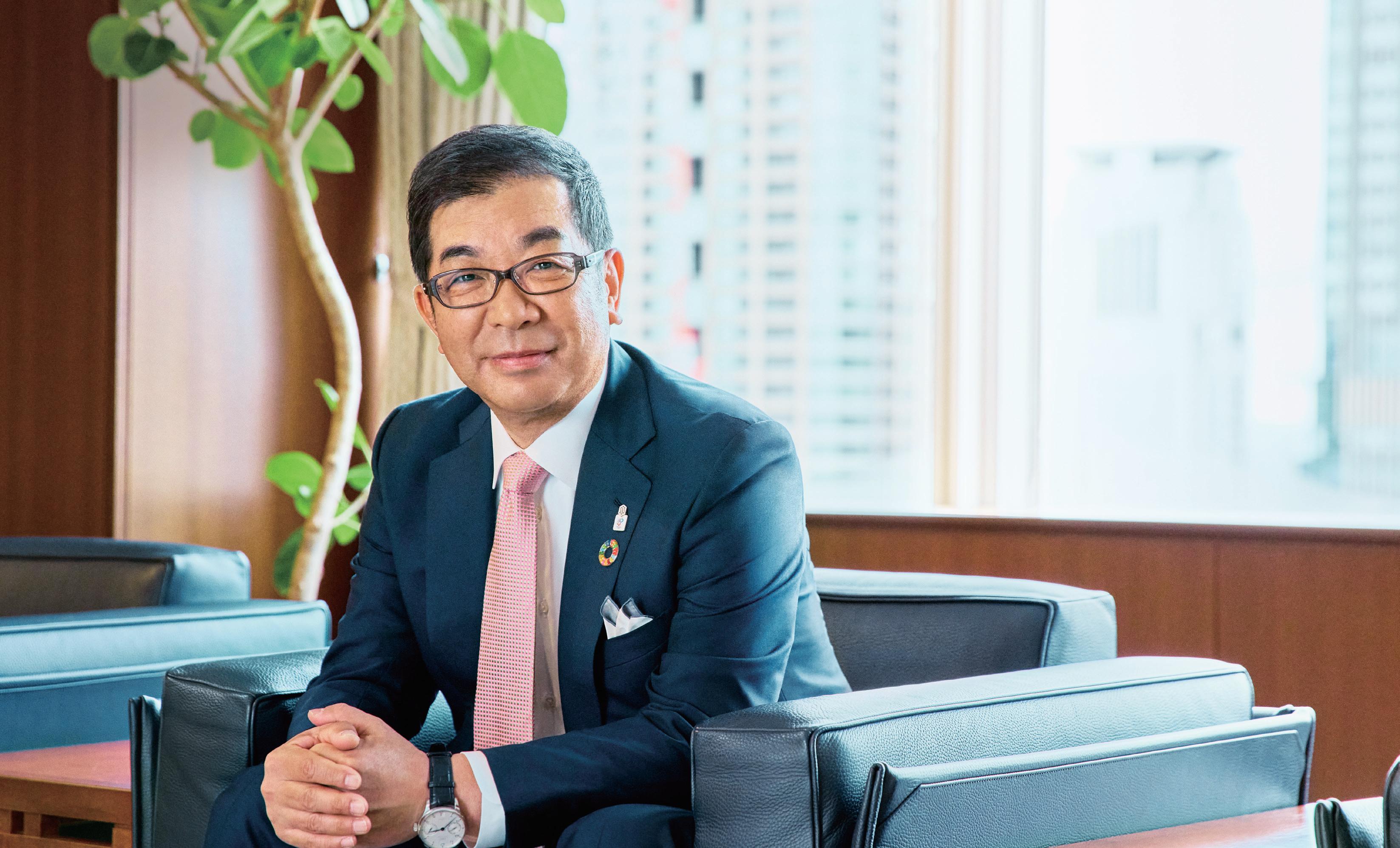
Yoshihiro Nakai
Representative Director of the Board President, Executive Officer, CEO
On behalf of the Group, I extend our deepest sympathies to all of those impacted by the 2024 Noto Peninsula Earthquake. I also wish to express our profound respect for those working tirelessly on reconstruction efforts. We are praying for the safety of everyone affected and for a swift recovery.
For over 60 years, the Sekisui House Group has been pursuing new ways to create value in the housing domain, steadily building upon our achievements. Now, with colleagues who share our ambitions and passions, we have entered into a new stage of growth. We will continue to strive for unique value creation that we can proudly share with the world through continuous innovation and challenges.
Message from the CEO
In 2018, we adopted “Innovation and Communication” as our slogan for internal transformation. Five years have passed since then, and I am pleased to witness a steady increase in exciting proposals and unprecedented ideas.
From my own experience, I am convinced that the seeds of innovation lie within our employees, who are constantly thinking about our customers’ happiness and staying vigilant. To nurture these seeds of innovation, it is crucial to have supervisors and colleagues who communicate effectively. We chose this slogan because we believe that when autonomous employees, who take independent and proactive actions and express their unique sense of beauty and individuality, come together, they spark new ideas and create remarkable value.
I have consistently communicated the importance of “Innovation and Communication”, “autonomy”, and “sense of beauty” in my own words in various contexts. I am confident that these principles have firmly been embraced by our employees, and I eagerly look forward to the new and innovative ideas they will bring.
At the core of all business activities of the Sekisui House Group lies our fundamental Corporate Philosophy, “Love of Humanity,” which focuses on wishing for the happiness of others. Building on this foundation, we launched a new phase in 2020 by setting our Global Vision, “Make Home the Happiest Place in the World.” To achieve this vision, we have established “SEKISUI HOUSE-SHIP.”
SEKISUI HOUSE-SHIP
Creating new value through innovation.
Fostering ideas through effective communication and collaboration.
Taking proactive and independent action.
Continually refining our technology and sense of beauty.
Committing as professionals to making home the happiest place in the world.
I would like to share my thoughts and elaborate on “SEKISUI HOUSE-SHIP”. Our Global Vision embodies our desire to be a group that creates happiness. This means creating new values for a new era, focusing on the true happiness of the world beyond a mature and aging society.
For us to accomplish this, the Sekisui House Group itself must first change. While firmly upholding our Corporate Philosophy, we need a guiding principle to create further value. We have therefore redefined our identity, introducing it as “SEKISUI HOUSE-SHIP.”
SEKISUI HOUSE-SHIP encapsulates our desire to be an organization of individuals who share this mindset. During periods of high economic growth, following instructions from senior management and conforming to the company’s directions might have been sufficient to achieve steady growth. However, in today’s rapidly changing environment, it is increasingly important for employees to take independent and proactive action in their respective positions, sharing ideas based on their own senses and aesthetic judgments.
Our employees are the primary drivers of new value creation at the Sekisui House Group. Through “SEKISUI HOUSE-SHIP,” we will align our efforts and continue to create unique value.
P.15
Sekisui House Group’s Identity
We have been researching housing for over 60 years. Sekisui House was founded to address the housing shortage while protecting people’s lives and property. This mission is especially important in Japan, where the country frequently experiences natural disasters, such as earthquakes and significant seasonal weather changes.
Although the housing shortage in Japan has been resolved, approximately five million out of the 29.2 million detached houses do not meet current earthquake resistance standards. Additionally, 89% of houses do not meet current energy efficiency standards. While the market for new houses in Japan is projected to contract partly due to population decline, these issues indicate that our founding mission remains unfulfilled.
I firmly believe that housing is a vital form of social asset. Therefore, it must be well-maintained and managed, retain long-term value, and be aesthetically pleasing.
When determining our priorities to fulfill our founding mission, we recognized the importance of leveraging our unique technologies and high-precision construction capabilities developed over many years. In September 2023, we launched the industry’s first joint construction project, the Skeleton and Infill (SI) business, by sharing our original seismic resistance technologies. This initiative aims to enhance the seismic performance of wooden houses across Japan in collaboration with Sekisui House Construction and external partners. By April 2024, we had formed partnerships with five companies to accelerate efforts in creating high-quality housing stock.
In addition to creating high-quality housing stock, we have set contributing to a sustainable society and promoting diversity and inclusion as our material issues. I believe these material issues aimed at achieving a sustainable future are not merely short-term goals; they are grounded in our enduring values and a require long-term commitment over the next 50 to 100 years.
Message from the CEO
What are the enduring values and purpose of our Group? I believe they are deeply embedded in our Corporate Philosophy, “Love of Humanity,” meaning wishing for the happiness of others, making their joy our own, and acting with integrity in the spirit of service. As a business leader, this Corporate Philosophy is a crucial guiding principle in my decision-making process, whether it involves establishing our vision, developing strategies, or strengthening governance.
Recently, I have often been asked, “Why do you go to such lengths to put the customer first?” While it has always been part of our DNA, I would like to take this opportunity to share my perspective on this in more detail.
P.13 Corporate Philosophy

As previously mentioned, Sekisui House was founded on the strong desire to protect people’s lives and their property. I believe this is why the spirit of “Love of Humanity,” which focuses on the happiness of our customers, has been a core value and passed down since our founding. This commitment is also reflected in our business model, where 98% of the homes we deliver are custom-built. From the start, we have designed each home to meet the specific needs of our customers and have committed to providing lifetime support. I am convinced that this approach has naturally ingrained a strong customer-first DNA in us.
Our commitment to our customers’ happiness is evident in the dedication of our employees and the craftsmen of the Sekisui House Association, who support our highest quality standards. Especially during natural disasters, these individuals are the first to think of our customers’ safety and act voluntarily, even without specific direction from the Company. Their actions serve as powerful examples of our core values in practice.
These enduring values and purpose, which have been passed down through our long history, will continue to guide us. We are committed to carrying them forward without losing sight of them.
P.24 Core Competencies
The journey of value creation at the Sekisui House Group can be divided into three phases.
In the first phase, from 1960 to 1990, we focused on researching and enhancing seismic resistance, durability, fire resistance, and shock resistance, providing the value of safety and peace of mind to our customers.
In the second phase, from 1990 to 2020, we concentrated on improving thermal insulation and incorporating universal design to consider everyone from children to the elderly, providing the value of comfort and environmental consideration to our customers.
In the third phase, starting in 2020, we have focused on creating happiness in homes, aligned with our Global Vision, “Make Home the Happiest Place in the World.” We broke down the concept of “happiness” for people living long lives, spanning 100 years, into three key elements: health, connectedness, and learning. For example, we envision homes that manage health conditions, connect with places such as grandparents’ homes, hospitals, and museums, and offer lifelong learning opportunities from the comfort of home. Although this is a highly challenging endeavor, it is one that only we can pursue thanks to our extensive experience and accumulated efforts in developing technologies for safety and peace of mind, as well as our lifestyle design proposals for comfortable and environmentally considerate living. Our plan is to gradually integrate new services and ideas throughout this third phase.
P.83 The Technologies, Lifestyle Design and Services that are the Strength of Sekisui House
It has been one year since we launched the Sixth Mid-Term Management Plan (FY2023–FY2025), focusing on stable growth in Japan and proactive growth overseas. Our business performance in the first year has exceeded expectations, and we are effectively delivering new value globally. This is my sincere evaluation of our current situation.
In the domestic detached housing sector, we introduced a new design system, called “life knit design,” which is being implemented nationwide to better reflect residents’ sense of beauty in their homes. In rental housing, we have focused on promoting Sha Masion ZEH, with the ratio of ZEH housing orders surpassing our fiscal year goal of 70%. Additionally, our digital technology initiative for rental housing, “rental housing DX,” has achieved 100% online rental applications. The increase in self-guided tours of rental properties has further enhanced tenant convenience.
P.76 The Sixth Mid-Term Management Plan
from the CEO
In our U.S. homebuilding business, we completed the acquisition of American homebuilder M.D.C. Holdings, Inc. in April 2024. This acquisition positions us to achieve our goal of supplying 10,000 single-family homes overseas, matching our domestic scale, ahead of schedule by the final year of the Sixth Mid-Term Management Plan in FY2025.
Since entering the U.S. homebuilding market in 2017, our primary objective for overseas M&A has been to transfer Sekisui House technologies and establish them as the global standard. In welcoming M.D.C. Holdings, Inc. to our Group, we prioritized aligning our values on construction philosophy, along with our commitment and passion for supplying high-quality housing.
The U.S. single-family housing market has been experiencing a chronic supply shortage due to high mortgage interest rates and rising construction costs. Additionally, there is an increasing demand for high-quality housing both in the U.S. and globally.
As a pioneer in homebuilding, our mission is to revolutionize the future of housing by providing highly durable and comfortable homes. We are committed to transferring our technologies, with the belief that they will set a new global standard in the housing industry. We will continue to expand proactively overseas, leveraging the strong governance and reliable business platform that M.D.C. Holdings, Inc. has developed over its 50-year history.
P.86 Business Strategy, Overseas Business
By welcoming M.D.C. Holdings, Inc. to the Sekisui House Group, we have expanded our presence in the U.S. from eight states to 16. In the U.S., building codes, market demands, and climatic conditions vary significantly by state. This expansion presents us with 16 unique challenges, but it also opens up 16 remarkable opportunities for our Group.
As we expand into the U.S. market, I believe in the concept of “planned happenstance”, or intentional coincidence. This idea emphasizes the importance of being open to unexpected opportunities. While I cannot foresee all the value that will emerge from introducing our advanced technologies to the U.S., the journey of discovering and implementing these innovations is an exciting marketing challenge. I am thrilled by the new possibilities we will uncover along the way. Reflecting on my career, it has been a journey marked by intentional coincidences. While I followed a certain plan, unexpected encounters and events provided invaluable opportunities for growth. I discovered that what might at first seem like mere coincidences could actually result from being open to new experiences, guiding us toward unforeseen paths.
This approach might seem somewhat optimistic. Of course, detailed planning and preparation are essential in corporate management. However, I believe it is equally important to remain flexible and embrace the unexpected opportunities that may arise.
In Value Report 2023, I talked about our long-standing initiatives such as Net Zero Energy House (ZEH) and the Gohon no Ki Project. These efforts are integral to our mission of becoming a leading company in ESG management.
In FY2023, the CDP, which evaluates corporate environmental sustainability, awarded us an A rating in climate change, forestry, and water security. This “Triple A” rating highlights our leadership in transparency and performance. We are the first company in the domestic housing and construction industry to achieve this Triple A rating. This honor reflects our continuous efforts to collaborate with customers and deepen our understanding of environmental challenges.
P.121 Environment
This year, I would like to highlight our efforts to promote women’s participation in the workplace.
I hold great confidence and pride in all of our Group’s female employees. In 2006, we established the Diversity Development Team and started actively recruiting female sales representatives. For the past two decades, promoting women’s participation has been a cornerstone of our business strategy. As of the end of January 2024, 29.4% of our employees were women, nearly double the industry average of 15.3% in the broader construction sector.
This journey has had its challenges. Initially, we faced many resignations and issues such as difficult working environments, long working hours, and a lack of understanding from supervisors. We identified the root causes of these issues, and with feedback from employees, implemented the working environment and related programs. As a result, we have created a more inclusive workplace and transformed programs to benefit all employees, regardless of gender.
Every year, I personally participate in conferences and award ceremonies for our female sales representatives, engaging in direct dialogue with them. It is truly heartening to see female employees who joined our Group after 2006 now thriving in managerial positions. While it is generally believed that women’s interest in managerial positions is declining, I am glad to see our female employees voluntarily participate in training for female managerial candidates. This enthusiasm is a testament to the growth of independent and proactive women within our Group. Additionally, our FY2023 Well-Being Survey revealed that the well-being score is notably high for female managers and their departments.
Recently, the representation of women in corporate officer and managerial positions has gained importance. However, rather than blindly chasing numbers, I aspire to naturally increase the ratio of managers by honoring their personal goals and nurturing their self-directed career development.
P.107 Promoting the Participation of Women
Message from the CEO
Our Group’s fundamental philosophy on maximizing human capital value is encapsulated in “Employee Autonomy x Alignment of Efforts.” This concept is rooted in the belief that when each employee’s autonomy is aligned with the organization’s direction, we can achieve the highest human capital value and foster organizational growth.
I am often asked about the meaning of “autonomy.” My answer is very simple. Autonomy means choosing your own path and taking responsibility for your decisions. This is not limited to career development; it also includes decisions such as taking long vacations to spend time with family or shortening working hours for caregiving responsibilities. These are all admirable examples of autonomy, and we are dedicated to improving programs and environments to support every decision. We pledge unwavering support to all employees who strive for greater autonomy.
There are various definitions of “sense of beauty,” a concept highly valued by our Group. Personally, I believe it means capturing beauty and joy through one’s own senses. To nurture this sense of beauty, it might be beneficial to frequently encounter things that move your heart and captivate your senses. In an era of AI and technological advancements, I believe it is more important than ever to cherish moments that touch our hearts.
P.30 Our Foundational Values
On April 1, 2024, our Group joyfully hosted a welcome party for 950 new graduates. While the term “company induction ceremony” may sound formal, we chose to call it a “welcome party” to warmly embrace our new colleagues. We continue to welcome new colleagues with similar motivations and passions, both domestically and internationally, as seen with our inclusion of M.D.C. Holdings.
In the past, we have sent onsite supervisors and craftsmen from Japan to Australia to implement Sekisui House technologies. We plan to undertake similar
initiatives in the United States. I am confident that enhancing opportunities for collaboration between colleagues from different countries will foster greater innovation and communication.
As we continue our journey, I am reminded of an important realization. Our Group’s unwavering commitment to our customers’ happiness and relentless dedication to housing research have endowed us with technologies and expertise that are truly unique in the world.
The Sekisui House Association, which I previously mentioned, includes approximately 5,000 carpenters dedicated to our housing construction business. These professional carpenters, bound by strong ties and mutual trust built over many years, possess exceptional craftsmanship. They are true masters of their craft, adhering to the highest construction standards and rigorous quality inspections. In November 2023, we held the Sekisui House Carpentry Competition, WAZA 2023, where these carpenters showcased their extraordinary skills. We express our heartfelt gratitude and respect to these dedicated craftsmen who play a key role in creating happiness for our customers. We also aim to maximize their annual income.
In addition to our core competencies in technical expertise, construction capabilities, and customer base, we have cultivated a wealth of philosophies and a culture rooted in an unwavering commitment to always putting the customer first. These unique values, carefully built over six decades, represent a value found nowhere else in the world.
It has been three years since we released our first Value Report in 2022. Our Value Report is more than just a display of figures and performance results; it serves as a vital tool to clearly convey our values and deepen our connection with all stakeholders.
The challenges, successes, and even failures we have encountered over the years are invaluable assets to our Group. By actively sharing the unique values
we have cultivated through our journey, we aim to design a happier future with all of you.
Japan is one of the first countries in the world to transition into a mature and super-aged society. By fully leveraging our unique values, we are aligning our efforts to create a happy and prosperous future.
Please look forward to the Sekisui House Group’s continued journey of creating unique value by further advancing innovation and communication.

At the Sekisui House Group, our true value is not merely measured by the number of homes we have built, but by the happiness these homes bring to our customers and society.
Since our founding, we have been uniquely dedicated to the concept of “home,” embarking on a journey filled with aspirations to create happiness. We wish to share these stories and engage in meaningful dialogue with our stakeholders to collaboratively design a brighter and happier future.
In our Value Report 2024, we reflect on the value we have provided to our customers and society. We also highlight the strengths we have built over time and our plans to leverage these strengths to shape the future, while delving into our fundamental approach and specific initiatives.



















Founded in 1960, Sekisui House has been continuously focused on housing development for over six decades, securing a strong and well-established presence in the Japanese market. Today, we have expanded into four primary housingfocused business models: built-to-order, supplied housing, development, and the overseas business. With a proactive presence in global markets, including the United States and Australia, we are actively broadening our international reach.
By leveraging technical expertise, construction capabilities, and a solid customer base as our three core competencies, we are forging a path toward unparalleled value creation with our dedicated workforce of over 29,000 employees.
Our Purpose
In 1989, 30 years after our founding, we defined our purpose through discussions with all employees. It embodies Sekisui House’s identity and guides our collective dedication.



Creating new value through innovation.
Fostering ideas through effective communication and collaboration.
Taking proactive and independent action.
Continually refining our technology and sense of beauty.
Committing as professionals to making home the happiest place in the world.
Our Vision for 2050
In 2020, anticipating future global shifts, we established our 30-year long-term vision as the “Global Vision,” along with three ancillary objectives, our “sub-visions.”
Our Identity
We introduced SEKISUI HOUSE-SHIP as a guiding light for Sekisui House Group employees to navigate their actions with pride and responsibility.
With an awareness that each and every human being is precious and irreplaceable, we will wish for the happiness of others, make their joy our own, and act with integrity and in the spirit of service.
At the heart of our foundation is the principle of “Love of Humanity,” which is the fundamental philosophy of our Corporate Philosophy. Originally established to protect lives and homes during Japan's post-war reconstruction, this guiding principle continues to be embraced today as we evolve into a global company. It serves as a universal ethos, actively practiced by all employees within the Sekisui House Group. Our Corporate Philosophy acts as a perpetual legacy, providing more than just a management or business plan—it is a compass guiding our actions and decisions with clear intentions.
Embedding our Corporate Philosophy
A unique aspect of our Group is that all employees have a deep-rooted understanding of our Corporate Philosophy. Executives and managers lead by example, incorporating the philosophy into their daily work and clearly communicating their ideas and visions. This approach helps employees naturally embrace and practice our Corporate Philosophy, allowing it to gradually take root across the organization. Each year, we conduct a Governance Awareness Survey where all employees participate anonymously. This survey includes questions about awareness of the Corporate Philosophy and their respective actions, enabling us to measure how well it is understood and practiced within the organization.

Every person seeks happiness, which can take various forms and evolve over time.
At Sekisui House, we harness our aesthetic sensitivity and technical expertise to create homes that serve as the happiest places for those who live in them.
In fact, beyond living spaces, we cultivate peace of mind, joy, and well-being.
We foster human connections, instill a sense of security, and inspire hope for the future—values fundamental to all people.
Each home we build is unique and beautiful, designed to fill people with joy whenever they return, be it minutes, days, or years later.
The future we envision is one where everyday life is filled with happiness for everyone. This is why we are passionate about crafting an individual sense of happiness for each person.
The Global Vision we set forth in 2020 embodies these aspirations of the Sekisui House Group.
Creating new value through innovation.
Fostering ideas through effective communication and collaboration.
Taking proactive and independent action.
Continually refining our technology and sense of beauty.
Committing as professionals to making home the happiest place in the world.
As we strive to create even greater value, the phrase “SEKISUI HOUSE-SHIP” will be a new guidepost for each of us. Along with Sekisui House Group employees worldwide, we will continue creating value while delving even deeper into this new philosophy.
The Concept Behind the Name
The English suffix “-ship” is often added to a noun to create an abstract noun. Words such as “partnership,” “leadership,” and “sportsmanship” are excellent examples of words created in this way that convey both meaning and a clear image. We wanted to do something similar and create a motto with our own Company name. While we use the suffix “-ship” to express the essence of Sekisui House, as a word, it symbolizes our cohesion as a group of diverse individuals uniting on a single vessel, sailing together towards a common destination.
Sekisui House Group’s Identity
Starting with 34 colleagues in 1960, Sekisui House expanded to over 10,000 employees by 1990. It was during these times of prosperous growth that we decided to reflect on our roots. Together with our employees, we established a Code of Conduct rooted in our Corporate Philosophy. By formally identifying our shared mindsets and attitudes, we outlined behavioral expectations, standards, and values that would guide the development of our people and the enhancement of our workplaces. Since then, we have experienced exponential growth.
In 2024, with over 29,000 employees globally, the Sekisui House Group is continuing our journey toward greater growth. By deepening our understanding of our distinct values and cultural pillars, and cherishing each individual’s identity and strengths, we aim to evolve the way Sekisui House Group operates. With these aspirations, we have articulated what makes us unique and established SEKISUI HOUSE-SHIP.
In formulating SEKSUI HOUSE-SHIP, we placed utmost importance on the leadership and active participation of our employees. After extensive discussions with top management, we refined our enduring mission and values into five essential components. These components reflect over six decades of pride and culture, encapsulating our approach and mindset, and setting the stage for our actions and decisions. By incorporating these components into individual actions, we believe we can further deepen the unique identity of the Sekisui House Group.
Beginning of a new phase
In 2020, which marked our 60th anniversary, we established the NEXT SEKISUI HOUSE 30-year vision. With a focus on housing, we unveiled the Global Vision, “Make Home the Happiest Place in the World,” aspiring to become a global company that offers integrated technologies, lifestyle designs, and services. This began our journey into a new phase and our quest to create new value by the year 2050.
Articulating our vision for the future
We reassessed the role the Sekisui House Group plays in society and the values we have cherished. We considered our unique strengths, how they can be best utilized, and what we aspire to be in the future. These elements were then articulated as our corporate values, defining our vision for the future. P.14 Aspirations Embedded
Defining individual aspirations
Between October 2022 and May 2024, collaborative discussions among Group employees and executive management led to the clear articulation of individual aspirations and cherished elements, aligning personal goals with our collective vision.






Our approach to value creation at the Sekisui House Group begins with reimagining housing. We construct homes that ensure safety and protect property, while fostering environmental responsibility and comfort. Now, we are elevating these values to new levels by enhancing well-being through supporting health, encouraging connections, and enabling continuous learning, all contributing to residents’ happiness.
This diagram illustrates the Sekisui House Group’s journey and strategic direction in value creation. By leveraging our three core competencies— technical expertise, construction capabilities, and a robust customer base—we develop advanced technologies and ideas to pioneer new housing concepts, thereby expanding values that contribute to society.

We are entering an era where people may live for 100 years. Accordingly, the values people hold are diversifying, while issues facing our customers and society, such as the declining birth rate, aging population, and climate change, are becoming more complex. Moreover, after a period of rapid economic growth in Japan and other developed countries, there is a growing focus on both emotional and lifestyle fulfillment.
To live happily for 100 years, people need to be healthy, maintain close connections with family and friends, constantly learn new ideas, develop new skills, and accumulate meaningful experiences and memories. We believe that these intangibles, which add color to everyday life, are crucial for creating happiness. This is why we strive to create housing that nurtures happiness in the era of the 100-year lifespan.
We envision a future where everyone’s daily life is filled with happiness. Moments of enjoyment, beauty, and happiness vary for each individual. Consequently, we strive to create happiness tailored to each person’s unique definition.
Founded with the mission of creating new social value through housing, Sekisui House has consistently led the way in value creation and innovation through extensive research and technological development. Our journey goes beyond constructing living spaces; we are pioneering the future of housing culture and shaping the lives of residents. We will continue to create new value by enhancing housing performance and developing advanced technologies.
P.21 Our Corporate Story
Creating happiness means fostering a brighter future. In essence, it involves building a sustainable society. Our goal is to pass on beautiful homes and townscapes where residents can live happily. With this vision, we are dedicated to creating value that looks to the future.
The Sekisui House Group takes a leading role in addressing the escalating social issues of our time. We focus on the value that is needed, rather than just what we want to provide. Guided by this perspective, we engage in business activities that enhance the happiness of our customers, society, and employees. We are committed to expanding values that benefit society, with the aim of realizing a happier future for all.
P.41 Promise for the Future
Our Ancillary Objectives, “Sub-Visions”
Propose happiness through the integration of technologies, lifestyle design and service

Our founding mission has always been to provide housing that protects people’s lives and property through advanced technologies, enhance living through innovative lifestyle design, and strengthen services that support residents. By integrating these elements, we aim to create new values that contribute to happiness. P.79 Business Strategy
The ESG management of the Sekisui House Group embodies our Corporate Philosophy in action. By integrating our business activities with ESG principles and ensuring their proper implementation, we create values that contribute to solving social issues. This approach aims to realize a sustainable society and continuous growth for our Group.

facto standard
Since our founding, we have developed and enhanced technologies and lifestyle proposals that incorporate safety, peace of mind, comfort, and environmental consideration. We aim to bring these Sekisui House technologies to the world, delivering new value and expanding our global impact. P.86

P.91 ESG Management
A Message from the CEO to Sekisui House Group Employees
“I want all employees to make full use of Sekisui House Group resources.”
The title “CEO” might represent an image of someone who builds a company. But, together with all of you, I am constantly thinking about how we can create new value for our customers. The concept of “new value” might seem challenging, but I believe that even a small idea—if it brings happiness to our customers—is meaningful innovation.
Our Global Vision, “Make Home the Happiest Place in the World,” might sound simple, but it is a vision only the Sekisui House Group can achieve thanks to our decades of dedication and the close connection we maintain with our customers.
When I talk to new employees, I often explain that “becoming a working member of society” means taking a position where you “provide value to society.” Since they have chosen the Sekisui House Group to start their professional journey, I believe it is much more fulfilling to use the company’s resources to create value.
I encourage all employees to always think about what value they want to provide and to choose their own path in doing so. If we focus on creating happiness for our customers, there is no limit to what we can achieve!

Employees share and communicate their ideas.
New innovations can also emerge from communication.
This is the kind of company I aspire to create.
Yoshihiro Nakai Representative Director of the Board President, Executive Officer, CEO
“Our Leadership” as Seen by Sekisui House Group Employees
“A leader is someone who creates opportunities for employees to take the first step.”
A great leader inspires team members with a clear vision and creates an environment where they have opportunities to grow as individuals. Great leaders also align organizational efforts, set boundaries, and provide support so that each employee can discover their own path. In doing so, these leaders bring out the unique talents and abilities of their team members, offering advice and feedback whenever necessary.
Our CEO is like the captain of a ship, steering the organization safely to its destination. A ship captain is responsible not only for guiding the ship, but also for considering the safety and happiness of their crew. To navigate through stormy seas, the captain must make calm and rational decisions and demonstrate leadership. Similarly, our CEO guides the organization to success by providing clear direction, instilling a sense of security in employees, and aligning everyone toward common goals.
A distinctive aspect of leadership at the Sekisui House Group is


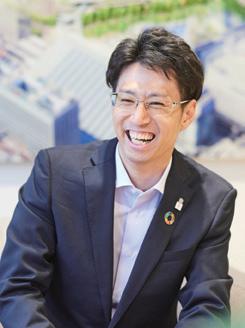
their proactive stance in challenging the status quo. Leadership actively supports and backs up ideas that face opposition within departments by encouraging, “Please drastically change the way things have always been done”, ensuring these ideas come to life. They urge supervisors to consider and engage with employees who may struggle with communication. To mid-career hires, they say, “Please do not change who you are,” fostering an environment where expressing opinions and sharing different viewpoints is welcomed. They lead initiatives to transform management’s mindset and create an environment where team members can excel. Furthermore, they are committed to developing employees who will eventually surpass them.
Having leaders who embrace unpredictability and create opportunities to take the first step is crucial for employees who are deeply dedicated to creating happiness. It is precisely this kind of environment that allows us to confidently use the Sekisui House Group as a platform and enjoy taking on new challenges.






Corporate Story




The Sekisui House Group’s journey of value creation, driven by diverse ideas and technologies that address evolving social issues, can be divided into three phases. By strengthening our core competencies—the driving force behind value creation— and enhancing the value of our human capital, we are committed to continually creating new value.
To solve the post-war housing shortage, we focused on enhancing core housing performance standards such as seismic resistance, durability, and fire resistance, providing value in the form of safety and peace of mind.
To provide comfort with environmental considerations in mind, we made advancements in thermal insulation, durability, universal design, and energy-efficient homes, offering comfortable living and creating a more prosperous future.
To achieve happiness in the era of the 100-year lifespan, we are accelerating our efforts to drive further technological innovation and deliver significant high added value, creating new value in health, connectedness, and learning.
Post-war housing shortage Enhancing housing performance Safety and peace of mind
Beginning of the 100-year lifespan era Providing high added value
Phase 1 (1960-1990)




Phase 2 (1990-2020)








To address the post-war housing shortage, we improved essential housing standards such as seismic resistance, durability, and thermal insulation, crucial in disaster-prone Japan. We also established a comprehensive in-house system for direct sales and responsible construction, covering development, sales, production, construction, and after-sales services. We focused on training technicians to develop innovative technologies and services, and pass on their expertise.
Enhancing housing performance
1961
Opened Shiga production facility (ceased in 2009) 1987
Established Customer Service Center 1990
Founded Comprehensive Housing R&D Institute to develop advanced technologies
As the demand for comfortable living grew, addressing environmental issues became increasingly urgent. This led us to develop advanced technologies to achieve energyefficient, comfortable, and environmentally conscious housing, while also enhancing urban development.
We prioritized initiatives that leveraged employee diversity to foster innovation and communication.
Developing advanced technologies
Established Japan’s first Human Life R&D Institute to research happiness
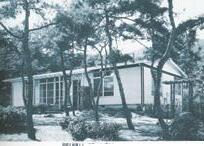
1961

Launched “Sekisui House Model B” 1964 Established direct sales and responsible construction system

1979
Demonstrated housing seismic resistance through full-scale vibration experiments

1984
Adopted “Dyne Concrete” exterior material with beautiful texture and functionality
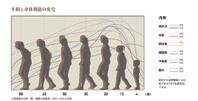
1989
Established “Lifetime Housing” philosophy for universal comfort —now and always


Standardized high-performance, multi-layer, heatinsulating glass, a first in the housing industry 2003
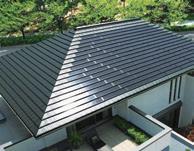
Standardized next-generation energy-saving specifications in newly built detached homes, a first for housing manufacturers 2003
Developed a roof tile photovoltaic power generation system

2011 Developed “Airkis” specifications for better indoor air quality

2018
Launched “Family Suite” to achieve large open spaces
Developing technical experts
Developing human capital to create innovative technologies and services, and transferring expertise
• Establishing vocational training schools for technical development
• Implementing skill development programs by job type and hierarchy
• Formulating educational and training guidelines
• Creating a unique, in-house certification program
• Embracing the spirit of a “community with a common destiny”
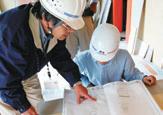
Promoting diversity
Leveraging diverse perspectives and experiences
• Promoting women’s active participation
• Promoting parental leave for men
• Supporting employment of individuals with disabilities
• Encouraging career autonomy training
• Implementing work style reforms
• Ensuring respect for human rights

As lifestyles diversify and we enter into the era of the 100-year lifespan, we will pursue high added value that integrates technologies, lifestyle design, and services. Building on the technologies we have refined over 60 years, we aim to create new value in happiness. To achieve this, we are committed to supporting employee autonomy and fostering innovation.
Providing high added value
2019 Announced Platform House Concept to assist happiness in the era of the 100-year lifespan
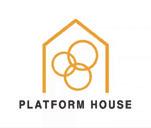




testing * In-Home Early Detection Network
2020 Developed “SMART-ECS,” a next-generation indoor environment system that cleans air and controls room temperature 2021
Developed “PLATFORM HOUSE touch,” enabling remote controlling of home conditions and remote operation of equipment
2023
Launched “life
Fostering employee autonomy
Maximize human capital value through alignment of efforts and employee autonomy
• Supporting career autonomy
• Engaging in Sekisui House Innovation & Performance (SHIP) Awards
• Engaging in career discussions with supervisors and ESG dialogue
• Developing next generation of leaders
• Building a foundation for happiness

and peace of mind
Improving housing performance
Solving the housing shortage by popularizing preengineered housing with short construction timeframes
Value Created
Comfort and environmental consideration
Enhancing comfort and living environment
Considering the global environment and promoting sustainable urban environments
Health, Connectedness, and learning
Ensuring happiness in the era of the 100-year lifespan
Supporting health, fostering connections, and facilitating learning and experiences
The history of the Sekisui House Group symbolizes the evolution of the Japanese housing industry. To address the housing shortage, we have continuously striven to improve housing performance and develop advanced technologies while expanding our area of business operations.
In phase 3, starting in FY2020, we are leveraging our core competencies we have developed over the years to provide high added value through the integration of our technologies, lifestyle design, and services. We will continue to create new value by utilizing the capital we have accumulated and deepening our core values we have cherished since our founding.
The passion and commitment to protecting people’s lives and property marked the beginning of the Sekisui House Group’s value creation.
Following the war, Japan’s housing shortage persisted into the late 1950s due to the vast number of homes destroyed by air raids. Supplying houses as quickly as possible was the urgent priority. Traditionally, Japanese houses were made of wood, paper, and mud, and the concept of building houses with steel frames was not yet recognized globally. Sekisui House emerged from the desire to construct fire-resistant houses to protect people’s lives and property.
Despite having no prior experience in home construction, four individuals collaborated to develop a fire-resistant house utilizing steel, aluminum and plastic. The pre-engineered steel-frame house they created were revolutionary, challenging the conventional construction methods and materials of the time.

In 1960, a time when wooden-frame housing was the norm, we introduced a full-fledged pre-engineered house, the Sekisui House Model A. Featuring Western-style kitchens and dining rooms, these houses sparked a new lifestyle.

To proactively address the Japanese housing shortage and provide high-quality housing, we established the Shiga Factory in 1961. Believing in taking full responsibility for producing our own components allowed us to advance our production system and continue supplying houses with short construction timeframes.

In 1961, we launched the Sekisui House Model B, enhancing both performance and design, and becoming the first in the Japanese housing industry to adopt metric specifications. With its spaciousness and personalized design, it laid the foundation for our future technologies and ideologies.


Over its more than 60-year history, the Sekisui House Group has developed numerous strengths. These include superior technical expertise that facilitates continuous innovation and advanced design proposals; exceptional construction capabilities that rigorously adhere to legal regulatory standards and stringent Company-specific criteria to deliver high-quality housing; and a robust customer base.
These core competencies have been shaped by our dedication to our fundamental philosophy, “Love of Humanity.” This philosophy drives our commitment to protecting people’s lives and property while addressing the housing shortage. Additionally, we build deep bonds and relationships of trust by thoroughly responding to our customers’ ideals and needs, embodying our customerfirst DNA.
The core competencies that drive our growth are distinguished by their unique characteristics, honed over many years of challenges and innovation. By further deepening and expanding these core competencies, we are committed to creating unique value and achieving our Global Vision.

Our fundamental philosophy “Love of Humanity”
the post-war housing shortage and protecting people’s lives and property

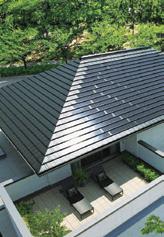


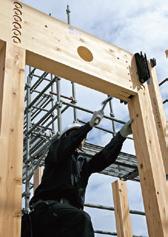


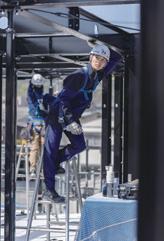
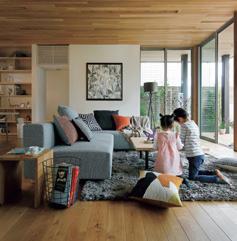

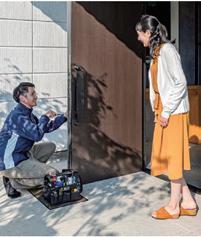
Housing styles evolve over time. By capturing these subtleties and providing advanced technology, research and development, and innovative design, we consistently pioneer new eras. Our technical experts, who exemplify grit and integrity, continue to explore new possibilities for housing and create unique value.

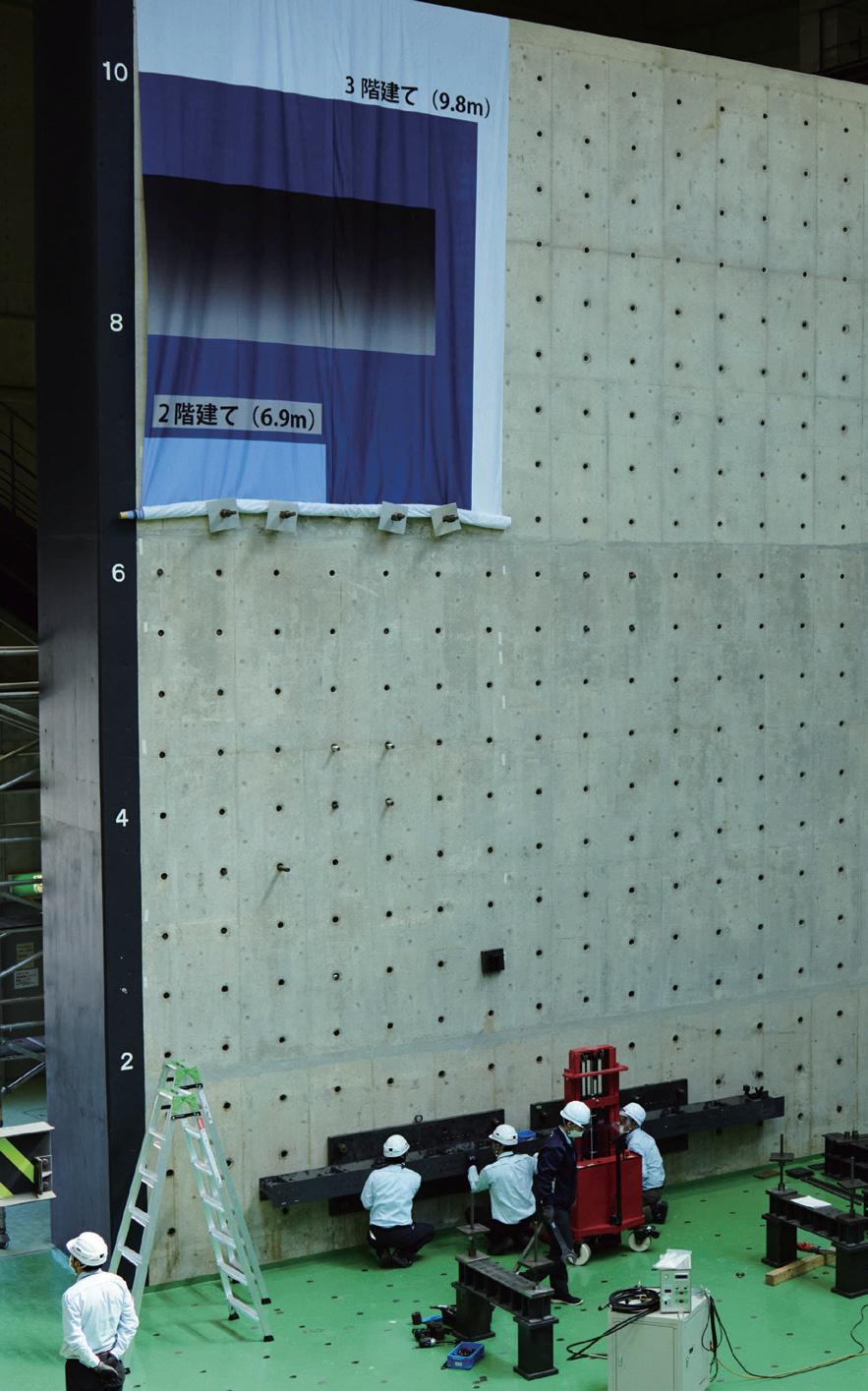

Our R&D Division continuously verifies and assesses the fundamental performance of our housing, striving for value creation in safety and peace of mind; comfort, and environmental consideration; and health, connectedness and learning. From the research and development of new construction methods and advanced technologies to the multifaceted analysis of happiness, and research on how to create happy homes, lifestyles and day-to-day living services, we conduct various research and development related to technologies, lifestyle design, and services centered on housing.

Patents held: 916
Design rights held: 374
1990 Established Comprehensive Housing R&D Institute
2018 Established Human Lifestyle R&D Institute

Our high-performance, high-quality components are manufactured through computer-controlled, customized build-toorder production. We uphold rigorous quality control system with in-house inspection specialists skilled in manufacturing and adhering to strict internal testing standards. We also conduct skill tests for our factory technicians. Our entire Production & Procurement Division, including all domestic factories, was the first in the industry to achieve ISO 9001 certification for quality management, ensuring consistent high quality in every residence we deliver.
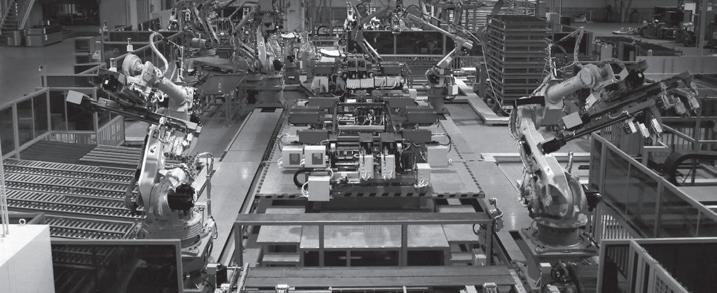
In-house certified inspectors: 1,561 Certified manufacturing skilled employees: 3,414 Production bases: 6 Distribution bases: 40
Incorporating feedback
Customer feedback is integral to our research and development efforts. To achieve this, we have established various internal working groups that drive product development and technological innovation.
The institute, where the future begins
In 1990, we established the Comprehensive Housing R&D Institute. Through repeated pilot tests, our researchers develop advanced and unprecedented technologies while collaborating with customers and employees to shape the future of housing.

For each home, we assemble a dedicated team of architects, interior coordinators, exterior designers, and onsite supervisors to create a unique and ideal living space. We implement a stringent in-house certification program granted only to employees who meet advanced standards. Our professionals possess superior design proposal capabilities and expertise to address our customers’ desires, adhere to legal regulations, and accommodate diverse site configurations, bringing their visions to life through our homebuilding process.

Analyzing multifaceted happiness
In 2018, we established the Human Life R&D Institute. Using a vast amount of data and accumulated knowledge, we create housing and lifestyle proposals that incorporate elements of happiness.
Giving shape to emotions
Happiness is the starting point of our ideas. With a rich aesthetic sense and spirit of inquiry, we grasp the subtleties of daily life. These qualities are embedded in our technologies, capturing and giving form to the deepest emotions in our hearts.
Our Story
The Sekisui House Group places keen focus on the ground and foundations, which are crucial to the durability and precision of housing. Our corporate culture embraces and nurtures the aspirations of our passionate technical experts, enabling us to grow into a group that delivers the highest quality and technology to our customers. Our success is driven by the dedication of our highly skilled professionals.

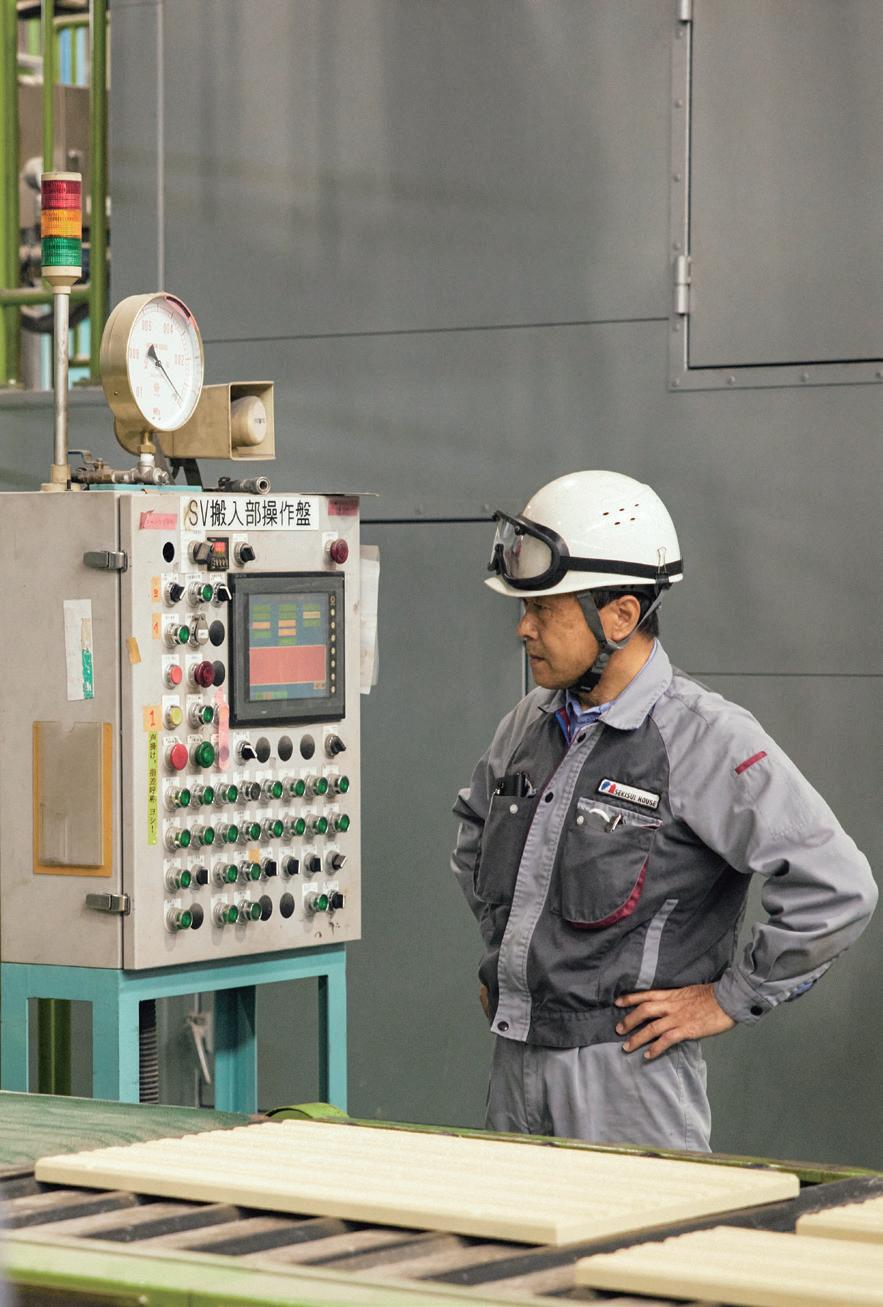
Our technical experts all share a drive to thoroughly experiment, verify, and validate on their own until they achieve satisfactory results. Strict standards are set for of durability based on the results of test equipment and actual field research findings. Over 10 years of research had been dedicated to developing the SHEQAS seismic control system and the Airkis high-quality indoor air system, including verification through the construction of full-scale houses.

A single house is said to require tens of thousands of components. If we cannot find a product that meets the required performance, we thoroughly pursue the desired specifications through internal development and joint research. By enhancing all structural elements, we consistently provide unwavering peace of mind.
The ground and foundations are crucial to the integrity of a house. In 1976, we became the first housing manufacturer to establish preliminary ground condition surveys, addressing the challenges of Japan’s prevalent soft ground. In 1972, we began researching foundation construction methods to ensure stable quality and improve durability.
In 1979, we started pilot testing aseismic technology, leading to the launch of seismic isolated houses in 2003 and the SHEQAS seismic control system in 2007. Since 1995, we have pursued improvements in seismic and wind resistance for wooden-frame housing. In 2006, we introduced a wooden-frame house that eliminates the need for a traditional foundation. We continue to develop construction methods that combine advanced foundation technology with spatial creativity.
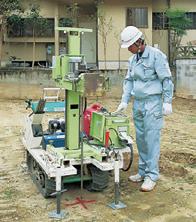

We have developed proprietary technologies and construction methods to ensure the durability and strength of the ground and foundations, which are critical in building construction. At our construction sites, to manage various conditions, we have developed methods allowing heavy equipment to be driven onto the foundation and self-propelled tower cranes that enable construction in narrow spaces.
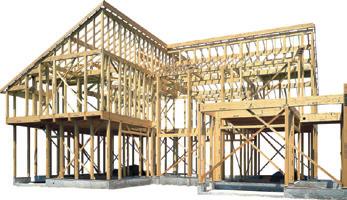
We have created a variety of original technologies, including proprietary steel and wooden-frame housing construction methods for spacious living spaces, heavy-gauge steel rigid structures for superior strength and large column-free spaces, and beautifully textured exterior wall materials with excellent functionality to achieve seismic resistance, fire resistance, impact resistance, thermal insulation, sound insulation, and crime prevention.
In September 2023, we launched the Skeleton and Infill (SI) Business, leveraging our advanced seismic technologies. With about 30% of existing houses in Japan not meeting new seismic resistance standards, we adapted our “foundation direct joints” technology for conventional construction methods. Using Sekisui House Construction’s precise techniques, we aim to enhance the seismic resistance of wooden-frame houses across Japan.
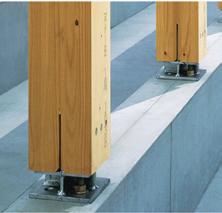
Continuing to pioneer the industry
From our founding, we have led the industry with groundbreaking efforts. At the start of the Skeleton and Infill Business, we developed meter modules (1,000 mm) instead of “shaku” modules. For existing houses, we contribute to creating high-quality housing stock by disseminating and advancing earthquake-resistant remodeling technologies, such as shape-memory shear walls introduced in 2002.
Competencies
We possess value unlike anything else in the world. This value is embodied in the spirit of “a community with a common destiny” that thrives in the strong relationship of trust between Sekisui House Construction companies and the Sekisui House Association. The strengths of the Sekisui House Group lie in this ever-deepening cohesion and in its construction capabilities, which bring together professionals with world-class skills and dedication. Our Story Happiness Created by



Based on the belief that “the most important part of a building is its foundation,” we established Sekiwa Construction in 1973 as a company specializing in foundation and construction work. We implemented a responsible construction system, conducting foundation work in-house to ensure high construction quality, and developed an integrated foundation casting method to improve and stabilize foundation quality. Sekiwa Construction was renamed Sekisui House Construction Group and continues to support this responsible construction system.


High quality is achieved through the dedicated aspirations and efforts of each and every person involved in the homebuilding process. As we practice a responsible construction system, the relationship with and presence of partner building constructors is irreplaceable. The Sekisui House Association consists of Group companies involved in construction and partner building constructors. Together, we collaborate to improve construction techniques and enhance the working environment.


Ensuring a safe working environment for the employees of our partner building constructors at our construction sites is a crucial responsibility. In 1982, we established the Sekisui House Cooperation Association, a voluntary organization aimed at promoting the welfare of Sekisui House, the Sekisui House Group employees, and partner building constructors. Through this association, we operate various benefit programs, including a funded pension system, hospitalization and income compensation programs, employment management guidance and subsidies, and skilled worker rewards.


In 1982, we established a vocational training school to enhance our ability to improve construction quality, pass on skills, and develop talent. Technicians from Sekisui House Construction companies, including partner building constructors, learn construction techniques, specialized knowledge, and skills. Graduates actively contribute as skilled workers and construction managers. We have also established an internal certification program and qualifications to foster the skills of our partner building constructors.

“Crafters,” our homebuilding craftsmen, to promote their development
P. 49 Recruiting and Training Crafters
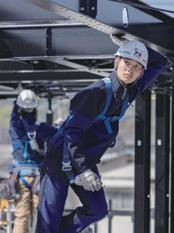

Construction Capabilities
The Sekisui House Group’s construction specialists are true artisans of homebuilding. Passionate about delivering the highest quality and technology, they demonstrate advanced skill and expertise to create works of art that combine beauty, functionality, and durability. Along with colleagues who share their passion, ambition, and dedication to continuous skill refinement, they are the driving force behind Sekisui House Group’s creation of unique value.

Our Progress
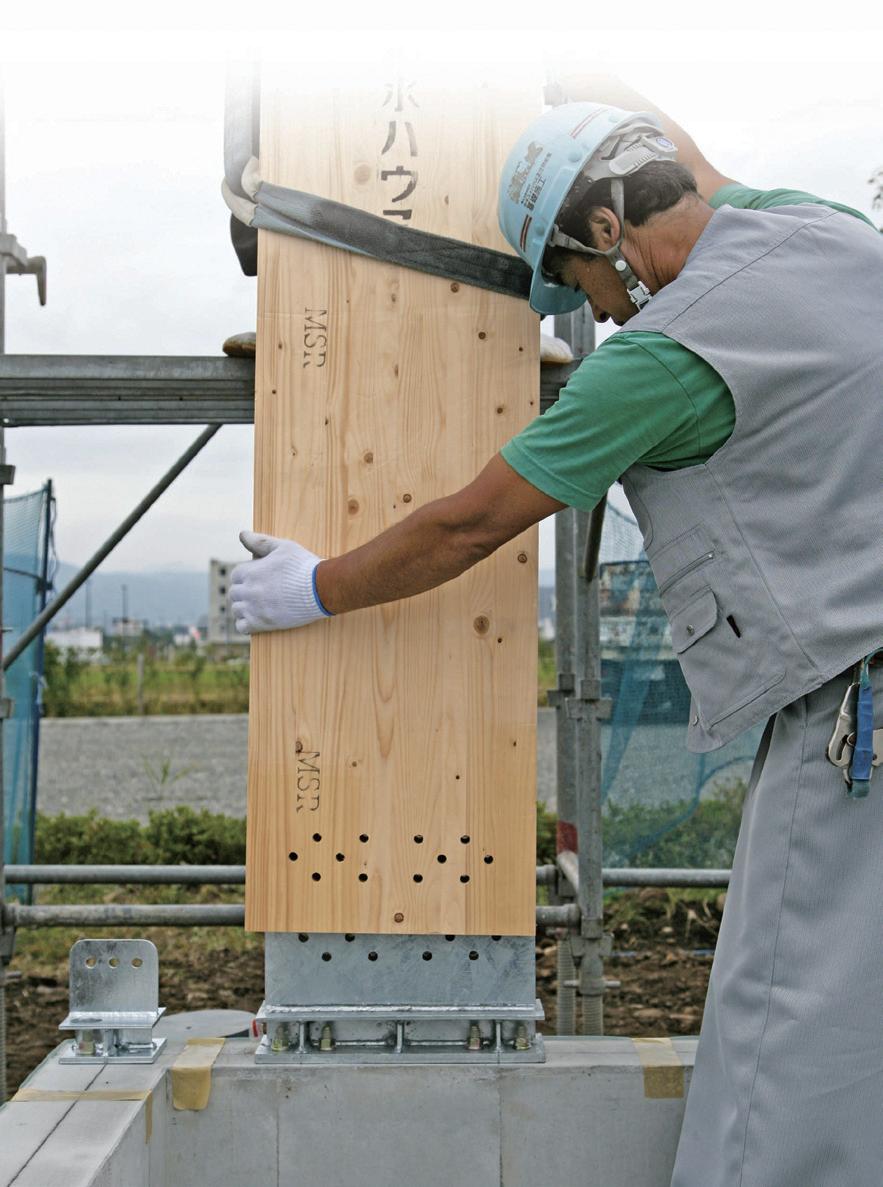
Under the responsible construction system implemented in partnership with Sekisui House Construction companies and partner building constructors, we provide stable, high-precision, high-quality construction, from structural framing to interior work. We build equal relationships with our partners and operate as “a community with a common destiny” to ensure safety measures during construction, achieve zero emissions on-site, and improve construction quality. All construction personnel are integral to our homebuilding efforts. With their outstanding skills and expertise, they meticulously work on structures from the foundation to the finishing touches. We also strive to build relationships of trust with our customers through integrity and responsibility. Our construction capabilities, one of our core competencies, are supported by both advanced technologies and the human spirit and dedication.
In 2023, we hosted the Sekisui House Carpentry Competition, WAZA, to honor the craftsmen of the Sekisui House Association, involved in homebuilding, and to showcase their exceptional skills. Selected from approximately 5,000 carpenters across Japan, 26 individuals were nominated from various regions and competed to be crowned champion by demonstrating their expertise in home interior construction over a period of two hours.
Based on the belief that a home cannot be completed without the efforts of many people, we, together with our partner building constructors, build a relationship of trust as “a community with a common destiny”. As a team, we deliver the highest quality and technology.
We take pride in providing quality and service that exceed expectations by adhering to rigorous standards. To ensure the durability and stability of buildings, we refine our craft through constant training and education. Our continuous improvement of skills leads to higher quality and greater trust.
Constantly striving for the highest construction quality and customer satisfaction, we combine our expertise and skills to ensure precise construction down to the smallest detail, maintain discipline, and approach our work with humility. By combining skilled techniques with meticulous attention to detail, we deliver happiness to our customers in the form of safe and durable homes.
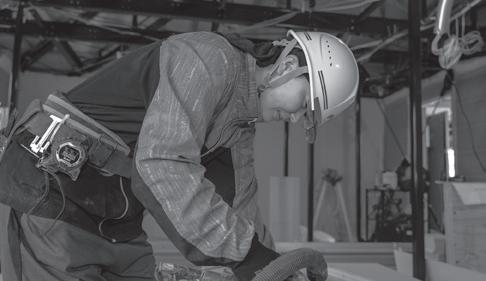












Home is a cherished place where happiness is nurtured. Advanced technologies and superior design mean nothing if our customers’ ideals and dreams are not met. Therefore, our philosophy of tailoring each home to the specific customer is fundamental. We value sharing our customers’ thoughts and fostering deeper connections, aiming to care for their homes throughout their lifetime. To achieve this, we constantly ask ourselves what is valuable and necessary for our customers, striving to create a future where happiness endures. Through continuous dialogue and heartfelt communication, we build long-lasting, deep connections with our customers, further strengthening our inherent customer-first philosophy.


Value
Connecting with customers is central to our business activities. We wish for our customers’ happiness and strive to understand their thoughts and ideas accurately, reflecting them in our designs, products, and services.
A home is a significant space filled with each customer’s dreams and hopes. It must continually evolve to meet these ideals while being adaptable to change. We build trust with our customers by delivering the highest quality and technology, providing inspiration and insight into everyday life.


For our customers, the relationship truly begins after they move in. We believe in the importance of continuing to take responsibility for their futures. As partners in happiness, we deepen our relationships with each customer by staying closely attuned and present in their daily lives.

We collaborate with our customers to deepen our understanding and create beautiful townscapes and enriching environments. By building strong ties and emotional connections with our customers, we strive to create environments where everyone can live happily for a long time, regardless of the era.

Throughout the Sekisui House Group’s journey, our unwavering desire has been to ensure customer happiness by listening to our customers’ feedback and engaging in heartfelt communication. As a Group, we are continuously evolving to move forward together with our customers. These strong bonds are the foundation of our technological innovation and business transformation. Creating happiness is the driving force behind our new value creation.
home is an important
a management system to conduct inspections and repairs promptly and accurately.





One thing that all employees of the Sekisui House Group share is a passion for pursuing happiness. Employees who harness this passion and leverage the resources of the Sekisui House Group to continuously seek happiness are the true strength of our company.
We place great importance on innovation and communication, proactive and independent action, and a sense of beauty.
These values, cultivated over many years as part of our organizational culture, form the core of the Sekisui House Group and shape our identity.
Our employees, with diverse perspectives and experiences, share these values, align their efforts, and continuously create new value together.




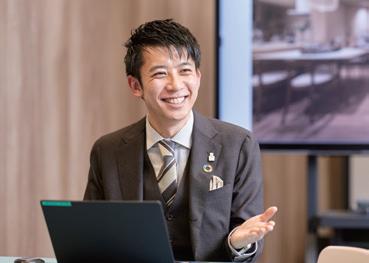



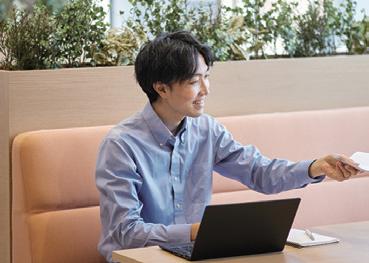


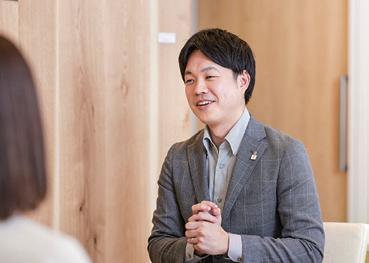
At the Sekisui House Group, our employees are dedicated to creating happiness. There is no single definition of happiness; each person has their own unique perspective. Every individual defines what happiness means to them and pursues happiness in their own way.


Value
Keywords for internal transformation
To continuously create new value, it is important for employees to freely share ideas and nurture them through open communication with their colleagues. Therefore, in 2018, we adopted “Innovation & Communication” as the keywords for our internal transformation.
management style
The best ideas often come from employees who work closely with customers. Therefore, we transformed our management approach from directive to communication-focused. At all levels, we foster an environment that encourages idea-sharing and nurturing, allowing employees to share their ideas freely and with confidence.
Innovation as value creation
Our catchphrase: “Submit this idea to SHIP!”
We consider innovation to be the process of changing existing methods and practices, even in small ways, to create value for customers and society. We believe that every role and every job type can be a driving force of innovation. Our leadership actively promotes this message, encouraging employees to think independently and take proactive action.
Among employees, “Submit this idea to SHIP!” is our current catchphrase. SHIP refers to the Sekisui House Innovation & Performance Awards, which began in 2021. Employees can post ideas and initiatives on our internal app, form teams, and refine their ideas. Ideas that pass a six-month review process may be implemented or institutionalized. Ideas generated from individual creativity are embraced and recognized by colleagues and managers. The catchphrase “Submit this idea to SHIP!” is fostering a culture of innovation and communication.
Our definition of innovation is to change existing methods and practices to create new value for our customers and society. Everyone has the potential to drive innovation.
Our Strengths
Since our founding, pursuing new ideas has been our core principle. Our mission to revolutionize Japanese housing has always involved questioning established norms and challenging ourselves to create new value using innovative materials and methods.
Communication has been a key factor in our growth and leadership in the housing industry. Many of the ideas and technologies that form the core of our homebuilding practices emerged from direct feedback received from customers on the 1961 Sekisui House Model B.
“My idea”
In 1988, we introduced the "My Idea" proposal system for our partner building constructors and onsite employees. This initiative encourages improvements in product quality and building methods at construction sites. We have received 57,929 proposals to date, resulting in the development of specialized tools, new machinery, and innovative construction methods.
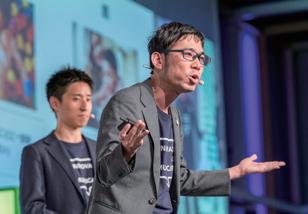
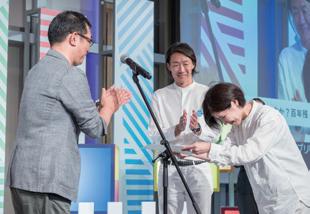
and Communication
The value created by “Innovation and Communication” is the driving force behind building a happier future. We are also creating new value through co-creation with various stakeholders.


With the goal of building a society and environment where children can continue to live happily, Sekisui House matches the charitable donations made by employees, supporting non-profit organizations through the Sekisui House Matching Program, established in 2006. Starting in 2023, we introduced a new social contribution initiative that transforms employee-initiated ideas into projects in collaboration with non-profit organizations.


The Sekisui House Group has offices in 46 prefectures and operates 29 Customer Service Centers across Japan. As we continue to deepen our ties to local communities while focusing on the happiness of our customers and society, our employees have suggested that we extend our efforts beyond charitable donations.

In 2023, we noticed that many employee-initiated ideas submitted to SHIP were aimed at solving social issues. We saw an opportunity to utilize these ideas to contribute to society. Consequently, we collaborated with non-profit organizations to develop projects that provide children with experiential opportunities and revitalize local communities.

Non-profit organizations often face challenges in planning activities, securing sufficient funding, and acquiring personnel. To address these issues, we developed a framework for contributing to society through ideas, charitable donations, and volunteering. We aspire to create new value through co-creation with our communities.
In February 2024, we established Sekisui House Innovation & Communication, Ltd., referred to as Sekisui House InnoCom. In addition to nurturing innovative and global talent, we create new value for society through open innovation with external partners, aiming to make people’s lives happier and more fulfilling.
In September 2024, we will open the InnoCom Square within Akasaka Green Cross. This open innovation center will serve as a hub where industry, government, and academia come together to create new value. The facility will be used to collaborate with businesses, local governments, educational institutions, and all our external partners to proactively address social issues related to housing.


Our Foundational Values
Our Story

Autonomous employees are the driving force behind the growth of the Sekisui House Group. Our concept of “Employee Autonomy × Alignment of Efforts” aims to maximize human capital value by encouraging employees to act independently, guided by their own values and beliefs, while aligning with the Company’s direction.

We believe that autonomy means making decisions about your own life. It involves following your own beliefs and passions while pursuing your values and dreams, rather than conforming to societal or external expectations. We see it as living your life and enjoying the journey to find your own happiness.
Autonomy begins with self-reflection and acceptance, rather than comparing oneself to others. While many of our employees proactively make their own decisions, we are dedicated to actively supporting those who seek greater autonomy.
As a partner to our employees, we provide support, encouragement, and access to resources and opportunities. Our commitment extends beyond skill enhancement and capability development to also include supporting their personal fulfillment.
In 2003, we launched a self-directed career development training program, allowing employees to reflect on their lives and personal connections without discussing work duties.
We encourage our employees to think and act independently, and have established programs and environments to support this.
We believe autonomy means contemplating how to lead a happy life and making decisions independently. It is about taking ownership of one’s own life instead of merely trying to meet someone else’s expectations.

Our employees take the initiative to independently make decisions about their lives and actions. This proactive approach is essential for our continuous success and growth as we create new value. Therefore, we emphasize supporting employees in their decisionmaking processes and goal achievement, rather than merely providing instructions.
At a time when self-direction or autonomy was a new concept, there were internal concerns that this training might lead some employees to leave the Company. However, we recognized the need for change and fostered autonomous thinking. This program continues today, with 18,962 participants to date.
Many employees see this training as a major turning point in their lives, helping them to pursue their own happiness and personal workstyle.
In 2021, we introduced employee-led career discussions. These discussions provide employees with the opportunity to share their career vision and goals, address current challenges, and identify the support they need from the Company and their supervisors. This process assists employees in outlining their ideal career paths and identifying the steps needed to achieve them. Through these discussions, we aim to cultivate a culture of autonomy, where employees take independent and proactive actions.
Independent and Proactive Action

Self-directed career development for employees is the foundation of the Sekisui House Group’s mindset. This means that each employee leverages our Group’s resources to their fullest extent and makes their own path. For instance:
“I will learn this specific skill from a supervisor.” “I will commit to caring for my parents this year.” “I will spend time with my child this month.” “I will use time for my own hobbies this week.”
We consider these examples to be valid forms of taking independent and proactive actions. Therefore, we are committed to creating environments that support individual autonomy and foster each person’s unique strengths.
Flexible options for half-day or hourly leave to accommodate various lifestyles
Various initiatives to reduce working hours
FY2023 performance
Average working hours per person/month: 169.58 hours
Adjust working hours to fit both departmental needs and personal life
Available for any reason, not limited to childcare, caregiving, pregnancy, or illness
Options for split caregiving leave and adjustments in work hours
Leave for taking care of children, including but not limited to illnesses or school absences
At least one month of paternity leave for male employees
FY2023 performance
Take-up rate: 100%
Average days taken: 31
Provide supports, including childcare expenses and assistance with securing childcare
Many female employees are active in roles such as sales, design, and site supervision, with annual training sessions available
Internal Mobility
Recruit talent for specific businesses, departments, or projects internally, allowing employees to apply freely and openly
An award program where employees can submit new ideas or past achievements, with winning ideas potentially being implemented
Self-Directed Career Development Course
Support understanding and practicing individuality and personalized working styles
Qualification
Rewards and Supports
Offer remuneration and support for obtaining 170 types of qualifications
Clarify goals and aspirations through discussions, supporting employees in working autonomously
Training Programs
Offer systematic training programs appropriate for each level and job type
(for technical experts)
Allow employees to gain experience in various tasks and fields over set periods
Leadership Development
Create a foundation to nurture next-generation leaders with continuous support and training programs
Career Leave / Advanced Learning Support
Support sabbaticals and attendance at graduate school for advanced learning
Provide training programs for all employees to prevent and address human rights violations
Engage in employee training and include LGBTQ+ considerations in HR and welfare programs
Visualize individual and workplace happiness to enhance job satisfaction, improve working environment, and increase employee happiness
Both homes and communities are social assets, serving as platforms that support people’s happiness. In enhancing their value, we place great importance on each individual’s sense of beauty. We focus not just on buildings but also on the lifestyles and personalities of the people who live in them, striving to create homes where everyone can continuously feel happy.


A sense of beauty is about feeling things deeply within one’s heart. It involves perceiving the world through one’s unique senses and having personal emotions that color life. That is why we emphasize creating homes that value each individual’s sense of beauty.
Nurturing a sense of beauty leads to happiness. Happiness is realized not only through comfort and aesthetics, but also through feelings of ease and satisfaction. We therefore prioritize designs and spaces that resonate with the heart.
Homes and communities are born from individual sense of beauty. Everyone possesses a unique sense of beauty that is nurtured through moments that touch the heart. We strive to gain insights from everyday life to cultivate this sense of beauty.
At Sekisui House Group, we customize each home to meet the specific needs of our customers. We go beyond the basic framework of buildings to achieve unique designs and subtle beauty. By reflecting the worldviews and sense of beauty of each resident in their homes, we pursue true happiness.
Unique, one-of-a-kind homes are designed by our architects. They combine our exceptional technology with a deep understanding of residents’ ideals and hopes, leveraging their sense of beauty and creativity in the homebuilding process.
Pursuing uniqueness
Among our first-class registered architects, the Chief Architects excel in their design prowess and ability to bring a sense of beauty to life. Selected through our rigorous certification program, they combine their senses and competencies to create homes that are truly one-of-a-kind.
In 1987, we launched our internal “Design Dojo”¹ training program to enhance our design proposal capabilities. This initiative has provided a platform for refining our skills, reviewing architectural works, engaging in client discussions, and participating in design competitions. 1 It has since evolved into the “CA Dojo.”
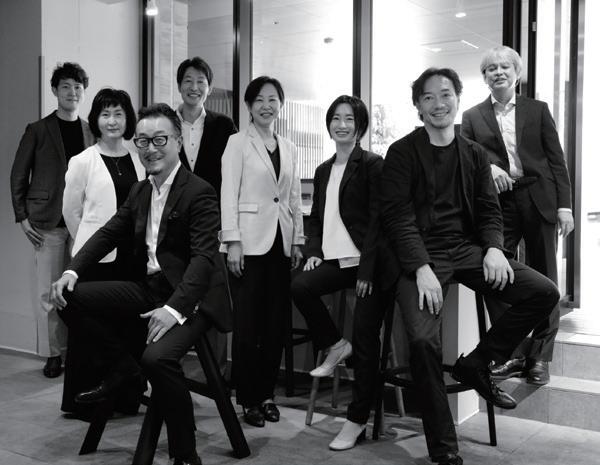
Our Chief Architects excel by leveraging our unique constructions that balance high seismic resistance with design flexibility. With over 2.66 million steel- and wood-frame homes built, we have a proven track record of delivering safety and comfort. Each home is brought to life through precise construction techniques, which serve as the foundation for combining advanced technology with aesthetic design. This synergy allows our architects to fully unleash their creative potential.
Our Foundational Values Sense of Beauty

Homes are cherished spaces that embody our customers’ hopes and dreams. By carefully selecting materials and utilizing advanced construction technology, we have successfully integrated functionality and beauty into our homebuilding.

In 1961, we transitioned from using plastic to wood for the interior of the Sekisui House Model B, achieving a design that values a sense of beauty. In 1984, we introduced exterior wall panels with exceptional durability, fire resistance, thermal insulation, and sound insulation. These panels were crafted by pouring concrete into specialized molds, resulting in refined elegance with deep carvings and intricate textures. This innovation established a new style for urban residences.
Enhancing beauty in towns over time
Beautiful townscapes, where the landscape feels unified, are created by multiple houses and abundant nature and are passed on as social assets.
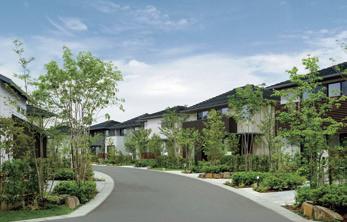
Starting in the late 1970s, we began designing towns based on the concept of Keinen bika which focuses on creating landscapes that become more beautiful over time. We harmonized housing with the overall design of towns, aiming to share scenic beauty and seasonal changes with the community. By integrating timelessly beautiful residences with the overall aesthetic of neighboring communities, we create towns that can be treasured for generations.
Weaving fondness into homes over time
The way beauty is perceived, the appeal of designs and textures, and the methods of enjoying comfortable spaces vary from person to person. In 2023, we introduced “life knit design,” a new system for proposing designs that reflect each individual’s sense of beauty in housing.

During the development of this design system, we analyzed approximately 6,600 images. Impressions of interior proposals regarding colors, materials, and shapes were articulated. By combining simple and beautiful spaces with carefully selected furniture and accessories, we create interior designs that resonate with each individual’s sense of beauty. We strive to create homes that become more cherished over time.
The warmth of the morning sun gently shining through the living room. The scent of a comforting breeze on a wooden deck. These are small moments that touch the heart in our everyday lives. We are dedicated to aligning with each individual’s sense of beauty, ensuring that these small joys continue to accumulate over time.
To ensure lasting happiness, we prioritize continuous dialogue with our customers, valuing the exchange of their ideals and aspirations. By maintaining close connections, we aim to support our customers’ futures and create enduring happiness.
on
To preserve the value of buildings and avoid the cycle of scrap and rebuild, we establish relationships with new homeowners even after ownership changes. Our Customer Service Centers and Group companies work together to promote the resale of existing homes, ensuring they remain valuable social assets.
In 2013, we launched Sumufumu Lab, the first open innovation hub in our industry. We have expanded to seven locations across Japan with SUMUFUMU TERRACE, offering spaces where ideal housing concepts and creative ideas can converge.
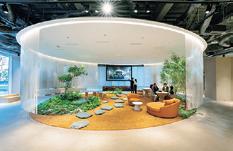
The Sekisui House Group is dedicated to crafting homes that bring happiness by evolving crucial performance features and environmental technologies, alongside innovation in lifestyle research and proposals. We manage a distinctive value chain that encompasses every aspect of home construction—from research and development to product development, design, technology, sales, procurement, production, construction, and after-sales services— enhancing our unique management capital and driving value creation.
To ensure the sustainability of our value chain, we have formulated strategic actions within our Sixth Mid-Term Management Plan (FY2023–FY2025), addressing significant risks and opportunities in line with our medium- to long-term management outlook. Management capital, which propels our business activities and drives value creation, is categorized into human capital and organizational culture; production and distribution bases; technology, research and development; energy and raw materials; construction capabilities and customer base; and financial foundation. Considering our operating environment, we orient resource allocation and investment decisions toward enhancing value creation and establish related indicators for key themes.
P.39 Management Capital
Striving for enhanced foundational performance in housing, we engage in R&D for “comfortable living—now and always” living spaces and lifestyle solutions utilizing advanced technology.

Pursuing the ideal home, we plan residences for enduring happiness through tailor-designed solutions, leveraging our product development and sophisticated design capabilities.

At the forefront of customer engagement, we commit to heartfelt consulting and valuable proposals to create the ideal home, aiming to forge lasting and strong relationships of trust.

Constructing a home requires tens of thousands of components. We adhere to a procurement policy emphasizing synergy and mutual prosperity with suppliers, dedicated to sustainable sourcing.

We have established a unique production system for customized management from manufacturing to delivery. Under our industrialized quality control regime, we ensure high quality for every home.

The Sekisui House Construction Group and the Sekisui House Association secure reliable construction quality under our Group’s responsible construction system and structure.

As lifelong partners in happiness who constantly care for the homes of our customers, we provide lasting reassurance through our robust after-service structures and support schemes.

• Established the world’s largest Comprehensive Housing R&D Institute in 1990
• Opened Japan’s first Human Life R&D Institute in 2018, dedicated to happiness research
• Conducts R&D utilizing our extensive housing data and expertise
• Pioneering original technologies that set industry standard
• Home to 3,172 first-class architects as of FY2023
• Chief Architects, nurturing elite in-house architectural talent
• Trust and a strong track record nurtured over time, and a commitment to aligning with customer needs
• Consulting skills to uncover latent needs, leading to proposals for long-term happy living
• Ability to generate proposals for corporate entities and public organizations
• Robust supply chain structured for coexistence and mutual prosperity with suppliers
• Engagement in CSR procurement as aligned with the United Nations Global Compact¹
1 P.242 Participation in International Initiatives and Activities with Government and Industry Groups
• Commitment to FairWood procurement in accordance with our Wood Procurement Guidelines
• A robust production and quality management system leveraging AI, IoT and big data analytics alongside robotics
• House-specific production enabled by adaptable production lines and logistical support
• In-house development of production technologies integrating the latest advancement
• Construction capabilities and the synergy within the Sekisui House Construction Group and about 7,000 partner organizations, bonded by the spirit of a community with “a common destiny”
• Group-wide system for construction quality control, continuous improvement, and record management and retention
• Three education and training centers across Japan and a technical training facility in Vietnam to cultivate future talent
• Commitment to customer service that leaves a lasting impression on customers
• Extensive after-sales service structure with approximately 1,500 dedicated employees
• Information system for centralized management of maintenance data starting from new construction
• Potential loss of business opportunities due to slow or inadequate responses to technological innovation and social challenges
• Escalating severity of natural disasters exacerbated by climate change
• Adapting to lifestyle changes
• Embracing value diversification
• Broadening spectrum of housing performance expectations (environmental adaptation, disaster response, health safety, etc.)
• Intensifying competitive environment
• Changes in housing policy
• Changes in and end of support measures for home purchases
• Escalating costs and limitations in raw material supply
• Repercussions from natural disasters and geopolitical instabilities
• Human rights considerations within the supply chain
• Impact of wood procurement on ecosystems and forests
• Rapid increases in the costs and availability of raw materials
• Increasing logistics expenses and scarcity in transportation personnel
• Workforce shortages at production line sites
• R&D aimed at decarbonization
• Threats of cyber attacks on production systems
• Decrease in construction capabilities due to aging and shortages of skilled personnel
• Shortage of human resources caused by employee turnover and recruitment shortfalls
• Reduced construction site productivity due to climateinduced environmental degradation
• Occupational accidents and accidents involving the general public
• Decline in customer satisfaction due to service delays
• Potential for data leaks, including customer information
• Focusing R&D on housing disaster risk, societal sustainability, and longevity solutions
• Developing environmental technologies for houses that contribute to health
• Facilitating R&D through collaborative efforts across sales, technology, production, and other departments
• Collaborating externally on R&D efforts (with other companies, academic institutions, etc.)
• Enhancing and nurturing the R&D talent pool
• Undertaking design R&D centered on customer happiness
• Advancing environmental technologies for a sustainable future
• Innovating original technologies to create high-quality housing stock
• Advocating for long-life quality housing
• Proposing the creation of assets that offer value for customers and local communities
• Reinforcing inter-company collaboration to reliably capture business opportunities
• Encouraging the active participation by female sales representatives
• Solidifying the resilience of the entire supply chain, including secondary and tertiary suppliers
• Fortifying CSR procurement that pursues coexistence and mutual prosperity with suppliers
• Advocating for decarbonization and respect for human rights throughout the supply chain
• Advancing our commitment to FairWood procurement
• Championing zero deforestation practices
• Enhancing quality control and reforming production and logistics by further utilizing advanced technologies
• Streamlining production through advancing automation and fostering a worker-friendly environments
• Moving forward with decarbonization strategies, including raw material recycling, energy conservation, and energy transition conversion, while bolstering cybersecurity
• Enhancing work efficiency and improving conditions at construction sites and work environments for greater safety and happiness
• Recruiting and nurturing diverse talent
• Strengthening collaboration with Konoike Construction, known for traditional construction expertise and civil engineering business
• Strengthening trusting relationships with homeowners
• Enhancing availability and responsiveness for service through 24/7, 365 days phone support and AI chatbot technology
• Reinforcing information management and response strategies
Value Creation
We are deepening our well-established technologies for safety, security, comfort, and environmental consideration. These form the foundation of our comprehensive R&D efforts that integrate technologies, lifestyle designs, and services, all striving to cultivate happiness in the era of the 100-year lifespan.
Dedicated to consistently outpacing competitors with the highest quality and technology, we are at the forefront of developing products that align with homeowners’ requirements. Leveraging sophisticated design proficiency, we realize personalized “free-design” homes that encapsulate each resident’s unique vision.
Sales, serving at the front line of customer engagement, closely aligns with customer needs to deliver proposals that shape the perfect home, nurturing enduring and robust relationships of trust for the future.
Building a house requires an intricate assembly of numerous components. Embracing our CSR Procurement Guidelines, we collaborate with diverse suppliers to achieve sustainable procurement practices.
Our distinctive production system manages each phase from manufacturing to delivery individually for every home, consistently assuring high quality across all homes under our sophisticated quality control for industrialized housing.
We have instituted a responsible construction system through the Sekisui House Association, consisting of all Sekisui House Construction companies and partner organizations, where we maintain a construction environment that nurtures high quality and fosters the advancement of construction techniques.
Proper after-sales service, which we regard as intrinsic to a home’s value, assures continual comfort for residents. We offer unwavering peace of mind through long-lasting support, embodied by programs, such as our initial 30-year warranty program and U-trus System.
Capital
Human capital
Talent and corporate culture
What we aim to be
We aim to elevate the value of our human capital by promoting employee autonomy and ensuring alignment of efforts. Our strategies include actively recruiting diverse talent, supporting skill enhancement through our internal certification program, and focusing on strategic workforce placement. Additionally, we are dedicated to cultivating a workplace culture where all employees can actively engage in innovation and communication.
Key themes and related indicators

Manufacturing capital
Production and
distribution sites
Intellectual capital
R&D and technology
Our domestic operations encompass production sites (factories) equipped with manufacturing production lines and distribution bases (logistics centers) responsible for delivering materials to construction sites across the country, enabling customized home construction. To minimize environmental impact, we have adopted a modal shift to rail for transporting materials between factories. We have also invested in enhancing production facilities to improve production efficiency and in component production equipment crucial for our development business.
We are advancing cutting-edge research and development across a broad spectrum, from enhancing the quality of detached houses, rental properties, and other properties to pioneering new technologies and improving comfort and environmental performance. Furthermore, we are nurturing an innovative culture and proactively focused on technological advancement and breakthroughs to drive sustainable growth.

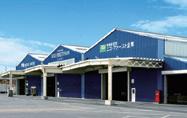
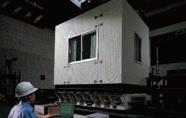

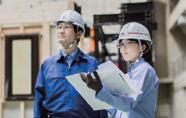

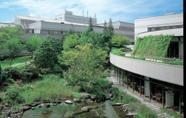
Natural capital
Energy and raw materials
We are dedicated to sustainability-conscious CSR procurement. Our approach includes FairWood sourcing, securing forest certification, and fostering coexistence and mutual prosperity with our suppliers through procurement due diligence and supporting the local production and consumption of domestic lumber. Moreover, we are committed to reducing energy consumption and minimizing environmental impact through our proprietary initiatives. Social capital
Construction capabilities and customer base
With the industry’s leading total number of homes built, we boast a robust customer base supported by our construction capabilities. Our construction framework binds the Sekisui House Group and partner construction companies together in a shared commitment to our common goals under the spirit of “a community with a common destiny,” and our after-sales service, managed by our Customer Service Centers, strengthening our enduring connections with homeowners.
We believe that establishing a strong financial foundation is essential for supporting sustainable growth. With a strategy that promotes steady growth domestically and active growth internationally, we manage our finances with a focus on our credit rating and maintain financial health at an appropriate level.



Since its founding in 1960, the Sekisui House Group has contributed to solving social issues that arise in each era through its business activities. Our Global Vision, “Make Home the Happiest Place in the World,” is a promise for the future, and we will continue to create further social value and enhance our corporate value to realize this vision.
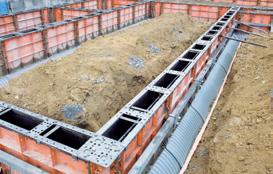











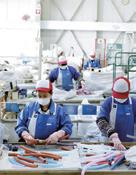

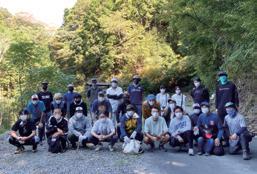





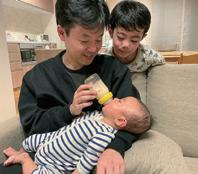

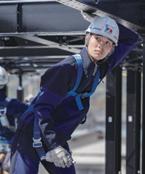




As housing is a crucial component of social infrastructure, we are committed to passing on high-quality housing that can be lived in and cherished by future generations.


We establish the foundations for a future that enables enduring happiness and sustainable living by reducing environmental impact, utilizing renewable energy, and coexisting with local communities.


We create an environment in which everyone can find opportunities for self-fulfillment and growth with peace of mind, while making the most of their individuality and abilities.


The Sekisui House Group has developed various business activities centered on housing. Since 2020, under the Global Vision, “Make Home the Happiest Place in the World”, we have been actively engaging in addressing issues surrounding our customers and society through our business activities, aiming to foster a sustainable society and elevate our corporate value.
At the Sekisui House Group, creating new value that contributes to society lies at the heart of “Love of Humanity”, the foundational philosophy underpinning our Corporate Philosophy.
We define “Love for Humanity” as the faithful execution of all actions grounded in an awareness that each and every human being is precious and irreplaceable, wishing for the happiness of others, making their joy our own, and acting with integrity and in the spirit of service. This philosophy also carries three meanings.
The first is that “a company is composed of its people.” Hence, when each employee embodies “Love of Humanity,” it fosters a dynamic, inclusive management culture that propels the Group’s enduring growth. The second is to “develop and deliver products that fulfill customers’ desires with happiness as our priority,” thereby realizing customer satisfaction and contributing to the Group’s strengthened credibility and reliability. The third is to “always aim to be truly beneficial to customers and contribute to society” in the development of products, creation of high-quality environments, and rigorous selection of new business endeavors.
“Love of Humanity,” our fundamental Philosophy, which embodies these aspirations, is the very nature of our business activities. Our
business activities have been at the forefront of redefining perceptions of housing and transforming lifestyles, thereby significantly contributing to the resolution of social issues. Our founding spirit of contributing to societal advancement has remained unchanged over the years and is now manifesting in our dedication to ESG management.
The Sekisui House Group’s ESG management is to practice “Love of Humanity,” the fundamental philosophy of our Corporate Philosophy. It reflects our dedication to fostering and proactively working towards the happiness of our customers and society. It is about valuing our workplace as a “home away from home” and cooperating with one another for the happiness of our colleagues and families. We believe that these fundamental human sentiments are at the heart of ESG, and that by faithfully implementing them, we can continue to innovate for the future and create new value. Based on these principles, we have adopted the concept that “the Company exists within ESG.” We do not evaluate our business activities solely on profitability, but on whether they bring happiness to our customers, society and employees. Additionally, we integrate ESG perspectives into our business strategies and decision- making, recognizing that strengthening our ESG initiatives and performance enhances our corporate value.

Since our founding in 1960, the Sekisui House Group has been committed to creating value for society and achieving sustainable growth by solving issues faced by customers and society through our business activities. Despite our continued efforts, pressing social challenges persist on a global scale, including environmental deterioration, an increase in natural disasters, a decline in birthrates, an aging demographic, urban population concentration, and unyielding poverty cycles.
In order to realize our Global Vision, we must continue to make unprecedented innovations whilst considering how we can address these critical social issues and how we can enhance societal conditions. In other words, the ESG management we pursue entails an unceasing quest to exert a positive impact on society and the environment, thereby forging new ESG values.
Employees are at the forefront of creating new value. We engage in ESG management that prioritizes the participation of all employees, based on the belief that if each individual proactively considers what value they can create for customers, society, and their colleagues, and takes initiative, it leads to the happiness of all.
By internalizing ESG as a matter of personal responsibility beyond mere business tasks and taking the initiative to put it into practice, we propel business activities that set global standards and continuously foster the creation of new ESG values.
Creation of High-Quality Housing Stock
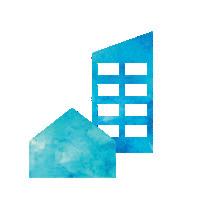

Contributing to a Sustainable Society

Diversity and Inclusion

Creation
Creating homes to be passed down to future generations and communities that will be loved for years to come
Safe, comfortable and beautiful homes.
These are the homes that will be passed down through generations, and lived in by different residents over time.
With each passing year, their beauty deepens, enriching the lives of those who live within.
When these homes come together, they gradually form communities that people love.
To create homes and communities that will be cherished for years to come.
That is what we are dedicated to.
Contributing to a Sustainable Society
Creating a future that benefits both global society and the environment, starting with comfortable living
While residents enjoy comfortable lives, we shape a future that benefits both global society and the environment. Among one of the first to acknowledge this important matter, we have been earnestly addressing the relevant issues through our unique ideas and technologies.
We will continue our efforts to create homes that coexist with nature.
Lifestyles powered by renewable energy reduce environmental impact in production and disposal, revitalize communities, and develop frameworks for decarbonization.
Diversity and Inclusion
From the happiness of employees to the happiness of society
Make Home the Happiest Place in the World. This Global Vision we uphold can only be achieved if each and every person involved with housebuilding feels happy. The happiness of our employees is the key to fostering the happiness of our customers and the wider society. Accordingly, we engage in various initiatives to support diverse ways of working and living.
The Sekisui House Group has identified “creation of high-quality housing stock,” “contributing to a sustainable society,” and “diversity and inclusion” as key initiatives to be prioritized and addressed as material issues.
These material issues embody the purpose of the Sekisui House Group’s existence, and have been formulated to unify the direction of all employees towards value creation.
For the Sekisui House Group, material issues are regarded as a long-standing mission rather than transient objectives. They serve as a compass for the future, drawing on the enduring strengths and core principles established since our founding, as well as guiding the business endeavors that have embodied our mission throughout the past 60 years.
To realize our Global Vision, we must create the added value of happiness through our business activities and address pressing issues imposed on our customers and society. The Sekisui House Group revised our material issues in 2022 by identifying those that are important to our stakeholders and the impact our business activities have on the economy, the environment and society.
In revising our material issues, we deliberated on the long-term challenges and social missions that the Sekisui House Group ought to undertake, whilst reflecting on our historical initiatives. We deepened our understanding through discussions at Management Meetings and through the exchange of opinions with various stakeholders, including external experts. Consequently, we identified three material issues that are paramount to the Group’s long-term fulfillment of our mission and sustainable growth. Moreover, we defined priority themes for these material issues, delineated targeted initiatives, and specified progress indicators. The advancement and monitoring of these initiatives are primarily managed under the Group’s ESG Management Promotion Structure.
P.57 Indicators and Progress
Identifying and organizing key themes Writing our corporate story Identifying material issues
Reflecting on our history since our founding, we identified eight paramount and enduring themes. We identified their interplay with our business activities and reasserted that our historical initiatives to date align with “Love of Humanity”, the foundational philosophy of our Corporate Philosophy.
Note: These eight key themes are: seismic resistance performance; landscape and aesthetics; ecosystem preservation and biodiversity; insulation performance and CO reduction; resource recycling; coexistence with local communities; health, connectedness and learning; and employment retention and human resource development.
Based on eight themes, we categorized the innovations we have developed and the employees that have supported them, constructing a corporate story that covers each 30-year stretch as a single phase. We identified social issues related to our business activities, determining the elements vital to our business activities and the creation of value.
P. 21 Our Corporate Story
We identified three priority areas that need to be addressed based on our corporate story. Subsequently, with approval from the Board of Directors and through discussions among top management as well as deliberations by the ESG Promotion Committee, which includes external experts, these three areas have been designated as paramount material issues of the Sekisui House Group.
P.92 The ESG Promotion Committee
The Sekisui House Group has continued to expand our business domain since the formulation of our First Mid-Term Management Plan* in FY2010, attuned to changes in the business environment, risks and opportunities. In 2020, we promoted our business activities under three sub-visions and three material issues, with the Global Vision serving as our 30-year vision of what we aim to be in 2050. The Mid-Term Management Plan operates as a crucial milestone in realizing this vision, and the first three-year plan to include specific initiatives in priority areas was the Fifth Mid-Term Management Plan, which produced reliable results.
The Sixth Mid-Term Management Plan, which began in FY2023, adheres to the fundamental policy of achieving “stable growth in Japan and proactive growth overseas,” and has been formulated with further growth strategies and priority measures, reflective of evolving external conditions. Leveraging the array of strengths and resources we have amassed, we are committed to taking significant steps forward in creating social value and ensuring the sustainable growth of the Group.
Note: The Mid-Term Management Plan outlines a strategy to lay the groundwork for growth and the development of new areas of business over the next three years. It involves revising the business portfolio and optimizing management resources with the aim of deepening our expertise in housing and providing innovative solutions, while maintaining flexibility to respond to changes in society.







The Sekisui House Group has sought to analyze medium- to long-term issues that affect value creation, identify risk factors associated with changes in the external environment, and position risks as opportunities for future business development. These inputs are, in turn, utilized to formulate business strategies.
Changes in the external environment
Society and Life

Housing and

Environment and Resources

Economy and Distribution

Business and Labor

Technology and Science

• The coming era of the 100-year lifespan
• The COVID-19 pandemic and the “New Normal”
• Increasing health consciousness
• Declining population and number of households
• Obligation to comply with energy saving standards
• Acceleration of compact cities
• Construction worker shortage
• Shift to long-life quality housing and greater earthquake resistance for wooden-frame housing
• Promotion of carbon neutrality
• Biodiversity conservation
• Promotion of a circular economy
• More frequent natural disasters
• Geopolitical risk concerns
• Rapid rises in raw material prices
• Rising energy costs
• Rising interest rates and fluctuations in foreign exchange rates
• Respecting diverse human resources
• Supporting employee autonomy and career advancement
• Balancing work and family life with child rearing and nursing care
• Acceleration of globalization
• Diversifying IT technologies
• Development of energy storage technologies and shift to electric vehicles (EVs)
• Legacy system renewal
• Application of advanced technologies
• Increased frequency rate of accidents within residences
• Increasing complexity and difficulties with asset inheritance
• Inadequate responses to changes in lifestyles and values
• Inadequate support for advanced health-related technologies
• Decrease in the number of new housing starts and worsening problem of unoccupied houses
• Inadequate response to changes in circumstance, such as an increase in foreign visitors to Japan
• Decreased demand due to higher construction costs
• Decline of rural areas
• Decrease in supply capacity due to shortage of construction capacity, and discontinuity in transfer of construction skills
• Increasing severity and frequency of natural disasters caused by climate change
• Increased costs due to introduction of carbon pricing
• Deforestation and damage to biodiversity
• Increase in social issues due to mass waste disposal
• Increased severity of natural disasters
• Unstable supply of raw materials
• Decreased demand due to higher construction costs
• Inadequate response to declining demand and fluctuating rents
• Diversification of lifestyles and values
• Need for circulation of existing housing and real estate management trusts
• Increased demand for health-conscious housing, etc.
• Increased demand for quality housing
• Need for new housing
• Increased demand for housing with high energy-saving performance, etc.
• Need for regional revitalization
• Job satisfaction for construction workers
• Increased demand for highly durable housing, etc.
• Increased demand for housing with high energy-saving performance, etc.
• Increased use of renewable energy
• Business opportunities based on natural capital and biodiversity conservation
• Business opportunities based on a recycling-oriented society
• Increased demand for highly durable housing, etc.
• Opportunities for sustainable growth by reviewing business and structure
• Business opportunities through government housing-related policies and taxation
• Business opportunities to respond to regional and customer needs
• Decreased productivity due to worsening psychological safety
• Loss of opportunities to acquire human capital and outflow of human capital
• Slowing growth potential
• Increased political and economic uncertainty
• Decline in social reputation due to human rights issues
• Decline in social reputation due to occurrence of information security incidents
• Value creation through diverse human resources
• Value creation through self-motivated employees
• Increased demand for childcare and nursing care facilities
• Increase in demand for high-quality housing overseas
The Sekisui House Group’s response to risks and opportunities
Safety, peace of mind and comfort
Asset value creation
Extended useful life of housing
Coexistence with local communities
Occupational health and safety/supply chain


Safety, peace of mind and comfort
Extended useful life of housing
Decarbonization By delivering the highest quality and technology, Sekisui House provides housing of value in which customers can live for generations by pursuing beautiful exterior design and outstanding housing performance.
Extended useful life of housing
Decarbonization

Extended useful life of housing
Asset value creation

Decarbonization
Biodiversity conservation
Resource recycling
Coexistence with local communities
Occupational health and safety/ Biodiversity conservation Resource recycling
Extended useful life of housing
Promoting diversity
Employee health and happiness
Diverse workstyles / job satisfaction / Human resource development / self-directed career development Occupational health and safety/ supply chain Safety, peace of mind and comfort
As a leader in housebuilding, Sekisui House strives to foster harmony between people, communities and the planet while working to contribute to a sustainable society through our businesses, including those in the supply chain.

and Inclusion

• Business opportunities using digital technology Asset value creation
Promoting diversity
Employee health and happiness
Diverse workstyles / job satisfaction
Human resource development / self-directed career development
Sekisui House supports organizational and individual autonomy, encouraging continuous and independent efforts to take on new challenges, with the aim of creating happy workplaces that are akin to home for employees.






To provide a clearer understanding of the Sekisui House Group’s pursuits in creating new value through our business activities, we have outlined the interconnection between our Sixth Mid-Term Management Plan (FY2023-2025) business activities and material issues within this Value Creation Roadmap. Specifically, we aim to enhance the housing market by extending homes’ lives, increasing asset value, and advancing decarbonization through improved housing performance, proposing new living styles, and reducing environmental impacts. It also includes initiatives concerning children, fostering diversity, and contributing to a sustainable society where future generation can thrive with happiness. Through this framework, we intend to clarify how our business activities can address societal issues and create value. We will also use this information to identify priority areas and assess our performance.
In this section, five stories are presented along with insights from the employees who are engaged in these business activities (marked with a symbol).

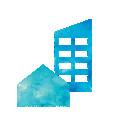
Our mission
In our commitment to delivering homes that blend functionality with beauty, we offer valuable homes designed to endure for generations.
Key policy
We regard housing as a vital form of social capital, similar to roads, railways, gas, electricity and water. As social capital, it is our mission to preserve and provide quality housing that can be lived in for the long term and passed on to future generations.
Key themes
Safety, peace of mind and comfort
Asset value creation
Extended useful life of housing
In Japan, a country prone to earthquakes and other natural disasters, many homes fail to meet seismic and thermal insulation standards, and the aging of existing housing stock is prevalent. Moreover, the housing shortage problem is worsening globally, and supplying housing that maintains long-term value while providing safety, security and comfort, has become a critical concern. Through the creation of highquality housing stock, we aim to contribute to the sustainable development of regional communities and the global environment, while improving people’s lives and asset value.
Social
Seismic-resistant and durable housing keeps people safe while providing improved disaster prevention performance and health-conscious housing to create a living environment in which people can continue to live happily and with peace of mind.
By introducing state-of-theart technology and improving energy efficiency, we provide comfortable and convenient living spaces, contributing to the creation of ideal living environments and more livable communities.
Asset value creation
Implementing superior designs that enhance the overall townscape and the use of high-quality construction materials contributes to longterm stability of asset values as well as to higher asset values for local communities.
Extended useful life of housing
By improving the durability of new houses and the asset value of good-quality existing houses, we provide environments that are safe and comfortable over the long term and promote the resale circulation of existing houses.
Key initiatives
Homes assisting happiness in the era of the 100-year lifespan
We have developed PLATFORM HOUSE touch, a smartphone app synchronized with floor plans that allows users to monitor the status of their home and the whereabouts of their family members within the house at any time, offering a new way of living that connects people to their homes.

In our international endeavors, where we engage in condominium and residential land development, we are working to create long-lasting homes and communities by incorporating satoyama, the disappearing native landscape of Japan; the concept of keinen bika or creating a landscape that grows more beautiful over time; and advanced technologies.
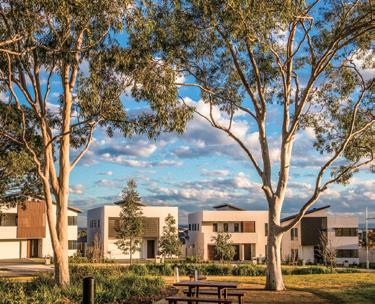
In order to ensure long-term stable management for rental housing owners, we provide support for rental operations, such as assisting with tenant recruitment as well as building maintenance and management, by leasing our rental housing in bulk.

8.4 million detached houses in Japan do not meet new seismic resistance standards
In Japan, 8.4 million detached houses, representing 29% of the total, were built before the implementation of new seismic resistance standards over 40 years ago. Moreover, as many as 5 million houses, or 17% of the total, have been found to lack adequate seismic resistance. In areas severely impacted by the 2016 Kumamoto earthquakes, 25% of wooden-frame houses built under the new seismic resistance standards suffered substantial damage and either collapsed, toppled, or were partially or completely destroyed.2 This highlights the pressing need for enhancing seismic resistance capabilities of housing in Japan.
1 Based on the Basic Tabulation on Dwellings and Households in the 2018 Land Survey conducted by the Ministry of Internal Affairs and Communications.
2 Data from the Ministry of Land, Infrastructure, Transport and Tourism as well as from analyses and observations, summarized in technical papers at the annual meeting of the Architectural Institute of Japan, on the comprehensive survey results from the town of Mashiki after the 2016 Kumamoto earthquake.
Proactively pioneering seismic technologies ahead of national standards, our buildings have maintained a record of zero3 complete or partial demolitions during the major earthquakes in 1995, 2011 and 2024. Our seismic resistance technology adopts the “foundation direct joint construction method,” which connects foundations and columns directly, bypassing the need for a separate baseplate. This technology ensures uniform strength against multidirectional forces and results in a structure that is less susceptible to column dislocation or detachment.
In 2023, we initiated the SI Business to elevate Japan’s residential seismic resilience by broadly disseminating our long-established seismic resistance technologies, while ensuring structural safety.
3 Excluding instances of land displacement and tsunamis.
Skeleton and infill business (Japanese only)
In our SI Business, Sekisui House designs the “skeleton,” or structural framework, of wooden houses, while Sekisui House Construction handles the foundation and structural work. Partner companies complete the “infill” work, which includes interior and exterior finishes, and also sell the homes. We are enhancing the creation of high-quality housing stock by expanding our offering of woodenframed housing with high seismic resistance, integrating our Group’s technical and construction expertise with the unique strengths of our partner companies nationwide.






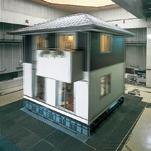
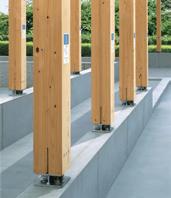


In Japan’s construction industry, concerns about maintaining housing quality and stability of supply are on the rise due to an aging workforce, a declining number of young entrants, and the “2024 Program”1 a regulation capping overtime work from April 1, 2024. Conversely, there is an acute demand for skilled workers capable of addressing domestic housing needs and creating high-quality housing stock with superior seismic resistance, thermal insulation and other important aspects.
To maintain and improve construction quality, the Sekisui House Group has committed to establishing a robust construction framework while also focusing on workforce development and the passing down of technical expertise.
1 Refers to the challenges, including a labor shortage arising from tighter regulations on overtime work beginning April 1, 2024. (The maximum number of annual overtime hours is capped at 720 in the construction industry, along with other industries.)
At the Sekisui House Group, we place a high emphasis on nurturing skilled workers, and have established educational training centers in three locations across Japan. These centers offer practical training in home construction techniques alongside the passion of craftsmanship.
In 2023, to foster a sense of pride among construction professionals, we introduced the term “crafters” for our housing construction staff, and created new uniforms that blend style and practicality. We also revised job classifications into four distinct ranks to align with improved compensation schemes, implementing a remuneration system that consider both rank and business performance. Additionally, we have further strengthened initiatives for developing human resources by implementing a skill matrix that visualizes the individual construction capabilities of each crafter and adopts a more objective personnel evaluation process.
Delivering excellence in quality and technology consistently
With the evolving landscape of homebuilding, multi-skilled craftsmen are increasingly in demand. To address this, we’ve introduced a skill matrix that visually maps skill levels and categories, fostering the growth of highly skilled crafters and clarifying their career trajectories. We are also reinforcing workstyle reforms to cultivate a work environment that ensures crafters can work comfortably and securely.
Dedicated to training skilled craftsmen in homebuilding and honing their expertise, we are committed to offering superior quality and technology, thereby advancing the creation of high-quality housing stock.

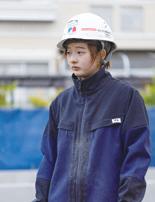
Recruitment achievements for crafters handling foundations and framing
new hires in April 2024 (340%
•
• Established four job ranks and implemented skill matrix for evaluation
• Enhanced transparency of construction skills and fostered multi-skilled workforce development Improved employee benefits
•
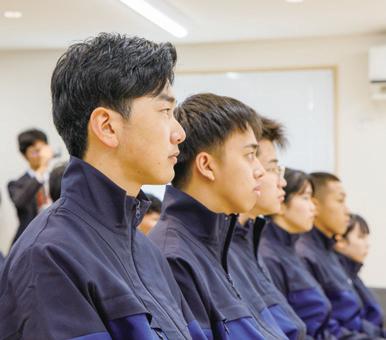
Output Outcome Impact
Introducing the crafter title
Evaluating through skill matrix
Improving remuneration
Enhancing workstyle reforms
Implementing new uniforms
Training at educational training centers
Visualizing job ranks, skills and evaluations
Enhancing career development and motivation
Stabilizing work and life conditions
Fostering personal and family happiness
Acquiring and transferring technical skills
Cultivating multi-skilled talent
Improving housing quality and stability of housing supply
Creating high-quality housing stock
Creating employment and revitalizing regional economies


Our mission
We are pioneering a future where people can continue to live with greater happiness by actively advancing environmental impact reduction and renewable energy utilization, and fostering cooperation with local communities.
Key policy
We strive to foster harmony between people, communities and the planet, while working toward achieving a sustainable society through our business activities, including those in the supply chain.
Key themes
Decarbonization
Biodiversity conservation
Resource recycling
Coexisting with local communities
Occupational health and safety/ supply chain management
Global environmental issues such as climate change, loss of biodiversity and resource depletion are intensifying, placing an immediate priority on transitioning to a decarbonized society. Energy conservation, CO2 reduction and the shift towards a circular economy have also become key issues in the Japanese housing industry.
The Sekisui House Group is dedicated to achieving a sustainable society in partnership with diverse stakeholders by providing environmentally-friendly houses and buildings, advancing technological developments, offering high-quality services, and striving to coexist with local communities.
Achieving decarbonization
Approximately 16% of Japan’s total CO2 emissions originate from the residential sector. Given this, we promote decarbonization by strengthening efforts to improve thermal insulation and energy-saving measures through the advancement of energy efficient housing.
Conserving biodiversity
By promoting sustainable wood procurement and the Gohon no Ki Project, a tree-planting initiative, we contribute to biodiversity conservation through initiatives such as working to reduce deforestation and restoring severely degraded green spaces in urban areas.
Building a circular economy
By advancing high-quality recycling and rigorous waste reduction and management practices, we aim to facilitate resource efficiency, minimize environmental impacts, and contribute to building a circular economy.
Developing regional communities
We proactively work to resolve social issues through both business activities and social contribution activities. By collaborating with regional communities, we aim to contribute to their development and the revitalization of their economies.
Key initiatives
Environmentally-friendly and disaster-resistant housing that provides peace of mind
We advocate net Zero Energy Houses (ZEH) that utilize high thermal insulation with energysaving technologies to provide comfortable living spaces while also reducing energy consumption, striving to create disasterresilient housing with low environmental impact.
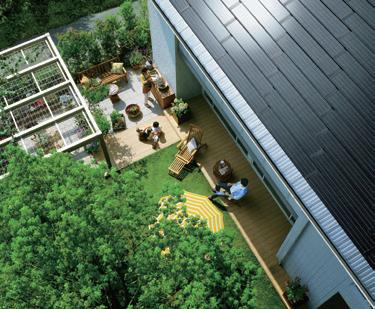
Building homes that reduce waste and conserve resources
We strive to achieve zero emissions through the reuse of waste as raw material by thoroughly separating and sorting it at our Resource Recycling Center, where we recycle 100% of waste generated from new house construction.

Regional revitalization starts at Michi-no-Eki roadside stations
We engage in regional revitalization projects that contribute to stimulating local economies through initiatives such as creating a network of roadside service stations known as “Michino-Eki, ” offering journeys that unveil the hidden allure of local areas.
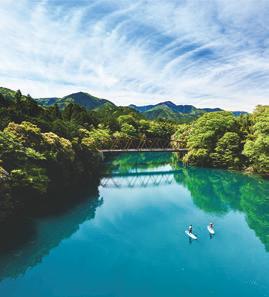
“Journey exploring the hidden charms of the region”
Rural areas in Japan are facing increased depopulation, primarily due to declining birthrates, an aging population, and urban concentration. Yet, whether it be the rich natural environments, friendly communities, leisurely pace or farm-fresh food, the charm of rural areas remains abundant, offering experiences only available through direct visits.
In partnership with Marriott International since 2020, we have launched the Trip Base Michi-no-Eki Stations Project to revitalize these regions. This project aims to unveil the lesserknown charms of various regions by constructing hotels proximate to “Michi-no-Eki”, or roadside service stations, throughout Japan, fostering local economies through enhancing tourism.
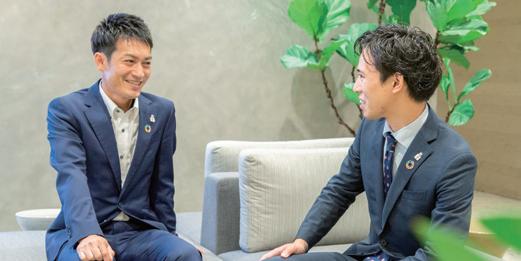
The hotels are specialized for overnight stays, designed to foster interactions with locals and visits to Michi-no-Eki roadside service stations. Guests can enjoy common areas with basic kitchens for cooking fresh produce purchased at the Michi-no-Eki , alongside shops offering regional products and items from nearby Michi-noEkis We also provide experiential tours. Partnering with over 50 partner companies, we are dedicated to exploring new hotel concepts that immerse guests in the area’s culture and ambiance, enabling them to truly connect with the local environment.

“Many of the Michi-no-Eki staff commute from other prefectures. It would be convenient to build company housing for these staff right next to the Michi-no-Eki”. This conversation with locals sparked the beginning of our Trip-Base Michi-no-Eki Project. Constructing hotels in rural areas gives visitors a chance to delve into the local culture, and this initiative would surely contribute to regional revitalization! That was the core idea that spurred on our project.
2,336
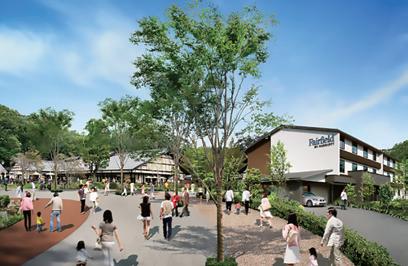


Rural areas are filled with stimulating and delightful attractions. Our goal is for weekend travelers to see trips to these rural areas as an appealing option, just as they would with well-known tourist destinations. Back Story Employee Roundtable
This project is a novel venture, unlike anything we have done before. After constructing the hotels, we were faced with the challenge of attracting visitors to the area and enhancing regional partnerships from scratch. Although it is daunting to navigate uncharted areas, it is also exciting to collaborate on ideas and devise unique strategies tailored to each region.

This project allows us to directly hear words of appreciation, bringing us moments of joy. For example, in Susami Town, Wakayama Prefecture, a small town with approximately 3,700 residents, we received heartfelt feedback stating that the hotel has spurred an increase in visitors, prompting new residents who wish to open shops for tourists, and creating a positive cycle for the town.

The focal point of the journey is “Fairfield by Marriott” of Marriott International. Transforming Michi-no-Eki from mere rest or transit points, we aim to establish them as hubs and primary bases for excursions. By connecting tourism resources and positioning them as travel bases, we plan to highlight the area’s attractiveness and revitalize regional economies.


Constructing hotels
Collaborating with alliance partners (regions, municipalities, partner companies)
Promoting the allure of wandering travel “TRIP BASE STYLE”
Providing hotel amenities and utilizing hotel facilities
Expanding partner restaurants
Planning experiential tours with partners
Collaborating with local events
Expanding regional tourism, sightseeing, mobility and transport options
Revitalizing regional economies
Promoting new industries and services
Creating employment opportunities
Gohon no Ki Project: Proposing to plant native tree species in customer’s gardens
In post-1970s Japan, urban expansion began reducing wildlife habitats. Launched in 2001, the Gohon no Ki Project was driven by our desire to let customers experience the once-familiar sounds of nature even within the city. This project aims to create gardens as sanctuaries for wildlife, with “three trees for birds, two trees for butterflies, and all local native tree species.” Over the past 23 years this initiative has led to the planting of nearly 19.84 million trees. Research has shown that the Gohon no Ki Project has the potential to double the number of bird species drawn to residential areas (from 9 to 18) and quintuple butterfly species (from 1.3 to 6.9).
P.132 Gohon no Ki Project
Assessing the impact of our 20-year initiative and sharing the insights globally
Joint research1 launched in 2019 with the University of the Ryukyus suggested that the hypothetical implementation of the Gohon no Ki Project for 30% of all newly constructed properties in Japan would result in considerable recovery in biodiversity, with the quantitative “integrated diversity index” expected to rise to 84.6% by 2070 compared to 2020.
The creation of this unprecedented quantitative index was made possible by our Group’s 20 years of accumulated data on tree counts, species and locations. Our data was combined with data held by the University of the Ryukyus to develop a quantitative assessment framework, which was then publicized as a Nature Positive Methodology. In 2023, this methodology was implemented at 87 sites across Japan, fostering greening initiatives and contributing to the preservation of biodiversity.
1 Joint research with the Kubota Laboratory at the Faculty of Science, University of the Ryukyus Sekisui House’s Nature Positive Methodology (Japanese only)
The world’s first research analyzing the link between biodiverse gardens and well-being
In 2022, the Sekisui House Group commenced a pioneering joint research2 with the University of Tokyo to examine the relationship between biodiversity and health. This world-first study seeks to assess the broader health and happiness benefits of engaging with nature within biodiverse gardens.
The Sekisui House Group is also fostering urban greening and simultaneously revitalizing the market for native tree species and the landscaping industry by incorporating the Gohon no Ki Project concept into our housing complexes, urban redevelopment initiatives, and office building constructions.

2 Joint research with Department of Ecosystem Studies, Graduate School of Agricultural and Life Sciences, the University of Tokyo


Established the “Urban Development Charter,” fundamental policies, 24 guidelines and 100 design methods and promoted the concept of keinen bika, the creation of a landscape that grows more beautiful over time, and the Gohon no Ki Project
Launched “townscape observation day,” aimed at showcasing townscapes created based on the Gohon no Ki Project

Shin-Satoyama at Shin Umeda City, the headquarters of Sekisui House
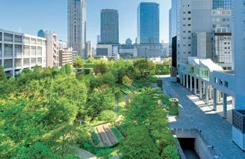


Established the world’s first quantitative assessment framework for urban biodiversity and publicized it as a Nature Positive Methodology
Initiated joint research with the University of Tokyo regarding biodiversity and health
Participated in the TNFD forum
as a TNFD Early Adopter (January)
Gohon no Ki Project

The Gohon no Ki Project is the initiative to plant native tree species well-suited to local climates and environments as part of gardening and urban landscaping. Incorporating native plants fosters miniature natural sanctuaries in residential spaces, attracting a variety of wildlife such as birds and butterflies. Over time, these private gardens integrally enhance the local ecosystem, enriching the broader environmental landscape.

Let me share one memorable story from the Gohon no Ki Project. I met a homeowner who was at first reluctant to plant trees in his garden. However, once the garden was completed, he became the most passionate tree caretaker in his family, enthusiastically handling watering and pruning. Another story involves a customer’s daughter, who, intrigued by the butterflies frequenting their garden, has become the family’s “butterfly expert.” Stories like these, of families engaging joyfully with nature right in their gardens, vividly showcase the happiness that living alongside greenery brings.

Some customers have told us about specific trees they are particularly fond of. This greenery has fostered more insightful and heartfelt interactions with our customers, which believe has set us apart from competitors.

Our principle, “three trees for birds, two for butterflies” ultimately enhances people’s happiness

The Gohon no Ki Project we engage in is primarily dedicated to preserving biodiversity, yet its benefits extend to people’s happiness.
Envision greeting the day with the melody of birds in a garden filled with native trees, absorbing the gentle warmth of sunlight as it dances through the leaves. Embracing nature enhances the quality of our lives, and this connection is at the heart of the Gohon no Ki Project, enriching our day-to-day existence.

We also strive to communicate the concept of keinen bika to our customers. Beyond artificial exterior elements, trees—as living elements of the garden—grow and become more beautiful over time, presenting an ever-evolving canvas of natural splendor. The Gohon no Ki Project is thus instrumental in adding color to residential landscapes.
In addition to implementing this project for detached housing, we are committed to implementing this Project in residential land development and rental housing. Adopting the Gohon no Ki Project enriches townscapes, delights locals and enhances habitats for native species, ultimately serving multiple benefits for the community.
Feedback has been positive not only from owners of our detached houses but also from residential property owners, who have noticed the improved landscapes surrounding their properties. Neighborhood residents initially opposed to the construction have since expressed delight at the sight of the beautifully finished rental properties, noting the enhancement to the townscape. It is indeed gratifying to extend the joy from individual gardens to the entire community, and it is a source of pride to be part of this project.

While implementing the project, we also identified underlying issues facing the landscaping and gardening industries. Specifically, these sectors have been experiencing a gradual reduction in the number of producers and, with fewer business successors emerging due to diminishing public work projects. We hope to energize these industries through the Gohon no Ki Project. Our project delivers happiness to our customers and community while contributing to the environment. If the depth and rewards of this contribution gain wider recognition, it could spark interest among the younger generations to join these industries. It is my hope that this project elevates the value of these industries, enabling every professional involved to take pride in their contributions.

Absolutely, can relate to that perspective. My family runs a landscaping business, and growing up, I helped with tasks like weeding gardens and laying blocks. Although had considered taking over their business, was drawn to the construction field, where I could leverage my landscaping knowledge, leading my decision to join Sekisui House. Today, the landscaping industry is confronted by serious shortages of business successors. However, believe that if we continue integrating living space design and construction technologies through this and other projects, this industry could attract a growing number of prospective jobseekers.
Our hope is to make the Gohon no Ki Project a global standard

The Gohon no Ki Project, started in 2001, has now reached a milestone of planting about 19.84 million trees over 23 years. In 2021, the project’s impact was publicized under an assessment method called Nature Positive Methodology.
This heralds a groundbreaking achievement as the first in the world to succeed in quantifying the effects of biodiversity conservation efforts. Feeling a solid sense of achievement is inevitable when we witness the concrete outcomes of our everyday dedication to preserving biodiversity become reality.

My greater aspiration is to expand the concept of the Gohon no Ki Project globally. I have no idea how many years it will take, but would like to make this concept a global standard. Beyond simply planting more trees, aim to promote the fusion of construction and landscaping technologies as we move forward.

On a personal level, I am eager to invigorate landscaping and other relevant industries. The gardening industry, in particular, struggles to attract new and young workers. Yet, if we can showcase the attractiveness of the industry, am convinced that, with the right appeal, people will be naturally drawn to the industry. am committed to exploring ways to amplify this industry’s allure and, in doing so, revitalize it entirely.


Our mission
We are committed to creating work environments that honor diverse perspectives and values, where each individual can confidently engage in self-development and advancement, while harnessing their traits and skills to excel in their roles.
Key policy
We champion the autonomy of our employees and the continuous initiative of our organization to undertake new endeavors, with the aim of establishing workplaces that are truly a “second home” for our employees, fostering comfort and happiness.
Key themes
Promoting diversity
Employee health and happiness
Diverse workstyles / Job satisfaction / Human resource development / Self-directed career development
Amid labor shortages caused by a declining population and increasingly complex social issues, workstyles and lifestyles not bound by specific values or conventional norms are becoming more widespread. To create new value, it is important to build an organization with diverse talents and foster an inclusive corporate culture where each other’s differences are respected.
Guided by our vision, we strive to build workplaces focused on employee health and happiness, where all employees, who are source of innovation, can seize equal opportunities to thrive.
Fostering diversity and empowering employee autonomy
We are committed to building an organization where employees and the Company can grow collectively. Our approach is founded on three pillars: promoting the participation of women in the workforce, harnessing diverse talent, and advocating for diverse workstyles. Our goal is to foster a psychologically safe workplace culture that respects and acknowledges individual differences and enables autonomous career development.
Generating innovation
By uniting the strengths of talent with diverse perspectives and experiences, we create ideas and solutions, accelerating innovation and creating new value that contributes to society.
Promoting the participation of women
We initiated active recruitment of female sales representatives in 2006 and launched managerial training program in 2014. We are promoting the participation of women across the entire Group with the aim of fostering a work environment where a diverse range of talent can excel.
Diversifying and empowering talent
By advocating for diverse workstyles and creating environments for independent career advancement, we support career development inside and outside of our organization, reinforcing society’s overall human resource capabilities.
Creating employment opportunities
By actively hiring diverse personnel and creating employment opportunities rooted in local communities, we contribute to the regional economic growth, the stabilization of employment across society, and the stimulation of the economy.
Since 2020, we have been conducting the Well-Being Survey to visualize the happiness of employees and workplaces. Based on the survey results, we assess workplace environments and identify issues and are dedicated to nurturing a corporate culture that encapsulates diverse perspectives and values.
Realizing an inclusive society
By enabling everyone to equally seize opportunities and fostering inclusive work environments where they can realize their full potential, we improve inclusiveness and contribute to building a society where everyone can thrive.
For the happiness of our employees and their family members
In 2018, taking paid annual leave was notably challenging in Japanese society. The catalyst for change at Sekisui House came when our President walked by a park in Sweden on a weekday and saw fathers happily strolling with strollers and enjoying cafe outings with their children and friends—sights less common back home in Japan. Inspired, he decided to transform our approach to paternity leave for male employees.
Initially, certain concerns were raised internally about the implications of employees taking leave. In response, we engaged in initiatives to transform our corporate culture and designed a paternity leave in order to remove both the psychological and financial hurdles for employees. Our paternity leave, focused on enhancing the happiness of employees and their family members, was implemented as a strategic business initiative, signaling a shift towards an inclusive and supportive workplace.
P.116 Supporting the Pursuit of Family Happiness
As we introduced our paternity leave program, our immediate focus was on reshaping managers’ attitudes and mindsets towards paternity leave. Acknowledging that managerial resistance could inhibit both the uptake of leave and its acceptance among colleagues, we convened an extensive internal forum with nearly 1,900 attendees, inclusive of those entitled to leave and their supervisors. The forum spurred discussions on the positive impacts of paternity leave on children’s well-being, the imperative to transform unsupportive managerial attitudes, and the need to foster a workplace culture that is both embracing of and resilient to extended leave. These dialogues were key in cultivating an environment where managers become advocates for paternity leave. We demonstrated through various case studies that all roles and levels in our organization are entitled to paternity leave. Establishing this shared recognition fostered a mutually supportive culture, allowing every employee to confidently take any type of leave and facilitate their return to work, thereby nurturing a sense of security within the workplace.

paternity leave³ For employees with children under three years old
• Eligible for a month or more of paternity leave, which can be taken either continuously or in up to four separate periods
• The initial one-month period is granted as paid leave
3 Paternity leave expanded to the entire Sekisui House Group
2019 The Japanese government launched paternity leave for national government employees: one month or more as a general rule
For five consecutive years, all eligible Sekisui House Group male employees have taken at least one month of paternity leave. Our goal is to foster a society where everyone can lead a fulfilling and happy life. We are committed to shaping an inclusive culture where choosing to take leave for personal endeavors and/or interests, such as hobbies, travel, education, or family needs, is fully supported by the entire organization. We view paternity leave as an initial step toward this vision and will continue to promote these values in partnership with other organizations and business partners that support our mission for societal betterment.

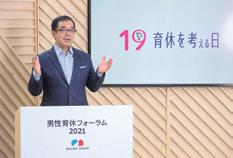

General measures to address declining birthrates Target for male

Since September 2018, Sekisui House has encouraged male employees to take at least one month of paternity leave. Salary is paid for the initial one-month period, and the leave can be divided into up to four separate periods. In April 2021, we enhanced paternity leave in response to requests from employees’ family members, to offer greater flexibility, allowing leave to be taken in one-day increments during the spouse’s eight weeks postpartum. All eligible male employees have taken paternity leave since the official launch of paternity leave in February 2019.

The inspiration for our paternity leave originates in a scene our President observed in Sweden, where he was surprised to see that the majority of parents pushing strollers were fathers. When he asked a local, he was told that it’s quite ordinary for men to take three months of parental leave in Sweden. Deeply impressed by the happiness of the fathers involved in childrearing, our President returned to Japan and promptly introduced a business strategy focused on promoting paternity leave.

Following the feedback received by the Diversity Promotion Department, the Human Resources and General Affairs Department acted diligently to finalize the policies and procedures. To ensure that all employees could use paternity leave confidently and without concern, we created rules allowing splitting the month-long leave into up to four separate periods and secured the President’s commitment to make this first one-month period entirely paid without it influencing any performance evaluations.

The IT Design Department was responsible for the practical application of the system. To enhance usability, the department overhauled the internal attendance system to enable the management of paternity leave plans and workload assessments, which were previously handled using Excel and paper formats.

Collaborating seamlessly across three departments, the IT Design Department independently managed the initiative from initial planning to deployment. The IT Design Department had the idea of sending notifications through the attendance system to employees who hadn’t yet scheduled their leave by their child’s second birthday, preventing lapses in leave-taking.

We did everything we could to “ensure everyone can take leave without hesitation”

The initial outreach was to the Diversity Promotion Department and the Human Resources and General Affairs Department. Tasked with creating a new approach to male paternity leave, the Diversity Promotion Department first set out to define the broad policies and engage with various business units for their insights and input.

Questions arose whether providing three months of childcare leave, similar to Sweden’s model, was feasible. After thorough consultations across various business divisions, we ultimately chose to implement a one-month paternity leave period.

After setting up paternity leave, we focused on removing reasons that might hinder taking leave. For instance, when families expressed concerns that merely taking leave wouldn’t make a difference without an equal division of household and childrearing tasks, we introduced the Family Meeting Sheet to clarify these responsibilities. When managers lacked sufficient understanding of the importance of paternity leave, we required both paternity leave-eligible employees and their managers to attend awareness-raising forums. These steps have incrementally strengthened support for our paternity leave.
Having the president personally endorse the system as part of our business strategy made it easier to transform employee and manager mindsets and create a supportive corporate culture for paternity leave. From the beginning, the conversation never centered on “whether to take paternity leave.” Instead, our business units have dedicated their efforts to finding ways to further facilitate paternity leave accessibility.
Aiming for a society where male paternity leave becomes widely accepted, even in Japan

Sekisui House has pioneered paternity leave initiatives, preceding our industry peers. Driven by the aspiration to create a moment for society to reconsider the concept and implications of paternity leave, we established September 19 as “Consider Parental Leave Day” and have hosted an annual forum since 2019.

Although the number of companies championing paternity leave has increased significantly, many continue to encounter obstacles in raising internal awareness and gaining executive support. To support other companies facing these hurdles, we host annual forums to share insights from our paternity leave initiatives and communicate the advantages and structures we have established. This effort has contributed to a perceptible shift in the corporate approach to paternity leave across Japan over the past five years.
We aim to create a company where everyone can work happily, advancing even more diverse workstyles

While we maintain a 100% uptake rate for paternity leave, we do not see this as the final goal. Moving forward, we will strive to create an even more accommodating workplace that supports not just childrearing but also the needs of employees from a variety of backgrounds.

We introduced new leave in 2023. For instance, we now offer self-directed career development leave to support employees pursuing studies abroad or acquiring qualifications. Additionally, we provide child support leave for situations such as a sick child or school absences, as well as an advanced learning support leave for employees who wish to pursue university degrees while working.

These newly implemented leaves were thought up and created by employees. We have a corporate culture in our Group where everyone can speak up and we have fostered a work environment that’s united in vision and supportive of shared objectives. Taking male paternity leave as a starting point, we aim to continue evolving into a company that embraces and accepts a diverse workstyles.
The Sekisui House Group has identified key themes related to three materiality issues: “Creation of High-Quality Housing Stock,” “Contributing to a Sustainable Society” and “Diversity and Inclusion.” We have also defined Key Performance Indicators (KPIs) to assess progress in specific initiatives to be undertaken over the course of the three-year Mid-Term Management Plan to address each key theme.
In the Sixth Mid-Term Management Plan (FY2023–2025), we identified 54 KPIs linked to our three material issues and continue to monitor and evaluate progress under the Group’s ESG Management promotion structure.
P.58–60 Indicators and Progress
P.235 Indicators and Progress
The ESG Promotion Committee, an advisory body to the Board of Directors, deliberates on progress in and issues associated with ESG management initiatives before reporting to the Board of Directors. Upon receiving reports from the ESG Promotion Committee, the Board of Directors deliberates on and supervises the Group’s initiatives among other relevant matters.
Progress of non-financial KPIs during the three-year period of the Sixth Mid-Term Management Plan (FY2023–2025) is reported periodically to the ESG Promotion Committee. The identified challenges and prospective policies undergo rigorous discussions in internal meetings involving external members with expert knowledge, alongside our Representative Director and executive team. Informed by this feedback, we consistently review and update our strategies and performance indicators.
P.92 ESG Management
Incorporating KPIs Linked to Material Issues into Performance Evaluation
Some KPIs linked to material issues are designated as ESG indicators for assessing the performance of business units and are reflected in the determination of the President’s Award to foster employee-driven initiatives to pursue ESG initiatives. Some examples of key themes incorporated in the FY2023 President’s Award are as follows.
Material issues Key themes
Creation of High-Quality Housing Stock Asset value creation
Contributing to a Sustainable Society Decarbonization/Biodiversity conservation
Diversity and Inclusion Employee health and happiness
Selected KPIs are also integrated as ESG management indicators within the framework for evaluating executive remuneration. After discussing the priorities and strategic approaches for target attainment, we have determined the evaluative criteria. The key indicators, inclusive of ESG management measures pertinent to the Performance Share Units (PSU) granted to executives, are outlined below.
Material issues Indicators
Creation of High-Quality Housing Stock
Contributing to a Sustainable Society
Diversity and Inclusion
Percentage of detached houses certified as Long-Life Quality Housing
Rental housing units renovated
Ratio of detached house ZEH
Number and ratio of ZEH units for rent
Number and ratio of ZEH condominiums for sale
Rate of CO2 emissions reduction from business operations
Number of women in managerial roles
Rate of paternity leave taken by eligible male employees
Rate of annual paid leave taken
The Sekisui House Group engages in the “Well-Being Circle,” a well-being survey as one of our KPIs. This measure aims to diagnose the well-being of employees and workplaces comprehensively, allowing the visualization of happiness levels. Initiated in FY2020, this metric informs targeted strategies focused on fostering each employee’s individual pursuit of happiness.
P.118 Continuing the Well-Being Survey
In the fourth iteration of the well-being surveys in FY2023, we discovered high happiness scores among female managers. Additionally, workplaces led by female managers reported generally higher happiness scores compared to those without female managers. Promoting women’s active participation is considered a key theme in our endeavor to create an environment where diverse talents can excel. We are actively advancing initiatives to achieve this goal. Moving forward, we will continue to cultivate a workplace where our people, rich in varied experiences, expertise, perspectives and ideas, can genuinely express their abilities across different business units. In doing so, we aim to support employees’ continuous personal development and growth while perpetually strengthening the organization’s capability for enduring sustainable growth.

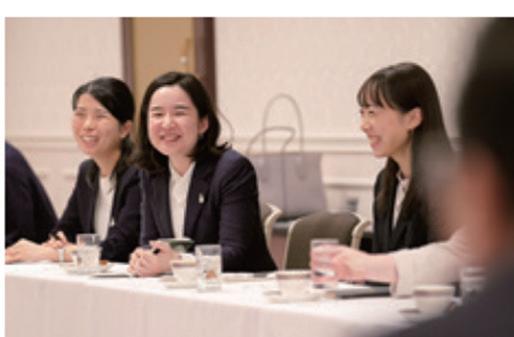
1
This
1
4


This indicator is calculated based on our residence evaluation, which we created for detached houses in 2017 to promote the creation of beautiful houses that will be assets to their communities. Houses meriting this certification are given a rating from one to five stars.




The Sekisui House Group identifies various issues and expectations through engagement with stakeholders, including customers (homeowners), residents, consumers (prospective customers), suppliers, business partners, employees, shareholders and investors, and local communities. We work to create value unique to Sekisui House by diligently addressing these issues and expectations.
Key Stakeholders Responsibilities
Constantly remaining closely attuned to our customers, we work to provide value from their point of view to ensure greater satisfaction.
• Customer surveys
• Informative magazines published as communication tools
– Kizuna (detached housing, twice annually)
Examples of Engagement Results of Initiatives
• Customer Service Center Owner Desk
• House Celebration
Customers (homeowners)
Residents
Consumers (prospective customers)
We provide services aimed at securing residents’ satisfaction by maintaining a call center capable of responding to emergency requests at all times as well as a dedicated app designed to offer member-exclusive services, assist with various applications and otherwise support rental living.
We will proactively disclose information to establish relationships of trust, with the goal of creating enriching homes and environments.
– Maisowner (rental housing, twice annually)
– gm (condominiums, three times annually)
• Sha Maison Life CLUB (Japanese only)
– Electronic application and contract services
– One-stop services using blockchain technology
– Subscription services and various discount coupons
– Helpdesk services that accommodate repair requests and troubleshooting
• Corporate brand communications
• Product brand communications
• Home Visit Days (tours of completed homes)
We will engage in fair and equitable transactions while fostering relationships of mutual benefit in order to develop together with our business partners by satisfying customers.
• Sekisui House Association and the Sekisui House Cooperation Association Sekisui House Primary Work Constructor Association
• Annual activity policy briefing session
• CSR procurement (adhering to our CSR Procurement Guidelines)
• Sha Maison Life POINT
– Point services for residents
• Sha Maison Life GUARD
– Fire insurance for residents
• Tomorrow’s Life Museum (Japanese only)
• Sekisui House Eco First Park
Suppliers/ Business partners
Employees
Shareholders and investors
We respect individuality so that employees can make the most of their individual capabilities. We help employees develop a spirit of embracing challenges through working at the Sekisui House Group; promote diverse workstyles and create a foundation for happiness so that employees can develop their careers autonomously; and empower all employees to pursue happiness in their own terms.
We are committed to improving corporate value through sound growth that provides returning profits to our shareholders and investors, with the goal of being an enterprise of high social value that maintains fair and transparent management practices.
• Supplier assessments
• ESG Conference
• Sekisui House Women’s College
• e-learning focused on accommodating customers with disabilities
• Sekisui House Innovation & Performance (SHIP) Awards Program (an awards program that encourages taking on challenges and autonomy)
• Career interviews
• Sekisui House Group National Baseball Tournament
• Hito in-house online magazine
• Financial results briefings and management plan briefing sessions
• Meetings with institutional investors and analysts
• General Meeting of Shareholders
• Publication of Value Report (Integrated Report; includes TCFD and TNFD reporting)
•Sekisui House Circular Economy Vision Briefings
• Fair Wood procurement based on our Wood Procurement Guidelines
• Briefings on updates to Wood Procurement Guidelines
• Sekisui House Carpentry Competition, WAZA 2023
• SBT study sessions
• Flex system and remote work system
• ESG Dialogue
• Human relations training (annually) Compliance training
• Happiness Health Management: Challenge 6 initiative (six challenges for physical and mental health)/total working hour management
• Well-Being Survey
• Publication of Business Report (twice annually)
• Issuance of IR News Mail
• Facility tours for individual shareholders
• Corporate briefings for individual investors
Local communities
In order to protect the global environment and enable all people to enjoy a rich and fulfilling life, we will strive to cooperate with, participate in and give back to society by fostering local culture and prosperity while making the most of our uniqueness as a housing company.
• Sekisui House Matching Program for joint donations by employees and the Company (Japanese only)
• Collaboration with NPOs such as Kids Design Association
• Career education and on-demand classes for elementary, junior high and high school students
• Facility tours and hands-on learning programs
• Comprehensive partnership agreements with local governments
• “A Letter from Dr. Forest” and happy homes educational programs for elementary and junior high school students
• Longer useful lives for housing
• Improved customer satisfaction
• Enhanced after-sale support
• Creation of high-quality housing stock
• Enhanced relationships with homeowners
• Provision of one-stop, paperless services
• Enhanced lineup of after-sales services
• Provision of services aimed at improving customer satisfaction and turning residents into Sekisui House fans
• Enhanced development of new products and technologies
• Accumulation of big data relating to housing
• Facilitation of a positive perception of Sekisui House
• Establishment of construction site environments that facilitate work (streamlining and standardization of work, strengthening of our construction work structure)
• Establishment of a robust sustainable supply chain
• Active participation of women and diverse human resources
• Helping employees pursue self-directed career development and personal growth
• Generating innovation
• Invigorated communication among employees
• Enhancement of information disclosure
• Promotion of diverse workstyles
• Creation of a workplace culture that ensures a robust sense of psychological safety
• Helping employees stay healthy and raise their health awareness
• Maintenance and improvement of employee well-being
• Building relationships of trust with shareholders and investors through active dialogue
• Living that offers safety and peace of mind
• Community development for crime prevention and disaster preparedness
• Fostering of future generations
• Support for the independence of disaster victims and people with disabilities
• Support for a diverse society
• Regional revitalization
• Coexistence with local communities
• Social contribution activities (including initial disaster response and recovery and reconstruction support)
The Sekisui House Group emphasizes the importance of stakeholder engagement and conducts various engagement initiatives each year. Some examples of stakeholder engagement undertaken in FY2023 follow.
House Celebration, aiming to help owners celebrate the completion of their new homes
Sekisui House began providing House Celebrations in FY2023, a nationwide initiative with sales staff helping owners celebrate the completion of their new homes.
House Celebration plans include “Party Celebrations,” where we dispatch kitchen chefs or deliver catering services; “Tea Celebrations,” which are more casual, such as tea and cake parties; and “Gift Celebrations,” in which owners present gifts to show their gratitude to invitees. These celebrations are also considered to be opportunities for Sekisui House to express our thanks to owners who have commissioned us to build their homes, and congratulate them on their new start. Moreover, these services enable Sekisui House to enhance customer satisfaction while winning new prospective customers, as these celebrations are often attended by friends and acquaintances that homeowners have invited.
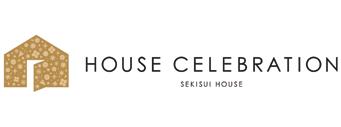

We feature new content titled “Sekisui House Stories” on our corporate website, where we share stories of happy homeowners who live in housing built by Sekisui House as well as the passionate endeavors of staff in charge of product development, set against the relevant social context. The content also showcases unique home designs and features created based on homeowners’ suggestions. We expect this content to serve as useful references for both our sales staff, who are in charge of delivering proposals, and prospective customers considering housebuilding.
Details on Sekisui House Stories (Japanese only)
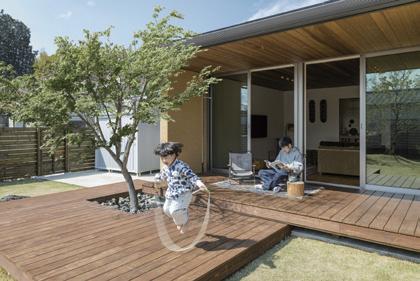
In FY2023, the Sekisui House Group held an in-house baseball tournament to facilitate communications among all employees and foster a stronger sense of unity. Approximately 3,500 employees registered as players and took part in games, including elimination rounds held at various locations across Japan.
On the day of the tournament, a total of four remaining teams, which included members from Group companies, gathered at Kyocera Dome Osaka to compete in the semi-finals and grand finals. These games were preceded by a player representative taking the athlete’s oath, the ceremonial first pitch and the singing of the Company anthem by a solo performer. In addition, recreational activities were also held between intervals, allowing employees and their families to play freely on the field to ensure that even those unfamiliar with baseball could have fun. As a result, the event was a roaring success.
This event was organized mostly by employees who volunteered in response to in-house postings to serve as, for example, stadium announcers or ball boys. This improved engagement among employees from different departments while facilitating a spontaneous corporate culture supportive of ongoing innovation.
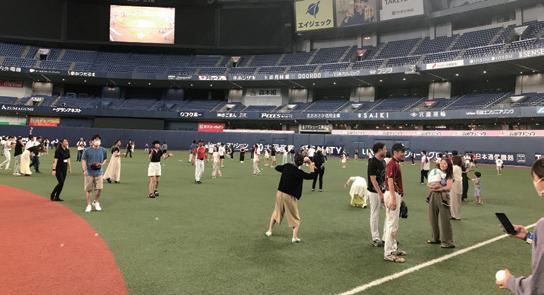



Based on our belief that employee happiness is a foundation of business management, the Sekisui House Group has facilitated periodic dialogue between supervisors and their staff members since FY2022 to enhance the quantity and quality of communication between them while enabling individual employees to pursue personal growth and career advancement. These dialogues help employees clarify areas in which they hope to take on new challenges as well as their future career visions as they receive support from their supervisors.
Small-scale meetings between outside directors and institutional shareholders
Sekisui House hosts periodic dialogues involving outside directors and institutional shareholders. In February 2023, these took place as small meetings, with attendees engaging in vigorous discussions to assess the effectiveness of Sekisui House’s Board of Directors, deliberate the role of outside directors and consolidate awareness of issues confronting the Company. Opinions from dialogues are relayed to internal directors to inform future management decisions. In addition, accurate understanding of the status of the Company’s day-to-day operations is essential for outside directors to conduct meaningful dialogue. Therefore, outside directors engage in periodic communications with internal directors and executive officers while proactively participating in on-site tours. In FY2023, outside directors joined tours of development sites in the Fukuoka area and flew to Australia, where they took a close look at the apartment & mixed-use developments business as well as the homebuilding business, and exchanged opinions with local managers.
We will continue to conduct ongoing communications between outside directors and institutional shareholders to secure a shared awareness of issues and problems confronting the Company in order to improve corporate value.



In FY2023, we organized a tour of Tomorrow’s Life Museum Kanto as part of our initiatives to help individual shareholders gain a deeper understanding of Sekisui House’s operations through facility tours. Since we had not held face-to-face events of this kind for four years, there was a large number of applicants. Attendees toured model housing facilities, including realistic living scenarios and our new “life knit design” concept, which aims to appeal to the perceptions of each customer. In addition, they also visited the Structure Pavilion and the Resource Recycling Center to take a close look at the Company’s sophisticated structural technologies and progressive environmental initiatives. The tour was followed by presentations on the Company’s business and dialogues with shareholder attendants. On questionnaires distributed to attendees, we received a number of responses noting the event enabled them to deepen their understanding and stimulated their interest in the Company’s operations, indicating an immense feeling of satisfaction among participants. Going forward, we will maintain high-quality engagement with individual shareholders through facility tours and other events.
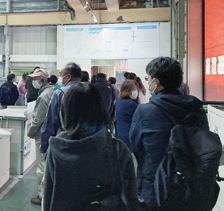


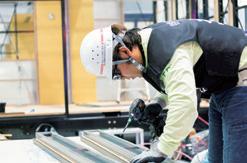

In November 2023, the Sekisui House Group held the first round of Sekisui House Carpentry Competition WAZA 2023. The participating carpenters lead Japan in the level of their technique and this event was intended to express our sense of gratitude to them and to thank them for their unwavering dedication to our endeavor of building attractive homes. The event was also designed to help them maintain their immense motivation to work, as well as to promote the attractiveness of carpentry as a dream job to people outside the Group. From among approximately 5,000 entries from regions across the country, 26 carpenters were chosen for the finals to determine the champion. Pitting their sophisticated techniques against each other, they competed at the venue for around two and a half hours to complete a room with an area of 7.5 jo (roughly 12.15 m², with 3.5-meter sides) as part of a two-story housing structure made of steel frames used by Sekisui House. Each contestant was rated based on a total of 77 evaluation items, ranging from those related to preconstruction preparatory steps, compliance with construction procedures, accuracy, completeness, safety, and the tidiness and beautification of their worksites. These evaluation items were selected from actual quality inspection standards and determined in accordance with Sekisui House’s construction work quality manuals, with contestants judged by staff who usually conduct quality inspections at construction sites nationwide. Families and colleagues of contestants were also invited to observe the competition, closely watching each contestant demonstrate their honed art of carpentry with a sense of excitement, a rare occasion that cannot be experienced at actual construction sites. The event was a roaring success. Attendees physically present at the value cheered energetically for contestants and a livestream of the event allowed audiences to watch remotely from branch and partner building constructors’ offices nationwide.
Sekisui House is striving to step up collaboration and coordination with suppliers to address social issues, especially those related to the environment, with the aim of making our supply chain more sustainable. For example, we held our ESG Conference, a study session focused on assisting suppliers in establishing SBT-verified targets and helping them learn more about sustainability. In connection with this, we have set a target for the ratio of suppliers with SBT-verified targets as part of our goals to reduce the volume of greenhouse gas (GHG) emissions in the supply chain. To share our vision for the realization of a circular economy with suppliers, we hosted a seminar on the implementation of the Sekisui House Circular Economy Vision as well as a seminar on our updated Wood Procurement Guidelines, which include our unique commitment to protecting biodiversity during wood procurement.




Yosuke Horiuchi
Representative Director of the Board
Vice Chairman, Executive Officer
In Charge of Division of Finance and ESG
Striving for rapid growth in our business in the United States building on the superiority of our domestic business model and solid financial base
The financial and capital strategy’s fundamental policy for our Sixth Mid-Term Management Plan (FY2023 –FY2025) aims for sustainable improvement to ROE by strengthening our ability to create cash returns through the enhancement of capital efficiency and the advancement of growth investments, the reduction of the cost of shareholders’ equity through the further promotion of ESG management, and the reinforcement of corporate value through the reciprocal effects of enhancing ROE and promoting ESG management. In FY2023, the first fiscal year of this management plan, we achieved record-high results by exceeding net sales and profit projections while making strong investments in growth both domestically and overseas.
In terms of capital efficiency, our target was the stable creation of ROE of at least 11%, and we achieved ROE of 11.9% in FY2023, and as for shareholder returns, we increased dividends for the twelfth consecutive year and repurchased ¥40 billion in Company stock. I believe we started this management plan off well as we were able to contribute to increasing value for shareholders while improving business results.
In terms of growth investment, domestic and international real estate investments have progressed smoothly, achieving approximately 37% of the total investment budget allocated in the three-year Sixth Mid-Term Management Plan. We are also actively working on M&A. Domestically, we have made Gifu Landscape Architect Co., Ltd. an equity-method affiliate while Aida Co., Ltd. has become a wholly owned subsidiary, and we are making efforts to strengthen our built-to-order business in terms of both exterior and interior work. Additionally, in the U.S., we have newly welcomed Hubble Group, LLC. into the Sekisui House Group through our Group builder Woodside Homes Company, LLC.
We determined to make the publicly listed U.S. home builder M.D.C. Holdings, Inc. (MDC), a wholly owned Sekisui House subsidiary in January 2024. We completed the acquisition on April 19 for approximately $5 billion (roughly ¥750 billion¹), making MDC the largest M&A of the Sekisui House Group to date. (MDC was delisted in April 2024.)
In these ways, we steadfastly promoted the fundamental policy of the Sixth Mid-Term Management Plan of “Stable Growth in Japan and Proactive Growth Overseas” in FY2023. I believe that this has been a year of steady business performance and that you can expect even further growth of the Sekisui House Group moving forward.
We aim for sustainable improvement in ROE by strengthening our ability to create cash returns through the enhancement of capital efficiency and the promotion of growth investments.
We work to reduce capital costs through the further promotion of ESG management.
We enhance corporate value through the reciprocal effects of enhancing ROE and promoting ESG management.
We achieved higher than projected net sales and order in our U.S. homebuilding business in FY2023, showing strong recovery. Although home mortgage rates remained high, the need for new housing is firmly rooted amidst a backdrop of
an increasing population and housing shortage. Accordingly, we expect even more future growth as orders by our Group builders in 2024 continued at a good pace. The Company has developed sophisticated technology in seismic resistance, fireproofing and thermal insulation, cultivated through the offering of pre-engineered housing in Japan. Our success in the American market is enabled by this technology, as well as by effectively responding to the needs of customers through our accumulated expertise gained from our customer first initiative made possible due to our order-made housing business.
Thus, to further accelerate our “proactive growth overseas,” we acquired MDC through M&A. Through its polished and solidified platform gained from being a publicly listed company, MDC was able to fulfill its duties to stakeholders for over 50 years while maintaining continuous growth. We believe that the addition of MDC to the builders already present in the Sekisui House Group will solidify our U.S. homebuilding business. In line with this, we are advancing various initiatives, starting with the transfer of Sekisui House technologies, which we strongly believe will lead to substantial business growth. Moving forward, we will work to ensure proper post-merger-integration (PMI) is implemented Company-wide.
From the perspective of our financial and capital strategy, there were two major reasons we were able to successfully take on the M&A challenge of MDC. Those being: our strong financial base, enabling swift and flexible investment decisions regarding investment growth opportunities, and our continuous maintenance of investment capacity. A significant contributor to building this strong financial base has been the generation of stable and ample cash flow from our domestic built-toorder business and supplied housing business. These businesses are built on the core competencies of technical capabilities and construction capabilities, as well as our customer base, all of which have been cultivated for over 60 years.
Part of our built-to-order business, the contracting of detached houses and rental housing business, mainly engages in contract work building houses on land already owned by customers. On the other hand, the supplied housing business does remodeling and rental housing management for customers who are satisfied with the high-quality housing we have built for them and want additional work done. We anticipate stable business growth through the steady increase of houses related to the above businesses. Moreover, these are asset-light businesses that do not require major capital investments. Cash flow generated from these two businesses working together will become a source of funds for growth investments in our development business and overseas business, supporting M&A like our recent large acquisition of MDC.
Our Sixth Mid-Term Management Plan sets the goal of maintaining ROE steadily at 11% or higher, and 12% by the end of FY2025. However, we expect to generate even more profit through the consolidation of MDC with the additional profit gained from its business, as well as the synergies created with the already existing Group builders. Thus, we are eyeing the possibility of even higher ROE. Additionally, when securing funds for acquisitions, we utilize hybrid bonds, which are recognized partially as capital in credit rating assessments, aiming to balance financial soundness and ROE level. By appropriately managing financial leverage while enhancing the asset and capital efficiency of every business, and simultaneously conducting growth investment, we believe there is still ample room for ROE to grow.
The Company engages in continuous monitoring of the cost of shareholders’ equity to conduct management with a focus on capital efficiency. As of April 2024, the cost of shareholders’ equity as calculated by the Capital Asset Pricing Model (CAPM) was approximately 7%. At the same time, we recognize that the market’s expected return is approximately 7% or higher. Therefore, we aim to achieve an ROE that exceeds the market’s expected return. Thus, in order to improve ROE, decisions on all investment plans are made while keeping the Internal Rate of Return (IRR) in mind. Regarding our ongoing initiative to reduce cross-shareholdings, under the Sixth Mid-Term Management Plan, we aim to reduce these holdings to 3% or less of consolidated net assets. In FY2023, we completely sold our shareholdings in two stocks, as well as a portion in five stocks. As a result, the ratio of these holdings decreased to 4.3% (4.6% in FY2022), indicating steady progress on this goal.
conduct appropriate financial management that takes into account our credit rating as well as continues lucrative fundraising for future investments and prepares for potential risks. To support our credit rating, we secured bridge financing, both in Japanese yen and United States dollars, for the recent M.D.C. Holdings, Inc. acquisition totaling approximately ¥418.2 billion and $1.55 billion (approximately ¥240 billion). To avoid decreases in capital efficiency due to stock dilution while contributing to financial soundness, part of the funds was used for debt repayment. In July, we issued ¥200 billion of publicly offered subordinated bonds, with 50% being recognized as capital by credit rating agencies. Moving forward, we will continue to convert funds acquired through bridge financing into stable long-term funding. In the medium-term, as mentioned previously, through ensuring ample cash flow from our domestic businesses (including our built-to-order and supplied housing businesses), as well as from our overseas business (strengthened from our acquisition of M.D.C. Holdings, Inc.), we believe we can make steady improvements to our financial soundness.
The acquisition of M.D.C Holdings Inc. is expected to bring significant growth as well as have substantial impact on our balance sheet, marking a major turning point in our financial and capital strategy. Our strong financial base developed over the years, coupled with stable and diverse funding, will support us through the significant M&A endeavor of M.D.C. Holdings, Inc.
credit ratings (as of June 2024)
Although the Sixth Mid-Term Management Plan initially set a three-year total M&A investment limit of ¥200 billion, with the acquisition cost of M.D.C. Holdings, Inc. at approximately $5 billion (roughly ¥750 billion), we have greatly exceeded this limit. Serving as an indicator of financial soundness, our credit ratings domestically are AA from the Japan Credit Rating Agency, Ltd. (JCR) and AA- from Rating and Investment Information, Inc. Our international credit rating from S&P Global Ratings, Inc. is BBB+. The financial soundness of the Company is under temporary stress from the increase of interestbearing debt taken on to fund acquisitions. Although there are no major obstacles to our business operations, we aim to
To realize the Sekisui House Group’s global vision to make home the happiest place in the world, we are striving to continuously improve corporate value through the reciprocal effects of strengthening ROE management and promoting ESG management. In the Sixth Mid-Term Management Plan, we are striving to maximize the value of human capital, sparing no expense in supporting and investing in endeavors that connect this goal to that of improving social and corporate value. We are particularly putting effort into the area of employee self-directed career development, with the goal of creating an
and Capital Strategy
innovative corporate culture. For example, aiming for practical application in the summer of 2025, we have begun pilot tests on a hydrogen-powered home, the first (according to Company research) house manufactured that produces, stores and uses hydrogen to achieve zero net carbon emissions. This idea was born out of the Sekisui House Innovation & Performance Awards Program, a program that has been attended by all employees since 2022. Additionally, our Sha Maison rental housing, unit-specific ZEH housing that has received positive feedback from stakeholders and was enacted ahead of other companies in the industry, was spontaneously conceived and proposed by onsite sales and design staff. Our ZEH rental housing has grown into a product with many advantages, one of these being that its adoption for corporate housing provides companies with evidence of their own engagement in environmentally-friendly initiatives. The increasing orders for our ZEH rental housing, which recently rose to 76% of our total rental housing, have been a contributing factor to our strong business performance. These examples highlight the importance of aligning employee efforts to resolve the environmental problem of achieving decarbonization. Therefore, we believe worksites are the genesis of innovation and thus it is crucial to attentively listen to the opinions and proposals of employees who work onsite.
In line with these developments, we established Sekisui House Innovation and Communication, Ltd. in February 2024. This company is responsible for the development of human resources who drive innovation as well as the creation of businesses that generate innovation. Specifically, for the development of human resources, we are advancing the development of global personnel, management personnel and innovative personnel. For the creation of businesses that generate innovation, we are planning to open the Company’s first innovation facility, InnoCom Square (scheduled to open in Fall 2024) within the office building Akasaka Green Cross, which we also contributed to developing. Through this facility, we are striving to enhance exchanges between start-ups and various different types of businesses, with the goal of sparking new innovation to address social issues and generate new businesses that arise from the changing business climate. Moreover, to accelerate the Sekisui House Group’s open innovation initiatives, promoted mainly through Sekisui House Innovation and Communication, Ltd., the Sekisui House Investment Limited Liability Partnership, a Corporate Venture Capital (CVC) fund, was established in April 2024, with the Company being the main investor. Through this CVC fund, with an investment quota of ¥5 billion, we will contribute to resolving social issues related to housing and living. Thus, we will continue investing in companies that can create business synergies with Sekisui House.
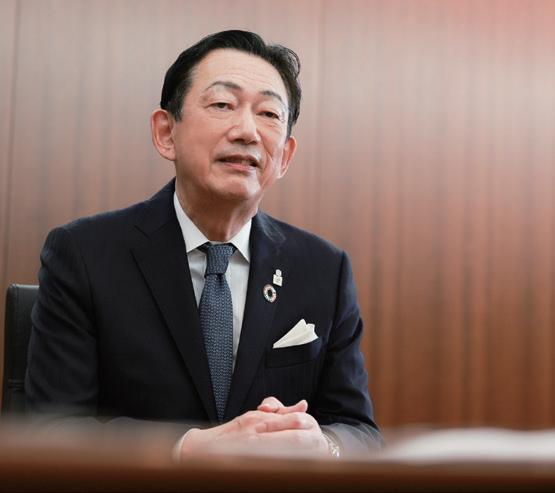
The Company, under the motto “innovation and communication,” will continue to make efforts in resolving social issues through its business activities.
In FY2023, we paid annual dividends per share of ¥123, up ¥13 year on year. For FY2024, in line with increased profits due to the acquisition of MDC, we plan to pay dividends per share of ¥129 (up ¥6 year on year), for a 13th consecutive year of dividend increases.
Maximizing shareholder value is a top priority for Sekisui House. Under the Sixth Mid-Term Management Plan, in addition to our existing policy of targeting a medium-term average dividend payout ratio of 40% or more, to further stabilize shareholder returns, we have set ¥110 as the minimum for annual dividends per share. We plan to flexibly implement repurchases of Company stock, taking into consideration dividends and growth investments for each period. Furthermore, we plan to postpone the repurchase of Company stock for FY2024 as a result of the acquisition of MDC.
Enhanced engagement with shareholders and investors is key for the Sekisui House Group to grow sustainably and increase its corporate value. We will continue to proactively conduct investor and shareholder relations activities and appropriately reflect your suggestions and opinions in our management.
Changes in Earnings Per Share (EPS), Dividends Per Share and Dividend Payout Ratio
Note: EPS for FY2024 and FY2025 is calculated based on the forecast average number of issued and outstanding shares in FY2023.
1 Based on the revised plan announced in June 2024 (to reflect the impact of the April 2024 consolidation of MDC).
2 Based on the initial plan disclosed when establishing the Sixth Mid-Term Management Plan in March 2023 (currently under review to reflect the impact of the April 2024 consolidation of MDC).
The Sekisui House Group Scope of Consolidation
The Sekisui House Group comprises Sekisui House, Ltd., 342 consolidated subsidiaries and 37 companies accounted for using equity method. The FY2023 consolidated financial statements reflect the operating results and financial position of these companies.
Due to our well-balanced portfolio, consolidated net sales in FY2023 increased ¥178.4 billion year on year, or 6.1%, reaching ¥3,107.2 billion, surpassing the ¥3,000 billion mark. Consolidated operating profit increased ¥9.4 billion, or 3.6%, to a record high ¥270.9 billion.
Consolidated ordinary profit increased ¥10.9 billion year on year, or 4.3%, to ¥268.2 billion, mainly due to the share of profits of entities accounted for using the equity method and foreign exchange gains, despite increasing interest expenses.
Profit attributable to owners of the parent increased ¥17.8 billion year on year, or 9.6%, to ¥202.3 billion, reaching a record high along with consolidated ordinary profit. Notably, overseas net sales decreased by ¥10.0 billion year on year, or 1.9%, to ¥511.0 billion, and overseas operating profit decreased ¥24.9 billion year on year, or 33.8%, to ¥48.8 billion.
In the built-to-order business, net sales totaled ¥1,269.8 billion, up ¥19.7 billion, or 1.6% year on year, and operating profit increased ¥4.2 billion year on year, or 3.3%, to ¥131.9 billion. By segment, the detached houses business saw decreases in both sales and profit, but managed to maintain net sales and operating profit year on year. The rental housing and commercial buildings business and the architectural/civil engineering business saw increases in both sales and profit, helping the built-to-order business achieve robust growth.
Supplied housing business net sales totaled ¥821.5 billion, up ¥37.3 billion, or 4.8% year on year, and operating profit was ¥73.6 billion, up ¥3.6 billion, or 5.2% year on year. By segment, the rental housing management business and the remodeling business both saw increases in sales and profit, continuing the stable growth of the supplied housing business.
Development business sales totaled ¥530.9 billion, up ¥126.6 billion, or 31.3% year on year, and operating profit was ¥64.8 billion, up ¥28.3 billion, or 78.0% year on year. By segment, the real estate and brokerage business, condominiums business and urban redevelopment business all saw increases in both sales and profits, growing the development business.
The profit composition of the Sekisui House Group’s business portfolio for FY2023 is as follows: approximately 40% of operating profit is attributable to the built-to-order business, while the remaining 60% is distributed relatively equally among the supplied housing business, development business and overseas business.
This balanced profit composition is the result of the Sekisui House Group’s continuous efforts to strengthen profitability, with each business model growing its operations by expanding in regions of business centered around housing.
Overseas business net sales totaled ¥511.0 billion, down ¥10.0 billion, or 1.9% year on year, and operating profit was ¥48.8 billion, down ¥24.9 billion, or 33.8% year on year. By country, sales increased while profits decreased in the United States whereas sales decreased but profits increased in Australia, and steady progress was made toward ending our business in China.
Total assets as of January 31, 2024 increased 11.5% from a year earlier to ¥3,352.7 billion. Current assets increased 19.2% to ¥2,496.9 billion, primarily due to an increase in real estate for sale. Non-current assets decreased 6.3% to ¥855.8 billion due in part to the selling of development properties.
Total liabilities increased 16.3% from a year earlier to ¥1,558.7 billion, mainly due to an increase in interest-bearing debt. Net assets increased 7.6% from a year earlier to ¥1,794.0 billion, mainly due to the recording of profit attributable to owners of parent.
Cash flows from operating activities increased by ¥15.6 billion (a year-on decrease of ¥109.7 billion in net cash provided), primarily due to posting of profit before income taxes.
Cash flows used in investing activities decreased by ¥69.1 billion (a year-on-year increase of ¥96.2 billion in net cash provided), mainly reflecting the purchase of property.
Cash flows used in financing activities increased ¥6.4 billion (a year-on-year increase of ¥162.2 billion in net cash provided), due to increase of short-term borrowings and other.
Comparing the consolidated balance sheet at the FY2019 and FY2023 year-ends, total assets increased ¥718.0 billion to ¥3,352.7 billion at the end of FY2023. Within this, the increase of ¥680.9 billion to ¥2,496.9 billion in current assets is especially striking, while non-current assets rose ¥37.1 billion to ¥855.8 billion. Looking at liabilities and net assets, current liabilities rose ¥316.1 billion to ¥1,138.0 billion, non-current liabilities decreased ¥85.3 billion to ¥420.7 billion, and net assets increased ¥487.2 billion to ¥1,794.0 billion, marking a reduction in long-term liabilities alongside a major increase in net assets.
Within current assets, real estate for sale accounts for a large portion of the total, having increased ¥884.9 billion from FY2019 to ¥1,863.9 billion at the FY2023 year-end. This significant growth was due to proactive real estate procurement amid the favorable performance of real estate businesses in Japan and overseas as well as the M&A of builders in the United States. In contrast, interest-bearing debt increased by ¥188.0 billion over the same four years, reflecting our proactive investing based on financial discipline. Within net assets, shareholders’ equity increased ¥319.7 billion to ¥1,554.2 billion at the FY2023 year-end following efforts to expand equity.
The Group mainly requires funds for working capital as well as for investments such as the acquisition and development of real estate (including inventories). Working capital comes from internal funds, borrowings or short-term bonds (commercial paper), while funds for investment are mainly raised through bonds and loans. By selecting the most suitable funding method from these diverse options, we secure stable financial resources and reduce financing costs. We are conducting appropriate financial management that takes our credit ratings into consideration by maintaining a suitable level of financial soundness despite the temporary stress of the recent acquisition of M.D.C. Holdings, Inc. We have also entered into commitment line and overdraft contracts with multiple financial institutions, thereby ensuring ample liquidity.
In order to promote business efficiency, we aim to strengthen our balance sheet and raise asset efficiency in each of our businesses. Through such efforts, we seek to improve the ratio of profit to equity capital (ROE) and the ratio of profit to total assets (ROA), aiming to stably create ROE of 11% or more and ROA of 10% or more. In FY2023, ROE was 11.9% and ROA was 8.7%.
Other performance indicators, etc.


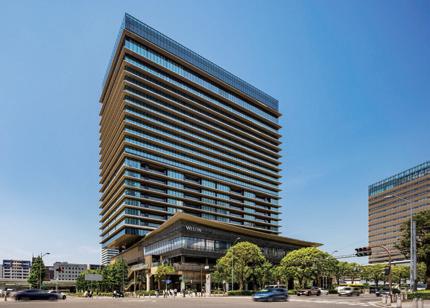

Utilizing its unique value chain and core competencies, the Sekisui House Group has established business models based on the residential domain that continuously create value for diverse stakeholders.
Of the three business models our operations utilize in Japan, the built-to-order business and the supplied housing business are asset-light business models that do not require major capital investments. The built-to-order business, which mainly encompasses homes built by the Company and commercial buildings, is closely linked to the supplied housing business model, which conducts management and remodeling. The profit from these businesses is then invested in our third business model, development, which focuses on land acquisition to be used in developing condominiums, office buildings, etc., which earn large returns through high-quality development in a circular business model. In our business overseas, we are currently working to build business models that resemble our domestic ones.

Build a solid customer base by providing high-valueadded houses and buildings
Draw on the customer base from the built-to-order business to expand remodeling, rental housing management and other operations
Invest profits from the two prior businesses in highquality urban redevelopment and the development of beautiful communities that are a pleasure to live in

We will continue to seek business growth by enhancing our business models through methods that include leveraging high-quality housing stock to accelerate growth in the supplied housing business and increasing the asset turnover ratio in the development business.
The Sekisui House Global Vision

Propose happiness through the integration of technologies, lifestyle design and services
Introducing the “life knit design” concept that interweaves lifestyles
Creating value through data-driven DX
Offering PLATFORM HOUSE, health services, and lifestyle services
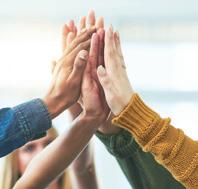
Become a leading company in ESG management
Helping solve environmental issues through residences Making employee autonomy a growth driver Innovation and communication

Make Sekisui House technologies the global de facto standard
Entering the southeastern United States
Expanding the sale of our SHAWOOD products, which leverage safety, comfort, and design Engraining such lifestyle design as our lifestyle proposal capabilities, customer engagement, and brands
Utilizing management resources and enhancing value
In 2010, we formulated our first Mid-Term Management Plan. Since then, we have achieved solid results. Under the Second Mid-Term Management Plan (launched in FY2012), we designated “deployment of growth strategies focused on the residential business domain” as our management policy. Subsequently, we have worked to expand our businesses domain centered on housing. In FY2020, we designated “make home the happiest place in the world” as our global vision, working to grow into a global company that leverages the core competencies developed since our founding to offer happiness
from integrated technologies, lifestyle design and services based on the residential domain. In our Sixth Mid-Term Management Plan, which began in FY2023, we established the fundamental policy of focusing on stable growth in Japan and proactive growth overseas. Through setting key measures and business policies aimed at strengthening and expanding all our business, we saw record high net sales and operating profit in FY2023. We will continue working toward the targets of our Sixth Mid-Term Management Plan.
Building the foundation for the residentialrelated business toward BEYOND 2020
strengthening core businesses and embarking on new businesses
Leveraging our core competencies and our unique value chain, we plan to strengthen and expand our existing businesses (A and B zones). We also plan to develop and expand new businesses (C and D zones) by utilizing digital technology and by transferring Sekisui House technologies (technical and construction capabilities) that have been cultivated domestically, with the aim of pushing ahead with overseas business development and adapting to changes in social and business environments.
In Japan, to reinforce our detached house brands, we will enhance our three-brand strategy, launching a new skeleton and infill business and improving the price range of our first range offerings. At the same time, we will enhance the Sha Maison brand based on thoroughgoing area strategy and reinforce corporate and public real estate (CRE and PRE) businesses. By doing so, we seek to expand our business domain and achieve stable growth in Japan. In addition, we will continue to develop new business by promoting the Platform House Concept of equipping houses with services supporting the health, connectedness and learning that will underpin new lifestyles (under which we launched services during the period of the Fifth Mid-Term Management Plan), as well as such initiatives as utilizing the Internet of Things (IoT). At the same time, we will incorporate new uses of digital transformation (DX) in services and management operations and leverage next-generation Sekisui House technologies in the overseas business to expand new businesses.
In this way, during the period of the Sixth Mid-Term Management Plan, we will practice ambidextrous management, both exploiting and exploring, while advancing growth strategies domestically and overseas to further enhance corporate value. Market
Zone B Expanding existing businesses
Zone D Expanding new businesses
Zone A
Strengthening existing businesses
Further develop and strengthen the business strategies advanced under the Fifth Mid-Term Management Plan into a platform based on the built-to-order business.
Appealing to emotions (Introducing the “life knit design” concept) Selling services externally
Enhancing the ratio of products made internally (vertical integration M&A)
Zone A Strengthening existing businesses
Zone C Developing new businesses Strengthening the 1st range (SEKISUI HOUSE noie)
S area, our greatest focus
Strengthening ZEH rental housing and adapting for long-life quality housing
Strengthening Trip Base business
Zone B
Expanding existing businesses
Horizontally roll out strengths of existing businesses across the Group and add new elements to expand businesses.
Zone C
Developing new businesses
Add new elements to existing business foundations to create new businesses. Leverage data and DX in the environments surrounding our businesses and customers to create businesses and maximize value.
Zone D
Expanding new businesses
Aim for medium- and long-term growth in new businesses. Pursue business possibilities, such as applying elements of new businesses to additional fields, to create value and achieve growth.
To enhance our three-brand strategy, we began a joint construction skeleton and infill business in September 2023 as part of our first range goal. Foundations and framing sections created by the Sekisui House Group are provided and built for wooden-frame houses constructed by our regional partner businesses. In our second and third ranges, we implemented aggressive real estate business strategies by improving our approaches toward customers searching for land, and promoting high-value-added solutions through the integration of technologies, lifestyle design and services. In addition, we began promoting the new design concept “life knit design” in June 2023, and particularly in the third range, we are advancing our brand DESIGN OFFICE, which was created by specialists with abundant knowledge and experience as well as outstanding abilities. By successfully implementing these methods to improve our product, design and proposal capabilities, we have guaranteed a level of net sales, operating profit and orders that is equal to the previous fiscal year even amidst a bearish detached housing market. We are also continuing to raise the unit price per building improving our gross profit margin.


As for our CRM strategy, we released the housebuilding support service “My STAGE” in June 2023. Through this, we will enhance communication with customers by creating various opportunities to connect with them.


marketing • Provide of high value-added Sha Maison • Strengthening CRE and PRE businesses
We seek to further improve the Sha Maison brand by expanding the sales of three to four-story rental housing builds created using our original construction method. Additionally, we are focusing on providing high-value-added properties such as Sha Maison ZEH, which utilize technology that allows residents to sell their excess electricity. As a result, the unit price per building has continued to rise.
By establishing a nationwide framework for ensuring each residential unit has dedicated electric vehicle (EV) charging equipment, we are promoting further high-value-added advancements. This goes hand in hand with contributing
to the realization of decarbonization by 2050 by addressing the lack of EV charging infrastructure.
In addition to these initiatives, in our corporate real estate (CRE) business, we strengthened proposals for business succession and ESG solutions. Through this, the rate of orders from corporations has increased, leading to a rise in net sales, operating profit, and orders compared to the previous fiscal year.
We will continue to promote price leader strategies centering on urban areas to realize high occupancy rates and competitive rental yields in Sha Maison while using our housing expertise to propose improved office spaces with Green First Offices (GFO), additionally focusing on expanding orders in our non-housing field.
Architectural/ Civil Engineering
Amid strong architecture investment, our channels for receiving orders in the architecture business both deepened and expanded. As a result, orders greatly increased for factories and distribution centers, as well as renewals for governmental projects related to construction work and aging infrastructure in our civil engineering business. In FY2023, net sales, operating profit and orders each exceeded the previous fiscal year.



In addition to Konoike Construction’s established expertise in environmental cleanup, the company is also beginning work on Japan’s first biogas power generation that uses methane fermentation in a dry batch process, and other similar initiatives aimed at achieving carbon neutrality. Moreover, Konoike Construction is developing technologies aimed at rebuilding aging tunnel infrastructure. We will continue working to expand orders moving forward as we strengthen our environmental field through technological development and respond effectively to robust growth in construction demand.
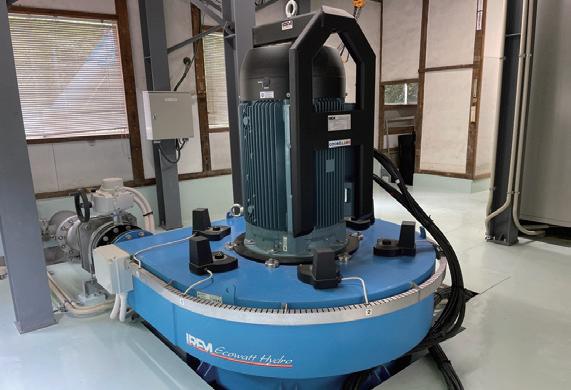
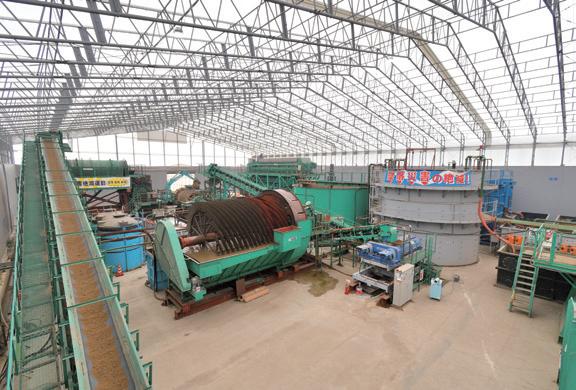
With a foundation of thorough area marketing, we saw strong orders for the high-value-added Sha Maison units that we provide in areas with stable demand for rentals, bringing the total to over 700,000 rental housing properties managed by the Sekisui House Real Estate Group. We also maintained our high occupancy rate of 97.7% and saw steady growth in net sales and operating profit for FY2023.
In addition to strengthening relationships with homeowners to maximize asset value through renovation proposals, such as changing the layout of units that no longer meet current needs due to age, we are also expanding services for tenants. These services include using blockchain technology during move-in for one-stop handling of procedures related to utilities and public services, and using the tenant app “Sha Maison Life CLUB” to consolidate all pre- and postmove procedures and inquiries online (covering everything from applications to contracts). By expanding services for new tenants, we continue to enjoy a high occupancy rate and rental rate level, maintaining stable business growth. By continuing to improve services centered on relations with owners and tenants, as well as effectively implementing DX, we will continue striving for stable business growth.

Our improved proposals for kitchen-based renovations in Japan’s typical living room, dining room and kitchen (LDK) configurations brought an increased rate of large-scale remodeling orders for detached houses. As for energy efficient remodels, we increased our promotion of Idocoro Dan-netsu thermal insulation upgrades, which are focused on areas of the home where customers spend the most time, as well as remodels improving insulation near doors and windows. In rental housing remodels, we advanced Sha Maison renovations by increasing resident satisfaction and improving asset value for homeowners. In connection with these initiatives, we saw increases in net sales, operating profit and orders for FY2023.
We will continue to strengthen lifestyle proposal remodeling involving room layout changes and energy efficient remodeling such as improvements to insulation as well as develop remodeling methods in line with the advanced specifications of new construction such as the standardization of highly durable coatings. We will actively expand Sha Maison renovations across our extensive portfolio of managed properties, aiming for stable growth in our business operations.


Proactive acquisition and sales of high-quality land for housing made with a focus on the asset turnover ratio drove growth for the Sekisui House Real Estate Group, leading to a significant increase in net sales and operating profit in FY2023 compared to the previous fiscal year. We have a framework in place, enabling us to introduce high-quality land for housing to prospective customers. The framework exemplifies the notable synergy between our custom detached housing business and our rental housing and commercial buildings business. Continuously expanding and strengthening customer inquiry routes has led to increases in property value as well as in the number of commercial properties.
We will continue to focus on asset turnover while undertaking proper capital management and inventory control as we strive to diversify suppliers and sellers of real estate for sale. For all companies within Sekisui House Real Estate, we will demonstrate the true value of what being part of the Sekisui House Group really means as a real estate company specializing in residential land.
Through focused business development in strategic areas centered on Tokyo, Nagoya, Osaka and Fukuoka, as well as providing high-value-added condominiums with all ZEH units, sales progressed well, with net sales and operating profit for FY2023 showing an increase over the previous fiscal year.
In our condominiums business, we utilize the expertise we have cultivated through building detached houses to create a concept we call “Collections of Homes,” where instead of focusing on multi-unit housing complexes, we focus on creating a community where each resident’s lifestyle converges. Under this concept, we pay close attention to a resident’s livelihood, the community and the future to offer thoughtfully designed individual residences. Moving forward, we will continue to utilize cutting-edge technology and pursue certification for Long-Life Quality Housing. Additionally, we will continue to proactively respond to plan adjustments through our unique expertise as a housing manufacturer, aiming to advance the presence of our GRANDE MAISON brand through strategic differentiation.
In urban areas, we strengthened our acquisition of land for and development of Prime Maison rental condominiums, which are assets designed for quick turnover. Amidst the strong real estate market, both for buyers and sellers, we executed our plan to sell four of our office, hotel and rental condominium buildings in FY2023, increasing our net sales and operating profit.
There was also a strong shift in the occupancy rate of our offices and rental housing. Moreover, due in part to a recovery of inbound customers, the operation of our hotels, particularly in metropolitan areas, has been steadily improving.
We will continue to focus on property development by promoting ROA management and improving the asset turnover ratio across our entire portfolio based on the acquisition of high-quality land to bring stable profits while also developing Prime Maison to promote conversion to ZEH and contribute to a sustainable society. In the Trip Base Michi no Eki Stations Project, we opened 2,336 rooms in 29 locations across 14 prefectures between 2020 and the end of 2023. We will continue to strengthen regional revitalization through cooperation with localities and alliance partners with Fairfield by Marriott, which specializes in overnight stays.

• Establishment of the Sekisui House Real Estate Group, which has strength in acquisition and sale of residential land for custom detached houses
• Enhancement of land acquisitions as short-term turnover assets based on careful selection in areas throughout Japan
• Enhancement of brokerage services for existing houses
Condominiums
• Focus on supplying properties with high asset value carefully selected for their location in four of the largest metropolitan areas in Japan
• All residential units meet basic ZEH specifications
• Enhancement of the GRANDE MAISON brand
Urban redevelopment
• Developing cities and rural areas through sophisticated area marketing and investment decisions from a medium- to long-term perspective
• Acquisition of land for rental condominium Prime Maison and acceleration of exit strategies
• Development of regional revitalization-based hotel development business through the Trip Base Michi-no-Eki Stations Project
and projections for net sales and
Since its founding, the Sekisui House Group has aimed to provide not only technologies in the form of homes that protect the lives and assets of residents but also to make our customers happy by delivering new value in housing that combines lifestyle design and services. To realize this new value, we are supported by over 400 technical personnel working out of large-scale research and development facilities who bring diverse ideas and passion to research and development, as well as our production on a house-by house basis that extends from production to shipment. In addition to safety, peace of mind, comfort and eco-friendliness, we pursue health in housing through initiatives ranging from advanced technology development to investigation and research into services for happy lifestyles. On a daily basis, we are achieving technological innovation in the residential domain across diverse aspects of technology, lifestyle design and services.
In



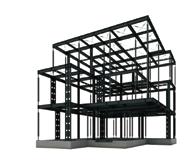
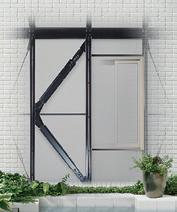







As we seek to provide happiness in the era of the

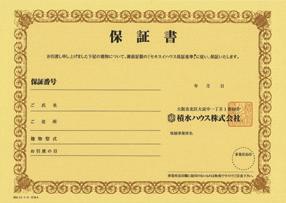
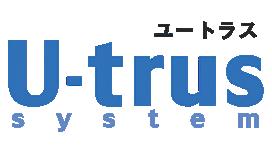


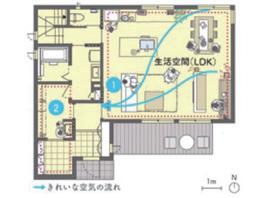

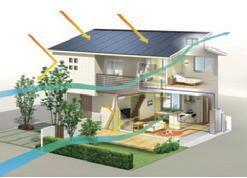





Since the founding of the Sekisui House Group, we have been closely attuned to our customers to provide value through housing. Amid the ongoing shift to digital contact with customers, we promote CRM* strategies aimed at enhancing the value of the entire customer experience, from housebuilding to after customers take possession.
In pursuit of this goal, we released My STAGE in FY2023 to further improve the experience-based value gained by customers considering housebuilding. This service increases the effectiveness of our proposals and approaches by featuring Sekisui House’s comprehensive housebuilding knowledge, along with functions to help families enjoy the process of building a house together.
We will continue to utilize customer contact points created via physical and digital approaches as well as data to scientifically analyze both the latent and explicit needs of customers, leading to optimal solution proposals and efficient order management. We will also connect with customer management within the Sekisui House Group, striving to enhance all strategies and cooperation across our businesses.
An approach that unearths latent needs and promotes personalization and appeal
analysis of customer
to deliver optimal solution proposals
and

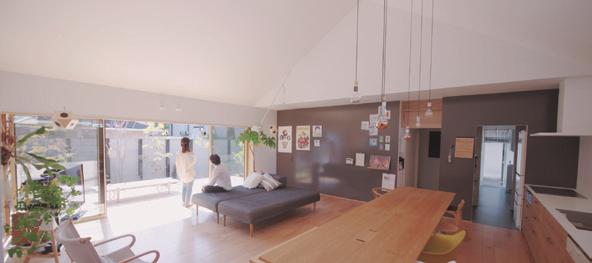
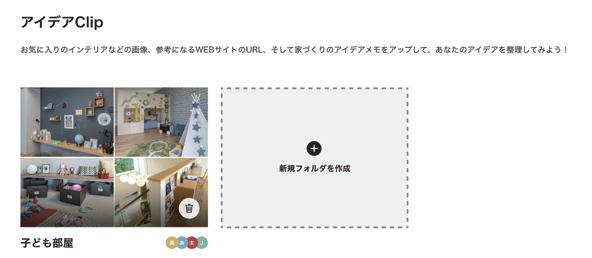
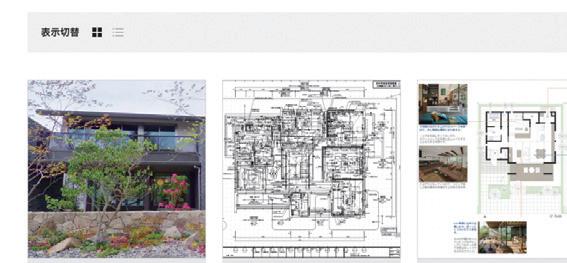
Sekisui House has created a joint venture with Nippon Life Insurance Company, planning and developing a high-grade next-generation building in the Akasaka district of Minato City, Tokyo. Construction was completed in May 2024.
This property is directly connected to the Tameike-Sanno Station of the Tokyo Metro Ginza Line and the Kokkai-gijidomae Station of the Tokyo Metro Marunouchi Line and we take pride in the many ways it is convenient as a metropolitan high-rise office building.
Blending into the lush natural environment that extends continuously south of the Imperial Palace, AKASAKA GREEN CROSS contributes to the well-being of its users through its overwhelming presence that acts to build connections between people and foster creativity in new businesses. We have established high standards for building safety measures regarding city disasters and business risk, supporting uninterrupted business for tenants.
Furthermore, thanks to the implementation of the newest energy-saving features, the office sections of the building have received five stars from BELS¹, one of the foremost environmental performance evaluation systems within Japan. We have also passed ZEB Oriented² standards and received a self-evaluated S-rank on the CASBEE for buildings³ (for new construction).
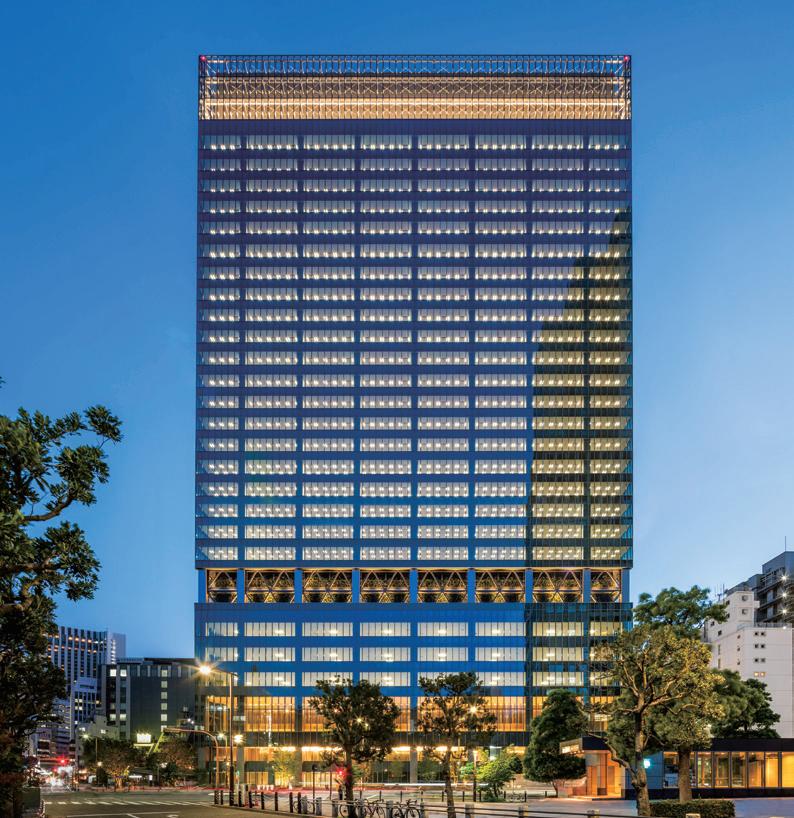

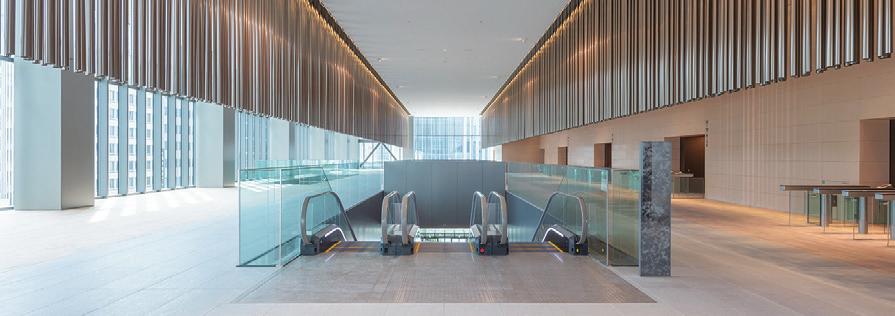
1



Message from the Officer in Charge of the Overseas Business

Toru Ishii Director of the Board Senior Managing Officer In charge of Division of Development Business and Head of International Business Headquarters
Started in 2009, the overseas business now engages in selling detached houses, condominiums and residential land as well as developing rental condominiums, commercial facilities and other complexes. Operations, which extend to Australia and Singapore, are currently focused on the United States.
Under the Sixth Mid-Term Management Plan, we set out to shift our overseas business portfolio from being focused on development to a two-pillar business of development and homebuilding. Thus, we aim to continue our proactive growth strategy in our homebuilding business, with the goal of providing 10,000 homes overseas by 2025. Through welcoming publicly listed* homebuilder M.D.C. Holdings, Inc. (MDC) into the Sekisui House Group in April 2024, we expect to achieve this goal ahead of schedule. Our next objective is to have supplied 20,000 homes in the United States by 2031, during the last year of our Eighth Mid-Term Management Plan. We aim to become a game changer in the U.S. market by deploying 3,000 homes of the Sekisui House original brand SHAWOOD as well as 17,000 homes utilizing the “New 2x4 by Sekisui House,” a new type of housing combining the 2x4 housing construction common in the
Final year of the Eighth Mid-Term Management Plan (FY2031)
U.S. detached houses: 20,000 homes, of which, 3,000 being SHAWOOD
Aiming for a future where people all over the world can live happily in Sekisui House homes, we plan to advance technologies that we have cultivated domestically for over 60 years, bringing them to the rest of the world. From here, I’d like to talk about what we hope to achieve with MDC and our existing U.S. homebuilders. We plan to develop our “New 2x4 by Sekisui House,” a new type of housing combining the 2x4 housing construction common in the United States with Sekisui House technology as well as expanding the Company’s original SHAWOOD brand. Through this, we hope to realize the Company’s fundamental policy underlying its global vision of making Sekisui House technologies the global de facto standard.
United States with Sekisui House technology.
We are striving to maximize and stabilize profits in the U.S. multifamily business by strengthening cooperation with our business partners and diversifying them. In FY2023, we began work on new projects with our existing partner Holland Partner Group as well as with our new partner company RangeWater Real Estate, LLC. These projects involve medium-size, low-to mid-rise properties, reflecting advancements in the diversification of our business partners and asset types. In May 2024, the urban rental housing development The Ivey on Boren, was sold to Sekisui House Reit, Inc. We have also diversified our exit strategy through this sale of multifamily housing in the United States to a Japanese investor.
In our homebuilding business in Australia, we are aiming to enhance growth by further promoting area strategies as well as establishing SHAWOOD homes. In the apartment & mixed-use developments business, we aim to transition to a more efficient portfolio by balancing between short-turnaround projects and medium-to long-term large projects.
There are three technological aspects to the Sekisui House technologies we are considering transferring to 2x4 housing. The first being highly-durable technology that gives our customers safety and peace of mind. The second aspect is environmental technology that gives our customers a feeling of comfort through functions such as thermal insulation, airtightness and SMART-ECS (a next-generation indoor environment control system). The third is cost reduction, achieved through shorter construction timeframes and reduced waste.
As for lifestyle design, we are accelerating the introduction of Life Style Solution (LSS), a lifestyle proposal aimed at helping our customers find happiness. Starting with Woodside Homes Company, LLC is spreading to other Group builders and receiving tangible feedback.

Additionally, we are making determined efforts to advance SHAWOOD, the Company’s original brand that best exemplifies Sekisui House technologies. SHAWOOD leverages the Company-developed S-MJ construction method to offer competitive advantage, added value through flexible spatial design, and ensuring highly reproducible and consistent quality of its 2x4 housing.
We began selling SHAWOOD in the United States in January 2024 in the southern Californian community Sommers Bend. In addition to making sure all 57 SHAWOOD homes meet ZEH (Net Zero Energy House) standard specifications, we are developing high-value products that utilize various technologies that contribute to the Company’s environmentally-friendly stance as well as to improvements in disaster resistance. We have built three model houses, with one of them being designated as an Experience Center where customers can get acquainted with Sekisui House technologies. Sales are also exceeding expectations as a result of many customers coming day after day to this center.
As such, we are breaking into a new market through the utilization of Sekisui House technologies, refined in Japan for over 60 years, with the aim of establishing an unparalleled presence and becoming a game changer in the U.S. housing industry.
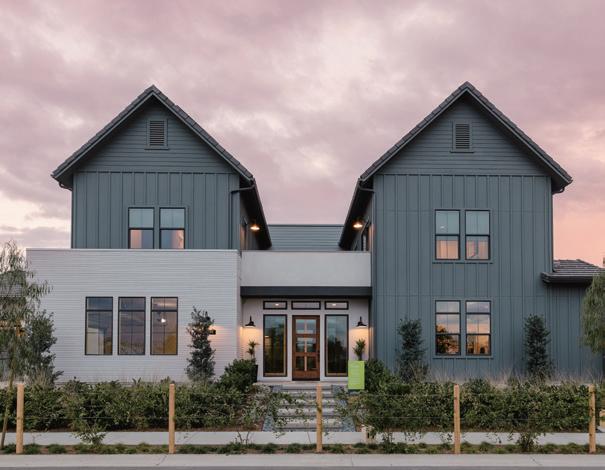


The Company doesn’t conduct M&A simply to boost earnings and housing sales. We also place importance on whether the companies we acquire share our Corporate Philosophy, vision, goals for housing and other significant considerations. We believe that MDC, with a robust business platform developed over its 50-year history, which includes strong governance established as a publicly listed homebuilder, will have a positive impact on the existing Group builders.
As a prominent American homebuilder, MDC operates in an extensive area encompassing 34 cities in 16 states, having supplied over 240,000 homes since its founding. MDC supplied over 8,000 homes in FY2023 and reached net sales of roughly $4.6 billion (approximately ¥700 billion, under a $1 = ¥150 conversion rate).
Through the addition of a company with these strengths to the Sekisui House Group, we believe that the foundation set to comprehensively transfer Sekisui House technologies into the United States has been greatly strengthened.
As a PMI promotion structure bringing together the Company, existing Group builders and MDC, we have established the U.S. Homebuilding Steering Committee, an organization under direct control of the Board of Directors. In the U.S., we have established the SHRH Committee Integration Management Office. The U.S. Homebuilding Steering Committee, consisting of several different departments, establishes Group-wide policies and strategies, which the SHRH Committee Integration Management Office then ensures are applied to every Group builder. We have also established three subcommittee divisions under the SHRH Committee Integration Management Office: the Administration Division, tasked with conducting discussions aimed at standardizing financial and human resource systems, strengthening governance structures and other related matters; the Technology Division, tasked with conducting discussions regarding the transfer of the previously mentioned Company technologies; and the Sales Division, tasked with conducting discussions on the development of the “New 2x4 by Sekisui House” and SHAWOOD products. We have already begun detailed discussions at these subcommittees, with each of the three existing Group builders being encouraged to participate.
Homebuilding business
Master-planned community business
In the homebuilding business, despite mortgage rates being high at 6-7%, they have remained relatively stable, and the demand for new houses remained consistent due to housing shortages as well as the decrease in pre-owned homes circulating in the market. Thus, business exceeded our expectations even after accounting for the impact of exchange rates. By strengthening our relations with existing Group builders, we have successfully implemented a fast-moving business strategy through initiatives such as increasing the number of built-for-sale houses designed to be moved into relatively quickly, improving our business results even further. Moving forward, through deeper strengthening of Group cooperation, now also involving M.D.C. Holdings, Inc., we hope to drive further growth in our overseas business.
Our master-planned community business, which sells developed residential land to outside builders, outperformed expectations as demand for single-family housing rebounded, leading to the recovery of demand for builders’ land acquisition. We are also working to deepen cooperation among Group builders in this business. As for our SHAWOOD business, the regional recognition of our brand has increased after we began operations in Sommers Bend, a community in southern California. Additionally, value created through the Company’s technology and streamlined production system has resulted in our even greater confidence in the products we provide. We will continue enhancing our presence in this community while also advancing sales promotions and expansion in other areas.
Although we must pay close attention to trends in home mortgage rates in FY2024, we expect increased sales and profits in our homebuilding business based on projections that demand will continue to recover.


Multifamily business
In the multifamily business in FY2023, we postponed some planned property sales given the cautious stance of real estate investors amidst factors like rising interest rates. The leasing of the rental housing developed by the Company is proceeding well due to the properties’ prime location and high-quality. Thanks to production moving along smoothly, we aim to sell the properties at a time in FY2024 when their value is maximized.


Homebuilding business, Master-planned community business
• Builders M&A:
— Strengthening governance for the Group’s builders
— Proactively promoting intragroup collaboration
— Entering the southeastern United States through M&A
• Technology transfer
— Transferring Sekisui House technologies
— Expanding our own brand (SHAWOOD)
Multifamily business
• Partnerships: Diversifying business areas and partnerships
• Portfolio: Diversified investment and recovery aligned with the business area

In June 2023, Hubble Homes was incorporated into the Woodside Homes organization. Accordingly, it became part of the Sekisui House Group, and now operates as a branch of Woodside Homes. Hubble Homes developed its business in Boise, Idaho, a city where population growth is expected to exceed the U.S. average due to factors such as excellent living conditions and increased employment opportunities. Priding itself on supplying first-rate houses in a market expected to have increasing demand moving forward, Hubble Homes has maintained a steady market share through its highly efficient operations as well as its superior and abundant residential land holdings.

Since 2009, in Sydney and Brisbane, we have been engaged in selling single-family homes and residential land as well as developing apartment, commercial facilities and complexes. We are promoting the expansion of SHAWOOD in Australia by concentrating management resources in areas where we expect demand for high-value property, such as the coastal and northwestern areas in Sydney. Due to the effect of rising home mortgage rates, there was a reduction in unit sales for our homebuilding business in FY2023, but expected deliveries of apartment and land sales proceeded as planned.
The challenging business environment, characterized by persistently high home mortgage rates, is expected to continue into FY2024. Despite this, we will continue striving towards our goals by focusing efforts on sales of singlefamily homes and apartment, as we anticipate steady demand from increased immigration and other similar factors.
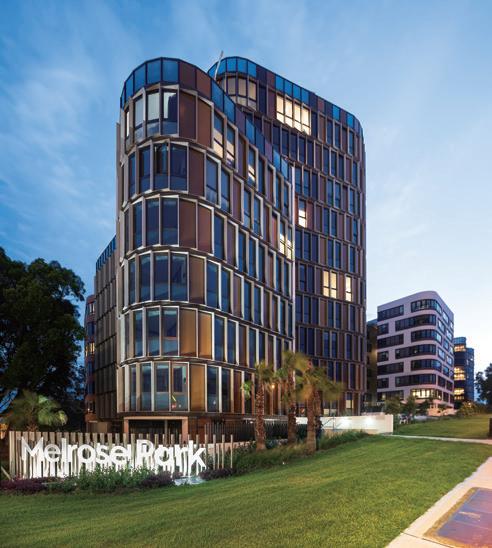


In Singapore, through joint businesses with prominent local developers, we are expanding the development of highvalue condominiums as well as a mixture of service apartments, retail and offices. In FY2023, our property sales proceeded as planned.
In FY2024, we are promoting steady business by further strengthening cooperation with joint business members.
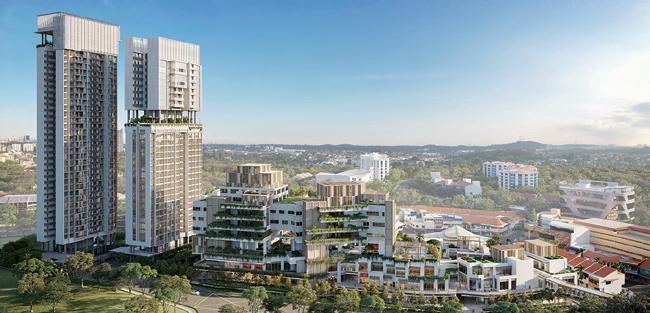


• Developing our operations into the second largest pillar of the overseas business through the execution of area strategies and the establishment of our brand presence
Apartment & Mixed-Use developments business
— Shift to an effective portfolio that balances short and long-term properties
Homebuilding business
— Acquire land for the SHAWOOD business in high-end markets, improve brand recognition and asset turnover rate
Singapore
• Securing close partnerships with prominent corporations in Asia
— Build deeper relationships with partner businesses and strengthen cooperation
M.D.C. Holdings, Inc., headquartered in Denver, Colorado, USA, is a homebuilding business that has expanded to 34 cities in 16 U.S. states, including Arizona, Colorado, California and Florida.

Under the Richmond American Homes brand, MDC maintains a wide product lineup for diverse lifestyles and budgets, with a talent for developing products to meet the needs of customers in both design and efficiency. In addition, the company is undertaking advanced environmental initiatives by standardizing energy-saving equipment in their new detached houses. As a result, these houses achieve a high energy efficiency, using on average 81%* less power than a typical previously owned home.
* Our figure, based on materials disclosed by MDC
MDC realized steady growth, though higher mortgage rates affected performance in FY2023, as shown below.

In the first quarterly financial results briefing of FY2024 in June 2024, we disclosed upward revisions to the initial forecast for FY2024, and our plan to expand dividends in line with profits.
This upward revision accounts for the consolidation of MDC and the company’s projected performance results (covering the consolidated period of April 20, 2024 to December 31, 2024), the amortization of goodwill following acquisition, temporary expenses related to the acquisition, interest expenses
amid higher interest-bearing debt, and the revision of exchange rates (from 135 yen/US dollar to 140 yen/US dollar). There were no changes to the initial plan for domestic business.
For details, please refer to the following materials made public on June 6, 2024.
• U.S. Homebuilding Business Strategy
• Notice Regarding Revisions to the Operating Results Plan and Dividend Plan
• Consolidated Financial Results for the First Quarter of FY2024
At the heart of the Sekisui House Group’s ESG management is our fundamental philosophy of “Love of Humanity.” We strive to address the challenges faced by our customers and society through our business activities, while strengthening our governance. To lead in the realm of ESG management, we have established a sub-vision of “becoming a leading company in ESG management.”
To realize this vision, we believe it is essential for each employee to think and act independently. Since 2020, we have focused on involving all employees in our ESG efforts. Through meaningful dialogue, we have fostered mutual understanding of each other’s perspectives and values, deepening our commitment to ESG. Moreover, we have been dedicated to creating programs and nurturing a workplace culture that promotes autonomy and encourages independent, proactive actions among employees.
In our Sixth Mid-Term Management Plan (FY2023–FY2025) is our commitment to “deepening ESG management focused on material issues.” Our initiatives concentrate on “contributing to environmental solutions through housing,” “empowering employee autonomy as a growth driver,” and “fostering innovation and communication.” To advance our ESG efforts, we have established three committees focused on Environment, Social, and Governance. These committees set policies aligned with the Sixth Mid-Term Management Plan, accelerating our initiatives and actively engaging with various stakeholders to build trust and enhance corporate value.

Propose happiness through the integration of technologies, lifestyle design and service

a leading company in ESG management

technologies the global de facto
Deepening ESG management focused on material issues
Contributing to environmental solutions through housing Empowering employee autonomy as a growth driver Fostering innovation and communication
Addressing ongoing and emerging environmental challenges
Environmental Subcommittee
We are dedicated to planning and implementing an environmental management system focused on decarbonization, biodiversity conservation, and resource circulation across the entire Group. We compile environmental data annually and share this information to raise awareness and reduce environmental impact among both internal and external stakeholders. Guided by our Global Vision, “Make Home the Happiest Place in the World,” we believe that environmental initiatives are essential. We will continue to pursue innovative approaches to reduce environmental impact and business risks while creating new opportunities.
Three key elements for advancing ESG management
Engaging all employees
Implementing advanced initiatives
Improving external evaluations
Enhancing corporate value through improving human capital and social value
Social Improvement Subcommittee
Our mission is to elevate corporate value by enhancing both human capital and social value. We focus on improving human capital and addressing social issues through various initiatives. We believe that multiplying employee autonomy with aligned goals create immense value. Our aim is to make the company a “home” for our employees, planning and implementing measures to ensure their happiness. With regard to social value, we focus on initiatives that consider children, the environment, human rights, and regional revitalization, contributing to societal well-being. We closely monitor the policies and progress of these initiatives to maximize the happiness of our customers, society, and employees.
Strengthening governance through unified leadership and business managements
Governance Subcommittee
To enhance Group governance, we prioritize fostering robust communication between our corporate headquarters and our domestic and international Group companies. We are dedicated to improving information sharing and collaboration.
Our efforts to strengthen governance at the business management level include enhancing corporate functions across our Group companies, developing and strategically placing governance specialists, and raising compliance awareness. Through understanding current conditions and engaging in discussions for improvement, we aim to build a stronger governance framework.
To drive ESG management, we have established three subcommittees: the Environmental Subcommittee, the Social Improvement Subcommittee, and the Governance Subcommittee. Each subcommittee is led by designated leaders who are responsible for their respective areas. These subcommittees continuously set and monitor initiatives and KPIs tied to our core priorities, working closely with various departments and group companies both domestically and internationally to lead our ESG efforts. We regularly report on the progress of these initiatives, as well as the challenges identified and solutions proposed, in meetings including the ESG Promotion Committee. Based on feedback, we refine our initiatives and strategies to ensure all employees understand and commit to our ESG initiatives.
The Representative Director, Vice Chairman, and Executive Officer oversees the entire Sekisui House Group’s ESG activities. The Senior Managing Executive Officer drives our Group’s ESG initiatives. The ESG Management Promotion Headquarters, established in June 2020, plans, develops, and implements our core ESG policies. They lead Company-wide efforts, gather and analyze information, and communicate insights both internally and externally to further advance our ESG management and initiatives.
To enhance our ESG management, we have established the ESG Promotion Committee, chaired by the Representative Director, Vice Chairman and Executive Officer, and including at least two external members with specialized expertise. This advisory body to the Board of Director discusses and reports on ESG activities, progress, and challenges, thereby strengthening the effectiveness of our ESG efforts across the entire Group. The Committee meets every three months, and its discussions are reported to the Board and shared with all employees through our intranet.
ESG Promotion Committee
Chairperson: Yosuke Horiuchi (Representative Director of the Board, Vice Chairman, Executive Officer)
Outside members: Katsuhiko Kokubu (Dean and Professor, Graduate School of Business Administration, Kobe University), Hidemi Tomita (Institute for Sustainability Management CEO)
Internal members: Head of the ESG Management Promotion Headquarters, the respective chairpersons and vice chairpersons of the three ESG subcommittees, etc.
Note: Directors of the Board, Audit and Supervisory Board members and executive officers of the rank managing officer and above may attend as observers
Main Agenda of the ESG Promotion Committee for FY2023
13th meeting, held May 24, 2023
14th meeting, held July 18, 2023
15th meeting, held October 13, 2023
• Addressing TNFD • Human capital initiatives
• Progress of the human capital value project
• Strategies for enhancing “employee autonomy”
• Promoting of zero deforestation and revisions to the Wood Procurement Guidelines
• Compliance with the revised Act on Elimination of Discrimination against Persons with Disabilities • ”Kids First” initiatives • Expanding ESG dialogue initiatives
• Results of the 2nd “SHIP” final review and plans for the 3rd “SHIP”
• Revising ESG Promotion Committee regulations
• Discussing human capital disclosure items
• Regional revitalization projects (PRE)
• New “Sekisui House Matching Program”
• Organizational restructuring of Sekisui House Construction Group
• Trends and challenges in the circular economy
• Strategic directions and initiatives of the three ESG subcommittees for FY2024
• Regional revitalization projects (training and recruiting homebuilding craftsman)
16th meeting, held January 16, 2024
• Progress, review methods, and judges for the 3rd “SHIP”
• ESG dialogue strategic directions for FY2024
• Confirming material issues
• Editorial policy for VALUE REPORT 2024
• Efforts to enhance ESG ratings
Based on an analysis of risks and opportunities associated with changes in the external environment, in the Sixth Mid-Term Management Plan, we have established Key Performance Indicators (KPIs) and are promoting initiatives for each of the three material issues: creating high-quality housing stock, contributing to a sustainable society, and promoting diversity and inclusion. P.43 Material Issues
We identify and analyze medium- to long-term challenges that could impact our Group, viewing risks as opportunities for future business growth. This analysis shapes our medium- to long-term business strategies. Progress and challenges related to ESG initiatives are reviewed by the ESG Promotion Committee, an advisory body to the Board of Directors. The Board then deliberates and oversees our Group’s sustainability efforts based on these reports. Furthermore, the Risk Management Committee examines and manages details related to major risks within the Group’s overall risk management framework.
In our Sixth Mid-Term Management Plan, we have established 54 KPIs to achieve our materiality goals.
P.57–60 Indicators and Progress
P.235 Indicators and Progress
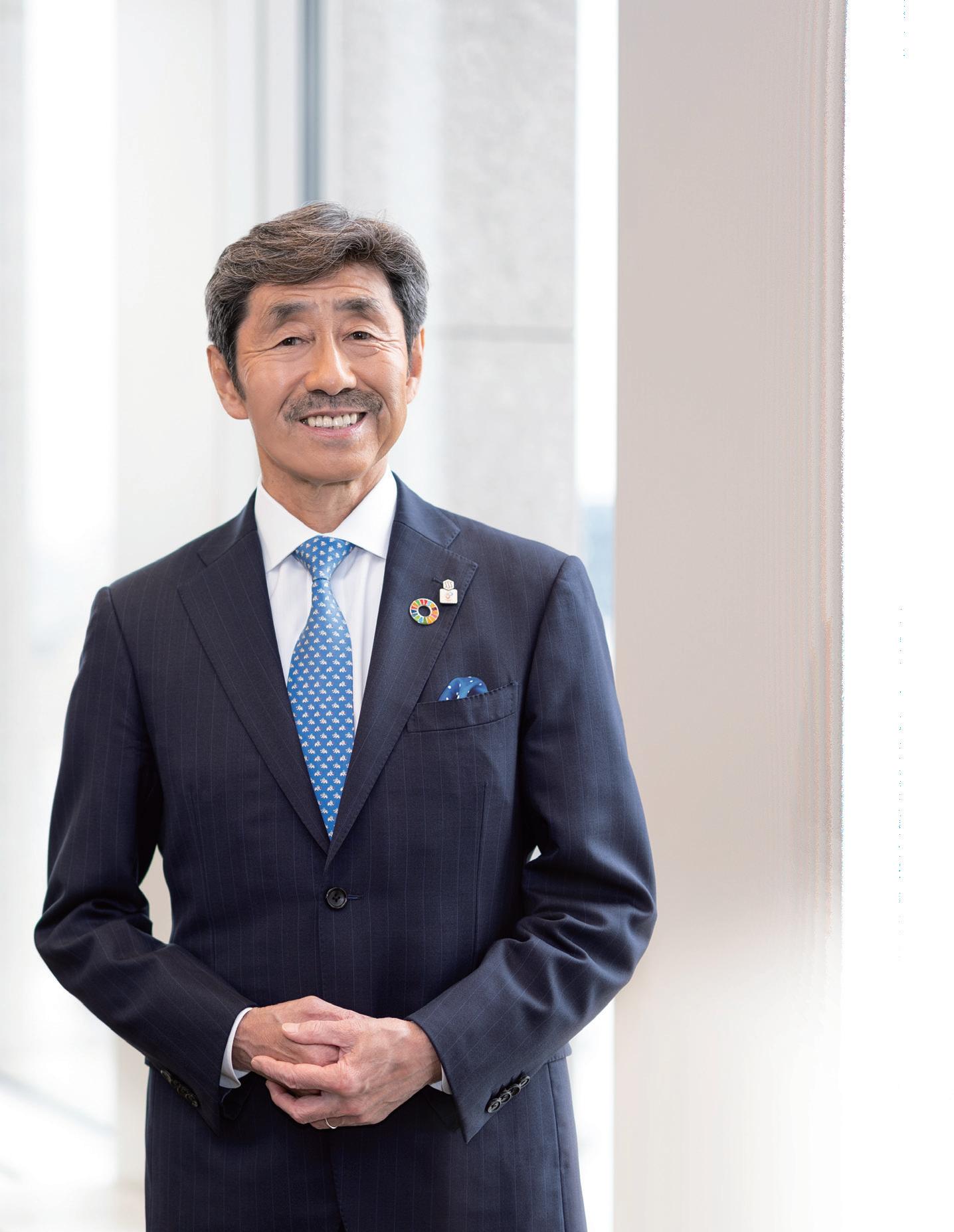
Satoshi Tanaka Representative Director of the Board Executive Vice President, Executive Officer
A company is built on its people, and the Sekisui House Group’s primary driver of growth is enhancing the value of our human capital. How do we cultivate this growth in our employees? We believe the relationship between employees and the company is equal, and human talent grows naturally rather than being forced to grow. Similar to plants, the potential for growth lies within each individual from the beginning. This potential unfolds through budding, rooting, leafing, and eventually flowering, driven by personal efforts and dedication. I believe it is our responsibility as leaders to carefully cultivate an environment that enables this growth.
The Company offers various opportunities for challenges and platforms for success, and employees fully utilize them to foster their own growth. In this process, we deliver happiness to our customers and society, while fostering organizational growth and enhancing corporate value. As the Company grows, it will offer greater opportunities for challenges and more platforms for success to employees. By continually investing in our people, the Sekisui House Group strives to create a virtuous cycle of growth where both employees and the Company thrive together.
As we engage in business activities centered on housing, we have consistently adapted our business and human resource strategies to evolve with the changing nature of housing. The value the Sekisui House Group provides begins with ensuring the safety and security of people’s lives and property. It then extends to the comfort of residents, environmental considerations, and creating homes that foster happiness through aspects such as health, connectedness and learning. To align with the diverse values of our customers and create unique forms of happiness that resonate with each
person’s sense of beauty, employee autonomy is essential. New value is created when employees, with a clear vision for their own life and work, bring their individualities and values. By engaging in mutual exchange and continuous improvement, they stimulate each other and generate new value.
As a member of the Sekisui House Group, it is necessary to share our vision and strategy, aligning on the overall direction. However, what each individual aims for beyond that varies from person to person. We value a mindset that transcends conventional thinking, embraces change, and integrates new ideas. Through innovation and communication, we continually offer new forms of happiness to our customers and to ourselves. As we continue to welcome new colleagues through career hiring and domestic and international M&A, I hope that our new colleagues will quickly integrate into the Sekisui House Group. At the same time, I encourage them to maintain a healthy sense of individuality and discomfort without conforming too much to their surroundings. The interaction and collision of diverse personalities and values will spark chemical reactions that give rise to new ideas.
To realize our Global Vision, “Make Home the Happiest Place in the World,” it is essential to make our Company the happiest place for our employees to work. Just as each customer has their own unique form of “happiness,” the same is true for each employee. The Sekisui House Group strives to support the self-directed career development of each employee and promote diverse workstyles, creating an environment where employees can thrive with confidence and reach their full potential.



As the concept of housing evolves with the times, our Group’s human capital management strategy continues to evolve as well.
In Phase 1, from 1960 to 1990, we focused on harnessing the latest technology and training skilled technicians in construction with the goal of driving innovation in the Japanese housing industry. Accordingly, in 1982, we established a training school and implemented an in-house certification program, along with unique education and training requirements. By maximizing the value of our human capital, we created value through housing safety and peace of mind, protecting lives and property.
In Phase 2, from 1990 to 2020, we emphasized promoting diversity in the development of advanced technologies to enhance housing performance and resident comfort. Beyond improving housing performance with energy efficiency and seismic resistance, we introduced universal design and proposed large continuous spaces with the Slow Living housing design. By recruiting diverse individuals with unique perspectives and experiences, and leveraging their distinct qualities and potential, we created value by improving the comfort of residents and becoming more environmentally conscious.
In Phase 3, from 2020 onward, we aim to offer happiness in housing tailored to the era of the 100-year lifespan. To achieve this, we are promoting initiatives to create an environment where employees with diverse personalities and values can autonomously continue to take on challenges and drive innovation.
The Group views our human capital management strategy as a key component of our overall management strategy and is dedicated to fostering an environment where everyone can thrive. In every era, the common quality we seek in our human resources is a mindset dedicated to pursuing personal happiness and acting on one’s own choices. By recognizing and collaborating with each other, employees with diverse perspectives and values perform diligently, achieving sustainable personal and organizational growth alongside a strengthened competitive ability, thereby increasing corporate value.

Supporting Self-Directed Career Development
• Self-directed career development education
• Career development support system
• Sekisui House Innovation & Performance (SHIP) Awards

• Promoting the participation of women
• Promoting the participation of global human resources
• Promoting the participation of people with disabilities
• Promoting employee understanding of the LGBTQ+ community

• Offering a variety of workstyle programs
• Expanding systems for fair evaluations
• Creating a workplace culture that ensures psychological safety
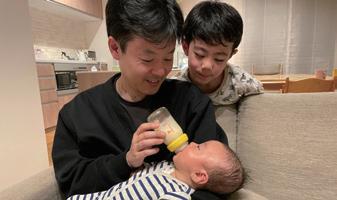
Caring for Our Employee’s Well-Being
• Assisting the pursuit of family happiness (encouraging male employees to take childcare leave, nursing care leave, etc.)
• Supporting health improvement efforts
• Continuing the Well-Being Survey

• Training leaders who will promote and implement our Corporate Philosophy and strategies
• Recruiting and optimally allocating employees in line with strategies
Fostering continuous growth in our employees is key for the Sekisui House Group. By investing in our employees, we aim to enhance their value, making both them and the organization stronger in providing new value to customers and society. It is our employees who will make this aspiration a reality. To achieve our Global Vision, “Make Home the Happiest Place in the World,” we believe it is crucial to first make Sekisui House—the professional “home” of our employees—the happiest company in the world, creating an environment where they can maximize their potential.
The Sekisui House Group believes that enhancing human capital value comes from employee autonomy and an alignment of efforts. Employee autonomy involves actively behaving based on the spirit of our fundamental Corporate Philosophy of “Love of Humanity,” while alignment of efforts means that Sekisui House’s vision and strategies are fully understood and embraced by employees. If employees utilize company resources to independently shape their own career paths while aligning their efforts with the Company’s vision and business strategy, the value created will result in tremendous growth.
The human resources strategy of our Sixth Mid-Term Management Plan (FY2023-FY2025) focuses on four important themes: supporting self-directed career development, promoting DE&I, promoting diverse workstyles, and building a foundation for well-being. Through system revisions and creating a corporate culture conducive to these concepts, we support and facilitate employee autonomy. To accelerate an alignment of efforts, we train leaders capable of properly promoting and implementing our Corporate Philosophy and strategies as we recruit and optimally allocate employees in line with these strategies.
At the Sekisui House Group, employees with diverse perspectives and values thrive due to changes in management and business environments, as well as initiatives to promote women’s advancement and expand mid-career hiring. Following this trend, we have shifted from a relationship where the Company hires and utilizes an individual to a mutual selection process where both the Company and individuals choose each other, enabling employees to thrive and grow in such an environment. We strive to create an environment that allows individuals to authentically and securely discover opportunities for personal achievement and growth, maximizing their strengths and unique qualities. While proactively promoting diverse workstyles and implementing highly flexible work systems and operations, we foster self-directed career development and support skill improvement through our in-house certification program and expert instruction.
By empowering each employee to think critically, make decisions, and maximally leverage Company resources, we believe the value of human capital will be significantly increased. The Sekisui House Group creates systems and offers opportunities based on the following two mindsets.
• Individual growth cycles: An individual growth cycle is based on learning through self-directed career development courses, where employees enhance their experience and skills through education and opportunities encountered in their work.
• Organizational growth cycles: Organizational growth cycles involve employees transcending their department and joining projects that connect them with diverse talent, as well as engaging in dialogue with managers through career interviews.
1
Important matters related to human capital policies are discussed, based on content, by the Personnel Affairs and Remuneration Committee, the ESG Promotion Committee or the Risk Management Committee, all advisory bodies to the Board of Directors. The results are then presented at Management Meetings or Board of Directors meetings, and Company-wide measures are implemented and managed. To promote our human resources strategy, the Human Resources and General Affairs Department, the Human Resources Development Department, the Diversity and Inclusion Promotion Department, and other related departments implement policies and manage KPI progress. Coordination between departments is fostered through discussions in the Social Improvement Subcommittee, which operates under the ESG Promotion
Committee. We have also created a Group-wide system to receive reports regarding issues affecting the Group and KPI progress.
Employee autonomy relies on each individual utilizing the resources of our Group, taking proactive steps, and continuously focusing on their career development. Accordingly, we are focused on building systems and environments that support sustainable growth for both employees and the Company. We also promote the creation of environments that enable individuals to fully develop and utilize their abilities while working in their own way, regardless of age, gender, nationality, or disability. We continue to proactively implement and operate highly flexible working systems suitable for various workstyles. While systematically nurturing high-integrity leaders, we also strive to recruit the talent necessary for our business strategies and ensure they are appropriately allocated.
To achieve the Sekisui House Group’s global vision of “making home the happiest place in the world,” with its policy of “maximizing the value of human capital and driving business growth through diversity and inclusion of knowledge and experience,” we promote initiatives aimed at talent development.
Basing our mindset on the idea that it is important to make our Company, a “home” to our employees, the happiest in the world, we seek to become a company where everyone can feel their work is meaningful and satisfactory. We are developing a working environment that encourages the promotion of important measures such as support for self-directed career development, promotion of DE&I and diverse workstyles, and building a foundation for well-being.
The relevant departments analyze risks and opportunities related to human capital. The Social Improvement Subcommittee then evaluates countermeasures and holds discussions, fostering cross-department cooperation. When risks and opportunities are determined through this process to be especially important, the ESG Promotion Committee, an advisory body to the Board of Directors, reviews them before making a report to the Board in connection with our mid-term strategic plans. Each Group company monitors the Company’s risk map, and after reporting on important matters to the Risk Management Committee, such as those related to securing human resources, they conduct studies and management through the Group-wide risk management structure.
For the Sekisui House Group to achieve sustainable growth, it is essential to secure excellent human resources capable of developing its existing businesses and taking on challenges in new businesses. By formulating our human resources plan, we further clarify the human resources necessary to execute our business strategies. We are proactively enhancing our branding as an employer of choice, diversifying our recruitment pipeline and selection methods, and employing human resources regardless of age, gender, nationality, or disability.
In the Sixth Mid-Term Management Plan, we have set 17 individual KPIs. P.60 Indicators and Progress
We have actively promoted the employment of new female graduates since 2005 as a business strategy amidst society’s rapidly diversifying housing-related needs and changing lifestyles. By establishing an environment where diverse individuals can participate, we aim to increase our retention rate and facilitate organization-wide growth.
Mid-career and specialist talent recruitment
We are also proactively recruiting talent with specialized skills that can become immediate assets. We consider the diversity and inclusion of knowledge and experience—where individuals of different nationalities and professional backgrounds contribute new perspectives and expertise—as a crucial strategy for fostering organizational diversity and development. Various methods of onboarding are in place, along with a system and compensation structure that appropriately evaluates individual expertise and abilities. We also encourage the assignment of mid-career hires to managerial positions, creating environments where specialized human resources can maximize their potential.
In addition to efforts focused on diversity and inclusion and workstyle changes, with the goal of supporting self-directed career development, we positioned 2021 as the kickoff year for reforms to our HR programs and processes and revised our grading, performance evaluation, and compensation systems. Reforms to HR programs and processes are also carried out at Group companies.
Effective communication between supervisors and their team members is essential to understanding one’s own strengths and individuality. To support this, we have established a system of career interviews, in which supervisors and team members discuss careers regularly. These interviews aim to share employees’ values and ideas about their careers, as well as to support their growth by providing appropriate feedback on their individual strengths and key aspects of their development.
P.115 Career Interviews
Implementing multiple career tracks to managerial positions
We have established two types of career courses for managers: direct managerial positions and specialist positions that contribute to the organization through high-level expertise. We implement human resources systems so that employees can choose their own future career course.
Managerial promotion system
As part of the revision of our personnel system in April 2022, the number of grades for non-managers was reduced from nine levels to five, creating a system for the early promotion of talented employees to manager. Starting in April 2023, we further accelerated this process and revised the rules to allow employees to be promoted to managerial positions after a minimum of five years with the Company. This establishes promotions and appointments based on individual ability and merit, regardless of age or years of service in the Company.
• Career course selection
• Early creation of management opportunities
• Fair and transparent appraisal
• Career interviews with supervisors
Courses and grades
Double track course (managers)
• Introduction of role classes for managerial positions
• Managerial (M) positions that contribute to the organization through management
• Specialist (SP) positions that contribute to the organization through high-level expertise Specialists Managers
Promotions
and
Promotion according to merit (non-managers)
• Promotion decisions based on merit, not on age or years of employment
• Early promotion of highly evaluated employees (promotion to manager possible in as few as five years)
Fundamental revision of personnel evaluations and enhancement of job interviews
• Ability/behavior review and performance review are separated.
• Ability/behavior review is reflected in class changes and salary changes, while performance review is reflected in performance bonuses.
• Process for self-assessment (individual and organizational), approval and evaluation finalized, and evaluation system developed •Interview training
Career emphasis and talent management
• Self-assessment of career plan and self-emphasis of one’s ability/knowledge/experience
• Periodic career interviews five times a year
• Human resource matching utilizing the talent management system
• Human resources recruitment system
Supporting Self-Directed Career Development
The Group believes in the importance of initiatives that promote the continuous career development of employees through the proactive use of Company resources. Thus, in 2003, we began a self-directed career development course. We are convinced that having employees consider their own individual lives is the first step on the path to autonomy. We held our first self-esteem improvement seminar in 2006, and in 2013, we introduced mid-career training. In 2022, we updated our self-directed career development course, originally offered in the seventh year of employment, to create the Self-Directed Career Development Course III, cultivating flexible career awareness that can accommodate societal and environmental changes with a more future-oriented, strategic mindset. In 2023, we revised the target participants and content of our mid-career training, renaming it the Self-Directed Career Development Course IV. This revised course is designed to address role changes and expanded responsibilities as careers mature, with an emphasis on developing individualized leadership. In addition, to effectively connect experiences from one’s early career days to real growth, we have established the Self-Directed Career Development Course I for new employees, and the Self-Directed Career Development Course II for second-year employees. A total of 18,962 employees have attended these training courses as of January 31, 2024.
Following each phase of the self-directed career development course, we offer multifaceted support to help employees take charge of their careers and engage enthusiastically in their personal development.
We introduced My Career Sheet as an important tool to further improve employee autonomy in career development and enhance human capital value. The sheet shows an employee’s experience and skills, connecting them to their self-driven learning and growth. Proactively emphasizing these experiences and skills in career interviews will, we expect, lead employees to take on new challenges and be presented with new opportunities.
This program provides advanced learning opportunities to employees currently involved in management who are future candidates for senior management, as well as those we expect to significantly contribute to future business performance through research or leadership in specific fields. It also supports employees obtaining MBAs or participating in Master of Technology (MOT) programs through designated schools that can be attended while working. The Company supports the cost of education for employees who pass internal examinations, and department heads can recommend temporary employment at graduate universities to foster operational growth and expansion. Since its inception in 2023, 11 people have advanced their education through this system.
The following PDCA cycle for training programs helps us transfer various lessons learned in training to the workplace.
Overall
We clarify the purpose of the training, determine the quality and retention levels from participant surveys, use that as a reference for future training, and continually improve the quality of programs, textbooks, and instructors by incorporating external knowledge.
For the boundary of the data, click here (content from page 94 will open in a new window).
Employees who seek education at approved domestic or foreign educational institutions and meet a set of standardized conditions may, as a part of autonomous career development, take a leave of absence to study at domestic institutions for a period between three months and one year, or up to two years at foreign institutions.
To support employees in their individual drive for self-improvement and continuous learning, we offer ability development programs for every job type, establishing education in line with our employees’ specialties.
In the three-year training program for detached home sales, employees learn a customer-centric approach and a broad range of specialized knowledge and skills for housing sales. Since the program’s launch in FY2018, a total of 2,044 employees have participated in the program.
Designers spend the first two years with Sekisui House in the entry-level program to acquire the necessary specialized knowledge. As of FY2023, a total of 1,136 people have participated in the training. Then, in the intermediate program, which lasts until the fifth year, they take systematic training courses to improve their expertise in their respective roles. Subsequently, employees are able to select and participate in training tailored to their expertise and acquire in-house certifications such as Chief Architect.
We have systematized the specialized knowledge and skills required onsite, providing learning opportunities centered on the acquisition of specialized qualifications and skills for crafters, including those at partner building constructors. After opening the first Educational Training Center and Training School in 1982, we now hold training at three locations across Japan. Over the past 10 years, a total of 734 trainees have participated in courses. Trainees continue to improve their skills and techniques even after completing training school by participating in training programs at education and training centers according to their work experience and level.
Through our in-house certification program, we recognize the skills and abilities of our employees, supporting their autonomous career development and growth. Through this system, employees receive education on the specialized skills and knowledge necessary for their positions, striving to achieve a high level of professional proficiency. This in-house certification program covers a variety of jobs and specialization fields. Certification requires not only the acquisition of practical experience and expert knowledge but also assessments through practical tests and presentations. Through our in-house certification program, employees not only receive opportunities for self-growth, but can also demonstrate their expertise and abilities, contributing to greater organizational capability.
To motivate employees to continue their self-development, improve their awareness, and strengthen their commitment to skill development, we have established a system to give cash rewards to employees who acquire qualifications through national or certification examinations. We also subsidize course fees
and support qualification acquisition for employees who obtain major qualifications required for their work, such as and financial planners, first- and second-class architects, first-class building operation and management engineers, registered real estate transaction agents, and certified skilled professionals of financial planning. This support helps raise employee awareness and motivation.
Cumulative Number of Workers Who Have Acquired Major Qualifications Required for Specific Duties
and
In-house certifications (for Sekisui House (non-consolidated) as of the end of FY2023 with the exception of Renovation Chief Architects)
Design: Chief Architect
Certified individuals: 319 Certification period: 2 years
Design: Renovation Chief Architect
Certified individuals: 8 Certification period: 2 years
Design (Platinum business): Platinum Specialist
Certified individuals: 45 Certification period: 3 years
Structural planning: Structural Planning Specialist
Certified individuals: 214 Certification period: 3 years
Onsite supervisor: Chief Constructor
Certified individuals: 143 Certification period: 2 years
After-sales service: Customer Support Meister
Certified individuals: 63 Certification period: 1 year
The Chief Architect program was established to develop designers who support the creation of quality houses. By granting the role and qualification of Chief Architect, the program aims to further improve skills of designers.
We promote the renovation business at Sekisui House Remodeling, Ltd. by granting the role and qualification to top-level designers who meet standardized conditions, further refining their abilities.
To promote what we call our platinum business (housing for senior citizens, welfare buildings for children, people with disabilities and others, medical facilities, etc.), we grant the role and qualification of Platinum Specialist to employees engaged in design who have an excellent track record and advanced expertise, further improving the abilities of our platinum property designers.
This certification program was established to foster designers who play a leading role in structural planning at offices. The purpose of the program is to improve the safety and efficiency of structural planning by granting the role and qualification of a certified Structural Planning Specialist, further improving the abilities of our designers.
We have trained numerous excellent on-site supervisors who engaged in routine work aiming to acquire this certification, improving our brand power and productivity. By granting the role and qualifications of Chief Constructor to especially outstanding onsite supervisors, we aim to elevate the level of onsite supervision.
To increase the number of customers who choose our Company, this certification recognizes employees who excel in customer support and take the initiative in their duties with a high level of skill and abundant knowledge. This certification aims to further improve the abilities of our employees who handle customer support.
Based on job type, job content and expected future duties, our employees are categorized into three groups: Sales Engineering job group (main career track), Production Skills job group, and General Clerical/Regional Employees job group (includes employees working in specified areas). Our personnel systems are operated according to the characteristics of each job group in terms of training and basic compensation.
The Career Challenge Program aims to expand these opportunities, offering employees the chance to pursue various careers. It also supports the movement of employees from the Production Skills and General Clerical/ Regional Employees job groups to the Sales Engineering job group (main career track). Applicants submit a career vision sheet with their application, reflecting on their past work experience and contemplating their future career, and then take a two-day training course. Upon completion of the training, applicants clarify their career vision after job group conversion, resubmit their career vision sheets, and go through the interview process with the chief manager of the affiliated department.
Since the program began in 2006, 328 people have changed their job group. There were 98 applicants in FY2023, of whom 90 successfully changed their job group to advance their careers.
We have set up a tool to allow direct communication of career transfer-related requests to our Personnel Department, allowing our employees to individually fill out information on whether they would like to transfer, their desired transfer location, their desired transfer period, their reason for transfer, and the experience and skills they will bring to the new location. Career Coordinate, introduced in 2023, supports employees in requesting transfers beyond their current department, matching qualified human resources that meet standardized conditions with transfer locations and facilitating communication between the Personnel Department and various headquarters and departments.
When introducing our eco-friendly homes to customers, it is important to provide an explanation based on sufficient knowledge. For this reason, we implement a wide range of education and training programs for our employees.
Our Green First¹ eco-friendly homes are central to our efforts to combat global warming and are at the core of our product strategy. Therefore, it is essential to have a deep understanding of the societal background and national policies, as well as technical elements, system content, and aspects that must be explained to customers, such as the economic benefits and details of public subsidy programs. For this reason, we have been conducting a group training program called the Green First Training.
In the more than fourteen years since the launch of Green First homes, our offerings have evolved into ZEH for both detached houses and multiunit housing complexes. Currently, the quality of our training has improved thanks to the use of tablets and the development of online learning environments. Training is intended not only for sales and technical staff at new construction contractor offices, but also for customer service employees involved in after-sales maintenance, as well as Sekisui House Remodeling employees in the remodeling division, and Sekisui House Real Estate employees who handle ZEH rental housing. As of FY2023, we have held training courses a total of 707 times, and more than 41,700 employees have taken these courses. In FY2023, 27 courses were held, with more than 3,700 employees participating, partly due to making videos of the courses available online for repeated viewing.
1 The name of our eco-friendly home brand launched in 2009. Each highly insulated and airtight house is equipped with a solar power generation system and fuel cells. Since 2013, we have focused on Green First ZERO, which conforms to ZEH standards.
Supporting Self-Directed Career Development
SHIP combines the former Innovation Competition held to commemorate Sekisui House’s 60th anniversary with awards we have held in the past, such as those for technical development and business achievements. The program began in FY2021 with the goal of fostering employee autonomy and organizations that create continuous innovation through active communication and idea-sharing among employees. SHIP has two different categories. The first is the innovation category, which recognizes exceptional new concepts and ideas created, revised, and submitted by teams of five or more. The second is the performance category, which recognizes outstanding employee performance. In this category, entrants submit presentations summarizing initiatives and what makes them unique, as well as their current results. The program received 1,713 entries in FY2023, its third year of operation.
Supporting idea creation with SHIP Academy
We held the online discussion seminar SHIP Academy in September 2023 to foster innovation and communication. The entry-level program covers methods of proposing ideas, and the intermediate-level program teaches ways to develop ideas. Participants share ideas prepared in advance in groups of three and give and receive advice.
SKIdea, an app to post ideas
In 2020, we developed the in-house app “SKIdea” (Sekisui House Group Knowledge & Idea). It not only allows users to view and post ideas but also enables them to join groups and post comments. 22,617 people (108% of the previous fiscal year) had registered on it in FY2023.
Idea selection and final judging: 6-month selection period
Entries are evaluated by a panel of more than 70 executives and managers from across the Group over a period of six months. The 10 entries from the innovation category and 10 from the performance category that passed the second round of judging proceeded to the final round in June. This final judgement and awards ceremony, spanning more than eight hours, is livestreamed for Group offices and employees worldwide.
Implementation of winning ideas from the innovation category
First annual SHIP in FY2021 – Second-place winner
Idea: A no-questions-asked leave system to facilitate “rebuilding oneself,” taking on new challenges and improving health while continuing one’s career.
In August 2023, we established new career-supporting leave systems known as “self-directed career development leave” and “childcare leave support system” and expanded existing systems such as nursing care leave.
Idea: As we continue to polish the technical and construction capabilities of the Sekisui House Group, a carpentry skills competition was proposed as a way to thank our indispensable carpentry workers, who provide high-quality housing to our customers.
Category
Category
Support for realizing ideas and amplifying initiatives
The entry from the innovation category receiving the Grand Prize will be expanded into new businesses and systems. For the second-place winner, top management assesses the business potential and systemization for a period of one year. In the performance category, we collaborate with relevant parties to amplify all entries.
On November 26, 2023, we held the Sekisui House Carpentry Competition, WAZA 2023, to determine the best carpenters in the Sekisui House Association in Japan.
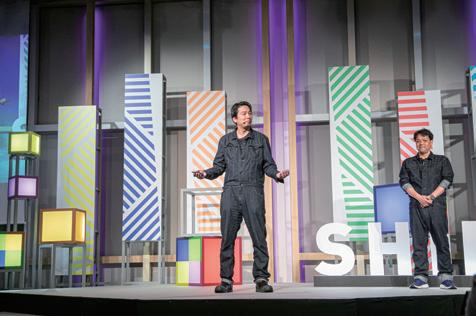



























The Group strives to be an organization with happy employees who work enthusiastically to achieve goals. In line with this, Sekisui House announced its Commitment to Human Resource Sustainability in March 2006. We identified the promotion of diversity as an important management issue, and separated it into three pillars: promoting the participation of women, utilizing diverse personnel, and promoting diverse workstyles. We respect the perspectives and values held by our individual employees. By respecting the perspectives and values of each employee and creating a comfortable work environment, we aim to enable our diverse workforce to maximize their performance and contribute to enhancing corporate value.
To promote the participation of women, we established the Diversity Development Team within the Corporate Management Planning Department, under the direct supervision of a representative director, in 2006. While proactively hiring female sales representatives, we also began awareness training, established the mentors programs, and created support networks.
To enable the success of diverse talent, in April 2006 we implemented systems to rehire employees who had resigned due to reasons such as childbirth, child-rearing, and nursing care; and to transfer workers from the general clerical job group to the sales and technology job groups. In April 2007, we began operating our personnel system in separate courses, such as design and technical; legal, finance, and accounting; and others, establishing a system that improved evaluation and treatment standards for human resources with diverse specialties.
To promote diverse workstyles, we expanded our childcare leave policy and our support systems for birth and childcare leave, modified working hours, shortened working time, and implemented cumulative annual leave systems starting in April 2006. We also created systems to help employees after leaves of absence and reduced the requirements for taking nursing care leave, building an environment conducive to various lifestyles.
Based on our Commitment to Human Resource Sustainability, we are building inclusive working environments and creating structures that allow our diverse employees to bring out their abilities regardless of lifestyle or life stage. Our Commitment to Human Resource Sustainability (Japanese only)
The Group has identified Diversity and Inclusion (D&I) as one of our key material issues, positioning it as an important aspect of our business strategy. D&I means respecting differences such as age, sex, nationality, values, sexual orientation, and disabilities in our organizations and workplaces, recognizing the individuality and ability of all employees while granting them equal work-related opportunities, and fostering the creation of an inclusive workplace environment and culture.
The Group believes that new value is created by practicing D&I and building new concepts and systems by bringing together diverse viewpoints and ideas. By creating an inclusive environment that respects individual identities, our employees will be able to work with peace of mind, leading to increased engagement and performance. The Group believes it is important to create conditions and environments where objectives and roles are clear, information is shared, mutual respect and trust are fostered, employees proactively participate and contribute, and organizations are leveraged effectively. Therefore, we promote the creation of workplaces where individual employees with different attributes, backgrounds, experiences, and abilities can bring out their diverse strengths in psychologically safe workplaces.
To the Group, D&I is a strategy for growth, and we further it by promoting initiatives with various focuses such as hiring and human resource development, improving workplace environments, and fostering workplace culture.
P.54 Diversity and Inclusion
Action Plan for the Promotion of Active Participation by Women
In February 2021, we set new targets for Sekisui House’s Action Plan for the Promotion of Active Participation by Women based on the Act on Promotion of Women’s Participation and Advancement in the Workplace. We set two major targets of “310 or more female managers¹” and “100%² take-up rate for eligible male employee childcare leave” (both by January 31, 2026 on a Group basis), and will continue making efforts to achieve these targets.
1 There were 346 female employees in managerial positions in FY2023 with the goal of raising that to 380 or more in FY2025.
2 100% means that all eligible employees with a child or children under the age of three (the limit under the Company’s rules and regulations) take childcare leave.
Sekisui House’s Action Plan for the Promotion of Active Participation by Women (Japanese only)
Established in 2006, the Diversity Development Team was reorganized as the Diversity Promotion Office in 2014 and as the Diversity and Inclusion Promotion Department in 2018. Its purpose is to develop Group-wide strategies and policies while managing KPI progress. In June 2020, we established the Social Improvement Subcommittee as part of the ESG Promotion Committee, an advisory body to the Board of Directors, with the Chief Manager of Diversity and Inclusion Promotion Department as its chairperson. This subcommittee includes the heads of relevant departments, who conduct regular discussions on strategies and policies related to diversity and inclusion. Policies discussed and improvement plans proposed by the Social Improvement Subcommittee are deliberated by the ESG Promotion Committee. The results are presented at Management Meetings or Board of Directors meetings, and Company-wide measures are implemented and managed. Since 2005, our top managers have made personal commitments to promote D&I, accelerating the Group-wide adoption of these concepts.
Since diverse values and perspectives are needed when building houses, the Group believes that the participation of women in all spheres of its business activities is crucial. Thus, the Group is focusing on the participation of women as a top management priority. To begin with, the ratio of female employees in the construction industry is low compared to other industries. Some reasons for this include male-dominated leadership, heavy workloads, lack of career advancement opportunities, and the working environment in general. The Group works seriously to solve these issues and, since 2005, has made efforts to actively recruit more women, provide suitable environments and career advancement support specific to different job types (sales representatives, technical personnel, etc.), and focused on development and retention, as well as training and appointment of female candidates to managerial positions. Through this, we are working to create a more inclusive workplace and corporate culture that allows women at all stages in their lives to actively participate. By the end of FY2023, the percentage of female employees was 29.4%, nearly twice that of the average in the construction industry.
Corporate
Interview and mentoring system
We conduct individual interviews and provide support and advice regarding worries in everyday life to young female employees.
Seminars and conferences
Career development and managerial position promotions
Position type conversion and internal recruitment program
Improvements in the workplace environment
Women-specific health challenges
Expanding career path opportunities
Expanding our support system for balancing work and life
Support for those rejoining the workforce or returning from leave
We support female employees coming back from maternity or childcare leave and do not hesitate to employ women wishing to return to work under the same circumstances. Social trends
We provide women in technical positions and female sales representatives with the opportunity to deepen connections, share information and establish their networks.
We conduct a twoyear training program for women who are candidates for managerial positions to foster management capabilities and problem-solving ability.
We provide opportunities for female employees to broaden the scope of their work duties and challenge themselves by testing out various career paths of their choosing.
We have designed uniforms to maternity specifications and made improvements to restrooms in response to the opinions of female employees.
We provide women-specific health checkups and are expanding leave and systems that allow for career continuation despite health challenges.
We support flexible work styles that allow women to change job types in response to life events and in accordance with different life stages.
We have introduced various systems that help employees balance child rearing, nursing care and medical treatment and that can be utilized regardless of gender.
Since diverse values and perspectives are needed when building houses, the Group believes that the participation of women in all spheres of its business activities is crucial. Thus, since 2005, the Group has worked to actively hire female sales representatives. The Group strives to eliminate any prejudice or bias in the hiring process and makes decisions based on individual ability and potential, regardless of gender. We also actively implement career seminars and disseminate information to middle, high school, and college students that will inspire them to pursue a career in the construction industry. In 2020, we set the goal of having female employees make up 30% of all sales representatives and 40% of all those in technical positions for Sekisui House (non-consolidated). For all new graduates hired in FY2023, women made up 27.7% and 38.4% of all hires for sales representative positions and technical positions, respectively.
We also actively work to hire women for mid-career positions and support them in creating career paths and developing leadership skills. Through this, we promote gender diversity as well as diversity among employees in decision-making roles. Women made up 29.5% (198 employees) of all mid-career hires in FY2023.
By the end of FY2023, there were 438 female sales representatives working for Sekisui House (non-consolidated) nationwide. Following our 2005 decision to actively recruit female sales representatives, we observed a high turnover rate among these female employees during their first three years of employment. To address this issue, in addition to on-the-job training, we introduced interviews with the Diversity and Inclusion Promotion Department for all female sales representatives during their first three years of employment. Through this, we provide close individualized support and work to identify problems faced by female sales representatives early and make improvements as necessary.
We have held an annual Nationwide Women’s Sales Representative Conference since 2007 with the goal of retaining and developing female sales representatives by providing them the opportunity to create a network that goes beyond their workplace. At this conference, female sales representatives from across the country gather together to receive performance awards, listen to talks by top management, watch case study presentations by top performers, network with various role models, and conduct group discussions. These activities contribute to skill enhancement, career development, and increased motivation among participants. Since FY2022, these conferences have been conducted in person at five different locations nationwide, with female area sales leads participating online.

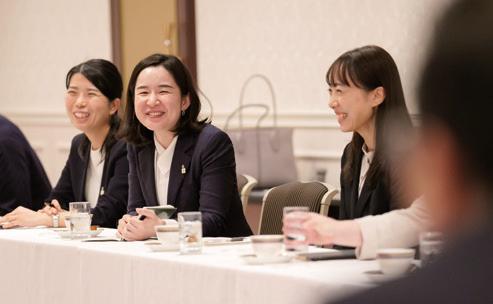
We have developed 10 positive action measures (five for retention and five for training) aimed at resolving the concerns and problems faced by female sales representatives. For retention, the Diversity and Inclusion Promotion Department works with each business headquarters in implementing assignment plans that take into account the retention environment from the time of employment. We have also established a mentoring system that aims to solve women-specific concerns, and created a support system that provides close support through interviews with female employees in their first three years with the Company. For development, with the focus on career advancement of female sales representatives, we hold the previously mentioned Nationwide Women’s Sales Representative Conference, attended by top management, senior managers and area sales leads, share information through the Women’s Sales Support Committee members, and hold seminars at different headquarters. In addition, the Diversity and Inclusion Promotion Department provides logistical support for the development of future leaders training, creating opportunities to deploy best practices nationwide.
Since diverse values and perspectives are needed when building houses, the Group believes that the participation of women in all spheres of its business activities is crucial. Thus, since 2005, the Group has worked to actively hire female sales representatives. The Group strives to eliminate any prejudice or bias in the hiring process and makes decisions based on individual ability and potential, regardless of gender. We also actively implement career seminars and disseminate information to middle, high school, and college students that will inspire them to pursue a career in the construction industry. In 2020, we set the goal of having female employees make up 30% of all sales representatives and 40% of all those in technical positions for Sekisui House (non-consolidated). For all new graduates hired in FY2023, women made up 27.7% and 38.4% of all hires for sales representative positions and technical positions, respectively.
We also actively work to hire women for mid-career positions and support them in creating career paths and developing leadership skills. Through this, we promote gender diversity as well as diversity among employees in decision-making roles. Women made up 29.5% (198 employees) of all mid-career hires in FY2023.
By the end of FY2023, there were 438 female sales representatives working for Sekisui House (non-consolidated) nationwide. Following our 2005 decision to actively recruit female sales representatives, we observed a high turnover rate among these female employees during their first three years of employment. To address this issue, in addition to on-the-job training, we introduced interviews with the Diversity and Inclusion Promotion Department for all female sales representatives during their first three years of employment. Through this, we provide close individualized support and work to identify problems faced by female sales representatives early and make improvements as necessary.
We have held an annual Nationwide Women’s Sales Representative Conference since 2007 with the goal of retaining and developing female sales representatives by providing them the opportunity to create a network that goes beyond their workplace. At this conference, female sales representatives from across the country gather together to receive performance awards, listen to talks by top management, watch case study presentations by top performers, network with various role models, and conduct group discussions. These activities contribute to skill enhancement, career development, and increased motivation among participants. Since FY2022, these conferences have been conducted in person at five different locations nationwide, with female area sales leads participating online.


We have developed 10 positive action measures (five for retention and five for training) aimed at resolving the concerns and problems faced by female sales representatives. For retention, the Diversity and Inclusion Promotion Department works with each business headquarters in implementing assignment plans that take into account the retention environment from the time of employment. We have also established a mentoring system that aims to solve women-specific concerns, and created a support system that provides close support through interviews with female employees in their first three years with the Company. For development, with the focus on career advancement of female sales representatives, we hold the previously mentioned Nationwide Women’s Sales Representative Conference, attended by top management, senior managers and area sales leads, share information through the Women’s Sales Support Committee members, and hold seminars at different headquarters. In addition, the Diversity and Inclusion Promotion Department provides logistical support for the development of future leaders training, creating opportunities to deploy best practices nationwide.
The Group has been hiring women for technical positions since before the implementation of the Equal Employment Opportunity Law. Our important themes regarding women in technical positions center on balancing child-rearing and strengthening professional expertise and leadership development. Thus, we support skill enhancement and the improvement of leadership capabilities by offering career development programs and specialized training aimed at the development of female employees in technical positions. We are also working to expand the pool of candidates for managerial positions by developing plans for young female employees in each job field.
We are promoting flexible workstyles, making it easy to balance work and life, as well as enhancing the workplace environment, with the goal of retaining female employees with specialized skills in technical positions. Currently, the number of female managers in technical positions is increasing in every department, leading to a more robust management layer. Moreover, in FY2023 we established the Support Committee for Women in Technical Positions within the Technical Executive Committee, which consists primarily of top technical managers from each area of the Company. We have also established a framework aimed at creating employee-friendly workplaces and fostering long-term career development for members of the aforementioned committee for each job field through initiatives such as career planning support and information sharing regarding the balance between child-rearing and work.
Since 2012, we have held the Female Designer Conference, aimed at the retention and development of female designers, and providing opportunity for these employees to come together from across Japan to discuss career development and tips related to balancing child-rearing and work. As of the end of FY2023, the percentage of women in designer positions exceeds 30%. Among these are women holding in-house certifications, including: 24 Chief Architects, who possess advanced design skills, four Platinum Specialists, with highly specialized design skills for elderly housing and welfare facilities, and 16 Structural Planning Specialists, with advanced skills in architectural structural design. We also promote the thoughtfully planned appointment, retention and development of female onsite supervisors. Since 2014, we have held the yearly
Company-wide Women’s Onsite Supervisor Meeting for women in such roles with the goal of sharing information regarding the workstyles of these female onsite supervisors who have diverse experiences and job responsibilities as well as expanding their networks. Through these meetings, information is provided on various systems and exchanged regarding topics of interest. Since 2015, we have held the Female Onsite Supervisor Support Program and are working towards improving workplace culture and communication.
To create a comfortable environment for all those working onsite, we have developed the Orihime toilet¹ and improved temporary toilets at construction sites, thus responding to employee needs and enhancing the workplace environment. We have created new construction and maternity uniforms based on the opinions of our female employees as well as a guide on working while pregnant for expecting mothers and those rearing children. By supporting the career continuation of female employees through initiatives such as information sharing between these employees and their managers, we are working to improve retention rates. Currently, we employ 116 female onsite supervisors with the number of female onsite supervisors in their twenties reaching about 30% as of the end of FY2023. Moreover, one woman has been appointed to the managerial position of site superintendent, two women have been appointed as assistant design directors, roles that support the corresponding manager, and nine women have been certified as Chief Constructors, an in-house certification program for onsite supervisors.
1 The city of Sendai and Sekisui House jointly developed a temporary portable toilet that is friendly to women and children based on the lessons learned from the Great East Japan Earthquake. The Orihime toilet was the winner of the Japan Toilet Award in 2015 and the Kids Design Award in 2014 and 2016. On the back of this success, we are working to make all temporary toilets more comfortable, including those for men.
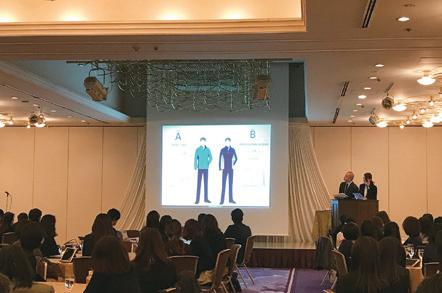

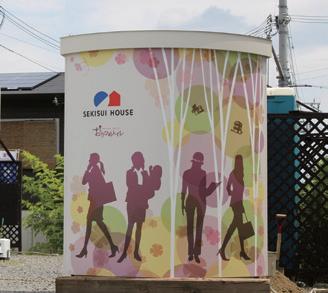


Sekisui House Remodeling, Ltd., which is in charge of our proprietary remodeling solutions for homes built by the Company, actively recruits women with families and experience in child-rearing. The number of female deputy office sales leads has been increasing due to the Leaders College, a development program aimed at promoting leading employees to higher positions. Additionally, we are actively working to promote diverse workstyles through initiatives such as allowing employees to choose a four- or five-day workweek. Sekisui House Remodeling, Ltd. has two female executives, 609 female sales representatives (58% of remodeling sales representatives), two female office sales leads, five female deputy office sales leads, and 81 female area sales leads as of the end of FY2023.
The Group’s action plan, based on the 2021 Act on Promotion of Women’s Participation and Advancement in the Workplace, sets the goal¹ of having at least 310 female employees in managerial positions by FY2025. The Sekisui House Women’s College, serving as training for managerial candidates, was inaugurated in 2014 as a pipeline for the appropriate promotion of women to such roles. The program, which lasts approximately two years, selects 20 employees each year based on self-endorsements or recommendations from their managers. The first year focuses on learning the essence of management through developing skills from a management perspective. In the second year, employees strengthen their problem-solving abilities through experiential learning to address workplace challenges. They also work to develop the proper management perspective and ability through on-the-job training and practical experience. At the end of the program, they present the results of their achievements regarding organizational challenges to management. This strengthens innovation organization-wide through a diversity of perspectives and approaches and also allows us to provide suitable training and promotions that match the individual goals of our employees.
Since the inaugural lecture in 2014, a representative director of the Board has personally conducted annual direct dialogues with employees in the program. Since 2018, a female outside director of the Board has also participated in these sessions, further increasing motivation among participants to advance into managerial positions.
1 There were 346 female employees in managerial positions in FY2023 with the goal of raising that to 380 or

Female employees in managerial positions in the Sekisui House Group increased from 114 in FY2015 to 342 in FY2023. For Sekisui House (non-consolidated) the increase was from 37 in FY2015 to 158 in FY2023. To support this growth, we established the Sekisui House Women’s College in 2014, which supports women in building career paths and creates an environment where they can freely exercise their leadership abilities. Of the 156 female employees who have graduated from the Sekisui House Women’s College, 98 are currently working in managerial positions. We also hold an annual conference for these graduates, providing networking opportunities, reflecting on the two-year curriculum, and confirming their career visions.
We are raising awareness internally through gender bias training for women, their managers and other colleagues in the workplace. We are also working to create an organizational culture that takes diversity and inclusion seriously as well as introducing flexible work arrangements. With the increase in role models, the motivation among female employees to take on managerial positions has increased. This motivation stems not from the directions of the Company but from a personal desire to challenge themselves.
We launched Sekisui House Construction Women’s College in 2020, and Sekisui House Remodeling Leaders College in 2022. Group companies are also involved in training aimed at female candidates for managerial positions.
Top management commits personally to actively promote the participation of women and regular discussions are held by the Board of Directors and at Management Meetings. Since committing to actively hire women in sales representative roles in 2005, the number of women in these roles has increased from 127 to 438 by the end of FY2023, and the number of women with experience as branch heads and area sales leads has also increased.
In FY2013, there was a 20% difference in the turnover rate between men and women for employees in their first three years with the Company, highlighting a problem regarding the female turnover rate. We analyzed the causes of this difference and worked to strengthen support systems and improve workplace environments to facilitate better career paths for women. Close individual support was provided through measures such as implementing a mentoring system led by employees responsible for developing young talent, conducting follow-up interviews with the Diversity and Inclusion Promotion Department for female employees in their first three years with the Company, taking appropriate measures regarding diverse workstyles, and holding conferences and seminars. Through these efforts, the turnover rate difference between men and women in their first three years disappeared in FY2018, and in FY2020, the turnover rate for men was higher.
We decide promotions based on fair evaluations that consider the employee’s individual goals, their abilities, and performance. Thus, we support the career advancement of women and actively work to promote leadership development. Moreover, we strive for transparency in the promotion and advancement of our female leaders, with the goal of providing equal access to opportunities for all employees. The number of women in managerial positions in the Group was 342 as of the end of FY2023, already surpassing our goal for FY2025 of 310. That being said, we are still aware of challenges regarding diversifying our leadership at the organizational level. Increasing the number of women responsible for organization-wide decision making will enable the Group to leverage a more diverse range of perspectives, experiences and values, leading to increased corporate value. Therefore, we will actively implement initiatives that maximize the abilities of diverse personnel, strengthen our competitive advantage, and continue promoting the participation of women throughout the Company.
Gender Wage Gap1, 2, 3, 4, 5 (FY2023)
(FY2023)
House, Ltd.
Sekisui House, Ltd. and Major Group companies6, 7
1 Calculated based on provisions of the Act on Promotion of Women’s Participation and Advancement in the Workplace (Act No. 64 of 2015)
2 The applicable period is the fiscal year under review (February 1, 2023–January 31, 2024).
3 Seconded employees are calculated as employees at the company they have been seconded to.
4 The breakdown of wages includes items such as base salary, remuneration for overtime work, and bonuses, while excluding commuting allowance.
5 Non-regular workers are temporary employees (rehired employees, contracted employees and part-timers). Figures for part-timers are calculated based on the wages actually paid and not converted into the equivalent for full-time employees.
6 When the fiscal year of a domestic consolidated subsidiary differs from that of Sekisui House, Ltd., figures are aggregated using each subsidiary’s respective fiscal year.
7 More information on the gender wage gap based on the Act on Promotion of Women’s Participation and Advancement in the Workplace for each domestic consolidated subsidiary is available in the Sekisui House ESG Data Book.
The gender wage gap for all of Sekisui House Ltd.’s workers is 55.2% and the gap for regular workers is 59.3%. The ratio of regular workers among total workers is around 90%. The ratio of main career track employees is over 70%, which has a significant impact on the gender wage gap. Therefore, the following details primarily concern main career track employees.
1. Wage Gap for each job grade
Wages for individuals in the same job grade are equal. The Company sets wage standards for each occupation and job grade. The gender gap in base monthly salary for main career track employees is as detailed below, but there is no gap within each job grade.
There are five job grades for regular employees (P5–P1).
2. Current initiatives and progress
We have been aware of issues related to promoting the participation of women in the workplace for the past 20 years. Since 2005, we have actively hired women for main career track positions, and established a specialized department, now the Diversity and Inclusion Promotion Department, to promote the development and retention of female employees. Additionally, we have improved various support systems such as enhancing flexible work arrangements to help employees balance work with child-rearing and nursing care. These initiatives have been successful, resulting in a 220% increase in the average years of service for women (4.6 years to 9.9 years), and a 120% increase for men (15.8 years to 19.7), from 2007 to 2023. The percentage of full-time
Changes in the Ratio of Full-Time Female Employees (FY2023 and every five years since FY2007)
Ratio of Full-Time Female Employees by Age Group in FY2023
female employees has also been growing by year: 16.1% in FY2007, 17.5% in FY2012, 20.8% in FY2017, 24.3% in FY2022, and 24.9% in FY2023. The breakdown of full-time female employees in FY2023 by age group is as follows: 38.5% in their 20s, 35.5% in their 30s, 23.5% in their 40s, and 12.2% in their 50s. This indicates an increasing ratio of younger female employees in their 20s and 30s.
3. Future outlook based on analyzing differences and successes
Since the average term of service for women and men in the main career track differs by about ten years (9.9 for women, 19.7 for men), the number of female candidates for managerial positions is small compared to their male counterparts. As a result, only 3.3% of the Company's managerial positions are held by women (as of January 31, 2024), revealing a significant gender gap in managerial positions. This gap contributes to differences in treatment between men and women and, therefore, also exacerbates wage differences.
To address this issue, we are implementing measures such as training programs for female managerial candidates, in addition to actively promoting female employees to managerial positions. We also revised our qualification and grading systems in 2022 and, since then, have conducted evaluations based on 9–10 indicators, creating a system where employees can become managers in as little as five years after joining the Company. Additionally, among the five job grades for regular employees set by the Company, P4 and P5 are considered future managerial position candidates. In FY2023, the number of female candidates for managerial positions was 507, making up 14.6% of the total. As the pool of female candidates for managerial positions among younger employees gradually increases, the ratio of female employees in managerial positions will also increase over time.
The ratio of non-standard wages (such as performance bonuses) to total wages is especially high for sales representatives and the ratio of women among sales representatives is low at 10%. This also factors into the wage discrepancies between men and women employees. However, we believe this wage gap will decrease as the ratios mentioned above improve.
The Company employs people with disabilities at business offices nationwide. As of the end of FY2023, the employment rate of people with disabilities at Sekisui House, Ltd. was 3.00% on a non-consolidated basis, and the rate at the 28 domestic Group companies legally mandated to hire people with disabilities (including the Company) was 2.97%, exceeding the legally mandated 2.5% (which was raised from 2.3% as of April 2024). We will continue to actively promote the employment of people with disabilities, aiming to achieve the legally mandated employment rate at each headquarters of Sekisui House, Ltd. (non-consolidated) and the legally mandated hiring figures for each Group company.
Since 2015, we have held annual diversity meet-and-greet events for employees with disabilities and their supervisors to establish a network that transcends departmental boundaries, build relationships that facilitate mutual communication and consultation, and improve our work environments. Following the previous year’s online format, we held a meet-and-greet event in December 2023, wherein any Group employee could participate, regardless of whether they have a disability, with 239 participants. In the first part of the event, participants, both with and without disabilities, were divided into five themes based on individual preference: “discussing the work environment,” “a society where people with and without disabilities can live together,” “about the Sekisui House Universal Design Service Handbook,” “important points for learning sign language,” and “how to succeed in the workplace with mental or developmental disabilities.” These participants then attended lectures and engaged in discussions based on their respective themes. The second part involved in-depth conversations among individuals with disabilities, grouped by type of disability.
At this year’s Human Relations Training, attended by all Group employees at each business office, the main theme was “a society where people with and without disabilities can live together,” in preparation for the April 2024 revisions to the Act for Eliminating Discrimination against Persons with Disabilities. Through this training, employees were able to deepen their understanding of both customer service and the workplace environment.
We have participated in the Accessibility Consortium of Enterprises (ACE) since its establishment in 2013. ACE was established to create an employment model for individuals with disabilities that contributes to corporate growth and provides society with the human resources needed by companies. As of March 2024, a total of 41 major companies have joined ACE. We are developing a variety of activities, including awards for exemplary activities, inter-company collaboration activities, internships, and career seminars for school officials and students with disabilities.
In October 2020, we became a member of The Valuable 500¹, an international initiative promoting the active participation of individuals with disabilities, and established three commitments.
Sekisui House Group’s Valuable 500 Commitment
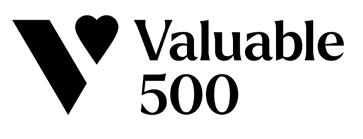
1 The Valuable 500 was launched at the World Economic Forum Annual Meeting held in Davos in 2019, based on the idea that inclusive business creates inclusive societies. 500 major companies around the world have joined in the initiative with the aim of sparking reforms by business leaders that enable persons with disabilities to unleash their potential value in business, society and the economy. The Sekisui House Group, which aims to become a leading company in ESG management, has endorsed the objectives of The Valuable 500 and established the following commitments.
Sekisui House previously had a mandatory retirement age set at 60 years old and a program for re-employing retired workers up to the age of 65. In April 2015, the retirement age was raised to 65 so all employees of the Group could work more enthusiastically, capably, and energetically for a longer period. Additionally, in April 2020 we introduced a post-retirement re-employment
program for employees aged 65 to 70 to support their active participation.
The Sekisui House Group strives to create a corporate culture that encourages all employees, with their diverse characteristics, to accept one another regardless of differences, thereby allowing everyone to reach their full potential. This initiative paves the way for building a society where all individuals can feel secure and free to work in their own manner. Since 2014, we have incorporated LGBTQ+-related themes into our annual Human Relations Training, continuing our education and discussions of the topic. In November 2019, a new system was established for registering opposite-sex common law marriages and same-sex partnerships, making these relationships eligible for benefits and protection under internal rules, equivalent to spouses in opposite-sex marriages. We additionally established a consultation desk exclusively for matters related to LGBTQ+. Furthermore, we hold regular seminars and events, and the number of allies who understand and support this community is increasing within the Company. In March 2023, we established the Sekisui House Ally Circle (S-Ally Circle), an internal community for information exchange and networking. Our initiatives aimed at customers and suppliers include updating gender and spouse entry columns on forms as well as conducting training for rental brokerage sales and affiliated distributors.
In recognition of these efforts, we became the first major housing manufacturer to receive the Gold certification in the PRIDE Index for six consecutive years. The PRIDE Index is Japan’s first index for evaluating corporate efforts concerning the LGBTQ+ community. Formulated in 2016 by a private organization, work with Pride, the objective of the PRIDE Index is to create a workplace where sexual minorities, such as LGBTQ+ individuals, can work with pride. We were certified as Silver in 2016 and 2017, and Gold from 2018 to 2023. For the last two consecutive years, we have also acquired the Rainbow Certification, which was added to the existing PRIDE Index in 2021 and is available only to companies awarded Gold. The Rainbow certification encourages companies to make medium- to long-term commitments to build communities and workplaces where LGBTQ+ individuals can work openly.
Promoting Diverse Workstyles
The Group aims to revitalize communication by reforming its work environment, upgrading the ICT infrastructure, and optimizing systems and rules. To ensure that each person can work to their fullest potential, we promote diverse working styles that allow for flexibility and autonomy, free from constraints of time and place.
In promoting diverse workstyles, it is crucial to eliminate long working hours and create an environment where everyone can work enthusiastically. Thus, after examining the Company’s working hours situation, we began by implementing initiatives focused on compliance with hours established in the “three-six agreement” under provisions set forth in the Labor Standards Act. Accordingly, we have worked to improve and preserve employee health through initiatives such as decreasing overtime hours under the Industrial Safety and Health Act. Since FY2021, average monthly employee work hours have been used as an ESG management indicator to calculate Performance Share Units (PSU), a form of compensation for directors of the Board (excluding outside directors). Setting this KPI as 175 monthly average working hours per person is propelling us towards a reduction in total working hours.
We have set targets for annual leave usage rate and days used of 70% and 14 days, respectively, and encourage planned leave-taking. Additionally, we are promoting autonomous workstyles through the introduction of various systems that reduce restrictions on where and when employees work. Particularly for those employees facing time restrictions due to child-rearing and nursing care, we must have systems that enable them to work with peace of mind while balancing work and life without compromising their careers.
Furthermore, starting from March 2023, regardless of years of employment, all employees are immediately granted 20 annual days of paid time off. (Employees previously acquired additional paid leave with each year of tenure until reaching a maximum of 20 days under the conventional paid leave system in Japan.) This initiative is part of our support for employees to realize healthy and autonomous workstyles while finding balance in their professional and personal lives. The annual paid leave usage rate for the Group¹ in FY2023 was 80.3%.
Since April 2018, to encourage work-life balance and efficiency while maintaining standard working hours, we have promoted flexible workstyles that allow individuals to adjust their start time in 15-minute intervals between 7:00 a.m. and 11:00 a.m. Each employee is mindful of their working hours and actively engages in discussions with their supervisors to make the most of this system.
Starting in February 2017, we implemented our Work-from-Home System to allow employees who need flexible working hours due to matters such as child-rearing to actively contribute more effectively. The temporary implementation of a Company-wide remote work initiative due to the COVID-19 pandemic made working from home and even mobile work a possibility for all employees. Employees are now able to choose their work locations accordingly. Although the standard number of days one can work from home per month is seven, it can be increased to eight or more under special circumstances.
We have introduced various programs that can be utilized by both men and women to help employees balance work with child-rearing and nursing care.
Employees who care for children up to the third grade of elementary school can apply for a reduction in their standard working hours. This can be set for each day of the week, up to two hours per day, in 15-minute increments. Additionally, until their children enter sixth grade, these employees are permitted to adopt a sliding work schedule, enabling them to start or end their work day earlier or later between 7:00 a.m. and 8:00 p.m., provided they work the standard number of hours.
For employees who are planning to enroll their child into a childcare facility within one year after birth, we provide individual support from pregnancy to the decision on a facility by providing information on activities, expertise, and childcare-related topics according to the individual’s circumstances, such as the child’s birthday and their place of residence.
Employees can take paid leave of five days per year (10 days for two or more care recipients) on an hourly basis (legally permissible in half-day increments) to care for their children when they are sick or to provide nursing care for other family members.
Outside of our existing systems for child-rearing and nursing care, we support career continuation for employees with children under the age of 18 who require additional attention due to medical conditions or absence from school. We allow these employees to take leave for up to two years, shorten their working hours or working days, and utilize other similar measures.
We support employees undergoing cancer or infertility treatment in balancing such treatment with work by enabling the use of programs to shorten standard working hours and/or days, change working hours and make other similar arrangements. Furthermore, we are always open to consulting with employees regarding working arrangements for those suffering from other illnesses, injuries, or disabilities.
The Group emphasizes fair and objective employee evaluations. Accordingly, since FY2010, we have been sharing evaluation results with employees and conducting interviews to discuss individual strengths and areas for improvement. Additionally, in FY2021, we revised our evaluation system in alignment with the introduction of our new personnel system. Evaluations are conducted from two perspectives: an ability/behavior review and a performance review. The primary aim is to appropriately assess each employee’s abilities and achievements, while also maintaining their motivation to continue working. In the ability/ behavior review, we evaluate the employees’ abilities, knowledge, and skills; motivation and attitudes; and the resulting concrete behaviors. In the performance review, we assess the process used to achieve final results using management by objectives (MBO), as well as the resulting performance.
In addition to quantitative results, our new evaluation system incorporates qualitative assessments such as the willingness to take on new challenges, the level of contribution, and demonstrated creative abilities. This approach enables a more comprehensive evaluation of each employee. Furthermore, we have established certification criteria and competency standards for specialists who contribute to the Company through their high degree of expertise. This clarifies our ideals and expectations for each specific job position. Evaluations are conducted following careful deliberation and scrutiny through multi-perspective discussions among evaluators. Opportunities for promotion and remuneration are then offered based on fair evaluations that reflect each individual's achievements, regardless of their tenure or age, in relation to their fulfillment of requisite abilities and roles.
Evaluation results are reflected in promotions, pay raises, and retirement allowances through the ability/behavior review, and in performance bonuses through the performance review. Additionally, the sales divisions are provided with monthly performance allowances based on individual performance. To ensure the appropriate implementation of the new evaluation system introduced in FY2021, and to enable employees to properly demonstrate their individuality and abilities, we have established e-learning modules for all evaluators and evaluatees. This initiative enhances understanding of goal setting, evaluations, and feedback.
Evaluate
Risk management regarding engagement
We conduct an annual Governance Awareness Survey for all domestic Group employees to monitor current conditions within the Group regarding our corporate philosophy, code of conduct, vision and strategy, employee autonomy, workplace culture, and compliance. Based on the survey results, we encourage department heads to identify and resolve issues in their departments, and to reflect organization-wide issues in Company policies and training programs, working to retain human capital by improving employee engagement. Key initiatives in FY2023 were as follows.
(1) We established certification criteria and competency standards for specialists (SP positions) who contribute to the Company through their high degree of expertise and clarified our ideals and expected roles for such positions.
(2) We conducted MBO e-learning for evaluators and evaluatees. Participants learned how to set goals to achieve growth through their work, handle evaluation results, and use those results in the future. Sharing growth challenges through mutual communication will lead to more understandable and transparent grading, resulting in higher motivation, personal growth, and organizational success.
The development of human resources is one of the items included in the workplace culture category of the Governance Awareness Survey. This item measures whether our workplace culture fosters the development of human resources by confirming various measures such as whether evaluations are clear, interviews are conducted thoroughly, and feedback is provided in a timely manner. As an example, the score for development of human resources increased from 71.1 points in FY2010 to 77.9 points in FY2023 for Sekisui House branch stores, showing that our fair evaluation system is steadily improving.
Promoting Diverse Workstyles
Establishing a workplace culture that provides peace of mind and safety based on a relationship of trust is crucial in promoting diverse workstyles and building strong relationships between supervisors and team members. This commitment is evident in our personnel measures, which include holding career interviews five times per year.
The Group’s career interviews are characterized by listening carefully to the opinions of our employees. During these interviews, employees openly discuss the challenges they face, their strengths, accomplishments, and goals, with supervisors listening and responding thoughtfully. This practice extends beyond a top-down work progress check; it is an opportunity for employees to clarify their personal goals and articulate their career plans. Supervisors take the opinions and wishes of employees seriously, and after thoroughly understanding each individual’s situation, they provide appropriate advice and pose relevant questions, thereby encouraging behavioral change and growth. These career interviews facilitate open dialogue between supervisors and employees, contributing to the creation of a psychologically safe workplace through trust and effective communication. Furthermore, they enable employees to collaborate in identifying solutions to problems, thereby enhancing employee engagement and overall organizational performance.
The Group conducts an awareness survey biannually for supervisors and team members who participate in these career interviews. The analyzed survey results are shared with employees, along with best practices and techniques for optimizing the career interviews.
Survey results for the second half of FY2023 indicate a career interview satisfaction rate of 7.2 out of 10, an increase of 0.2 from the first half’s results. Additionally, 43.6% of employees felt that their supervisor listened attentively to their concerns (up 4.1% from the first half’s results) and 37.6% felt that their supervisors appropriately acknowledged their strengths (up 3.8% from the first half’s results).
We also provide opportunities for supervisors to enhance their coaching and listening skills. Through these interview skill-related improvements, we strive to foster thorough communication and relationships of trust between supervisors and team members.
As an initiative to help employees take ownership of and internalize ESG considerations, the Group has been conducting ESG dialogues since October 2020. These dialogues are conducted in groups of four to five, regardless of position or job titles, on a theme selected independently by employees. These ESG dialogues emphasize “dialogue,” rather than “debate.” Instead of opposing viewpoints and debating on a single theme, dialogue based on common goals and values is conducted, encouraging mutual respect and positive acceptance of different standpoints and perspectives. To ensure that all opinions are properly considered, we create a calm atmosphere where employees can candidly express their thoughts and opinions in their own words.
Furthermore, with the goal of having each employee take independent and proactive actions based on insights gained from these dialogues, employees are encouraged to propose and lead dialogues on themes that interest them. Through these initiatives, we are creating a workplace culture that ensures psychological safety by fostering an environment where employees can freely express themselves.
We believe that leaders play a crucial role in creating workplace environments where diverse workstyles are possible. Thus, we held forums on successfully balancing work and child-rearing for relevant employees and their supervisors from 2015 to 2021. This forum was transformed into the Diversity Management Forum in 2022, and is now offered to all leaders (primary evaluators¹). Through this change, it has become a training program for developing leaders who promote the participation, work-life balance, and flexible workstyles of employees.
This forum supports these leaders by presenting a diversity of challenges not only related to child-rearing but also nursing care and medical treatment. The creation of a psychologically safe workplace is linked to the development of leaders who can leverage the talents of our diverse employees.
The annual Well-Being Survey for all employees includes a section on workplace happiness covering the “willingness to recommend current workplace,” “atmosphere of workplace trust,” and “culture of safety and security.” We verify the progress and outcomes of promoting diverse workstyles through these indicators.
Caring for Our Employees’ Well-Being
In September 2018, the Group launched a male employee childcare leave program to encourage male employees with a child or children under the age of three to take one or more months off work to focus on childcare¹. The leave is paid for the first month for all employees, reducing financial concerns for them and their families. To accommodate individual circumstances, leave can be divided into as many as four increments as needed until the child reaches their third birthday. This not only supports employees immediately after childbirth, but also allows for a variety of childcare leave patterns, enabling fathers to coordinate their schedules while their partners reacclimate to work during the nursing period.
Since February 2019, when full-scale operation was implemented, all of Sekisui House’s 1,933 male employees, whose children reached their third birthday (the deadline for taking childcare leave) by January 2024, have taken at least one month of childcare leave, maintaining a 100% take-up rate. We have also maintained this rate of 100% across all Group companies since 2021. Additionally, the rate of spousal satisfaction with male employees who took childcare leave has grown to 96.8%², proving that this program contributes to the happiness of families.
1 In the childcare leave system in Japan, in principle, employees may take leave for one year until their child reaches one year of age, during which time childcare leave benefits are paid. In addition, we allow employees to take childcare leave, which is paid for the first month, until their children turn three years old.
2 From the answers of partners on our post-childcare leave survey
Starting in April 2021, we implemented a more flexible program for taking childcare leave. There were numerous requests from partners in our post-leave survey indicating a need for more flexible leave options. Because of this, and recognizing the importance of husbands staying close to their wives during the critical eight weeks after childbirth―a period of significant physical and mental strain for mothers, with a high risk of developing postpartum depression―we aimed to facilitate this supportive presence. Thus, we expanded the program to allow husbands to take leave more flexibly, including options such as taking leave in one-day increments as many times as necessary.
To improve the quality of childcare leave, we developed the Family Meeting Sheet to facilitate communication between spouses on issues such as determining when to take the leave, the purpose of the leave, how to share childcare and housework during the period of leave, and other typical family challenges. The sheet is available on our website for use by anyone, not just Group employees.

To encourage the taking of paternity leave, we published examples from employees, their families, and supervisors online. In 2020, we released the Paternity Leave Guidebook to consolidate information related to paternity leave. Since 2015, we have also held annual forums on balancing work and child-rearing, initially catering to female employees raising children and their supervisors. This initiative was expanded in 2018 to include male employees raising children. In 2022, we revised the Diversity Management Forum, attended by all leaders (primary evaluators⁴), to address not only child-rearing but also nursing care and medical treatment, as we strive to create work environments inclusive of all circumstances.
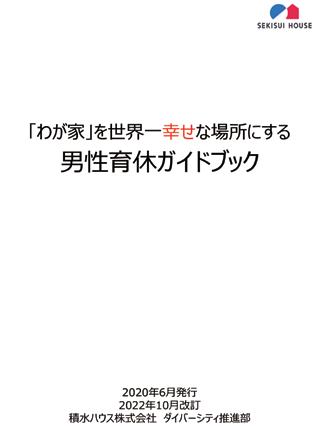
4 Supervisors whose priority is providing consultations on flexible workstyles for achieving a work-life balance
We have created a tool for workplace communication among those who take childcare leave, known as the “Paternity Leave Planner.” This tool allows employees to coordinate the leave periods determined in the Family Meeting Sheet and discuss who will cover their work duties with their supervisors. This planner also includes a column for partners to sign. This allows the document to be used to receive approval from employees, supervisors, and families, ensuring approval and anticipation of childcare leave.
In 2019, we designated September 19 as Childcare Leave Awareness Day. Since then, we have been hosting the annual Paternity Leave Forum on that date to promote awareness of paternity leave in business, government, and education. We have also been issuing the White Paper on Paternity Leave to help make paternity leave the norm in society. Starting with the fourth forum in 2022, we began inviting companies and organizations that share our vision of making paternity leave the norm in Japan. In 2023, the fifth year, we shared information together with 119 companies and organizations that support our initiatives. We believe that encouraging paternity leave will help address social issues such as promoting women's participation and tackling declining birth rates.
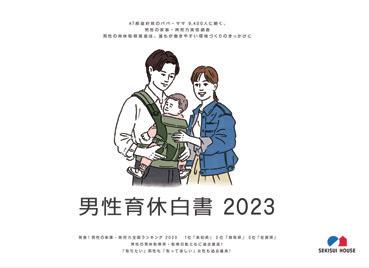
The Group seeks to support both the physical and psychological health of our employees. We strive for employee happiness at the workplace and in daily life, promoting fulfilling lifestyles through Happiness Health Management.
The ESG Promotion Committee, under the Board of Directors, promotes methods related to Happiness Health Management based on approved fiscal year targets and plans. Happiness Health Working Groups in relevant Company departments, such as the Human Resources and General Affairs Department and the Diversity and Inclusion Promotion Department, formulate Company-wide policies, promote each individual measure, and verify their effectiveness. These groups cooperate with health insurance unions and external advisors, strengthening cooperation among all business offices and promoting employee awareness.
For five consecutive years since 2020, the Sekisui House Group has been selected by Nippon Kenko Kaigi as a Health and Productivity Management Outstanding Organization (White 500).
We utilize the results of our employees’ medical checkups to encourage them to improve their lifestyle habits, using indicators such as exercise, diet, sleep and smoking rate to recognize urgent health issues and prevent lifestyle-related diseases. Furthermore, to maintain mental health and improve levels of happiness, we set indicators for initiatives related to improving mental health and viewing health subjectively, using these to promote happy lifestyles.
To realize happiness and health in mind and body, we have set the following five goals: . Reducing the number of employees at risk of lifestyle-related diseases (including metabolic syndrome and pre-metabolic syndrome risk), . Reducing the percentage of smokers, Boosting the happiness of employees and workplaces, Improving productivity (reducing presenteeism), and . Preventing mental disorders (decreasing long-term absenteeism and leave-taking). We have also established indicators based on the rate of employees opting for secondary medical checkups and average employee total working time per month.
In June 2021, employee volunteers created the Health Project and started the Happiness Health Challenge 6 as a way to support employee happiness and enhance their health. Using an AI-based service that utilizes medical checkup results and Well-Being Surveys, employees register a personal My Happiness Health Declaration based on individual issues. 21,852 people, including top management, had registered by the end of March 2024. We also hold regular seminars and events, allowing employees to proactively engage in activities chosen from six fields, as we strive to build consciousness and desire for improvement in happiness and health. We have held 50 seminars since February 2022, with total participants growing to 17,959 people by the end of FY2023.
In addition to this, we launched the Walking Challenge in February 2019, with the goal of encouraging healthy lifestyle habits through regular exercise. 21,163 people joined in FY2023, with an average daily step count of 6,652. The program not only builds health consciousness, but also strengthens interactions and teamwork among employees. The Happiness Health Working Group has been spearheading and promoting these initiatives since August 2023.
Who Chose What for the Challenge 6 Initiative
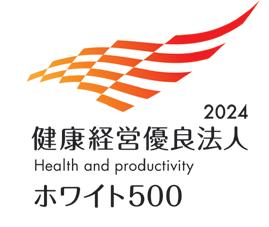
Since November 2020, the Group has conducted the Well-Being Survey for all employees in pursuit of their individual happiness. Under the supervision of Professor Takashi Maeno, a professor of System Design and Management at Keio University Graduate School, dean and professor at the Department of Well-Being at Musashino University, and a leading expert in business administration focused on employee well-being, we became the first company in Japan to undertake and analyze the multilateral measurement of employee and workplace well-being.
The Well-Being Survey consists of 72 questions related to an individual’s happiness, known as the “Well-Being Circle,” and 42 questions related to workplace happiness, known as the “Worker’s Happiness and Unhappiness Diagnosis.” The results of the Well-Being Circle are quantitatively measured across 34 items in 11 categories, and in the Worker’s Happiness and Unhappiness Diagnosis across 14 items in 12 categories. By using this method to visualize well-being, we can connect the survey’s results to concrete plans toward pursuing happiness for individual employees.
The total value of our employees’ Well-Being Circle was higher than the nationwide average each year for all four of our survey results since 2020, trending upward each year. The total value for FY2023 of 65.98 points was 3.06 points higher than the nationwide average.
We were rated much higher than the nationwide average in the categories of Well-Being and Gratitude according to the FY2023 survey. Our high Gratitude score reveals the successful promotion and implementation of our fundamental Corporate Philosophy of “Love of Humanity.” We were also notably higher than the nationwide average for the willingness of employees to recommend their workplaces to others, showing the faith our employees have in their workplaces as well as in our products and services. We believe this result comes from deepened employee understanding regarding the performance of our products and services due to internally sharing exemplary initiatives, business reforms, and new product developments from the performance category of our Sekisui House Innovation & Performance (SHIP) Awards.
The issues of overwork as well as the heavily correlated feelings of being subjected to unfairness were first noted in FY2022. These issues have been improving due to the continuation of ESG dialogues and career interviews, both being conversations that revolve around interpersonal communication, as well as the implementation of training related to these dialogues and interviews.¹
1 The survey results indicate that items highly correlated with overwork are more related to feelings of unfairness as opposed to long working hours. Therefore, lower scores on these items reflect higher employee well-being.
We added questions to the FY2023 survey related to employee autonomy, a crucial measure for increasing the Group‘s human capital value. The results revealed the strong relationship between employee autonomy and happiness.
An individual’s results on the Well-Being Survey are shared only with them, whereas Group-wide results and those of affiliated offices are shared with employees via the intranet. We hold group discussions that include comparisons to past years and the results of the Well-Being Survey to help each employee with individual and workplace well-being.
Discussions on Well-Being
We hold discussions in small groups of 4-5 people on the individual and workplace happiness of each employee based on the results of the Well-Being Survey. 15,756 employees attended ESG dialogues exploring happiness in FY2023.
Guided by the strong aspirations of branch heads, our branches have continuously implemented training and workshops since November 2020. Focusing on the Thank you! (connection and gratitude) factor of happiness, employees utilize a platform where they can exchange praises for one another, improving the well-being of individuals and workplaces. Business offices with high well-being and those that increased their well-being scores were also shared on the intranet.
The Group places importance on nurturing leaders capable of promoting and implementing our Corporate Philosophy and strategies, and is therefore undertaking initiatives aimed at developing future leaders who can creatively respond to change and drive innovation.
Since October 2019, the SHINE! Challenge Program (Sekisui House Innovators and Entrepreneurs Challenge Program) has trained future business leader candidates under the age of 35. As of FY2023, 60 participants have completed the course. In FY2023, during the program’s fifth term, 18 new leader candidates were selected to learn leadership skills and abilities, as well as issue identification and project design skills through the approximately nine-month specialized program. By offering employees the opportunity to develop their qualities as business leaders through this program, we are building our leadership pipeline.
We have held the Keiei-juku management training program since 2018 to develop future candidates for important positions and roles. We identify potential top management candidates and provide opportunities for them to advance their skills and experience by nurturing insight, character, management skills, and leadership. Through a series of ten lectures, assessments, and presentations to top management, participants gain experience in independently considering the direction of organizational management. As of the fifth term in FY2023, there have been a total of 184 participants in the program.
Sekisui House conducts various training courses for management-level employees. Training for new managers is divided into sections: risk management, career interview training, evaluation training, and problem-solving reinforcement. This encourages managers to acquire skills and knowledge in each area. We also conduct integrity management training for newly appointed branch heads and general managers, aimed at strengthening the management and human resource development capabilities of every branch and team, as well as revitalizing the organization.
Since 2021, we have held the Succession Plan Council to identify candidates for executive officers, operating officers, and others in key positions. The council aims to deliberate the nomination of these candidates in a highly transparent manner from a diverse, Company-wide perspective. Specifically, the council prepares individual training plans for all candidates, conducts periodic progress checks to further enhance our leadership pipeline, and monitors the succession readiness rate.¹ We expanded this plan to several companies in 2023. 1 Succession readiness rate = (number of candidates ÷ number of leadership positions) × 100
Alignment of Efforts
Based on the outlook for future business, we make and execute strategic recruitment plans while considering data related to increases and decreases in personnel. Regarding the human capital required for future business promotion (e.g., DX talent), we aim to create a system that allows us to compile pipeline information inside and outside the Company and promotes business proposals from the Personnel Department.
In February 2021, we introduced a talent management system that allows each employee to see a real-time visual representation of their goals and skill levels. For transfers and development, we have built a dashboard in the talent management system that allows organizational leaders to check the status of their organizations at a glance, and have established a data environment that is useful for decision-making. The introduction of this shared system among Group companies contributes to maximizing the abilities of our human resources and allows us to centrally manage personnel information for over 27,000 employees.
We revamped our internal job posting program in September 2022 to better support our employees in realizing their desired careers. This program is applicable to a wide range of positions, including those at Group companies. Employees apply based on their own preferences, go through a selection process, and then transfer to new positions. This process provides an environment that allows each employee to showcase their individual abilities. To encourage self-directed career development and to respond flexibly to changes in management environments, business strategies, and organizational structure, we aim to place the right person in the right role throughout the entire Group.
We clearly state the personnel sought and required skills on the Company intranet when internally recruiting. Additionally, we ensure all employees are aware of available positions through emails from our secretariat. We have also made it possible for employees to view the business activities of each Group company as well as departments in the head office through each department’s homepage on the Company intranet.
In FY2023, 294 employees applied for 26 positions, resulting in 58 internal transfers.
To support self-directed career development and strengthen the leadership pipeline, we manage a human capital database through our centralized talent management system. In addition to performance evaluations, career ambitions, multi-rater assessments, and the results of external assessments, we store information such as records on career interviews and skills. This data is used in succession planning and human capital management meetings for appointing directors and officers. Consequently, we have improved conditions, enabling upper and middle management to make data-based decisions. When recruiting new graduates, we analyze and extract the requirements for outstanding employees and, after careful deliberation, hire those who meet these requirements. This approach helps us acquire talents with great potential. In selective training after employees join the Company, we use various types of human capital data, including aptitude tests, to select employees.

In recent years, the effects of global warming-induced climate change have started to visibly impact our lives through increasingly frequent and serious natural disasters. Furthermore, overproduction and overconsumption are accelerating biodiversity loss and resource depletion, sounding the alarm on the sustainability of the relationship between humanity and the planet. As an industry that relies heavily on energy and natural capital and therefore has various impacts on the environment, the housing industry has an increasing role to play in all of this.
Before these visible effects, we announced our Environmental Future Plan in 1999. Since then, the Sekisui House Group has remained committed to mitigating its environmental impact from production to disposal, concentrating on three major themes—climate change, biodiversity and resource recycling. We are also spearheading innovative and effective
Leveraging diverse values to create a positive impact over the ne xt 30 years
appealing to major suppliers to adopt science-based targets (SBT). In addition, we participate in international initiatives such as SBT, RE100 and the Global Alliance for Buildings and Construction (GlobalABC). We actively work to disclose information in line with the TCFD/TNFD framework and we aim to lead the way in implementing the global commitment to reducing negative impacts on the environment in Japan.
The Group has consistently advanced high-impact initiatives in the housing industry that have produced an array of positive outcomes. Nevertheless, addressing increasingly severe social issues such as climate change requires a wider perspective and stronger driving force. Looking forward to our milestone year of 2050, set forth in our Sustainability Vision, we will work alongside diverse stakeholders to define the future of our housing business, drive even greater innovation, and create meaningful impacts.
Sustainability Vision 2050
Yuki Isaka Chairperson of the Environmental Subcommittee, Operating Officer, Head of the Environment Improving Department
initiatives such as the commercialization and construction of ZEH detached houses; implementation of the Gohon no Ki Project, which involves planting primarily native species to create ecosystems in customers’ gardens during home construction; recycling 100% of waste generated from construction sites for newly built houses, remodeling jobs and factories; and the development of a foundation for the utilization of housing stock. Through our pioneering efforts in the industry, we have set the standard for environmental technologies in Japan.
To advance decarbonization efforts, we are expanding ZEH to our rental and condominium businesses, offering sustainable living choices to a wider range of customers. We are taking similarly minded actions through the utilization of renewable energy from Sekisui House Owner Denki; the electrification of Company vehicles, factory equipment and facilities; and
Decarbonization
Disclosure in Line with Task Force on Climate-related Financial Disclosures (TCFD) Recommendations
Promoting ZEH through Green First ZERO detached houses
Spread of ZEH-M rental housing with the entire building meeting ZEH standards
Promotion of ZEB for non-residential construction
Sekisui House Owner Denki
Supply chain decarbonization
Biodiversity Conservation
Wood procurement
The Gohon no Ki Project
Disclosure in Line with the Taskforce on Nature-related Financial Disclosures (TNFD) Draft Recommended Disclosure
Resource recycling
Sekisui House Zero Emissions system
Initiatives to Realize a Circular Economy
The Sekisui House Group’s environmental strategy kicked off in 1982 with the strategic launch of a passive solar house. Then, in 1999, we announced the Environmental Future Plan as the cornerstone of our environmental strategy that lays out our goals and fundamental policy for environmental initiatives. Ever since, we have been conducting various initiatives to effectively reduce the impact of our business activities on the global environment. In particular, we have prioritized the promotion of energysaving housing as a core measure to help prevent global warming. This effort began
by making double-glazed windows a standard feature, progressed to the standard adoption of high-efficiency thermal insulation and water heaters, and included the launch of sales of Green First houses with solar cells and fuel cells. Then, in 2013, we were among the first in the industry to begin sales of net zero energy houses (ZEH).
In our business activities across the broader value chain, we were the first in the Japanese construction industry to join RE100 in 2017; then we announced our participation in the SBT Initiative in 2018. We still work continuously to achieve the targets set under these initiatives. We have also endorsed the TCFD recommendations and conduct disclosure in accordance with them. To advance biodiversity conservation,
since 2001 we have been conducting the Gohon no Ki Project to promote the use of native species in landscaping and greening. Other efforts not directly related to climate change include proactive initiatives to promote biodiversity and resource recycling. In 2023, we disclosed information in line with the TNFD framework recommendations and have since been investigating our dependence and impact on natural capital, focusing on wood procurement, a key resource in housing.
Since 1999, the Sekisui House Group has remained fully committed to advancing our environmental strategy by integrating the resolution of environmental issues into our business activities.
the Sixth Mid-Term Management Plan

Issued the Declaration of Sustainability
Announced Our Eco-First Promise and 2050 Vision
Shifted management focus to decarbonization
Joined the RE100 initiative First company in Japan’s construction industry to join
Received validation from SBT Initiative
Launched Green First eco-friendly homes
the TNFD Forum
Endorsed the TCFD Recommendations
Quantitative evaluation of contribution to biodiversity of the Gohon no Ki Project
Kunming-Montreal Global Biodiversity Framework adopted 15th Conference of the Parties to the Convention on Biological Diversity (COP15)
Processes, controls and procedures for addressing environmental issues, and commitment to reducing environmental impact
The Sekisui House Group has established the ESG Promotion Committee as a consultative body to the Board of Directors to determine and implement action policies while confirming that all ESG management initiatives are reasonable and in line with societal expectations. The committee meets once every three months. Addressing environmental issues—including contributing to decarbonization, biodiversity conservation, realizing a circular economy and water security— is one of the key issues discussed by the committee. The committee evaluates the appropriateness of action policies and progress, and reports important matters to the Board of Directors.
The Company-wide, cross-departmental Environmental Subcommittee reports to the ESG Promotion Committee. Mainly composed of head office department heads involved in environmental management and individuals in charge of environmental management in business divisions Group-wide, this subcommittee meets as needed to conduct more specific and detailed discussions. In addition, the Environmental Subcommittee broadly disseminates the decisions of the ESG Promotion Committee for adoption throughout the Group. The ESG Promotion Committee ensures effective, timely management oversight by providing the director of the Board responsible for each business and other managers with routine reports and instructions on the implementation of ESG initiatives.
In addition, the committee sets goals for reducing environmental impact in response to new issues and works to achieve them.
As part of their production process management, five domestic factories that manufacture and ship industrialized housing materials have acquired ISO 14001 certification: the Tohoku, Kanto, Shizuoka, Hyogo and Yamaguchi Factories.
One overseas factory, the Ingleburn Manufacturing and Quality Control Centre in Australia, has acquired the certification as well. ISO 14001 is the international standard for environmental management systems. We are continuing the operation of these systems, and 100% of our production facilities are certified.
Working to realize its global vision to make home the happiest place in the world, the Sekisui House Group aims to be a leader in ESG management that solves social issues and builds a sustainable society by promoting environmental strategies that are both advanced and have significant knock-on effects. To this end, under Sustainability Vision 2050, our long-term vision for 2050, we have set out the goals of Leading the Way to Decarbonization, Leading the Way to a Society in Which Humans and Nature Coexist, Leading the Way to a Resource-Recycling Society, Leading the Way to an Advanced, Healthy, and Long-lived Society, and Leading the Way to a Diverse Society. Under each of these, we have established targets and are advancing concrete initiatives toward their achievement. The Sekisui House Group’s environmental strategy is characterized by its integration with the Group’s business. Since the announcement of its Environmental Future Plan in 1999, Sekisui House has made the position of environmental measures within its business activities clear. We have advanced a variety of environmental initiatives, driving such efforts within the housing industry while gaining the support of all stakeholders, including customers and the supply chain, as we expand the range and scale of our business. In this way, we seek to exert a substantial positive effect on a variety of environmental issues—such as global warming prevention, biodiversity conservation and realizing a circular economy—while achieving business growth.
Sekisui House established the Sustainability Vision 2050 in 2016 and updated it in 2017, laying out a unified vision that encompasses the NEXT SEKISUI HOUSE 30-year Vision, which is our management policy, and initiatives to address the five material issues, which comprise our ESG management policy.
Sustainability Vision 2050 comprises five specific visions: Leading the Way to Decarbonization, Leading the Way to a Society in Which Humans and Nature Coexist, Leading the Way to a Resource-Recycling Society, Leading the Way to an Advanced, Healthy and Long-lived Society, and Leading the Way to a Diverse Society. For each of these, we have set targets as challenges for 2050 as well as targets for 2030, showing how they align with the Sustainable Development Goals (SDGs).
Sekisui House was certified as an Eco-First Company by the Japanese Minister of the Environment in June 2008 for making three promises (the Eco-First Promise) related to global warming prevention, ecosystem preservation and resource recycling. We have been conducting environmental activities with a view to fulfilling these promises. In FY2012 and FY2016, we updated our Eco-First Promise within the broad frameworks of the three promises while incorporating changes in the social environment and the progress of our initiatives. In 2020, we further updated our commitments, and we continue to expand our efforts. Eco-First Promise
In 2005, we established the Urban Development Charter to fulfill our responsibility to the future as a housing manufacturer. This charter summarizes the range of expertise we have cultivated as part of our urban development initiatives through the lens of sustainability. Based on our four types of value (environmental value, economic value, social value and homeowner value), we have adopted four perspectives: environmental management, economic management, town management and lifestyle management. We promote urban development by applying these perspectives while considering our Basic Urban Development Policy and 24 specific guidelines.
Environment-related risks are discussed as needed by the ESG Promotion Committee and Risk Management Committee before being reported to the Board of Directors, which considers and makes decisions regarding risk mitigation, transfer, acceptance and control. Any violations of environmental laws and regulations (including potential soil, groundwater or air pollution) are reported to the head office. Furthermore, annual inspections of one domestic factory and one construction site, selected based on risk analyses, are carried out by independent experts.
Sekisui House has set the following key performance indicators (KPIs) for environmental initiatives: Ratio of detached house ZEH, number and ratio of ZEH units for rent, number and ratio of ZEH condominiums for sale, number of insulation upgrades, rate of CO2 emissions reduction from new housing and similar operations, rate of CO2 emissions reduction from business operations, RE100 achievement rate, supplier science-based target-setting rate, sustainable wood procurement rate, biodiversity-friendly tree planting, waste rate (new construction), waste recycling rate (maintenance and remodeling), rate of electrified Company vehicles and rate of zero-deforestation timber procurement. Details about initiatives related to these KPIs are provided in the relevant sections of this report.
P.126 Promoting ZEH through Green First ZERO detached houses
P.128 Promoting ZEH in Sha Maison rental housing
P.128 Promoting ZEH in GRANDE MAISON condominiums
P.129 Energy efficient remodeling of existing houses
P.129 Promoting RE100 through Sekisui House Owner Denki
P.130 Initiatives aimed at 100% electrification of Company vehicles
P.131 Reduction of CO2 emissions at procurement stages for components and raw materials
P.132 Commitment to biodiversity and zero deforestation
P.132 The Gohon no Ki Project, an eco-friendly landscaping and greening project
P.134 Wood procurement risk survey
P.141 Zero emissions in production and construction divisions
As shown below, there were no significant violations environmental laws and regulations, including those related to soil, groundwater or air pollution, in FY2023.
(FY)
2020 2021 2022 2023
No reports of significant violations (subject to punishments, administrative penalties or administrative guidance) of greenhouse gas laws and regulations or of serious leaks of fluorocarbons.
In 1999, Sekisui House announced its Environmental Future Plan, which includes the environmental charter, basic environmental guidelines and environmental action guidelines.
To continue to protect our one and only global environment; To pass down a healthier, more sustainable world to our children; And by doing so, to contribute to continued health and prosperity— This is our wish.
Through the creation of environmentally friendly communities and living environments that can be comfortably passed down to future residents, Sekisui House is working as a responsible member of society to create a future in which individuals, communities and the planet exist in harmony.
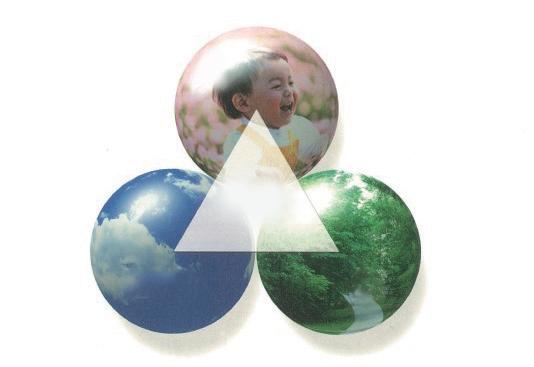
Promoting ZEH through Green First ZERO detached houses
Sekisui House’s Green First ZERO (ZEH) detached houses contribute to the reduction of CO2 emissions and decarbonization through excellent energysaving and energy-generating performance without sacrificing living comfort.
The foundation of this comfort is excellent thermal insulation that clears ZEH standards. A home designed with a living room atrium or large windows offers a bright, open space, but these features can be disadvantageous in terms of energy efficiency. By using windows with excellent thermal insulation, we achieve both an open indoor environment and energy efficiency. Since 2022, the standard specifications for Green First ZERO houses meet the newly established upper grades of thermal insulation—grade 5—and primary energy consumption—grade 6—under Japan’s housing performance indication system.
In terms of exterior appearance, to harmonize with the townscape, creating a beautiful home while also achieving ZEH standards is crucial. Photovoltaic panels, including tile-shaped photovoltaic panels that blend in beautifully with ordinary roof tiles, are an essential part of ZEH and are a standard feature on our sloped-roof buildings. In addition to their appearance, these tile-shaped panels make it possible to install a large area of panels even on complexly shaped roofs. ZEH also helps promote everyday comfort and economy. Comfortable living requires energy for use in air conditioning and electronics. The spread of telecommuting is leading to an increase in time spent at home and, in turn, home energy consumption. Combined with recent rises in electricity and gas prices, this could cause an even greater burden on households. The energy saving and generation of ZEH help significantly reduce these utility costs so that residents do not have to worry about major cost increases due to spending more time at home. The combined effect of this with the Family Suite bright and spacious interior designs we recommend, this makes it possible to live comfortably and free of new stresses arising from new modes of living that incorporate telecommuting. Thanks to these advantages, Sekisui House’s Green First ZERO (ZEH) detached houses have been embraced by customers, and in FY2023, 95%2 of Sekisui House’s new detached houses were ZEH buildings, far exceeding the
rate for Japan as a whole of 23%.3 In addition, the cumulative number of ZEH houses we have constructed since the launch of this product reached 83,541 as of March 31, 2024. The Japanese government’s 6th Strategic Energy Plan, announced in 2021, sets the goals of having all new houses built from 2030 meet the ZEH standard for energy efficiency and installing photovoltaic power generation equipment in 60% of new detached houses by 2030. Sekisui House already meets both of these targets.
The largest portion of the Sekisui House Group’s CO2 emissions, at 75% of the total, is from the use of supplied housing (Scope 3, Category 11). Promoting the adoption of ZEH is therefore indispensable to reducing CO2 emissions.
Growth in the number of Detached House ZEH

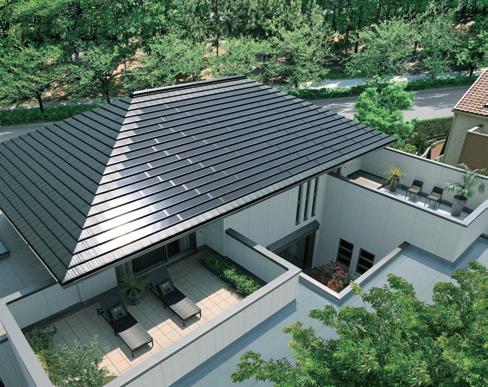
Note: The ZEH ratio includes contracted and built-for-sale housing. Nationwide figures are rounded to the nearest whole number, from figures published in the Net-Zero Energy House Demonstration Project Survey Presentation 2023 (sponsored by the Agency for Natural Resources and Energy and the Ministry of Economy, Trade and Industry).
1 Net zero energy house, a house that aims for an annual primary energy balance of zero through energy efficiency and energy generation while providing a comfortable indoor environment. Green First ZERO is the brand name of our detached house ZEH with standard adoption of a solar power generation system.
2 The ratio of ZEH, Nearly ZEH, and ZEH Oriented (in areas with snow accumulation of 100 cm or more) dwellings constructed between April 2023 and March 2024 in all areas excluding Hokkaido. The ratio for Hokkaido was 92%.
3 Source: Net-Zero Energy House Demonstration Project Survey Results (2023 Edition); Ministry of Economy, Trade and Industry, Agency for Natural Resources and Energy; Sustainable open Innovation Initiative. Figure for FY2022.
6
7
In order to expand its business domain in housing construction, the Sekisui House Group is engaged in initiatives for conventional wooden housing in addition to its mainstay pre-engineered housing. While Group companies Sekisui House noie and Sekisui House Construction are developing the noie brand and the ki no ie brand, respectively, the commitment to realizing a decarbonized society through ZEH is common to all Group companies. In FY2023, 177 of the 453 houses sold under the noie brand, and 24 of the 93 houses sold under the ki no ie brand were ZEH. We are working to promote ZEH in ways that align with each of these brands, which propose simple and just-right home building, though such means as using third-party ownership schemes for photovoltaic power generation.
Comfortable living is only possible if residents feel secure about their homes when disaster strikes. To prepare for earthquakes, typhoons and other natural disasters, in addition to the robustness of houses themselves, it is crucial to secure living spaces, food, water and energy for use in the aftermath of a disaster. In 2004, the Sekisui House Group became the first house builder in Japan to launch an energy-saving, disaster-resistant house with facilities for storing supplies of food and water as well as household power storage cells and photovoltaic power generation equipment. Then in 2011, we launched Green First HYBRID houses, which enable both optimized energy use every day and power use during power outages through the coordinated control of these systems with fuel cells. As climate change has caused more frequent and severe natural disasters, we have enhanced the disaster resilience of our housing so
that residents can live their lives with peace of mind.
Today, we propose disaster-resilient zero energy houses that combine three features: securing living spaces after major earthquakes with high seismic resistance; space and facilities to store a three-day supply of food, drinking water and water for hygiene; and energy self-sufficiency. Such houses offer photovoltaic power generation systems to generate electricity when the sun is shining, fuel cells that can generate electricity in cloudy weather or at night as long as they have gas and water supply, storage cells that store excess power generated by photovoltaic and fuel cell systems, a strong structure, and excellent thermal insulation and energy-saving performance. Through this combination, these houses allow residents to live in a way that is closer to normal after disasters, making home an effective disaster shelter.
Since April 2022, we have been further enhancing our resilience offerings with new emergency power supply boards for use in power outages and reinforced measures to prevent water from entering underfloor spaces during sudden heavy rains or flooding. In a home that has only photovoltaic panels and fuel cells, during a power outage, power is only available from specific emergency outlets. With an emergency power supply board, however, appliances that need to stay powered, such as refrigerators, can stay plugged into their normal plugs (Figure 1). In addition, to address increasingly common flooding damage, we raised the installation height of equipment, added water stops that can be set up at front doors during flooding emergencies, adopted reinforced concrete foundation slabs, added sewerage pipe air pressure release valves, and raised the height of building foundations. Through the combination of these five measures, we have reinforced measures to prevent underfloor flooding (Figure 2).
In addition to prevention, recovery measures after a disaster are also
important. Sekisui House leverages its Company-wide organizational strength to quickly assess the safety of the residents and the state of damage, make its nationwide factories available as bases to support regional restoration, and work with partner construction companies nationwide to provide the construction capabilities necessary for recovery. Through this recovery support framework, we aim to help customers get back to their normal lives as quickly as possible.
In this way, we are continuously working to better protect the lives of our customers by balancing comfortable living with the realization of a decarbonized society in normal times and providing a recovery support system that leverages the resilience of buildings themselves and the organizational strength of our nationwide operations in times of disaster. These efforts encompass both the mitigation and adaptation approaches necessary to form policies that address climate change.
Based on its global vision to make home the happiest place in the world, Sekisui House will continue to evolve Green First ZERO while developing and spreading the value of ZEH, which contributes to the happiness of residents and society at large. By doing so, we will lead the way in the decarbonization of the housing industry.

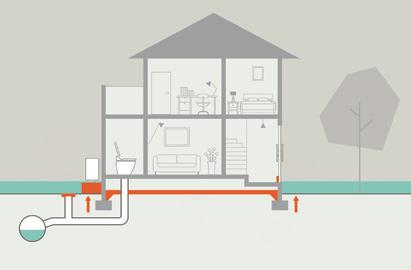
Approximately 30% of the CO2 emissions attributable to the residential sector in Japan come from multi-unit housing complexes. Of this, rental housing accounts for a large fraction, approximately two thirds. Therefore, the conversion of rental housing to ZEH is essential for decarbonization. We have designated ZEH under the Sekisui House rental housing brand Sha Maison as Sha Maison ZEH, and have been promoting its full-scale popularization since FY2020.
Two types of ZEH standards, each with different targets, are used for multiunit housing complexes. The first is known simply as ZEH and applies the net zero energy standard to individual housing units in much the same way it applies to detached houses. The second is known as ZEH-M and applies the net zero energy standard to entire residential buildings, including common areas. In ZEH-M, the building as a whole is judged against the ZEH standard, and it may clear the standard even if individual units within it do not. For this reason, from a resident-first perspective, we offer systems in which photovoltaic panels are connected to each unit so that residents can sell their own electricity individually, thus promoting unit-level ZEH that allows residents to enjoy the benefits of ZEH, including comfort and reduced utility costs. By making as many units ZEH as possible within each building, we are working to popularize rental housing that also meets the ZEH-M standard as a result.
In order to promote ZEH in rental housing businesses, which entails higher costs, it is also crucial to create business benefits for owners. We believe that as society as a whole progresses toward decarbonization, demand for ZEH will eventually increase in rental housing, as well. As the merits of residential units with unit-level ZEH are immediately clear before move-in, unit-level ZEH can be expected to help prevent occupancy rates and rents from declining, leading to long-term stable management. A survey we conducted in FY2021 of young people, who are the main users of rental housing, found that respondents were familiar with the effects of climate change, and we were able to discern an ethical-mindedness among them in terms of choosing to live in an environmentally friendly manner in order to combat such effects. Because this type of thinking is expected to increase in the near future, the conversion of rental housing to ZEH can be considered a good investment.
Furthermore, a FY2022 survey of Sha Maison ZEH residents found that 88% of respondents were satisfied and, of these, 78% said that they would
choose ZEH for their next home after moving out. Rental housing residents often move out after a few years, meaning that over time, Sha Maison ZEH is helping increase the total number of people who prefer ZEH. In this way, Sha Maison ZEH, with its clear benefits to residents, is expected to have knock-on effects in popularizing ZEH throughout society.
The Sha Maison ZEH approach has been well received by numerous owners and residents, and the proportion of ZEH residential units across all of our rental housing is increasing every year. The proportion of ZEH units for rent in FY2023 increased to 76% (15,191 units) from the previous year’s 65%.
1 For a multi-unit housing complex, four types of ZEH standards are defined, depending on the difference in energy efficiency. “ZEH” is capable of reducing net primary energy consumption by 100% or more; “Nearly ZEH” represents a reduction of more than 75%; “ZEH Ready” represents a reduction of more than 50%, and “ZEH Oriented” represents a reduction of more than 20%. In addition, ZEH-M and ZEH differ in their definitions of evaluation targets, which are “residential building” for the former and “residential units” for the latter. News release: Conducted a Survey on Residential Awareness of Global Warming Prevention Among People in their 20s and 30s (Japanese only) (FY)
of vacuum double-glazed windows with extremely high thermal insulation performance.
In FY2023, 100% of GRANDE MAISON condominiums sold were ZEH. We plan to continue this through FY2024 onward.
3 Residential units that meet the ZEH Oriented
2 Ratio of orders for ZEH Ready or higher-grade units (includes only units in which individual residents can sell electricity to the grid; number of units was used as a KPI in FY2021)
As with rental housing, we are promoting the transition to ZEH at the unit level in condominiums for sale.
In February 2019, Sekisui House built GRANDE MAISON Kakuouzan Kikuzakacho (Nagoya City, Aichi Prefecture), the first condominium building in Japan with all ZEH units connected to photovoltaic power generation systems. In FY2023, all GRANDE MAISON locations were ZEH, adding 16 buildings and 873 units of ZEH condominiums for a cumulative total of 27 buildings and 1,458 units.3
In its condominiums, Sekisui House designs ZEH with an emphasis on livability, which is a benefit for the tenants. For example, sweeping vistas are part of the appeal of high-rise condominiums. The large windows typically used to maximize this appeal are disadvantageous in terms of energy conservation, but we have achieved both ZEH and comfort through innovations such as the use
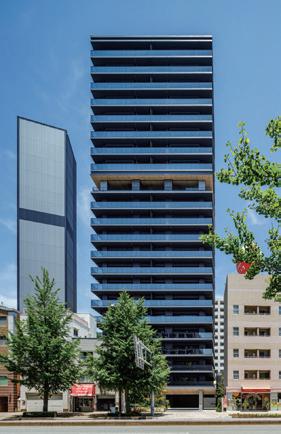


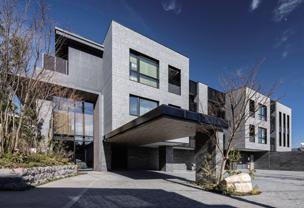

Sales of our sustainability-related products (ZEH) in FY2023 amounted to ¥861,032 million, 27% of the total sales of the entire Group.
1 Approximate amount of sales of ZEH from built-to-order business (detached houses, Sha Maison) and development business (condominiums)
In addition to detached houses and multi-unit residential buildings, we are also promoting ZEB2 in non-residential construction. To this end, we unveiled a style of proposal for office buildings called Green First Office. These proposals meet ZEB standards based on excellent thermal insulation performance that leverages ZEH design expertise and technologies developed in the housing business. These office buildings include proposals for spaces that improve worker productivity and help reinforce BCPs3 with highly seismically resistant structures, thereby undergirding the sustained growth of companies. Reflecting customer needs related to reducing utility costs, promoting carbon neutrality and increasing employee satisfaction, orders are up year on year. Outside of office buildings, we are also rolling out proposals suited to other building uses, such as clinics and nursing care facilities.
In FY2023, we completed 130 ZEB buildings, bringing our cumulative total to 303. Under the ZEB planner registration system, our target is for a majority of orders received in FY2025 to be for ZEB. We are reinforcing efforts to reach this target. Furthermore, to reduce CO2 emissions from our business activities (Scope 1, 2), since FY2021 we have ensured that all new offices and facilities built for the Group’s use are ZEB. Our Shimonoseki office in Yamaguchi Prefecture adopted elements of the technology for Green First Offices and meets the Nearly ZEB standard. This means that including buildings designed, built and occupied by the Sekisui House Group, we now have a total of 18 ZEB buildings.
2 Net zero energy building, a building that aims for an annual primary energy balance of zero through energy efficiency and energy generation while providing a comfortable indoor environment.
3 Business continuity plan, an emergency plan for corporate survival or for business continuity that makes strategic preparations to avoid an interruption of critical operations in the event that a disaster or other risk transpires.

We make energy efficient remodeling proposals for our existing houses through Group company Sekisui House Remodeling, Ltd. Energy efficient remodeling is general term for remodeling that entails the installation of photovoltaic panels or storage cells to increase energy self-sufficiency, improving thermal insulation performance, or replacing existing air conditioning and water heating equipment with high-efficiency models. In particular, we focus on housing that is more than 20 years old, which is typically much less thermally insulated than ZEH. In this area, we propose Idocoro Dan-netsu insulation remodeling, which emphasizes the living room, dining room and kitchen area, where people spend most of their time, and promote replacement of equipment with highly energy efficient models. For owners of homes equipped with solar power generation systems that have reached the post-FIT period (past the end of the feed-in tariff system’s purchase period), we emphasize the merits of adding storage cells to their systems. Specifically, in addition to increasing the rate of self-consumption of surplus power, thereby helping reduce utility costs, we highlight the enhanced resilience that such an addition provides by enabling the use of electricity during power outages caused by natural disasters, which are increasing due to climate change. In FY2023, we were able to reduce CO2 emissions by approximately 8,000 tons through solar installations done as part of our energy efficient modeling reforms.
As part of our efforts to decarbonize existing housing, we are also focusing an initiative to promote the proper recognition of the value of existing houses and create an active market for them. We believe that the proper assessment of the value of existing housing can help create more opportunities for investment in energy-saving remodeling and thus contribute to the decarbonization of hosing stock.
The Japanese government’s goal of reducing greenhouse gas emissions attributable to the residential sector 66% compared with the FY2013 baseline by 2030 depends on decarbonizing existing housing. As such, initiatives in this area are expected to receive a range of policy support going forward. Sekisui House has supplied more than 2.6 million housing units to date and will continue to make remodeling proposals and promote market circulation based on proper valuation while taking advantage of various forms of support from the government to further the decarbonization of existing housing.
In an effort to decarbonize its business activities, in 2017, the Sekisui House Group became the second Japanese company and the first company in the housing industry to join the international initiative RE100. The Group is working to switch to power derived from renewable energy sources for use in its business operations. Most companies procure renewable energy through the purchase of green power certificates and the installation of photovoltaic power generation systems. In contrast, we procure surplus solar power from our customers under the post-FIT mechanism through Sekisui House Owner Denki.
Because we were an early adopter of solar power generation systems in our houses, the annual amount of power generated by all of the solar power generation systems we had installed was estimated to be over 700 GWh when we joined RE100, more than five times the 120 GWh annual power consumption of the entire Group at that time. Based on this, we estimated that we would be able to achieve RE100 by around 2040 if we could procure surplus power from 20%–30% of our customers under the post-FIT mechanism, and established this as a target. In actuality, we have been able to procure such power from roughly 50% of our customers, and expect to achieve RE100 earlier than originally anticipated. The amount of renewable energy purchased in FY2023 through Sekisui House Owner Denki was approximately 89 GWh, accounting for roughly 86% of the Group’s total power consumption.
In addition, Sekisui House Owner Denki also creates benefits for cooperating electric power companies by making large contracts for the Group’s business use power. This makes it possible to set the unit price for purchasing surplus power higher than the market price, leading to higher customer satisfaction. In addition, we expect to be able to achieve RE100 while controlling the cost of adopting renewable energy.
2
1
Overview of Sekisui House Owner Denki Purchase of post-FIT electricity for 11 yen/kWh
Company vehicles account for roughly 30% of the Sekisui House Group’s CO2 emissions. We thus regard reducing these emissions as an important aspect of realizing decarbonization.
We are promoting the switch to and adoption of electric vehicles, such as hybrid electric vehicles (HEVs) and battery electric vehicles (BEVs), and have set a target of 100% electrification of Company vehicles by 2030 and begun initiatives to achieve this goal. In 2023, we started work on creating charging
infrastructure that could be used with cloud systems to understand decentralized charging and charging amounts in order to optimize for increasing power demand at our locations. Starting with the Toyohashi Branch, usage of EVs as Company vehicles has begun at four locations, and we started a service that allows customers to charge their EVs when they visit these locations for consultations.
In addition to the speedy adoption of HEVs, the adoption of EV Company vehicles allows us to utilize electricity derived from renewable energy through Sekisui House Owner Denki as we aim to significantly reduce CO2 emissions from Company vehicles (23,385 t-CO2 in FY2023) and contribute to the realization of decarbonization. Percentage of Company Vehicles that are Electric, Aiming for 100% (FY)
policy collaboration on climate change in Japan
Through the Japan Federation of Housing Organizations, which supervises the housing industry, and the Japan Prefabricated Construction Suppliers and Manufacturers Association, we endorse practical policies such as tax incentives and the expansion of various subsidy programs to promote climate change mitigation in all aspects of buildings, including housing, formulated by the government, particularly the Ministry of Land, Infrastructure, Transport and Tourism; the Ministry of Economy, Trade and Industry; and the Ministry of the Environment. We actively cooperate with and make recommendations to these entities.
In 2008, Sekisui House declared that it would aim to be carbon-free in its operations and value chain by 2050. Since then, we have been focused on promoting the adoption of net-zero energy houses. The United Nations Framework Convention on Climate Change (UNFCCC) has proposed that urgent action is needed to reduce carbon emissions from the building and construction sector, which accounts for about one-third of global energy consumption. An urgent need exists to achieve this objective with innovative buildings and construction methods. We will continue to work with experts from around the world to decarbonize the building and construction sector.
Main activities:
Joined the Global Alliance for Buildings and Construction (GlobalABC), which was established at the UN’s COP21 conference in Paris, France Participated in and submitted reports to the UN’s COP22 conference in Marrakech, Morocco
Made a presentation at COP23 in Bonn, Germany advocating the development of sustainable cities at SDG 11 Day, a ministerial meeting on SDG 11, highlighting the rationale and background for the mass adoption of ZEH Participated in the Building Materials Working Group since FY2022
Participated in the international Race to Zero campaign for decarbonization organized by the UNFCCC through our membership in the Business Ambition for 1.5°C campaign organized by Science Based Targets (SBT) in conjunction with COP26
Invited to and participated in the round table meeting at COP28 in Dubai, UAE entitled “Delivering the Buildings Breakthrough: Pioneering leadership for a low-carbon and resilient world”
To reduce lifecycle CO2 emissions from homes, Sekisui House has been promoting the uptake of ZEH and other energy-efficient housing with the aim of reducing CO2 emissions at the residential stage (Scope 3, Category 11). These efforts have led to significant reductions. However, emissions from the procurement of components and raw materials in the supply chain (Scope 3, Category 1) account for 20% of the Group’s total emissions (FY2023 figure). We cannot address this significant portion of emissions alone, so we have begun collaborative efforts with suppliers. First, in October 2020, we surveyed our suppliers to determine the state of their initiatives to reduce CO2 emissions. Based on the results, we held a seminar in February 2021, which 135 suppliers attended. We positioned this event as the kickoff of initiatives to reduce CO2 emissions in our supply chain, subsequently holding additional seminars with 61 participating companies in April 2021; 242 in October 2021; 260 in September 2022; 157 in February 2023, and 279 in October 2023. We use these events to promote awareness of the need to acquire SBT validation¹ and to provide training for procurement staff. The seminars also feature keynote speeches by speakers from the SBT organization and progress reports for our policies, and major suppliers as well as small- and medium-sized suppliers who present on how they acquired SBT validation. Sharing positive examples of how even small companies can obtain SBT validation helps more suppliers get validated. We have also set up a consultation service within the Company for small- and medium-sized suppliers to provide specific advice and answers to individual questions.
We have set the medium-term target of raising the SBT-setting rate of our major suppliers to 80% by 2030 and are steadily raising the current rate. Around 20% of the Sekisui House Group’s Scope 3, Category 1 CO2 emissions attributable to procurement come from small- and medium-sized suppliers and, in 2023, a total of 65 such companies acquired SBT validation. In addition, as our suppliers set decarbonization targets and begin initiatives, these efforts contribute to the decarbonization of the construction industry as a whole. By promoting effective CO2 reduction across the supply chain in cooperation with our suppliers, we will contribute to the realization of a carbon-free future.
1 Validation by the Science Based Targets Initiative (SBTi) of corporate greenhouse gas reduction targets as being aligned with the requirements of the Paris Agreement
Environmental certifications acquired by suppliers
We confirmed our suppliers’ acquisition status of environmental certifications, including ISO 14001 (environmental management).
Participating in initiatives
We have been an early participant in the global movement for biodiversity conservation. At the 9th Conference of the Parties to the Convention on Biological Diversity (COP9) in 2008, we were one of the nine major Japanese companies to sign the Leadership Declaration of the Business and Biodiversity Initiative.1
As a founding member of this initiative, we agreed to the three objectives of the Convention on Biological Diversity (conservation of biodiversity, sustainable use of biodiversity components, and fair and equitable distribution of the benefits of genetic resources), and we continue to promote biodiversity conservation2 under this policy in our business operations. We have also endorsed the goals of the Taskforce on Nature-related Financial Disclosures (TNFD), which was launched in June 2021. We then joined the TNFD Forum in February 2022 and in January 2024 were recognized as a TNFD Early Adopter. In addition, we are part of the 30by30 Alliance, which was launched with the aim of achieving the global 30by30 target3 adopted at the 15th Conference of the Parties to the Convention on Biological Diversity (COP15), and we are proactively cooperating with certified Nationally Certified Sustainably Managed Natural Sites5 with the aim of achieving OECM4 registration.
These initiatives are led and promoted by the Environmental Subcommittee, in cooperation with each department as well as domestic and overseas Group companies, based on the ESG management promotion system.6 We also ensure that all employees understand and are familiar with these initiatives through progress reports, feedback on issues and proposals for improvement.
1 Business and Biodiversity Initiative: Leadership Declaration
2 P.132 Biodiversity Conservation 2. Strategy
3 30by30 is an international initiative to effectively conserve at least 30% of the Earth’s land and ocean area as sound ecosystems by 2030 with the nature-positive goal of halting and reversing biodiversity loss by 2030.
4 Other effective area-based conservation measures, an approach to designating areas that contribute to biodiversity conservation outside of protected areas
5 Ministry of the Environment’s “Nationally Certified Sustainably Managed Natural Sites”
6 P.93 ESG Management Promotion Structure
In our Sustainability Vision 20507 plan, we have set the goal, as a challenge for 2050, of maximizing ecosystem networks through business operations. We aim not only to achieve no net loss (to maintain the value of ecosystems) but also become nature positive (to enhance the value of ecosystems through our business operations). Based on this commitment, we remain focused on the Gohon no Ki Project8 a landscaping and greening project that fully considers the ecosystem, as well as FairWood sustainable wood procurement.
In particular, the issue of wood procurement is recognized as a pressing global issue; the goal of zero deforestation by 2030 was adopted in the 2014 New York Declaration on Forests. At COP26 in 2021, 140 nations, including Japan, agreed to this goal. The Sekisui House Group supports zero deforestation, which aligns with its FairWood procurement approach, and has declared the goal of zero deforestation Group-wide in Sustainability Vision 2050. In the future, we also aim to achieve zero deforestation throughout our primary and secondary suppliers.
7 Sustainability Vision 2050
The Gohon no Ki Project, an eco-friendly landscaping and greening project8
Sekisui House is Japan’s largest landscaping company, planting one million trees nationwide annually. To fulfill our responsibility as a large-scale house builder, since 2001 we have been implementing the Gohon no Ki (“five trees”) Project, an ecosystem-conscious landscaping and greening project, to conserve biodiversity through our housing business.
The Gohon no Ki Project is based on the approach that “three trees are for birds, two trees are for butterflies, and all are local native tree species.” The project proposes the use of native tree species that are beneficial to birds and butterflies in gardens. In addition to biodiversity conservation, we are making
proposals that encompass the benefits to residents of garden visits by fauna and the other effects of garden trees. We seek to maintain and revive the ecosystem network (nature positive) by increasing the amount of richly green space in urban areas and by leveraging residential gardens, created under the Gohon no Ki Project, to support the habitat and activities of the fauna. Ecosystem networks enrich biodiversity at the regional and national levels, creating places where both wildlife and residents can simultaneously enjoy the richness of nature.
Thanks to the cooperation of the many customers who have endorsed the philosophy of the Gohon no Ki Project, there were 837,000 plantings (includes those outside of the Gohon no Ki Project) in FY2023, with the cumulative number of plantings since the 2001 start of the project rising to 19.84 million.
8 Gohon no Ki Project (Japanese only)






FairWood is defined as wood that is not only legal, but also contributes to sustainability and local development. We have declared FairWood procurement as a priority in our Wood Procurement Guidelines, and we are working to improve our level of procurement while engaging with FoE Japan and other international environmental NGOs and industry organizations. For example, we are constantly working with environmental NGOs to obtain the latest information on high-risk areas and update our risk assessment methods.
One objective of FairWood procurement is to secure a stable supply of sustainable and renewable resources for the Company. Another objective is to achieve a positive impact through sustainable forestry management that goes beyond avoiding illegal logging by continually working on our supply chain as one of Japan’s leading wood consumers. This also aligns with our biodiversity conservation challenge goal of “maximizing ecosystem networks through our business.”
Since establishing the ahead-of-the-curve Wood Procurement Guidelines in 2007, Sekisui House has promoted the procurement of FairWood, a sustainable source of wood. To better clarify our stance, we announced updates to our Wood Procurement Guidelines and creation of the Wood Procurement Policy on October 1, 2023.
Our newly established Wood Procurement Policy not only advances FairWood procurement as previously stated but also reaffirms our stance on working to achieve zero deforestation by 2030 and tolerating absolutely no human rights violations. In line with this, the ten Wood Procurement Guidelines have been revised to use more specific terminology such as “zero deforestation,” “zero land conversion” and “respect for the free, prior and informed consent (FPIC) of indigenous peoples.”
The three fundamental policies of the Wood Procurement Policy (established October 1, 2023)
① We strive to practice environmentally friendly, socially fair procurement of FairWood.
② We will achieve wood product procurement with zero deforestation of natural forests by 2030.
③ We do not tolerate conflicts or human rights abuses anywhere in our supply chain.
The ten Wood Procurement Guidelines (as revised October 1, 2023)
① Source wood products with guaranteed legality and a supply chain that can be traced back to the logging site for due diligence processes, etc.
② Source wood products produced without damaging high conservation values (HCVs).
③ Do not source wood products from areas where the logging of natural forests causes biodiversity loss or deforestation.
④ Do not use endangered species for wood products.
⑤ Minimize CO2 emissions when producing, processing, and transporting wood products.
⑥ Respect the free, prior and informed consent (FPIC) of indigenous peoples and source wood products from supply chains that do not involve conflicts or human rights abuses.
⑦ Source wood products from areas of controlled logging, so as not to exceed the rate of forest regeneration.
⑧ Source wood products from domestic forests where well-planned forest management is in place to conserve ecosystems.
⑨ Source wood products from forests that are managed so as not to damage high carbon stock (HCS) forests or lead to forest conversion.
⑩ Source wood building materials that contribute to resource recycling and cascading use.
To us, due diligence1 is the process of securing sustainable timber that supports the future of our business, and we implement sustainable wood procurement through strict due diligence practices.
Many companies conduct due diligence only for low-risk timber from primary suppliers. In contrast, we also target suppliers at the secondary level and further upstream and visit logging areas to investigate and confirm the status of operations when risks that cannot be simply eliminated are identified.
This is because we believe it is important to share the tracking process with suppliers and strive for ongoing improvement in order meet growing international calls for zero deforestation.
1 Due diligence is the duty of care and effort that companies and others must apply as a matter of course. In Japan, the Act on Promotion of Use and Distribution of Legally-harvested Wood and Wood Products (commonly known as the Clean Wood Act) refers to due diligence, and was enacted in response to the tightening of regulations on the handling of illegally harvested timber in Western countries. This is represented by a process of identifying risks of illegality by 1. collecting information, 2. assessing risk, and 3. practicing risk mitigation. A growing number of companies are currently practicing due diligence in wood procurement while also addressing ESG-related risks.
Sekisui House implements a wood procurement survey of its major wood suppliers (roughly 60 companies) according to the following process.
Since FY2023, we have explicitly stated in our Wood Procurement Policy and Wood Procurement Guidelines our goal of zero deforestation and have added a new KPI regarding the rate of accomplishment of this goal at our logging areas.
The ratio of Rank S and Rank A wood has been gradually increasing from 47% before the guidelines were implemented in FY2006, reaching 97.2% in FY2023. The rate of zero-deforestation (ZD) wood procurement has reached 89.8%.
For existing suppliers whose evaluation results according to the Wood Procurement Policy reveal environmental risks, we conduct thorough due diligence by continuous monitoring of evaluation standards and the achievement of those standards.
In the event that a serious risk is discovered in the due diligence process, we work with the related divisions to determine the proper remedial action and take measures that could include cutting back on transactions with the supplier, depending on the score in the supplier assessment. No suppliers were deemed high-risk in FY2023.
1. Collect detailed data from suppliers on the sources of wood, including species and producing areas
2. Quantitatively assess the data collected using the Wood Procurement Guidelines and assign ranks (four-grade scale: S, A, B or C)
2’. Verify zero deforestation
3. Provide feedback to suppliers
4. Encourage improvement for wood ranked B or C and wood where zero deforestation goals have not been met (including unverified circumstances)
i Initial risk assessment Tree species at risk
Washington Convention
IUCN Red List, etc. Logging country/ region risk
Extent of illegal logging • Corruption index, etc.
ii Detailed risk assessment
If the probability of risk in the initial evaluation is high, we contact upstream suppliers and collect information on local forest management, biodiversity, and human rights risks and make a comprehensive determination.
• NGO information, document confirmation, site visits, etc.
Conducting onsite due diligence in high-risk areas is both effective in achieving zero deforestation and zero human rights violations in our Wood Procurement Policy and for strengthening engagement between various stakeholders such as suppliers and environmental NGOs.
In FY2023, we were able to conduct due diligence of raw materials for interior components in Vietnam thanks to the easing of COVID-19 related travel restrictions. During this visit to logging sites and manufacturing plants for raw materials, we confirmed that we are not contributing to deforestation. We additionally held interviews regarding human rights violations in the supply chain and confirmed that no such violations were taking place.
1 Excluding Japan
2 Indonesia, Malaysia, etc.
3 Particle board and other building materials recycled from construction waste, etc.
4 Africa, etc.
Conservation (FY)
In 2019, to comprehensively evaluate small green spaces scattered across Japan that could not previously be assessed, we worked with the Kubota Laboratory in the Faculty of Science of the University of the Ryukyus to start a joint verification analyzing the effectiveness of quantitative assessments of biodiversity conservation from a macro perspective. Using the big data on biodiversity from the University of the Ryukyus in addition to cumulative data on the number, species and location of trees planted by the Company, in 2021, this analysis made it possible to quantitatively express the effect of the Gohon no Ki Project on biodiversity in terms of the number of bird and butterfly species
being attracted to residential areas. We also quantitatively evaluated the effectiveness of restoring biodiversity in Japan’s three largest metropolitan areas (Tokyo, Osaka and Nagoya) using an integrated diversity index and conducted simulations to assess the effect of continuing the Gohon no Ki Project through 2070.7 The results showed that the Gohon no Ki Project contributes to the restoration of biodiversity, and that the potential benefits can be amplified by expanding the project in the future. We will widely disclose not only the results of these assessments, but also the expertise we have accumulated through our activities over the past 20 years, and will continue to work with many companies and individuals to promote nature positive initiatives.
In July of 2023, to further accelerate the Company’s efforts in biodiversity conservation, we have entered into a collaborative agreement8 with Think Nature Inc. to promote biodiversity net gain and the standardization of its calculation methods. For example, we have developed a tool for proposing the combination of tree species to plant in order to maximize biodiversity net gain in future housing construction sites. We will accelerate our efforts aimed at our 2030 nature positive initiative while improving the quality of our ecosystemfriendly Gohon no Ki Project.
6 A dataset covering over 150 natural capital and ecosystem services, including the importance of biodiversity based on distribution data of over 300,000 different terrestrial and marine species.
7 News release: 20 Years of Urban Biodiversity Conservation with Customers through the Gohon no Ki Project (Japanese only)
8 News release: Sekisui House and Think Nature Inc. Begin Collaborative Agreement Aimed at Promoting Biodiversity Net Gain (Net Increase) and the Standardization of Calculation Methods
Effects of the Gohon no Ki Project
Project has achieved a tenfold increase in tree species that are the foundation of biodiversity
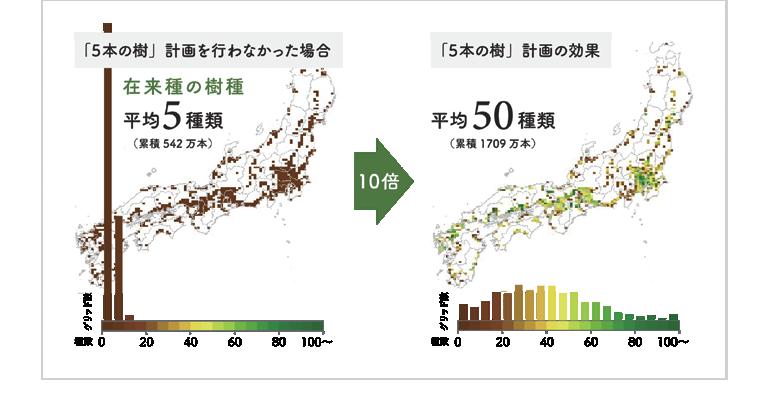
Results of big data analysis: Effect on birds
Gohon no Ki has the effect of attracting about Twice as many
species to residential areas

Results of big data analysis: Effect on butterflies
Gohon no Ki has the effect of attracting nearly Five times as many

Quantitative evaluation of nature positive effects
Simulation of changes through 2070 in three metropolitan areas (Tokyo, Nagoya and Osaka) where green space degradation is significant
Note: With values for 2000, just before the Gohon no Ki Project, set as the zero level, and with 1977, the first year for which national land use data is available, set as 100 When the Company and other companies implement initiatives similar to the Gohon no Ki Project When the Company implements the Gohon no Ki Project When the Gohon no Ki Project is not implemented
biodiversity forum (Japanese only)
Big data on biodiversity has revealed that urban areas with densely packed houses and a large number of people are just as important to biodiversity conservation as forests and satoyamas (the traditional Japanese rural landscape consisting of cultivated fields, forests and human settlements that are interconnected and coexist harmoniously). It is important to create high quality green spaces in urban areas where the available area is scarce. The Company has created high-quality green spaces that significantly impact biodiversity conservation efforts through its Gohon no Ki Project, a project focused on planting native tree species. We will propose better quality green spaces by quantitatively assessing biodiversity using big data and by demonstrating precisely how cohesive green spaces in urban areas impact biodiversity conservation

On the north side of the Umeda Sky Building in Kita-ku, Osaka, where the Company is headquartered, we created the Shin-Satoyama Garden covering 8,000 m2. This garden was renovated in 2006 with more than 500, mainly medium to large native trees, based on the principles of the Gohon no Ki Project. We planted native Japanese tree species and more than 200 species of shrubs and flowers to create green spaces. In the belief that a variety of types of spaces supports the richness of an ecosystem, we provided terraced rice paddies and fields to reproduce a satoyama in the city center.
The growth of a wide variety of plants has increased the amount of greenery, and many creatures—including more than 40 species of wild birds and more than 50 species of butterflies—visit, live and grow in the garden. The arrival of birds of prey, which are rarely seen in the city, has also been confirmed. Instead of employing the conventional consumption-oriented management approach of removing weeds and fallen leaves immediately, natural low-load circulatory management has been adopted for the satoyama to enrich the soil organisms and broaden the food chain. In this way, we have created a green space where many creatures can now thrive.
In October 2023, Shin-Satoyama was certified as a Nationally Certified Sustainably Managed Natural Site. This certification will help Shin-Satoyama contribute to achieving Japan’s 30by30 target through preserving the value of biodiversity and increasing its quality. We also expect it to have a positive ripple effect on biodiversity conservation and contribute to enhancing corporate value.
1 Nationally Certified Sustainably Managed Natural Sites: The Kunming-Montreal Global Biodiversity Framework, a new set of global goals to be achieved by 2030, was adopted at the 15th Conference of the Parties to the Convention on Biological Diversity (CBD-COP15) in December 2022. Among them was the 30by30 target, setting the goal to effectively preserve 30% or more of all land and sea as healthy ecosystems. The initiative in Japan to achieve this goal is referred to as a Nationally Certified Sustainably Managed Natural site (areas where biodiversity is being pursued through private-sector efforts and certified by the Ministry of the Environment).
Additionally, in 2013, we completed the “Wall of Hope,” a huge greening monument on the east side of Shin-Satoyama measuring 9 meters high and 78 meters long that was installed at the initiative of the renowned architect Tadao Ando. In order to function as a model for the kind of vertical spatial greening that is expanding in cities, we covered the green wall with more than 20,000 plants of about 100 diverse species, focusing mainly on the tree species selected for the Gohon no Ki Project. The strategic arrangement of plants that flower or change colors at different times allows visitors to enjoy the varied appearance of the garden as it changes with the seasons. The Shin Satoyama project has become familiar to nearby residents and office workers as a place where one can experience the true value of the ecosystem.
In the condominium for sale segment, we are utilizing the principles of the Gohon no Ki Project for property exteriors. In our GRANDE MAISON2 condominium brand, we maintain a constant awareness of greening, with a target green coverage ratio (the percentage of the property’s site area that is planted) of around 20% or more. The average green coverage of the 13 condominiums completed in FY2023 was 20.7%, representing green coverage of 5,308 m2. The outdoor areas surrounding multi-unit buildings such as condominiums also function as a place for re-establishing community among residents, which has increasingly been lost as condominium security has tightened in recent years. The abundance of greenery soothes the spirits of residents and enhances the value of the condominium.

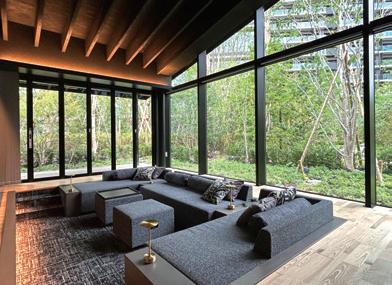
Urban development under the concept of keinen bika— creating a landscape that grows more beautiful over time
Since 1977, we have been working on community developments under the names “Common Life” and “Common City.” Designed with an awareness of the connections between neighbors and communities, the shared spaces boast lushly green plazas and streets as symbols offering a richer life, with a townscape that will grow more attractive over the years under the concept of keinen bika This approach leads to beautification and is highly appreciated by the local residents.
Since launching the Gohon no Ki Project in 2001, we have been promoting urban development that emphasizes the quality of greenery, keeping in mind the planting of native species in consideration of a healthy ecosystem. In 2005, we established the Urban Development Charter, which outlines our diverse expertise cultivated through urban development, such as that acquired through the Gohon no Ki Project, with adherence to the concept of sustainability. 1 Urban Development Charter

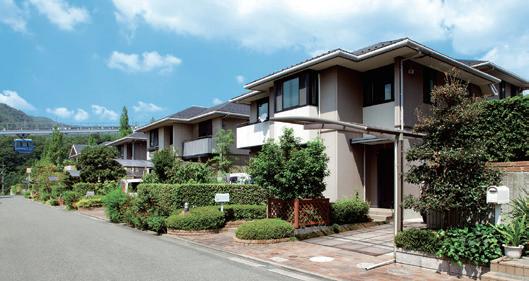
Looking at the forest industry in Japan, while many forests are entering a period of full-scale use, they are not being replanted for the next generation for a number of reasons, and are not being fully utilized.
To revitalize the domestic forest industry, we believe it is necessary to achieve the seemingly contradictory goals of increasing demand to promote the renewal of forests for the next generation and advancing branding to create added value. Therefore, we are shifting to the use of domestic timber, mainly for the structural materials in our SHAWOOD wooden-frame houses.
We do not simply use domestic timber, but also develop it as regional brands. By adopting materials from the regions where our customers live, we are contributing to local production for local consumption and the revitalization of regional economies.
Currently, we are developing cedar, cypress and larch products under 18 brands in 17 regions nationwide. Over 7,500 buildings have now been built with these materials. These products have grown to the point where they are an essential element of SHAWOOD.

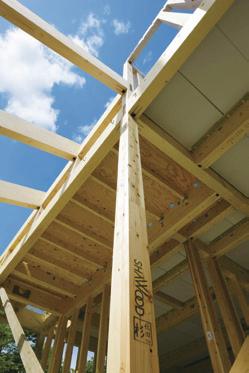
It is necessary for internal and external stakeholders to understand the policies and work together with us to achieve our goals set out in the newly established and revised Wood Procurement Policy as well as the recently revised Wood Procurement Guidelines. As a result, we held a hybrid briefing session in December 2023.
We invited a lecturer from the international environmental NGO Friends of the Earth Japan (FoE Japan) to give a keynote speech sharing the latest information on wood procurement. Two of our suppliers shared examples and all parties involved gained a deeper knowledge of the Company’s policies and guidelines. There were over 140 participants from 54 different companies, including suppliers of wood-based materials, internal wood procurement personnel and those in charge of development. We were able to share information with a large number of people as participation was open to secondary suppliers and beyond.
In response to the “wood shock” that hit the world in 2021, we took full advantage of the domestic timber supply network that we have cultivated to mass produce laminated beams made of cypress. The results of these efforts include using multiple procurement routes for key materials to fulfill our supply responsibilities and to put a system in place that prevents delays when executing our business operations. As an added benefit, by viewing the wood shock not only as a supply problem for the Company, but as an opportunity to create demand for domestic timber, we were able to demonstrate our approach to providing solutions to social problems.

forest certifications (CoC certification)
The Company uses forest certification systems as one method to advance FairWood procurement and the Production and Procurement Division has acquired FSC , 1 PEFC2 and SGEC3 CoC certifications.
Details of certification (FSC certification, FSC -C195799)
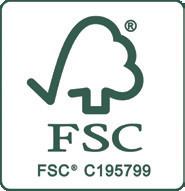
Certified organizations Production and Procurement Headquarters Tohoku Factory, Kanto Factory, Shizuoka Factory, Yamaguchi Factory
Certification code SGSHK-COC-350922
Date of certification January 19, 2024
Certification Body SGS Hong Kong
1 FSC (Forest Stewardship Council ): an international nonprofit organization with the goal of increasing the global responsibility of proper forest management.
Details of certification (PEFC certification)

Certified organizations Production and Procurement Headquarters Tohoku Factory, Kanto Factory, Shizuoka Factory, Yamaguchi Factory
Certification code FAM-PEFC-COC-039
Date of certification May 15, 2022
Certification Body Forest Audit of Mori
2 PEFC: Programme for the Endorsement of Forest Certification Schemes, an international certifying agency that engages in global certification systems and mutual recognition based on governmental standards set in place for sustainable forest management.
Details of certification (SGEC certification)
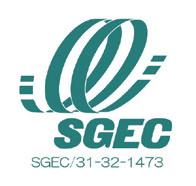
Certified organizations Production and Procurement Headquarters Tohoku Factory, Kanto Factory, Shizuoka Factory, Yamaguchi Factory
Certification code FAM-SGEC-COC-039
Date of certification May 15, 2022
Certification Body Forest Audit of Mori
3 SGEC: Sustainable Green Ecosystem Council was established as Japan’s unique forest certification system, providing mutual recognition with PEFC since 2016.
Under the ESG Promotion Committee, the Sekisui House Group has set up a Resource Recycling Task Force within the ESG Management Promotion Headquarters to build and administer a system for resource recycling for the entire Group. To maintain advanced resource recycling procedures, we created the Sekisui House Zero Emissions system based on the Wide Area Certification System. We also set up our own facilities, called Resource Recycling Centers, to consolidate waste generated at construction sites and ensure reliable recycling. To support this system, we created a waste sorting guide for resource recycling as well as guidelines that set out the criteria for selecting recycling companies. We are distributing information on these measures to our employees and partner building contractors, and we have developed and operate our own waste collection and waste measurement systems. In this way, we centrally manage all processes from waste generation to recycling.
In addition to using recycling methods, we also coordinate related resource recycling activities that help develop a circular economy, including through our product development and manufacturing departments.
Our basic guideline is to sustain an advanced resource recycling system based on the Sekisui House Zero Emissions system.
Basic policy for zero emissions
1. This system is designed to control waste generation throughout the entire supply of pre-engineered housing by analyzing the state and nature of waste generation and continually providing information useful for reducing waste during design, production and construction.
2. This system not only establishes standards for treatment consigned to others and ensures effective treatment contracting based on those standards, but must also be able to withstand future improvements in social standards.
Priority items
• Ensure effective recycling processes
• Ensure traceability
• Implement complete sorting of waste within the Company
3. Operations follow the Wide Area Certification System, in principle, as a basis for fulfilling the above norms.
The Sekisui House Group works to reduce resource use based on three approaches.
1. Through zero emission initiatives, we are working to recycle and make effective use of waste from construction sites, with a focus on material recycling.
2. We strive to improve durability and provide after-sales services and remodeling in step with the lifecycle stages of housing. These efforts help to extend the service life of housing and reduce resource use.
3. We aim to realize a circular economy through research and development of new building materials using recycled resources.
To effectively utilize byproducts resulting from the production of factorymanufactured components, we recycle such byproducts by processing and converting them into raw materials.
For example, we have adopted equipment for recycling scraps generated during exterior wall panel manufacturing and the cutting of holes for pipes to pass through, turning them back into raw materials for exterior walls.
We have focused efforts on the development of systems intended to control waste generation. We analyze the amount of resource inputs that go into product supply as well as the status and nature of waste generated during the manufacturing and construction processes. We also continuously improve systems for providing information useful in reducing waste in the processes of design, production and construction.
We establish recycling standards for the waste we generate and ensure proper recycling in accordance with these standards. Moreover, we will continue to pursue recycling technologies that are economically feasible while further contributing to the emergence of a society committed to resource recycling. We will pursue these goals in collaboration with our partner companies, including material manufacturers, factory production companies, partner building constructors, intermediate processing companies and demolition companies.
We are committed to green procurement, seeking to fulfill our social responsibility under our basic purchasing policy of providing the best quality, robust delivery and reasonable prices while also incorporating ESG 3. Risk Management
considerations. Through such efforts as working with suppliers to develop and procure products that are easy to separate and sort for recycling, the Company prioritizes choosing environmentally friendly products and services in our procurement efforts that contribute to sustainability.
For example, to facilitate the sorting of hot water pipe scraps, we do not use adhesives to bond double-layered hot water pipes when the layers are made from different types of plastic.
The hazardous waste this report refers to is waste generated during operations, which, according to the Wastes Disposal and Public Cleansing Act, the Group regulates as specially controlled industrial waste (including specific types of hazardous waste regulated in the Basel Convention, etc.). All types of hazardous waste are properly handled throughout storage, transport and disposal based on legal, governmental and industry guidelines.
Hazardous waste mainly originates from building materials used in construction and demolition (including restorations) and leftover chemical substances produced as byproducts in material manufacturing. For building materials used in the above-mentioned operations, this may include asbestos in heat-retaining, thermal insulation and fire-resistant coating materials, slag, sludge above base amounts and other hazardous waste connected to construction work that may be generated depending on site conditions.
As a rule, hazardous waste is disposed of in controlled landfills which have measures to prevent leakage into the natural environment. Leftover chemical substances produced as factory byproducts of material manufacturing are, with regard to their various characteristics and properties, recycled in their entirety through processes such as neutralization, reduction treatment and thermal recovery conducted through incineration.
Because hazardous waste generated by factories presents a large potential environmental impact, procedures have been established by these factories to prevent and mitigate pollution in emergencies such as accidents, earthquakes, and other disasters. Through repeatedly conducting appropriate tests, they are
working to ensure there are zero emissions to the natural environment even during emergencies.
When formulating the Sekisui House Zero Emissions system, the Group focused on building a system that takes into account certain risks in resource recycling, such as fraudulently passing off non-recyclable waste as recyclables and illegal dumping. In addition to selecting recycling companies based on the guidelines from our selection criteria, we periodically inspect treatment centers, perform operational audits and, on an ongoing basis, manage consignment contracts and waste management manifests through a centralized in-house management system. Through these efforts, we work to minimize (avoid) potential risks. A dedicated department at the head office is ready to take immediate action in the unlikely event that a potential violation of laws and regulations is detected.
Expanding measures under the Wide Area Certification System Housing construction requires a significant input of resources. We are involved in the entire lifecycle of housing from producing materials in our factories to demolition work, and we succeeded in reaching zero emissions1 in four of our divisions (material production, new construction sites, after-sales maintenance, and construction sites for remodeling our own properties) between 2002 and 2007. Since then, we have maintained this achievement as we continue to operate with consideration for the quality of our recycling efforts. One reason we were able to lead the industry by achieving zero emissions in so many areas of our business was our use of the Wide Area Certification System, which is a special feature of Japan’s Wastes Disposal and Public Cleansing Act. In 2004, we were the first in the Japanese construction industry to gain this certification, and we have since managed to expand our zero emissions efforts through this system.
In 2019, a joint application including all 17 Sekiwa Construction companies at the time was approved. Through efforts like these, we intend to further expand and strengthen the resource recycling system of the entire Group.
As one part of zero emissions efforts centered on the lifecycles of our products, we are also working toward zero emissions in the real estate leasing business, with Sekisui House Real Estate Holdings, Ltd. playing a central role. Specifically, we are implementing initiatives aimed at achieving zero emissions of waste (interior materials such as wallpaper and cushion flooring) generated during repair work when residents vacate Sha Maison rental housing delivered by the Company and managed by Sekisui House Real Estate companies. Looking ahead, a large amount of aging photovoltaic panels are expected to be scrapped in coming years. We are considering installing recycling facilities for these panels within our in-house waste processing system run primarily though the Resource Recycling Centers. 1
Resource Recycling Centers: The heart of our zero emissions initiative at new construction sites
One unique characteristic of the Sekisui House Zero Emissions System’s waste collection system, under the Wide Area Certification System, is our use of in-house Resource Recycling Centers. These facilities, which have been in operation at our production facilities across Japan since 2003, serve as the heart of our zero emissions efforts at new construction sites. The centers manage processes from allocating waste collection vehicles to supervising outsourced recycling companies.
All our waste generated during new construction is first sorted into 27 categories on site, then re-sorted into 60 to 80 categories at our 23 Resource Recycling Centers nationwide. All this waste is eventually recycled under the Group’s management. By disassembling items into components of a single material and reducing their volume through compression and heating, we prepare these materials to enter recycling streams handled partly by external contractors.
Plastic, which has become a particular problem in recent years, has been collected and recycled at a 100% rate since the introduction of zero emissions at our new construction sites in 2005. In addition to sorting plastics by type, we subdivide sorting categories, such as the degree of soiling, according to the requirements of recycling facilities in an effort to maintain a high standard of recycling.
enhancement of electronic system functions for waste management. We now operate a waste measurement system that utilizes 2D barcodes. This innovative system accurately monitors conditions at the time of disposal, aggregates and analyzes data from each building, and monitors the total disposal amount and the disposal amount by type of waste in real time. The detailed data analyzed in this way is then fed back to inform product development, material design, production processes and construction processes, enabling the more effective use of resources.
Our waste measurement system
Securing traceability in the proper disposal of construction waste is of the utmost importance not only to ensure proper treatment and recycling of waste, but also for promoting recycling business models such as streamlined construction. We have been proactive in introducing information and communications technology, starting with the trial of a waste measurement system using IC tags in 2007. In 2017, we updated our proprietary Electronic Processing System for waste collection into a cloud-based system in order to respond flexibly to requests for
Basic program for increasing the resource usage rate
We are working to maintain resource efficiency-conscious product design that minimizes the generation of unused materials (waste), regardless of changes in material inputs required to enhance housing functionality (such as improving durability, thermal insulation and the flexibility of living spaces).
initiatives
Recycling packaging and paper at construction sites
Sekisui House has launched a project to replace its plastic bags, and instead start providing recyclable paper bags. We considered a variety of materials for the new bags, ultimately selecting sanitary packaging paper used to package sanitary equipment, such as hot water heaters. This paper can be mixed with general recycled paper, without the use of virgin pulp, to be recycled into environmentally friendly paper bags.
We expect this project to help alleviate environmental burden, reducing plastic use by 10,723 kg per year through the phasing out of plastic bags, and reducing virgin pulp use by 13,232 kg per year through the use of waste materials and recycled paper.
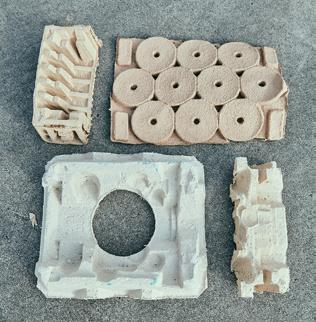

We continue working to reduce the amount of waste generated at our production and construction sites. In FY2023, we reduced the total amount of waste generated from factory production by 5.3% from the previous fiscal year.
Although the amount of waste generated per newly built house has decreased by nearly 60% compared with FY1999 levels as a result of our zero emissions initiative, in recent years this figure has been increasing slightly amid the growing proportion of houses with high environmental performance and houses requiring large amounts of material input.
However, with the recent global emphasis on achieving a circular economy, greater importance is being placed not only on reducing the amounts of waste generated, but also on improving the quality of recycling through the redesign of entire businesses. In light of this trend, we have been improving our construction methods by revising our structural building and construction techniques, utilizing the strengths of our in-house production and direct construction, handled exclusively by Group companies and partner building constructors.
At manufacturing and processing facilities located at two of our Resource Recycling Centers, scrap plasterboard collected from new housing construction sites and eggshells from third-party food processing factories are mixed together and crushed. This produces Platama Powder, an athletic field marking chalk, which we have manufactured and sold since 2010. This initiative has enabled us to establish a new commercial distribution channel and a system for continual recycling by regularly purchasing egg shells, which were previously thrown away as food waste.
We also reuse sorted solid waste by selling it in such forms as resin materials, woodchips, power line materials and Styrofoam materials (ingots).
The Kanto Factory and Hyogo Factory recycle concrete waste that arises in the Dyne Concrete manufacturing process as raw materials. Scrap material bored out of exterior wall panels and concrete residue that adheres to equipment were previously disposed of as waste. Some of this material is now recycled by pulverizing it to specific grain sizes for reuse as raw materials, reducing overall resource consumption.
Bellburn scraps are pulverized and used as filler in Sekisui House’s Shellshut Slab sound- and vibration-absorbent floor system. By replacing the inorganic sands previously used for this filler with Bellburn pulverized to specific grain sizes, we are able to reduce material input.
Moreover, by thoroughly sorting, categorizing and processing waste to meet the exact needs of recyclers, we are contributing to a higher quality of recycling.
At the same time, while maintaining zero emissions during the production, construction and maintenance phases, we are conducting research aimed at increasing our material recycling rate, which stood at 80.6% in FY2023, to 90%.
We reuse waste generated in-house as a raw material in buildings we construct. For example, we manufacture house construction materials from plastics recovered from packaging materials and an acoustic insulation material for floors from crushed scrap roof tiles.
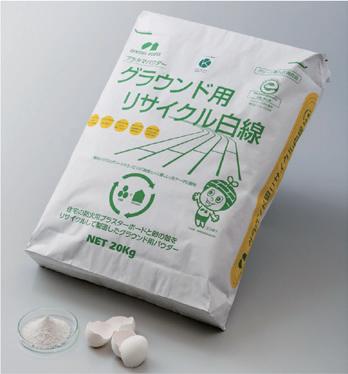

We proactively engage in green procurement, which prioritizes the purchase of environment-friendly products, and we purchase stationery and other office products used by our business offices across Japan in accordance with our Green Procurement Guidelines.
By gathering, compiling and visualizing data on the amount of paper used in offices, we are raising awareness of the need to reduce the amount of paper we consume. In collaboration with Sekisui House Umeda Operation Co., Ltd., we supply domestically produced, bright white 100% recycled paper that is high quality and environmentally friendly (the standard under the Green Purchasing Law is 70% recycled paper content). This recycled paper, produced by the Group, is supplied to offices, including Group companies, throughout Japan.
Initiatives to reduce hazardous waste
We are constantly considering how to use the best economically feasible technologies. One example of reducing hazardous waste is electrodeposition coating materials used for antirust treatment on steel frames. In the past, these contained a very small amount of lead, which could become hazardous waste, but since January 2003, we have switched to lead-free coatings.
With regard to chemical substances used by each department and subject to pollution prevention measures, the Environmental Subcommittee confirms their usefulness and risks and when necessary, instructs improvements, thereby ensuring proper monitoring and supervision of their use.
Throughout the lifecycle of our homes, we strive to minimize risks of chemical substance use through proper EVABAT (Economically Viable Application of Best Available Technology) procedures to prevent and stop pollution in excess of legal regulations. To ensure our own proper handling of chemical substances, we uphold legal regulations, as well as national, municipal and industry guidelines, and in 2007 we created our own Chemical Substance Guidelines from
the standpoint of risk management. We combine legal regulations with new knowledge of chemical substances to reevaluate these target substances and revise related guidelines.
In addressing risks of contamination by hazardous chemicals, it is essential to always strive to balance corporate activities with preventive measures by such means as setting management levels according to the risks of using the chemical substances in products. We set a variety of standards and procedures for handling our products at each phase in their lifecycles.
We work to minimize risks, including the prevention of secondary pollution, by conducting surveys and implementing countermeasures not only for the land of Company facilities, but also for land for which we are engaged in transactions. Prior to engaging in land purchase or sales contracts, we identify risks related to soil and groundwater contamination by means of a pre-screening system using our own soil contamination checklist (including a survey on history of land use; surveys of topography, geology and groundwater; a data survey on surrounding environmental measurements by local governments; a site inspection survey; and legal compliance check).
In the case of land that may contain contaminated soil, such as former factory sites, sellers are increasingly conducting their own voluntary surveys. When purchasing land, a specialized department of the Company scrutinizes all such survey reports. If a problem is identified regarding the completeness of the information, we ask the seller to conduct additional surveys.
Properties that are determined to be at risk of contamination are analyzed by designated research institutions to evaluate the appropriateness of the transaction. Where soil contamination has been discovered as a result of the
investigation, land with minor concentrations and distributions of contamination (land contaminated mainly with heavy metals where complete remediation can be guaranteed) undergoes remediation by soil replacement before the sale. In such cases, we explain the measures that have been taken as a material matter. Land with more serious contamination is not purchased.
At domestic factories on our own sites where contamination could be a risk if no action is taken, we have set up measures and procedures for investigation, prevention, ongoing management and emergency response (prevention and mitigation of contamination), and are implementing contamination risk management.
Approximately 95% of the hazardous waste that we handle is asbestos (Levels 1 and 2) from existing structures, which is strictly treated as specially controlled industrial waste. The remainder is mainly residual substances left over from the use of chemical raw materials handled in domestic production facilities.
For specially controlled industrial waste generated at domestic factories, we comply with the Wastes Disposal and Public Cleansing Act, as well as all related laws and regulations (such as the Ordinance on Prevention of Hazards due to Specified Chemical Substances) and industry guidelines. Procedures are also in place to identify potential accidents and emergencies that could lead to significant environmental impact, to prevent any adverse environmental impact, and to conduct mitigation to minimize the escalation of impact. At the same time, the effectiveness of emergency preparedness and response procedures is maintained through annual testing and internal audits.
Atmospheric and other external emissions of chemical substances from factory production
Substances Subject to the PRTR Law Targets (FY)
• Continue appropriate protective measures
• Maintain zero accidents caused by chemical substances No accidents caused by chemicals used in factory production occurred.
1 Pollutant Release and Transfer Register Law: Law requiring the monitoring of environmental emissions of specified chemical substances and promotion of improved management. Businesses meeting certain conditions specified by Cabinet Order are required to report the amount of specified chemical substances released and disposed of annually.
Emissions and Transfer of PRTR-Listed Substances (FY)
Initiatives for processing hazardous waste and preventing contamination by chemical substances During Factory Production
2 Because they are taken from a government report, the figures here are for the period from April 2022 to March 2023, which differs from the period covered by this report. Atmospheric Emissions of Volatile Organic Compounds (VOCs)3 (FY)
Natural Environment (Soil)
During residential use
3 The Sekisui House
Construction waste
In 2004, we acquired the first Wide Area Certification in the construction industry. We have achieved and maintained zero emissions by collecting 27 categories of waste sorted at our construction sites, re-sorting them into up to 80 categories at our Recycling Centers, and recycling 100% of waste.
Maintain zero release of hazardous waste into the environment during new construction
No release accidents occurred.
During Demolition and Disposal (FY)
Maintain zero emissions of hazardous waste into the environment during demolition work
No environmental release accidents occurred. Same Same
Pollution, waste and resource use costs (including shadow costs) and investment in R&D on reducing or avoiding their impacts
The Resource Recycling Centers at our factories handle waste from construction sites, sorting plastic products for recycling and collecting metals and other valuables. In FY2023, the operating expenses associated with the facilities, from the operation of collection points to disposal (costs imposed by waste issues), totaled ¥524 million. In addition, Group company Konoike Construction invested ¥1 million for experimental research aimed at developing technologies for processing soil containing radioactive substances.
Sekisui House implements initiatives to address issues related to climate change, including water-issues, through the ESG Promotion Committee. Furthermore, at our factories, we have established a management system under ISO 14001, the international standard for environmental management systems, through which we are promoting water-related initiatives.
Sekisui House’s business activities, in such areas as housing, construction and remodeling, use only small amounts of water. However, as the impacts of climate change on human society and ecosystems intensify year by year, water resources are becoming a significant global concern. In particular, over the long term, water shortages are seen as a global water risk, and the conservation of water resources, using water stress as a metric, is a challenge going forward. To secure the sustainability of water resources, we not only avoid water risk in our own businesses, but work to promote efficient water use and prevent water pollution based on the understanding that these issues have a tremendous impact on our supply chains. To this end, we assess water risks, set water use reduction targets, and implement measures to promote the effective use of water resources and manage wastewater quality.
Our five domestic production factories (the Tohoku Factory, Kanto Factory, Shizuoka Factory, Hyogo Factory and Yamaguchi Factory) use groundwater in addition to the municipal water supply and industrial-use water in the coating of steel frame members and the manufacturing and painting of exterior walls used in residential construction. All five factories have formulated water management plans. We are making ongoing efforts to ensure appropriate wastewater quality
management and the efficient use of water resources in these processes. Specifically, we implement wastewater quality analyses at least once a month and work to reduce water consumption through such efforts as reusing treated water for cleaning. Wastewater from all five factories in Japan is discharged into public sewers and rivers after being purified in the factory’s effluent treatment plant. We manage wastewater quality according to voluntary standards set as annual targets that are stricter than the Water Pollution Control Law and local ordinances applicable to factories. In 2023, the measured water quality of discharge was better than these voluntary standards. In this way, we strive to prevent water pollution and protect the water quality environment in the areas surrounding our factories. We share the results of wastewater quality assessments at all five factories in Japan. In the unlikely event that our voluntary standards are exceeded, we share the information on the actualized water pollution risk at a managers’ meeting to prevent recurrences.
We have confirmed that none of the Company’s production sites are located in regions designated as having high or extremely high (>40%) water stress levels as identified using the WRI Aqueduct tools developed by the World Resources Institute (WRI).
However, the Shizuoka Factory is located in a region predicted to have an extremely high (>80%) level of water stress in 2030.¹ Taking a medium- to long-term perspective, the Company considers the Shizuoka Factory as equivalent to a production site in a water-stressed region. Accordingly, we have confirmed the need to strive for the efficient use of water resources and usage reduction and are promoting better use.
1 The Ingleburn Manufacturing and Quality Control Centre in Australia is located in a region predicted to have an extremely high (>80%) level of water stress in 2030, but the facility is not included as it does not carry out manufacturing processes that use water.
Cooperation with customers
In our newly built houses, we have installed the latest water-saving fixtures
(faucets, showers, flush toilets, etc.) supplied by housing device equipment manufacturers as standard equipment in the majority of houses since before 2020. In this way, we are helping to reduce water consumption in houses. Furthermore, for existing homes, we are promoting the use of water-saving fixtures, including by replacing existing fixtures, through the remodeling business.
Cooperation at business sites in water-stressed areas
The Shizuoka Factory uses municipal water drawn from the Oi River system. Based on requests from the Toen Industrial Water Business Association, the Shizuoka Factory proactively uses industrial-use water, helping to reduce municipal water consumption.
Cooperation with public entities
Sekisui House participates in the Ministry of the Environment’s Water Project. This project carries out activities related to offering initiatives, products, technologies and services that promote the effective use of water resources and water-saving sewerage in business activities in Japan.
Group company Konoike Construction is actively involved in renewable energy projects aimed at contributing to decarbonization and is therefore working with municipalities to develop small-scale local energy distribution. In addition to the ongoing project in Higashinada Ward in Kobe City, Konoike construction is working on two micro hydroelectric power generation projects in Okinoshima, Shimane Prefecture and one in Kami, Hyogo Prefecture. From these projects, Konoike construction has reached a comprehensive cooperative agreement regarding the promotion of renewable energy in Okinoshima, where they have made plans to start operations at the Minamidani Power Station in FY2024 to contribute to the region’s revitalization.
Ministry of the Environment’s Water Project (Japanese only)
Cooperation with other regional companies
When shipping and transporting products to construction sites—whether from our own factories or those of our partner manufacturers—we use the Company’s transport cases. After use, these cases are collected from construction sites, returned to factories, washed and reused. The water used in this washing is recirculated within the cleaning facilities, helping reduce water consumption. In addition, the employee cafeterias at some factories are operated by external food service contractors. As one part of water conservation efforts in these operations, we proactively use no-wash rice, which can be cooked without additional washing.
The management of office buildings owned by the Company and its overall real estate portfolio is entrusted to Sekisui House Asset Management, Ltd., which implements appropriate water management, including monitoring and setting numerical targets for the volume of water use.
Located in Brisbane Australia, the mixed-use development project West Village has received high external praise for its environmentally friendly and socially sustainable initiatives. In 2017, it received the highest 6 Star Green Star Communities Certification from the Green Building Council of Australia (GBCA) and in 2023 was honored with the Marketing Excellence Award for exemplary projects by the Urban Development Institute of Australia (UDIA). 2 West Village comprises eight condominium buildings and nearly one hectare of green, open space, including four leafy laneways and two parks. In particular, Morrison Park, which lies within the village, incorporates nature conservation activities and historical property management initiatives. Wastewater in two of the neighboring residential buildings is treated onsite and stored in a 250 kL tank. This, together with a 50 kL rainwater tank is used to water the gardens in the park and contributes to promoting environmentallyfriendly initiatives.
1 Green Building Council of Australia (GBCA): Evaluates the sustainability of buildings, facilities and communities through what is known as the Green Star, the largest national voluntary and comprehensive evaluation system.
2 Urban Development Institute of Australia (UDIA): Australia’s largest real estate industry association
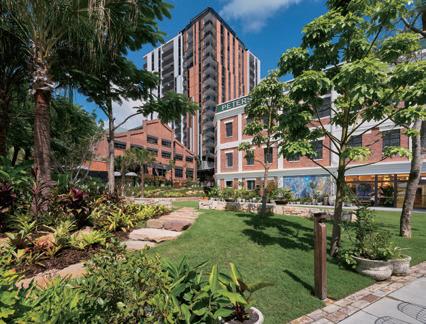
Company facilities in water-stressed regions
Shizuoka Factory: 1 location Number and Proportion of Assets, Production, and Revenue in Water-stressed Regions
Targets for reducing water consumption and withdrawal in water-stressed areas
Looking ahead at future water stress risk, the Shizuoka Factory is actively working to utilize industrial-use water in processes that previously used municipal water to demonstrate its proactive stance on conserving the water environment. Furthermore, the factory has set the target of reducing the consumption of industrial-use water by 80% in its internal wastewater treatment facilities from FY2021 levels by 2030. As part of these reduction efforts, we will promote the internal circulation of water by reusing some effluent and by expanding the use of rainwater. We view water consumption at the Shizuoka Factory as one of our most important indicators for water conservation, and are working to reduce water withdrawal and consumption.
Targets and progress toward reducing the use of water as a raw material
The Company does not use water as a raw material.
Water pollutant discharge
Biochemical Oxygen Demand (BOD) (FY)
Factory
Chemical Oxygen Demand (COD), Phosphorus, Nitrogen
Sites covered: Yamaguchi Factory (FY)
Number of Violations of Permits, Standards and Regulations Related to Water Quality and Quantity (FY)
The Sekisui House Group’s Costs Associated with Water-related Risks (FY)
Wastewater measurements taken throughout the fiscal year are used
concentrations of phosphorous and
Average daily COD and concentrations of
COD and
and nitrogen are multiplied by average daily wastewater volume (m³/day). Monthly discharges are calculated by multiplying the average discharges by the monthly number of operating days of the factory, which is then multiplied by the number of days the factory operated to calculate annual discharges volume.
Note: Data is disclosed for sites subject to Japan’s Water Quality Standards. Indicators marked with ✓ have been assured by KPMG AZSA Sustainability Co., Ltd.
Group company Konoike Construction boasts a long track record and advanced technologies in the cleanup of soil contaminated by a variety of pollutants and, in addition to soil, is working in a wide range of areas including water pollution countermeasures and disaster-related waste disposal. In FY2023, the company implemented research and development as follows.
existing environmental technologies (solidification and
Domestic Factory Water Quality Analysis Results (FY2023)
The Group has established the ESG Promotion Committee as a consultative body to the Board of Directors to determine and implement action policies while confirming that all ESG management initiatives are reasonable and in line with societal expectations.
The committee meets once every three months. Climate change response is positioned as one of the important agenda items of this committee, which evaluates the appropriateness of action policies and progress, and reports important matters to the Board of Directors. The Company-wide, crossdepartmental Environmental Subcommittee reports to the ESG Promotion Committee. Mainly composed of head office department heads involved in environmental management and individuals in charge of environmental management in each business division, this subcommittee meets as needed to conduct more specific and detailed discussions. In addition, the Environmental Subcommittee broadly disseminates the decisions of the ESG Promotion Committee for adoption throughout the Group, including affiliated companies.
The ESG Promotion Committee ensures effective, timely management oversight by providing the director of the Board responsible for each business and other managers with routine reports and instructions on the implementation of ESG initiatives.
P.211 Corporate Governance System
The Group aims for steady progress toward the overall decarbonization of its businesses. Accordingly, to clarify the appropriateness of the Group’s strategy and issues, we anticipate various situations that may occur in the future, then conduct a scenario analysis while taking into consideration the specific circumstances of business activities and resources, as well as physical risks, including assumed business activities, duration and the useful life of assets. We also evaluate transition risks based on potential scenarios for legislation, technology development and market conditions, and identify and address climate-related risks (physical and transition risks) and opportunities for our business activities.
We have already completed risk assessments and adaptation plans for most of our businesses. However, since we have expanded our business into
new areas, including M&A over the past few years, we are planning to create transition plans for all existing businesses based on their specific circumstances by roughly 2025 in order to adapt to physical risks. In addition, we intend to establish a system for early risk assessment and response for 100% of our new businesses in the future, and disclose the necessary related information.
The scenario we refer to is the 1.5°C scenario shown in Table 1. However, even if regulations are strengthened to achieve the 1.5°C scenario, it is possible that individual countries will not be aligned in their actions, resulting in Table 1.
Scenario Analysis Assumptions Item a world as projected in the 4°C scenario, where climate change is even greater. For this reason, we must prepare for both scenarios simultaneously. In FY2021, Japan set a new greenhouse gas emission reduction target of 46%, compared to the 2013 levels, by 2030 with a
view to achieving carbon neutrality. Based on this target, various medium- to long-term policies related to the housing industry were also set. For this reason, we have conducted a large-scale scenario analysis for all of our businesses and are reviewing our strategies. The potential financial impact of the major risks and opportunities identified through the scenario analysis, as well as our responses, are shown on the next page.
The financial impact and assumed time period are defined as follows. Financial impact—Large: ¥20 billion yen or more; medium: ¥10 billion or more; small: less than ¥10 billion yen
Assumed time period—Short term: up to 3 years from the present; medium term: up to 2030; long term: up to 2050 Item
Scenarios published by various international organizations, including IPCC SSP1 1-1.9 (countries adopt ambitious climate policies to achieve 1.5°C or lower and net zero CO2 emissions by 2050), IPCC SSP 3-7.0 (CO2 emissions will not begin to decline even in 2050, resulting in high temperatures, heavy rainfall, storms and other impacts), IEA SDS (the Paris Agreement and other targets will be achieved through the development of energy policies and investments; many countries and companies will achieve 2050 net zero), IEA NZE 2050 (aimed at achieving net zero globally by 2050), and NGFS (Delayed Transition: due to the slow introduction of new climate policies and different levels of action in each country, emissions will not begin to decline until 2030, and then move toward net zero), as well as announcements by the Japanese government (NDC) and related councils, etc., such as “Reduce Japan’s greenhouse gas emissions by 46% from the 2013 levels by 2030, with net zero emissions by 2050,” “Reduce greenhouse gas emissions in the residential sector by 66% from the 2013 levels by 2030,” “Ensure energyefficiency at the level of the ZEH standard for new houses built in FY2030 and beyond,” and “By 2050, popularize houses throughout the entire housing stock that can contribute to carbon neutrality.”
Our model for transition risk assumes that the IPCC SSP 1-1.9, IEA SDS and IEA NZE 2050 scenarios of a 50% reduction in global CO2 emissions by 2030 and a reduction to zero by around 2050 will require government policies including a high carbon tax and a market transition to decarbonization.
In addition, as stated in the NGFS Delayed Transition scenario, continuing public and corporate initiatives to reduce CO2 emissions under existing governmental measures until 2030 is inconsistent with the 1.5°C scenario. Moreover, the best temperature increase estimate, stated in the IPCC SSP 3-7.0, is 2.1°C rise over the medium term (from 2041 to 2060). Along with other parameters, these figures have been used as assumptions for physical risk.
Subject companies and businesses
Quantitative/qualitative
of Japanese market size
All existing businesses of the Sekisui House Group companies2 (including the entire upstream and downstream value chain).
Mainly a qualitative analysis of all existing businesses of the Sekisui House Group. Quantitative estimates of financial impact amounts for particularly important opportunities and risks.
The Sekisui House Group generates most of its sales in the Japanese market (about 83% of sales from February 1, 2023 to January 31, 2024). The Japanese housing market is expected to contract gradually due to the shrinking population, declining birthrate and aging population. While this trend is by no means insignificant, it has not been considered in this analysis, as the focus is climate change-related impacts.
1 IPCC: Intergovernmental Panel on Climate Change; SSP: Shared Socioeconomic Pathways
2 Sekisui House and 342 consolidated subsidiaries (as of January 31, 2024)
Transition risk: Introduction of carbon pricing
Impact
Carbon pricing has been widely adopted around the world. In Japan, the government is considering the introduction of a carbon tax, and it may be introduced relatively soon.
Financial impact Assumed time
Medium-term
Response
The Group as a whole and its suppliers have a long way to go in order to decarbonize their business activities in the medium term, and if a carbon tax or emissions trading unit price of around 10,000 yen/t-CO2 is imposed, the impact will be significant. We have already started a variety of initiatives throughout the value chain, including promotion of RE100, energy conservation in offices and production facilities, and reduction of CO2 emissions in the building materials manufacturing stage through collaborative efforts such as questionnaires and seminars with suppliers, and we intend to reduce this impact as quickly as possible.
Transition risk: Rising housing prices and a shrinking market
Impact
In the long term, the new construction market itself may shrink as housing prices soar due to the need to comply with stricter regulations required for carbon neutrality, and as the number of houses with poor energy efficiency and seismic resistance decreases, and more high-quality housing stock is being circulated in the market.
Financial impact Assumed time
High Long-term
Damage to Company-owned assets due to weather-related disasters
The Sekisui House Group conducts risk management based on the following assumptions about rain or wind storms of a severity it has never yet experienced.
Impact
Nationwide weather disasters could damage assets owned by the Group (factories, office buildings and other business locations, production facilities, vehicles, etc.), making it impossible to continue operations and incurring significant repair or replacement costs.
Financial impact Assumed time
High Medium-term
Response
Response
Because our efforts are ahead of the curve, the impact on regulatory tightening in the short to medium term is expected to be small. However, in response to further regulatory tightening in the long term, we will need to work systematically on the development of cost-competitive decarbonized housing. In addition, we intend to strengthen our supplied housing business, in preparation for the contraction of the new construction market.
Transition risk: Decline in rental business revenues due to market changes
Impact
Response
Managed properties that do not have sufficient decarbonization performance will lose competitiveness, leading to lower occupancy rates and rents.
Financial impact Assumed time High Long-term
We will strive to increase the ratio of ZEH units in managed properties and promote decarbonization remodeling of non-ZEH units in order to maintain and increase the value of rental housing that appeals to renters.
Transition risk: Decline in rental business revenues from managed properties with higher disaster risk
Impact
Response
Managed properties in disaster-prone areas will have lower occupancy rates and rents due to the increase in climate change-related disasters (floods due to rivers overflowing, landslides, etc.).
Financial impact Assumed time High Long-term
We recognize this as an issue, and are continuing to study this issue by checking government hazard maps and understanding the hazards in areas where construction is planned.
Transition risk: Costs required to decarbonize business activities
Impact
Response
In order to decarbonize our business activities, various costs will be incurred, such as converting business locations to ZEB, electrifying Company vehicles, and making production facilities energy-efficient.
Financial impact Assumed time
Low Medium-term
The Company is systematically promoting decarbonization in all of its business activities, and the risk of incurring major costs that would affect its business is low at this point.
Impact
The Sekisui House Group operates throughout Japan, with the exception of Okinawa Prefecture, and has already established a system that allows its business to continue through support from undamaged areas in the event of a disaster in some areas, including the head office functions. Such business continuity planning (BCP) measures are properly managed by the Risk Management Committee and updated as necessary. The amount of damage to the five factories in Japan was calculated based on the assumed inundation depths using river flooding hazard maps or internal flooding simulations, and it was found that for the four of these factories other than the Hyogo Factory, there is the potential to suffer inundation damage. A more detailed analysis based on the IPCC RCP 8.5 scenario was conducted for the Kanto Factory, which is expected to suffer the most damage, and the expected damage has been confirmed to be within the coverage of the insurance policy that is already in place. Assuming, however, an increase in the severity of natural disasters in the future and the simultaneous occurrence of large-scale disasters throughout Japan, our business is expected to suffer extensive damage, and we will continue to examine ways to strengthen our disaster resilience.
The frequency of supply chain damage and difficulties in obtaining construction materials will increase due to the intensification of disasters associated with climate change, as well as the increase in extremely hot days and heavy snowfalls. In addition, construction sites may be affected for the same reasons, and administrative costs may increase due to longer construction periods.
Response
Although the Company already has measures in place to decentralize the supply chain in anticipation of damage to suppliers’ factories and transportation routes, and to prevent heat stroke at construction sites, continued consideration is needed in anticipation of an increase in the scale and frequency of natural disasters.
Before purchasing land for resale, we require the use of hazard maps to conduct an analysis of possible risks. When constructing large buildings, such as condominiums, we also refer to hazard maps during planning to minimize the risk of damage. However, the impact of climate change is growing year by year, and the scale and frequency of natural disasters may increase, so the Sekisui House Group will continue to study how to deal with related risks.
Major opportunity: Increase in ZEH/ZEB orders
Major opportunity: Decarbonization of the production stage
Impact
Response
Impact
Response
Impact
Response
Impact
Response
The Japanese government has set goals that include reducing greenhouse gas emissions in the residential sector by 66% compared with the FY2013 baseline by 2030, positioning ZEH and ZEB as key measures. In addition, demand for ZEH and ZEB is expected to increase in the future, as consumers become more ethically conscious and businesses further decarbonize. Moreover, we anticipate increasing demand for ZEH specification products overseas. Financial impact Assumed time
Impact In decarbonizing the entire value chain, efforts by suppliers to reduce emissions at the construction material manufacturing stage are fraught with difficulties. Financial
Medium-term
The ratio of our detached house ZEH exceeds 90%, and ZEH is already a standard specification. Currently, we are also beginning to actively promote ZEH in rental housing and condominiums. We will expand ZEH and ZEB orders for the entire Group by leveraging our track record of receiving the largest number of ZEH orders in Japan.
Major opportunity: Increase in rental business revenues by converting managed rental properties to ZEH
The Japanese government intends to require ZEH-level energy efficiency in all new buildings constructed in and after 2030. In addition, ZEH conversion of rental housing will eventually become more common, so the need for ZEH rental housing could increase dramatically as consumers become more ethically conscious.
Financial impact Assumed time
High Medium-term
Since completing Japan’s first rental housing that meets the ZEH standard for all units in 2018, we have been working to promote ZEH units that can appeal to residents. The Company has already received orders for more than 42,000 units and is preparing for a future expansion of demand for rental ZEH units, especially among ethically conscious consumers.
Major opportunity: Increase in orders for decarbonization remodeling
The government’s goal of reducing greenhouse gas emissions in the residential sector by 66% compared with 2013 by 2030 requires energy-saving renovations to housing stock. For this reason, various reform support policies are being implemented and orders for decarbonization remodeling are proceeding well.
Financial impact Assumed time High Medium-term
Orders for insulation retrofitting, power generation and storage cells are on the rise as a result of customer requests and remodeling proposals. In particular, Idocoro Dan-netsu, a partial insulation improvement concept centered on areas where residents spend the most time, has been well received because of the small burden of the cost and construction period for the customer. These remodeling proposals also highlight enhancing disaster resilience. We will continue to promote remodeling proposals that are realistically feasible for widespread use.
Achievement of RE100 is essential to the realization of a decarbonized society. However, procuring renewable energy usually entails significant costs.
Financial impact Assumed time
Through the Sekisui House Owner Denki initiative, renewable energy power is procured at almost no cost. Considering the possibility of the electrification of energy used in business in the future, such as a shift to EVs for Company vehicles, the cost of electricity may increase with conventional procurement methods. The cost reductions achieved through the Sekisui House Owner Denki initiative can be utilized to secure funding for other purposes, and can therefore be regarded as an opportunity.
Response
Since a high percentage of our construction materials, such as exterior walls and frameworks, is produced in-house, it is easier to reduce greenhouse gas emissions from material production through planned technological development and capital investment than when relying more on external procurement, thus reducing the impact of carbon taxes. The cost reductions are considered as an opportunity, because they can be utilized to secure funding for other purposes.
Major opportunity: Increase in infrastructure construction and waste disposal due to more frequent and severe weather-related disasters
Impact
As sudden heavy rains are expected to occur more frequently, demand for infrastructurerelated construction related to stream and flood control, including the replacement and maintenance of aging existing infrastructure, will increase. In addition, demand for proper waste disposal following damage caused by greater than expected rainfall will increase.
Financial impact Assumed time
Low Long-term
Response
To meet increased demand for infrastructure development related to disaster countermeasures, we will build up expertise in extending service life through preventive and protective infrastructure renewal and allocate personnel as needed in preparation for receiving orders. We will invest in technological development and the introduction of new technologies to increase competitiveness and differentiation by such means as offering waste disposal with high recycling rates for buildings, household goods and other waste materials arising from wind and water damage.
Confirmation of the resilience of the Sekisui House Group’s existing strategies
The review found that the Sekisui House Group’s strategy has already begun to address decarbonization and extreme weather events in all of its business activities, and it has been determined that no fatal impacts are currently apparent, either in terms of transition risk to a decarbonized society or physical risk due to climate change.
As part of the Group-wide risk management process, the Group conducts assessments to determine climate changerelated risks and opportunities based on the TCFD recommendations. Risks and opportunities are identified for the entire Group, led by the principal department of each business, and the results are aggregated by the Environmental Subcommittee, which conducts a financial impact assessment. Major risks and opportunities that are identified based on this process are reviewed by the ESG Promotion Committee, a consultative body to the Board of Directors, before being reported to the Board of Directors, which considers risk mitigation, transfer, acceptance and control, as required. Furthermore, the results are shared by the Risk Management Committee, and reviewed and managed within the Group’s overall risk management system.
In 2008, the Group declared its Vision 2050, which aims to achieve zero CO2 emissions from housing by 2050. The Group has already begun various initiatives to achieve a zero CO2 emission balance in all business activities, including the use of renewable energy.
As a milestone toward achieving this goal, by 2030, compared with FY2013 levels, we aim to reduce our own CO2 emissions in Scope 1¹ (direct emissions: fuels consumed for factories, offices, vehicles, etc.) and Scope 2¹ (indirect emissions: energy consumed by the Company, such as electricity) by 75%, and those in Scope 3, Category 11¹ (use of sold products) by 55%. These targets have been approved by the Science Based Targets initiative as in line with a 1.5°C trajectory. We have revised the targets for Scope 1 and Scope 2 reductions upward to a more ambitious goal for FY2030 after meeting the 50% reduction target in FY2022.
In addition, as an RE100 member company, we will convert to renewable sources of electricity for our business operations, adopting targets of 50% by
1
2030 and 100% by 2040. Various concrete measures have been initiated to achieve these targets, and progress is currently on track, with the 2040 target expected to be achieved roughly 10 years ahead of schedule.
As indicated thus far, the Group has already taken measures to address the anticipated risks from climate change and does not expect any significant financial burden. However, in order to ensure that the Group continues to implement decarbonization management as it has in the past, we will continue to monitor the major risk factors with significant financial impact that have been identified in this analysis and strengthen the necessary initiatives while further quantifying risks and improving the accuracy of the analysis. As for challenges going forward, we believe that the mission of the Group is to contribute to the transition to a sustainable society by further quantifying and improving the accuracy of risks related to newly consolidated Group companies.
In addition, climate change involves many uncertainties, so we need to gather a broad range of intelligence from outside the Group. In order for the Group to demonstrate leadership in the international community, we will further focus on stakeholder engagement through participation in various domestic and international initiatives, including the United Nations Framework Convention on Climate Change (UNFCCC) and the Global Alliance for Buildings and Construction (GlobalABC), of which we are the only member in the Japanese private sector.
The Group has established the ESG Promotion Committee as a consultative body to the Board of Directors to determine and implement action policies while confirming that all ESG management initiatives are reasonable and in line with societal expectations. The committee meets once every three months. Along with climate change, addressing biodiversity and natural capital is one of the key issues discussed by the committee. The committee evaluates the appropriateness of action policies and progress, and reports important matters to the Board of Directors. Additionally, the Sekisui House Group Human Rights Policy, the CSR Procurement Guidelines and the Wood Procurement Guidelines all establish policies and standards aimed at preventing human rights violations. By following these policies and guidelines, we strive to have zero biodiversity-related and natural resource-related human rights violations in our business activities and procurement. In particular, the Wood Procurement Guidelines stipulate that free, prior, and informed consent (FPIC) be followed along the entire supply chain for all indigenous peoples near procurement sites. Additionally, we have established wood procurement policies that ensure we do not procure wood from conflict areas.
As with climate change, regarding biodiversity and natural capital, the Group works to clarify the appropriateness of its strategy and issues therein by anticipating various situations that may occur in order to make steady progress toward a world where people live in harmony with nature.
The Company considers risks and opportunities related to nature as well as assesses its impact and dependency based on the LEAP approach in the TNFD (Figure 1). First, risks and opportunities related to the environment in the housing business are identified. Then, the Company organizes initiatives and evaluates the priority level of responses to these risks and opportunities. We conducted an advanced analysis of wood procurement in the material procurement process, which is one of the four stages of housing operations (material procurement, manufacturing and processing, construction, and demolition) and has a high impact and dependency on nature, using big data on biodiversity possessed by Think Nature Inc. The Company has identified the interface with nature that bear particular importance and evaluated impacts and dependencies.
In Value Report 2023, we located potential impacts and dependencies using ENCORE3 and other such methods on procurement data2 for the housing business (detached houses and rental housing). The results (Figure2) of this were displayed in a heat map. Specifically, this analysis divided housing business processes into the four phases of material procurement, manufacturing and processing, construction, and demolition. For each phase, we located impacts on nature, including the conversion of land, freshwater and ocean areas as well as atmospheric, water, soil and waste pollution. We also analyzed dependencies on ecosystem services, such as water supply, natural resources soil quality regulation,
flood mitigation and global climate regulation. From these analyses, we found that our material procurement process is potentially dependent on many ecosystem services. We also confirmed the potential impacts on nature from lumber harvested and mineral resource mining, including the conversion of land, fresh water and ocean areas as well as atmospheric, water, soil and waste pollution.
2 For wood, primary producing countries are inferred from procurement data of secondary suppliers and beyond. For non-wood material, these countries are inferred from general statistical procurement data based on procurement amount and monetary value.
3 ENCORE Partners (Global Canopy, UNEP FI, and UNEP-WCMC). ENCORE: Exploring Natural Capital Opportunities, Risks and Exposure. [Online], [1/2023 of the version downloaded], Cambridge, UK: the ENCORE Partners. Available at: https://encorenature.org. DOI: https://doi.org/10.34892/dz3x-y059. ENCORE is an analytical tool on the TNFD Tools Catalogue. By helping users better visualize and understand the impact of environmental change on the economy, ENCORE can be used to understand how common business processes impact and depend on nature.
1‒2 Identifying ecologically sensitive locations (Locate)
To start, we evaluated the biodiversity importance2 and the biodiversity integrity (hereafter referred to simply as “importance” and “integrity” respectively) of natural forests (Figures 3 and 4), focusing on the top 11 countries1 that accounted for 90% of our wood procurement in FY2022. In artificial forests, we only evaluated the importance (Figure 5). The distribution of the evaluation results for the 11 countries is shown in Figures 6 and 7. Our findings revealed that, out of the 11 countries evaluated, the highest conservation priority areas for natural forests are Indonesia and Malaysia, and the highest conservation priority areas for artificial forests are Indonesia, Malaysia, Japan and Vietnam. Understanding the impact in these areas is therefore of the utmost importance.4
1 Approximately 90% of the Company’s total procurement volume comes from these top 11 countries.
2 An index showing the importance of biodiversity for each location calculated based on the abundance and rarity of vertebrate animals and tree species. In Figures 3 and 5, the colored areas represent natural and artificial forests in the top 11 countries we procure wood from, respectively.
3 An index showing to what extent pristine natural conditions are being lost, calculated based on habitat and natural forest distribution data. In Figure 4, the colored areas represent the natural forests in the top 11 countries we procure wood from, respectively.
4 Scores for natural and artificial forests were calculated using meshes (or grids), with natural forests shown in Figures 3 and 4, and artificial forests shown in Figure 5. Values representing numerical means for natural and artificial forests are displayed in Figure 6 and Figure 7, respectively. For natural forests, high conservation priority was assigned to the top 30% in biodiversity importance and those above average in integrity. For artificial forests, high conservation priority was assigned to the top 30% in importance.



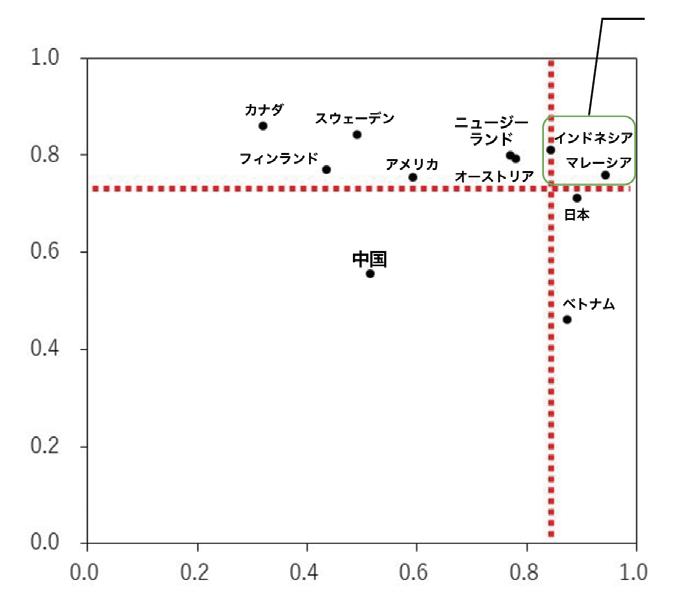
Biodiversity importance
Top 30% in biodiversity importance and higher than the average for biodiversity integrity
Top 30% in biodiversity importance
For natural forests, sites with high importance (red areas in the figure) and high integrity (dark indigo areas in the figure) are deemed as having high conservation priority. For artificial forests, sites with high importance (red areas in the figure) are considered a high conservation priority. The 11 countries we procure wood from are colored on both maps.
Note: The biodiversity importance score is a relative representation of the importance of each location from 0.0 to 1.0, with 1.0 being an area of land with utmost importance to the world’s natural environment and 0.0 being an area of land that has lost all importance as a natural environment.
Note: The biodiversity integrity score is a relative representation of the completeness of each location from 0.0 to 1.0, with 1.0 being an area of land in a completely pristine condition and 0.0 being an area of land that has been completely destroyed.

Biodiversity importance
Figure 7. Importance Evaluation Result of 11 Countries – Artificial
2‒1 Evaluation of the impact of wood procurement on nature (Evaluate)
We analyzed2 the magnitude and impact distribution of the four forestry-related factors as evaluated by ENCORE—terrestrial ecosystem use, GHG emissions, water pollutants and soil pollutants—for the top 11 countries from which we procure wood. We identified terrestrial ecosystem use as having a very significant impact, affecting the countries identified as being sensitive from a biodiversity perspective in the previous section (Indonesia, Malaysia, Japan and Vietnam). In particular, when considering procurement volume distribution, we found relatively large impacts on artificial forests throughout Malaysia; natural forests in Kalimantan, Indonesia; artificial forests in central Java, Indonesia; and artificial forests in the Chugoku and Shikoku regions of Japan as well as on the Pacific side of Honshu south of the Kanto region. We recognize that wood production in these regions might be a threat to the regional terrestrial ecosystems.
1 Refers to land conversion of terrestrial ecosystems for purposes such as farming, forestry or urban development.
2 The magnitude of terrestrial ecosystem use was calculated by multiplying geographical data on the degree of threat to the terrestrial ecosystem with the volume of procurement distribution. The degree of threat to the terrestrial ecosystem was measured by scoring the degree of concentration of rare species threatened by land use and development. It should be noted that land use and development are done for reasons other than wood production. Therefore, there could be other factors at play apart from wood production in areas where the degree of threat to the terrestrial ecosystem is high.
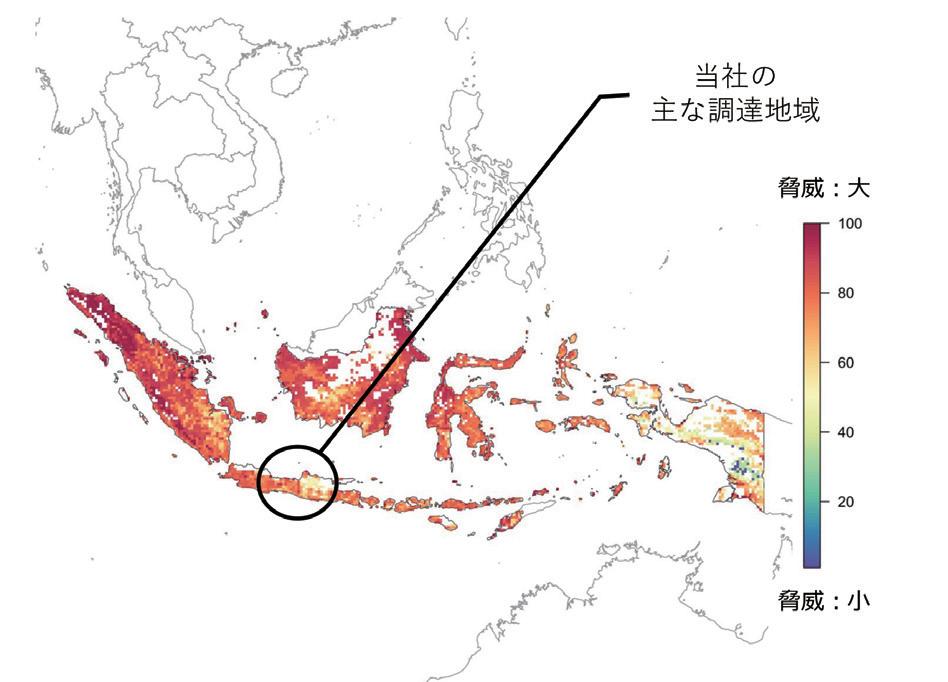
Figure 8) Artificial forests in the central part of Java comprise the Company’s main wood procurement area in Indonesia. The impact on the terrestrial ecosystem in this procurement area is relatively low compared with other areas in Indonesia. However, Indonesia’s importance to biodiversity is high, having a large nationwide impact on the terrestrial ecosystems. Therefore, it is vital to properly select and manage sustainable procurement practices.
Note: The threat to terrestrial ecosystems score is a relative representation of threat levels of each location from 1 to 100, with 100 being an area with the highest level of global threat and 1 being an area with the lowest level of global threat.
2‒2 Evaluation of the dependency of wood procurement on nature
To identify areas lacking in ecosystem services and that are vulnerable to dependencies on nature, we analyzed and scored forestry-dependent ecosystem services, as identified by ENCORE, for each of the top 11 countries from which we procure wood. Additionally, the status of ecosystem services within each country was analyzed. We found areas in the following regions to be lacking in functions that wood procurement activities depend on. Ground stabilization and erosion control in the Chugoku and Shikoku regions of Japan, pest control functions in the central and southern parts of Sweden and in all natural forests in the United States as well as artificial forests in its northern and western regions, and flood protection functions in the northern parts of Austria.
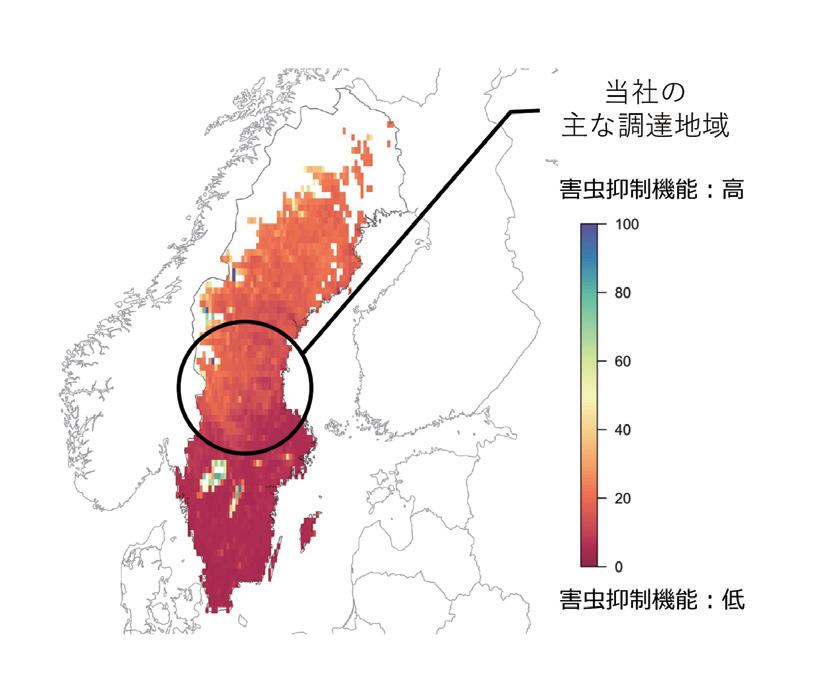
Figure 9) In Sweden, the Company’s main procurement sites are in the central region. Pest control functions in Sweden are especially weak in the southern areas, and serious damage caused by harmful insects has been done in those regions. However, due to factors such as climate change, it is entirely possible that damage caused by harmful insects will not be limited to the south but will extend to the central areas of the country.
Note: The pest control function score is a relative representation of pest control capabilities of each location from 1 to 100, with 100 being an area with the degree of pest invasion being the smallest and pest control functions being the highest globally and 1 being an area with the degree of pest invasion being the largest and pest control functions being the lowest globally.
3‒1 Identification and assessment of risks and opportunities in the housing business (Assess)
Firstly, we organized the nature-related risks to the Company, based on impacts and dependencies on nature throughout the value chain, into the categories of physical risks and transition risks. In terms of opportunities, we examined opportunities that contribute to risk avoidance and mitigation as well as opportunities based on future market information.
Moreover, we conducted nature-related scenario analyses and evaluated the priority of risks and opportunities based on such analyses. We constructed exploratory scenarios2 for the year 2040 based on perspectives of the state of nature in terms of the condition of biodiversity and rise in temperatures (horizontal axis) as well as global trends in technology, society, regulations and politics (vertical axis). In the four-quadrant scenario consisting of two uncertainties as recommended by the TNFD, we titled Scenario 1 as “A World of Sustainable Systems” and Scenario 3 as “A World Headed for Ruin.” Next, based on the scenarios we created, we held internal workshops for relevant employees and discussed the nature-related risks and opportunities the Company could face under each scenario.
The scenario analysis identified a wide range of opportunities and risks. For risks, these included physical risks such as the destabilization of wood procurement and transition risks such as loss of market share due to a change in consumer environmental preferences. Such opportunities as risk reduction through effective resource utilization as well as possible business expansion that has a positive impact on nature (including agricultural businesses and urban greening) were also identified.
Tables 1 and 2 show risks and opportunities that have a high likelihood of occurring and may have a significant impact on the Company. Moving forward, we plan to discuss those risks and opportunities internally to properly refine impacts and likelihoods and to consider responses accordingly.
1 Information on business areas highly relevant to the Group is collected in “The Future of Nature and Business” report issued by the World Economic Forum.
2 In constructing the scenarios, we used WWF’s Living Planet Report 2022 and IPCC’s Sixth Assessment Report (2021) as references to set fixed conditions regarding the state of nature in 2040. In Scenario 1, with the horizontal axis representing the state of nature, the ecosystem is gradually recovering and the global environment is projected to improve due to achievement of the 1.5°C scenario. The vertical axis represents market and non-market principles moving in the same direction. That is to say, it supposes a world where society, laws, regulations and the economy are all moving in a way that is beneficial for the environment. Scenario 3, on the other hand, envisions a world where ecosystems degrade and climate change-induced rises in temperature continue. The vertical axis shows market and non-market principles running counter to each other and society, laws, regulations and the economy moving in a way that is detrimental or has no impact on the global environment.
Ecosystem service conservation
Alignment of market and non-market forces
Misalignment of market and non-market forces
Note: Created based on the TNFD v1.0 “Guidance on scenario analysis”
Ecosystem service degradation
Destabilization of wood procurement
Destabilization of mineral resource procurement
Destabilization of water resource procurement
Natural disaster-related business disruptions
Restrictions on mineral resource mining
Increase in external demand for technology development and capital investment in new technologies aimed at reducing the environmental impact across the entire value chain
Loss of market share due to change in consumer environmental preferences
Loss of stakeholder trust due to delays in addressing environmental concerns in areas such as: product development, procurement, production processes, sales, etc.
Table 2. Nature-related Opportunities of the Company
Increase in demand for housing that is low-cost and has a small environmental impact as achieved through the effective use of resources
Increase in demand for housing that is clean, eco-friendly and adheres to sustainable material procurement
Increase in demand for low-risk wood procurement
Increase in demand for resilient housing
Increase in demand for highly energy efficient, eco-friendly houses
Increase in demand for urban and residential greening as well as agricultural businesses
Increase in demand for circular economy businesses
of ground stabilization and erosion control
3‒2 Qualitative assessment of the financial impact of wood procurement-related risks (Assess)
The qualitative financial impact of wood, an important material, was evaluated in terms of the physical risk “destabilization of wood procurement” and organized as shown in Figure 11. We plan to analyze the details regarding the evaluation of these risks and conduct a quantitative impact analysis.
As part of the Group-wide risk management process, the Group conducts assessments to determine nature-related risks and opportunities as well as impact and dependency evaluations based on the TNFD’s LEAP approach. First, activities that have a potential nature-related impact or dependency throughout the entire organized value chain are identified. Then, nature-related risks and opportunities are identified from the results of the scenario analysis.
in cost of materials due to switching or adding suppliers Adjustment of selling prices of products to match rising cost of materials
in procurement volume due to reduction in suppliers Degradation of product quality due to reduction in procurement sources
Increase in costs due to rising existing expenses
Decrease in sales due to reduction in order volume Decrease in sales due to reduction in order volume
October 2023, we established the Wood Procurement Policy as a fundamental policy to respond more effectively to recent social conditions and we have repositioned the 10 Wood Procurement Guidelines and revised them to better clarify the Company’s stance on the material issue of Contributing to a Sustainable Society. We believe that sustainable procurement helps enhance the Company’s resilience by promoting the efficient use of resources. Moving forward, we will carefully monitor information based on these guidelines, verify details individually, and work to reduce risks in procurement areas where we have identified impacts and dependencies.
Decrease in sales due to construction delays and/ or shipping restrictions
Using detailed procurement information on wood, we identified geographic points of interface with ecologically sensitive locations. After identifying impacts and dependencies, we evaluated importance based on qualitative and quantitative analyses.
Furthermore, starting with suppliers, we will continue to strengthen engagement with important stakeholders of our business activities.
The Company is currently implementing initiatives aimed at reducing risks and creating opportunities, such as those listed below. We will continue to thoroughly consider and conduct new initiatives.
mitigation: Sustainable wood procurement
Our FairWood procurement of wood and wood products gives due consideration to the forest environment and local communities in producing regions. Sekisui House established the 10 Wood Procurement Guidelines in 2007, which encompass not only legality, but also ecosystems in producing regions. In
Opportunity creation:
Measuring the biodiversity effects of the Gohon no Ki Project In 2019, working with the Kubota Laboratory in the Faculty of Science of University of the Ryukyus and Think Nature Inc., we started joint research to analyze the effectiveness of quantitative assessments of biodiversity conservation from a macro perspective. The results showed that the Gohon no Ki Project can contribute to the restoration of biodiversity in urban environments facing severe ecosystem degradation, and that the effect can be further amplified by expanding the project in the future. Additionally, we conducted joint research on biodiversity and well-being with the Laboratory of Conservation Ecology in the Graduate School of Agriculture and Life Sciences / Faculty of Agriculture, The University of Tokyo. This research focused on examining the impact that a green garden rich in biodiversity has on people’s health and happiness. The Gohon no Ki Project contributes to biodiversity, comfortable living, and creating brand value for the Company. In this way, we will actively explore new areas, such as examining the social effects of nature-related initiatives.

In its Sustainability Vision 2050 plan, the Group has set the goal, as a challenge for 2050, of maximizing ecosystem networks through business operations. We aim not only to achieve no net loss (to maintain the value of the ecosystem), but also to become nature positive (to enhance the value of the ecosystem through our business operations). With this commitment, we remain focused on the Gohon no Ki Project, a landscaping and greening project that considers the ecosystem, as well as FairWood sustainable wood procurement.
We are also promoting initiatives aimed at achieving a circular economy and decarbonizing all business activities, including those related to supply chains.
1 Sustainability Vision 2050
4‒1 Setting metrics and targets (Prepare)
The Group aims to properly evaluate and manage risks and opportunities that have large nature-related impacts and dependencies. To achieve this, we establish appropriate assessment metrics in line with recommendations from the TNFD and disclose actual results, mainly focused on the core disclosure metrics.
We will disclose all TNFD-established core disclosure metrics that are relevant and important to the Company. We have established assessment metrics from two perspectives: indicators that should be monitored to achieve our Sustainability Vision for 2050 and metrics that should be monitored to stabilize business foundations and ensure responsible business activities.
We have disclosed results for some of the core metrics that can be presently calculated (Table 3). Going forward, we will calculate results for core metrics that were not disclosed at this time as well as results for important assessment indicators, which we will include as additional disclosure metrics.
We also plan to establish and disclose target values for indicators using methodologies advocated for by the Science Based Targets (SBTs) for Nature and other like frameworks.
Indicators established by the Company in accordance with TNFD core indicators
Table 3. List of Company-established Indicators Corresponding to TNFD (v1.0) Core Indicators for Impact and Dependency
Table 4. List of Company-established Indicators Corresponding to TNFD (v1.0) Core Indicators for Risks and Opportunities as well as Response Policies
Category TNFD indicators Company-established indicators Response policies
Assets/liabilities/ revenue/expenses vulnerable to nature-related transition risks
Quantity and proportion of assets vulnerable to transition risks
Thorough evaluation of risks and opportunities and consideration regarding relevancy of disclosure. Quantity and proportion of assets vulnerable to physical risks
Risk
incidence of discharge Wastewater discharged Wastewater volume and its concentration of pollutants Group-wide
m
location of of wastewater P. 148.
concentration in wastewater from manufacturing and processing activities P. 150. There are no pollutants in wastewater from construction and demolition activities.
Opportunity
Description and value of significant fines/penalties received/litigation action for the current fiscal year
Compliance with environmental laws and regulations
Amount of capital expenditure, financing or investment deployed towards nature-related opportunities
Amount of opportunity-related capital expenditure
Amount of opportunity-related investing
There were no significant violations of environmental laws and regulations, including those related to soil, groundwater or air pollution, in FY2023.
Resource use/ replenishment
Waste generation and disposal
Quantity of waste generated in manufacturing and processing, construction, demolition and office-related activities, with the amount in parentheses ) representing hazardous waste generated 1,143,600 (714 t)
Quantity and rate of recycling in manufacturing and processing, construction, demolition and office-related activities 1,127,700 t, 98.6%
Recycling rate in new construction 100%
Non-GHG air pollutants
Water withdrawal and consumption from areas of water scarcity
Quantity of highrisk natural commodities sourced from land/ocean/ freshwater
Quantity of non-GHG air pollutants from manufacturing and processing activities NOx:
Quantity of water withdrawal and consumption from water-stressed areas in manufacturing and processing activities 58,700 m 6,400 m
Quantity of wood procured from tree species other than those identified as endangered (S or A rank wood procurement amount)
237,061 m (97.2% of total procurement amount)
If a significant risk is discovered, we take appropriate actions in consultation with relevant departments and measures, such as reducing transactions based on supplier assessment results.
Invasive alien species and other
Placeholder indicator: measures against unintentional introduction of invasive alien species (IAS)
Risk of IAS introduction through implementation of the Gohon no Ki Project
Areas with large impacts and dependencies on wood production
The Company uses the government’s list of invasive species, created to prevent ecosystem damage, in its landscaping and greening business in order to avoid the risk of planting of IAS tree species.
See TNFD Disclosure “Strategy” section.
State of nature
Placeholder indicator: Ecosystem condition
Increase in the diversity integration index for Japan’s big three metropolitan areas (Tokyo, Nagoya and Osaka as a result of the Gohon no Ki Project
See Evaluating effectiveness quantitatively using big data on biodiversity. P. 135
Increase and proportion of revenue from products and services producing demonstrable positive impacts on nature with a description of impacts
Increase in revenue from activities that have a positive impact on nature over a given period of time, and said positive impact
Thorough evaluation of risks and opportunities and consideration regarding relevancy of disclosure.
We have conducted a multiple-perspective regional level analysis on wood, an important material for the Company, and have gained a deeper understanding of its impacts on nature and causes of dependencies.
Moving forward, we will continue to refine our analyses of nature-related impacts and dependencies in order to make better determinations regarding sustainable procurement. We will also conduct detailed analyses for the entire process of our housing business based on priority.
We will then closely examine risks and opportunities important to the Company and quantitatively analyze their impact, which will in turn lead to risk reduction and opportunity creation.
Commitment in the event of inconsistencies between trade association positions and company policy on climate change
As an industry leader, Sekisui House is positioned to play a leading role in decarbonization efforts. Industry trade associations have developed a good understanding of the Paris Agreement and the Japanese government’s policy on climate change, and there is no inconsistency among industry activities in this area. In the event of inconsistencies between Sekisui House’s policies and the climate change position of trade associations due to future changes in social conditions or other factors, or the event that the Company deems trade associations’ stance on climate change insufficient, we will take the lead in engaging with industry actors to promote consistency with national policy.
Sekisui House’s factories and other facilities have installed photovoltaic and other alternative systems to generate power for use in-house. (FY)
evaluation system. In particular, we strive to reduce environmental impact through ZEH and promote harmony with the environment through the biodiversity-friendly Gohon no ki Project while creating comfortable living spaces. Through such tangible efforts to realize harmony with the environment, we aim to contribute to the emergence of a society committed to sustainability in housing and community development.
CASBEE has been adopted by numerous cities in Japan, particularly ordinance-designated large cities. Our CASBEE Accredited Professionals play a central role in promoting this initiative.
Short term (up to 5 years) GHG emissions reduction targets Sekisui House is working to decarbonize its businesses in line with the longterm target for 2030 of reducing the Scope 1 and 2 emissions from its business operations by 75% compared with the FY2013 levels. To achieve this target, we aim to reduce emissions by 4.4% each year, to this end advancing such initiatives as switching to renewable energy, moving to office buildings that meet ZEB specifications and replacing our fleet of Company vehicles with electric vehicles.
Environmentally Symbiotic Housing is an initiative aimed at creating better housing through compliance with certification standards based on CASBEE for New Detached Houses, part of the Comprehensive Assessment System for Built Environment Efficiency (CASBEE) promoted by the Ministry of Land, Infrastructure, Transport and Tourism. Housing that combines global environmental conservation (low impact); affinity with the surrounding environment (high contact); and amenities and a healthy living environment can be certified as “in harmony with the environment” by the Institute for Built Environment and Carbon Neutral for SDGs.
In addition to adopting the concept of Environmentally Symbiotic Housing in product development, Sekisui House reflects this concept in its development of custom detached houses, condominiums and gardens, striving to provide good housing and attractive cityscapes through the “Common’s” cityscape
The Sekisui House Group has been working to convert office lighting to LEDs since FY2018. In FY2023, at least 300 fluorescent lamps were replaced with LEDs, bringing the cumulative total to approximately 22,800.
As a result of this year’s change, annual CO 2 emissions were reduced approximately 10 tonnes. The amount invested was ¥1.71 million, while costs were reduced by ¥690,000, for an expected recovery of costs in 2.5 years.
For some time, we have calculated CO2 emissions at every product lifecycle stage, from production to demolition, using the Life Cycle Assessment (LCA) method. These calculations have shown that the residential stage is responsible for the largest portion of CO2 emissions. For this reason, we have worked hard to promote eco-friendly homes that reduce emissions. To contribute to the realization of a decarbonized society, we recognize that the most important factor is reducing environmental impact at the residential stage and therefore continue striving to evolve our products.
In addition, Group companies specializing in remodeling existing products are working to reduce CO2 emissions from the existing housing stock, making steady progress toward a decarbonized society by 2050.
Furthermore, by calculating CO2 emissions for Scope 1, 2 and 3, we are monitoring CO 2 emissions not only during product manufacturing, but also upstream, including material procurement, and downstream, including during occupancy. We use this information to devise ways to reduce CO2 emissions over the entire product lifecycle.
Sekisui House is working to decarbonize its real estate portfolio. The figures below are for the portion of real estate that the Company owns, or for which it owns the real estate trust beneficiary rights, that is office and commercial buildings in the leasing business for which energy use and other such data is available.
(FY)
Grand Front Osaka, in which Sekisui House owns a partial stake, has earned a five-star certification under the CASBEE for Real Estate system. The green certification ratio of Sekisui House’s real estate portfolio stands at 14.3% (based on number of properties).
1 CASBEE is a tool developed by the Japan Sustainable Building Consortium to comprehensively assess the environmental performance of buildings, city blocks, and cities from various perspectives. Certification for CASBEE for Real Estate refers to buildings completed at least one year ago and is in accordance with CASBEE for Real Estate.
Evaluation of Grand Front Osaka under CASBEE for Real Estate (Japanese only)
Sekisui House has entered into green lease agreements with certain tenants of properties it owns, including those at Grand Front Osaka. From the perspectives of energy saving and environmental consideration, and sharing the principles of maintaining and improving property comfort and productivity, we and our tenants mutually cooperate in one another’s environmental initiatives.
Umeda Sky Building, which Sekisui House jointly owns, uses a building energy management system (BEMS). Managing the indoor temperature and humidity as well as the operation of heat source facilities, the system is used to, for example, optimize the operating hours of building equipment. The system is also able to measure electricity consumed by lighting separately from the rest of the building’s power.
Risk assessments of all properties based on a soil contamination checklist in accordance with Company standards are conducted when purchasing real estate. Should soil contamination risks be discovered, we consult with a specialized department, survey the soil and implement contamination countermeasures before selling the property to the customer. Sekisui House is developing Miramachi, a 27-hectare former factory site in Toyohashi City, Aichi Prefecture. This complex was developed with the aim of solving local issues and realizing a compact city.
In addition, for the redevelopment of former factory sites and similar sites, Group company Konoike Construction draws on its wealth of experience and technologies to plan and implement optimal measures, based on surveying results, for dealing with soil contamination, including that caused by leaks of hazardous substances, heavy metals and volatile organic compounds. For example, mercury is the main soil contaminant at cleaning facilities, where the equipment is, in principle, water washed. However, as removing mercury from minute soil particles is difficult with water washing alone, a solvent is used. In a single day, 150 m3 of contaminated soil can be treated, resulting in an average of 3,000 m3 being treated a month.
The Tama New Town Higashiyama subdivision (Hachioji, Tokyo) is an example of greenfield development. For this project, we are advancing environmental assessments with due consideration to the preservation and nurturing of the local ecosystem in line with the commitments of the Company’s Urban Development Charter, which states that “We will preserve existing woodlands and transplant trees that cannot be kept in place” and “Even small saplings will be saved and planted in various locations around town.”
Even when it comes to land within a greenfield, selections are made where residential land development is possible in line with Company standards, and we encourage urban development in accordance with the Gohon no Ki Project, taking the local ecosystem and environment into consideration.
Built in 1956 as the head office of the Equitable Life Insurance Company, City Ridge, a project in Washington, D.C., is one of the masterpieces of Leon Chatelain, a former president of the American Institute of Architects. Since 1977, it has served as the headquarters of Fannie Mae (the Federal National Mortgage Association).
Since then, the Company has redeveloped the property while preserving this historic building, which is listed on the United States’ National Register of Historic Places.
The project includes a 690-unit housing complex, a supermarket, a fitness club and a daycare center that serve local residents and provide a rich Streetscape in harmony with the historic community landscape. It is also the first property in Washington, D.C. to receive LEED Gold certification, an environmental certification, for an entire community.
1 LEED (Leadership in Energy and Environmental Design): An environmental certification system for buildings operated by the U.S. Green Building Council. Buildings are scored on multiple evaluation criteria, including energy efficiency, and ranked according to their score.


1
Material balance (monitoring of environmental impact of business sites in FY2023)1
To make its environmental conservation activities as effective as possible, the Sekisui House Group monitors and reports on environmental impacts2 at all business sites, including offices, factories, and construction and demolition sites both in Japan and overseas.
Energy and CO2
Offices
Water
Waste
• Energy consumption and CO2 emissions at Sekisui House (non-consolidated), 43 major domestic and overseas consolidated subsidiaries.
• Energy consumption (MWh) = [ (Purchased electricity) + ∑ [(Fuel consumption) × (Calorific value per unit of fuel)] ÷ 3.6 (GJ/MWh)] + ∑ (Heat consumption ÷ 3.6 (GJ/MWh) (including the calculated performance of U.S. offices, which is partially estimated). Calorific values per unit of fuel refer to those specified in the Act on Promotion of Global Warming Countermeasures.1
• CO2 emissions (t-CO2) = [ (Purchased electricity) × (CO2 emission factor) + ∑ [(Fuel consumption) × (Fuel CO emission factor)] + ∑ [(Heat consumption) × (Heat CO emission factor)]]. Domestic CO2 emission factors refer to those specified in the Act on Promotion of Global Warming Countermeasures while overseas electricity CO2 emission factors are based on the “Emissions Factors 2022” (IEA).
• Due to data input limitations, energy consumption and CO emissions from light oil for construction vehicles used at construction and demolition sites by Sekisui House Construction are included in the “Offices” category.
• Water withdrawal at Sekisui House Group offices.
• Amount of waste generated from the Sekisui House (non-consolidated) head office, including consolidated subsidiary offices in the same building.
• Energy consumption and CO2 emissions at Sekisui House’s (non-consolidated) five domestic factories and the Ingleburn Manufacturing and Quality Control Centre (Australia).
Energy and CO2
Factories
• Energy consumption (MWh) = [ (Purchased electricity) + ∑ [(Fuel consumption) × (Calorific value per unit of fuel)] ÷ 3.6 (GJ/MWh)]. Calorific values per unit of fuel refer to those specified in the Act on Promotion of Global Warming Countermeasures.
• CO2 emissions (t-CO2) = [ (Purchased electricity) × (CO2 emission factor) + ∑ [(Fuel consumption) × (Fuel CO emission factor)]]. CO2 emission factors for electricity and fuel at sites in Japan refer to those specified in the Act on Promotion of Global Warming Countermeasures,1 while electricity CO2 emission factors at the Ingleburn Manufacturing and Quality Control Centre (Australia) refer to those specified in the “Emissions Factors 2022” (IEA).
Water • Amount of water withdrawn from Sekisui House’s (non-consolidated) five domestic factories.
Waste • Amount of waste generated from Sekisui House’s (non-consolidated) five domestic factories.
• Electricity, fuel and other energy consumption and CO2 emissions from the domestic construction and civil engineering work of Sekisui House (non-consolidated), Sekisui House Construction and Konoike Construction. Data for Konoike Construction includes demolition work associated with construction and civil engineering work and discrete demolition projects.
• Energy consumption (MWh) = [ (Purchased electricity) + ∑ [(Fuel consumption) × (Calorific value per unit of fuel)] ÷ 3.6 (GJ/MWh)]. Calorific values per unit of fuel refer to those specified in the Act on Promotion of Global Warming Countermeasures.
Energy and CO2
Construction and demolition sites
Water
Waste
• Energy consumption and CO2 emissions resulting from construction by Konoike Construction refer to those resulting from domestic construction and civil engineering work it supervises (excluding discrete demolition work) The fuel consumption by construction machinery is calculated from the number of operating days of construction machinery using the Japan Construction Machinery and Construction Association’s loss table for construction machinery. Energy consumption and CO2 emissions estimated for small-scale construction work at contracted amounts of less than ¥100 million are estimated.
• CO2 emissions (t-CO2) = [ (Purchased electricity) × (CO2 emission factor) + ∑ [(Fuel consumption) × (Fuel CO emission factor)]]. CO2 emission factors for electricity and fuel refer to those specified in the Act on Promotion of Global Warming Countermeasures.
• Water withdrawal resulting from Sekisui House (non-consolidated), Sekisui House Construction’s new construction and remodeling sites, and demolition sites of houses and other structures.
• Water withdrawal resulting from domestic construction and civil engineering work by Konoike Construction.
• Amount of waste generated from new construction, maintenance and remodeling sites as well as housing and building demolition sites by Sekisui House (non-consolidated), Sekisui House Construction and Sekisui House Remodeling.
• Amount of waste generated from Konoike Construction’s domestic construction and civil engineering work. Data for Konoike Construction include demolition work associated with construction and civil engineering work and discrete demolition projects.
1 Calorific value per unit of energy and CO2 emission factors used are from the List of Emission Factors and Estimation Methods (for calculating emissions after FY2009 Results (revised in 2015) and based on the Act on Promotion of Global Warming Countermeasures. Electricity emission factors are based on the factors by electric utility in “Emission Factors by
Value chain greenhouse gas (GHG) emissions (FY2023)
Scope 1 and 2 GHG Emissions (t-CO2e)
Scope 1
House (non-consolidated) and major consolidated subsidiaries in Japan and overseas (43 companies) Scope 2
(43 companies)
1 Hydrofluorocarbon released by Sekisui House (non-consolidated)
2 CH4 (methane), N2O (nitrous oxide), PFC (perfluorocarbon), SF (sulfur hexafluoride), etc.
3 Market-based calculation
Scope 1 and 2 GHG emissions by country (t-CO2e)
Scope 3 GHG emissions (t-CO2)
Upstream Category 1 Purchased goods and services
Category 2 Capital goods
✓ Sekisui House (non-consolidated), Konoike Construction
Sekisui House (non-consolidated), Konoike Construction
Category 3 Fuel- and energy-related activities not included in Scope 1 or Scope 2 19,139 Sekisui House (non-consolidated), 43 major consolidated subsidiaries
Category 4 Upstream transportation and distribution
Category 5 Waste generated in operations
✓ Sekisui House (non-consolidated)
✓ Sekisui House (non-consolidated), Konoike Construction, Sekisui House Construction, Sekisui House Remodeling
Category 6 Business travel 9,633 Sekisui House (non-consolidated), Konoike Construction
Category 7 Employee commuting
Downstream
Sekisui House (non-consolidated), Konoike Construction
Category 8 Upstream leased assets (CO2 emissions from leased Company vehicles are included in Scope 1 and Scope 2)
Category 9 Downstream transportation and distribution (Not applicable)
Category 10 Processing of sold products (Not applicable)
Category 11 Use of sold products4 8,300,2455 ✓ Sekisui House (non-consolidated), Konoike Construction, Sekisui House noie, Sekisui House Construction, Sekisui House Real Estate, Housing sales subsidiary under Sekisui House US Holdings, LLC; Sekisui House Australia Holdings, PTY Ltd.
Category 12 End-of-life treatment of sold products 127,131 ✓ Sekisui House (non-consolidated), Konoike Construction
Category 13
Sekisui House (non-consolidated), Konoike Construction
Category 14 Franchises (Not applicable)
Category 15 Investments 246 1 major equity-method affiliate
4 The boundary of calculation was changed from FY2023.
5 Since FY2023, Sekisui House’s development business and Sekisui House
Scope 3 greenhouse gas emissions calculation standards Category
Category 1 Purchased goods and services
Category 2 Capital goods
Category 3 Fuel- and energy-related activities not included in Scope 1 or Scope 2
Category 4 Upstream transportation and distribution
Category 5 Waste generated in operations
Category 6 Business travel
Category 7 Employee commuting
Boundary of calculation includes goods and services purchased by Sekisui House (non-consolidated) and Konoike Construction (electricity, fuel and other types of energy used at construction sites by partner companies that have no capital relationship with the Group). Raw materials used by Sekisui House’s (non-consolidated) factories and major materials purchased by Konoike Construction = [(Purchase price by raw material type (million yen), or quantity purchased by raw material type for major materials purchased) × (CO2 emission factor by raw material type (t-CO2/million yen)), or quantity-based emission intensity]. CO emission factor by raw material type refers to that specified in the Basic Guidelines on Accounting for Greenhouse Gas Emissions Throughout the Supply Chain (Ver. 2.5, March 2023; Ministry of the Environment and Ministry of Economy, Trade and Industry) and the accompanying Emission Intensity Database for Corporate Value Chain Accounting of Greenhouse Gas Emissions (Ver. 3.3, March 2023). Electricity used at new construction sites, excluding those of Konoike Construction = [ (Electricity consumption resulting from onsite temporary construction, estimated based on Sekisui House’s past performance (kWh/day) × (Average construction period of a detached house (days/house) × (Number of houses built per year (shipment basis; houses) ] − [ (Electricity used by Sekisui House (non-consolidated) and Sekisui House Construction (9 companies) in domestic construction and civil engineering work excluding discrete demolition projects) ]. Light oil consumption = [ Heavy machinery light oil consumption (L/house) per detached house (based on Sekisui House’s past performance)] × [ Number of houses built per year (shipment basis; houses)]. Data for new construction by Konoike Construction are calculated based on the amount of electricity, fuel and other types of energy used by construction partner companies. CO emissions are calculated by multiplying the above energy consumption by the CO2 emission factor for each energy type. However, for calorific value per unit and CO emission factor for each energy type, the values of the Act on Promotion of Global Warming Countermeasures are adopted.
Calculated based on Basic Guidelines on Accounting for Greenhouse Gas Emissions Throughout the Supply Chain (Ver. 2.5, March 2023) and the accompanying Emission Intensity Database for Corporate Value Chain Accounting of Greenhouse Gas Emissions (Ver. 3.3, March 2023); Ministry of the Environment and Ministry of Economy, Trade and Industry) for buildings and accompanying facilities, structures, mechanical equipment, tools, furniture and fixtures, vehicles and transport equipment and software.
Calculated based on Basic Guidelines on Accounting for Greenhouse Gas Emissions Throughout the Supply Chain (Ver. 2.5, March 2023), the accompanying Emission Intensity Database for Corporate Value Chain Accounting of Greenhouse Gas Emissions (Ver. 3.3, March 2023). and the IDEA LCI Database (Ver. 2.3) for Scope 1, 2 (excluding cold water, hot water and groundwater).
Calculated according to the Act on the Rational Use of Energy and Shifting to Non-fossil Energy and the Act on Promotion of Global Warming Countermeasures for Sekisui House (non-consolidated). For other parts of the Group, calculated according to the Act on Promotion of Global Warming Countermeasures and according to the fuel economy method (with adoption of prescribed fuel economy when measured values are not available) based on the Act on the Rational Use of Energy. Calorific value per unit of fuel and fuel CO2 emission factors refer to those specified in the Act on the Rational Use of Energy and the GHG Emissions Accounting and Reporting Manual (Ver.4.9, April 2023; Ministry of the Environment and Ministry of Economy, Trade and Industry).
Calculated as [Waste (t) from offices, factories, and construction and demolition sites] × [Waste CO2 emission factor (t-CO2/t) by waste type]. Waste CO emission factor (t-CO2/t) by waste type refers to those specified in Basic Guidelines on Accounting for Greenhouse Gas Emissions Throughout the Supply Chain (Ver. 2.5, March 2023; Ministry of the Environment and Ministry of Economy, Trade and Industry) and the accompanying Emission Intensity Database for Corporate Value Chain Accounting of Greenhouse Gas Emissions (Ver. 3.3, March 2023)
Calculated based on Basic Guidelines on Accounting for Greenhouse Gas Emissions Throughout the Supply Chain (Ver. 2.5, March 2023) and the accompanying Emission Intensity Database for Corporate Value Chain Accounting of Greenhouse Gas Emissions (Ver. 3.3, March 2023; Ministry of the Environment and Ministry of Economy, Trade and Industry) for employee business trip expenses (travel expenses).
Calculated based on Basic Guidelines on Accounting for Greenhouse Gas Emissions Throughout the Supply Chain (Ver. 2.5, March 2023) and the accompanying Emission Intensity Database for Corporate Value Chain Accounting of Greenhouse Gas Emissions (Ver. 3.3, March 2023; Ministry of the Environment and Ministry of Economy, Trade and Industry) for employee commuting expenses.
Category 8 Upstream leased assets CO2 emissions from use of upstream leased resources (vehicles, heavy machinery, equipment, etc.) are included in Scope 1 and 2.
Category 11 Use of sold products
Category 12 End-of-life treatment of sold products
Category 13 Downstream leased assets
CO2 emissions are calculated based on energy consumed during the use of all housing and non-housing buildings supplied during the year. Service life is assumed to be 60 years. For housing (in Japan), primary energy consumption is calculated using an energy consumption performance calculation program used for ZEH² calculations that complies with the Act on the Improvement of Energy Consumption Performance of Buildings, and then converted into CO emissions. CO2 emission factors refer to those specified in the Act on Promotion of Global Warming Countermeasures.3 For non-housing buildings (in Japan), primary energy consumption is calculated by multiplying floor area by energy consumption per unit floor area for each building use, or by a process analogous to that for housing using the abovementioned program, and then converted to CO2 Energy consumption per unit floor area by building type and energy type primary energy composition rate are based on the 2021 SDGs-compliant version of CASBEE for New Construction (Institute for Built Environment and Carbon Neutral for SDGs). For housing (U.S.), residential energy consumption simulation results published by the Department of Energy (DOE) are converted to CO emissions. The CO2 emission factor is the value published by the Environmental Protection Agency (EPA). For housing (Australia), data on residential energy consumption published by the energy regulator (AER ) is converted into CO2 emissions. CO2 emission factor uses the values published by the Department of Climate Change, Energy, the Environment and Water (DCCEEW).
Waste originating from materials shipped from Sekisui House’s factories (non-consolidated) (weight-based), materials procured on site (weight-based) and the demolition of domestic structures built by Konoike Construction is sorted by waste type. CO emissions are then calculated as [Waste by type of waste (weight-based)] × [CO2 emission factor by type of waste (t-CO2/t)]. Waste CO emission factor (t-CO2/t) by waste type refers to those specified in Basic Guidelines on Accounting for Greenhouse Gas Emissions Throughout the Supply Chain (Ver. 2.5, March 2023; Ministry of the Environment and Ministry of Economy, Trade and Industry) and the accompanying Emission Intensity Database for Corporate Value Chain Accounting of Greenhouse Gas Emissions (Ver. 3.3, March 2023).
For tenants, etc., of buildings owned by Sekisui House (non-consolidated), including residential buildings, emissions are calculated by multiplying floor area by occupancy rate and either actual usage of electricity, etc., or by the figures specified in Basic Guidelines on Accounting for Greenhouse Gas Emissions throughout the Supply Chain (Ver. 2.5, March 2023; Ministry of the Environment and Ministry of Economy, Trade and Industry) and the accompanying [16] Buildings by use and emissions per unit of area (Secretariat) of the Emission Intensity Database for Corporate Value Chain Accounting of Greenhouse Gas Emissions (Ver. 3.3, March 2023).
Category 15 Investments Calculated as [Greenhouse gas emissions for major Sekisui House Group equity-method affiliates (1 company) in the previous fiscal year] × [The ratio of voting rights in said affiliates held by Sekisui House (%)].
1 Calorific value per unit of energy and CO2 emission factors are based on the Act on Promotion of Global Warming Countermeasures. Electricity emission factors are based on the factors by electric utility in “Emission Factors by Electric Utility (for Calculation of Greenhouse Gas Emissions by Specific Emitters) FY2022 Results” (Ministry of the Environment and Ministry of Economy, Trade and Industry; December 22, 2023).
2 Housing designed with the aim of achieving net zero annual primary energy consumption by significantly improving the insulation performance of the external skin and using high-efficiency systems to greatly reduce energy use while maintaining the quality of the indoor environment, as well as utilizing renewable energy, etc.
3 Electricity emission factors are based on the national averages of the factors by electric utility in “Emission Factors by Electric Utility (for Calculation of Greenhouse Gas Emissions by Specific Emitters) FY2022 Results” (Ministry of the Environment and Ministry of Economy, Trade and Industry; December 22, 2023). For city gas emission factors, use the List of Emission Factors and Estimation Methods (for calculating emissions after FY2009 Results).
4 Australian Energy Regulator
Contributions to Reduction (FY)
Detached houses
1,229 All new houses supplied by Sekisui House (non-consolidated) during the year
Rental housing 1,367 New houses supplied by Sekisui House (non-consolidated) during the year (excluding RC and other special construction projects)
Photovoltaic power installation 8 All work performed by Sekisui House Remodeling on existing houses during the year
Total 2,605 ✓
Indicators marked with ✓ have been assured by KPMG AZSA Sustainability Co., Ltd.
Calculation method
1. Detached houses and rental housing
• Contributions to reduction = difference in CO2 emissions during construction and demolition (reference scenario - our properties) + difference in CO emissions during occupancy (reference scenario - our properties)
• CO2 emissions during construction and demolition are calculated using model plans. CO2 emissions during occupancy are calculated for each property.
• Service life is assumed to be 60 years.
1 “During construction and demolition” includes repair and renewal. (The same applies hereafter.)
Conditions for calculating CO2 emissions during construction and demolition
• CO emissions during the construction and demolition phases of the model plan3 are calculated for each of the reference scenario and our properties using the LCCO2 compliance assessment tool See the table below for the main input details.
• The structural framing (level of deterioration countermeasures) of the reference scenario and the structure types of our properties were each calculated based on the results of multiple patterns and considering their ratios.
2 Published by the Japan Sustainable Building Consortium. Ver. 1.0 from 2019 is used for detached houses, and Ver. 1.2 from 2022 is used for rental housing.
3 Scale of the model plan: 2 stories, total area 138 m2
level)4
and
Structure Type Wooden
[Detached houses]
Lightweight steel-frame construction: 31%
Heavy steel construction: 53% Wooden construction: 17%
[Rental housing]
Lightweight steel-frame construction: 37%
Heavy steel construction: 63%
As
Conditions for calculating CO2 emissions from occupancy
Energy consumption calculated by the method shown in the table below is multiplied by the CO2 emission factor for each energy source.
4
5 Evaluated according to efforts for post-completion maintenance and management that works effectively toward extended
Percentage of the Company’s properties is based on the total floor area of properties shipped in FY2022.
Energy consumption WEBPRO’s standard primary energy consumption
Design primary energy consumption7 of WEBPRO, adding photovoltaic power generation.8 The amount of electricity generated by photovoltaic power generation is added to the total amount of electricity generated, including the amount equivalent to electricity sold due to surplus.
Values from the Act on Promotion of Global Warming Countermeasures are used.
CO emission factor
WEBPRO: Energy consumption performance calculation program compliant with the Building Energy Conservation Act
For electricity emission factors, the national average emission factor was taken from Emission Factors by Electricity Utility (for calculating GHG emissions of specific emitters) FY2022 Results (published by Ministry of the Environment and Ministry of Economy, Trade and Industry on December 22, 2023).
For emission factors of city gas, the List of Emission Factors and Estimation Methods (for calculating emissions after FY2009 Results) was used.
6 Primary energy consumption when standard insulation and equipment specifications are adopted based on regional classification, room configuration, use, floor area, etc.
7 In WEBPRO, the value is treated as a minus value.
8 Primary energy consumption considering actual building design specifications
2. Photovoltaic installation
Contributions to reduction = Installed capacity of photovoltaic panels × Annual power generation per kW of photovoltaic panels × CO2 emission factor × Number of years in service
Unit
Installed capacity of photovoltaic panels kW The Company’s results
Annual power generation per kW of photovoltaic panels kWh/kW
CO emission factor kg-CO2/kWh
Configuration details
Established by the Company with reference to Japan Photovoltaic Energy Association (JPEA) display guidelines and in consideration of energy payback time. Set value is 1,000 kWh/kW.
The national average emission factor was taken from Emission Factors by Electricity Utility (for calculating GHG emissions of specific emitters) FY2022 Results (published by Ministry of the Environment and Ministry of Economy, Trade and Industry on December 22, 2023).
Number of years in service Years Assumed 20 years
1
2
1 CO2 emissions from leased vehicles (Company vehicles) are included in Scope 1.
2 From FY2022, the boundary of Category 11 emissions calculation has been expanded to Sekisui House (non-consolidated, excluding development), Konoike Construction, Sekisui House noie, Sekisui House Construction and Sekisui House Real Estate.
3 From FY2023, Sekisui House’s development business and Sekisui House Australia Holdings Pty Ltd, a housing sales subsidiary under Sekisui House US Holdings, LLC, were added
voltaic cells installed in residences, and the service life life of low-rise rental housing and non-housing buildings was
4 The boundary of calculation has been expanded from FY2022 to improve accuracy. 5 Beginning in FY2023, the boundary of aggregation was
and the
The Sekisui House Group’s five domestic factories (Tohoku, Kanto, Shizuoka, Hyogo and Yamaguchi) have compiled data and reported on their environmental activities at the production stage, including energy consumption and emissions, for FY2023.
All factories have in place exacting production quality management systems and operate with consideration for their impact on the local environment.
In 2000, we built a unified environmental management system for all production factories and received JIS-Q-14001 certification. Under this system, we set voluntary standards for air and water emissions that are stricter than legal or regulatory standards and periodically measure emissions as part of management efforts. No serious accidental releases of chemical substances, oil or fuels were reported in FY2023.
Working toward the realization of decarbonization, in FY2013 we installed photovoltaic (mega solar) power generation systems at all factories as part of efforts to spread the use of renewable energy. Furthermore, we are switching over power used at factories to power purchased through Sekisui House Owner Denki. As a result of such efforts, in FY2023, 93% of the electricity used at factories was renewable energy.





To reduce energy use in production, we are systematically replacing existing machinery with high-efficiency models. Approximately 94% of factory lighting is now LED, and we plan to increase this to 100% by the end of FY2024. Furthermore, we have set the target of 100% electrified forklifts by the end of FY2025. We are also systematically replacing Company vehicles with hybrid electric (HEVs) and battery electric vehicles (BEVs).
As for production facilities, we are working to improve productivity by
reducing production issues and updating production methods while saving energy through such initiatives as optimizing production conditions. For drying equipment and other facilities that use heat, we are improving insulation performance to cut energy use and switching fuels to LNG, which emits less CO2 while examining ways to eliminate the use of fossil fuels in the future.
Through the efficient selection and use of resources at every step from raw materials to final products, we are optimizing material yields to save resources
and reduce waste. At the same time, we are advancing circular economy activities, such as recycling waste into raw materials and reusing it in products for other purposes.
The figures shown in the Factory Site Report represent data from the production stage at the five domestic factories. The Resource Recycling Centers, which handle waste from construction sites, are excluded from the boundary of reporting.
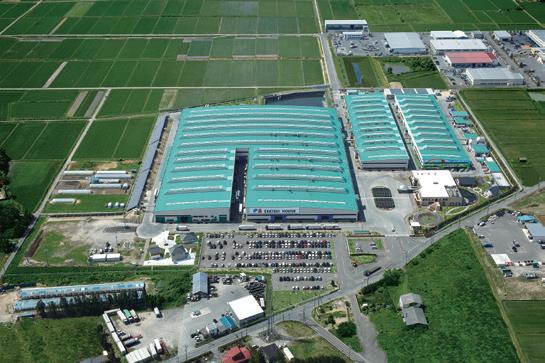
The Tohoku Factory manufactures Bellburn earthenware exterior wall panels exclusively for SHAWOOD homes. The firing furnace in this process uses a great deal of energy. To reduce energy use, exhaust heat from the firing furnace is captured and used in the drying furnace, thereby increasing energy efficiency. In the Bellburn forming process, after extrusion molding, the product’s appearance is checked by AI. Panels that do not meet the required standards are sent back for reuse as raw materials via a return conveyor, helping use raw materials efficiently and reduce waste.
After the Great East Japan Earthquake, Sekisui House formed a disaster prevention agreement with Shikama-Cho, Miyagi (where the Tohoku Factory is located), to set up emergency shelters and provide supplies in the event of a disaster. Environmentally friendly in ordinary times and providing safety and peace of mind to customers and the local community in times of disaster, the site serves as a disaster risk reduction factory of the future. Aiming to speed up initial response and enable energy self-sufficiency when disaster strikes, the factory has built a smart energy system comprising the existing photovoltaic power generation system as well as new large storage cells, gas engine generators, plug-in hybrid electric vehicles (PHEVs) and a factory energy management system (FEMS). Using the large (2 MW-class) storage cells, the factory seeks to lower its peak electricity draw. The use of FEMS improves the visibility of energy use by the factory’s main facilities, raising employee awareness of energy saving and thereby helping reduce energy use.
1. Initiatives to reduce CO2 emissions from production (production at factories plus shipping and transportation)
To reduce CO2 emissions from production, we are working to improve production efficiency by lowering the product defect rate and to save energy by replacing air conditioners and other equipment with energy efficient models. Furthermore, we used a thermal camera to identify areas where heat was escaping from the existing drying
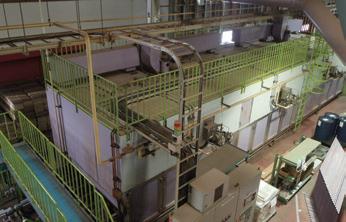
furnace. By cladding these areas with exterior insulation, we improved the furnace’s heat retention, reducing LPG use. In terms of shipping and transportation, we used trucks with larger loading capacities in the transport of materials for new detached houses, improving loading efficiency. For large multi-building housing developments, we transported materials for multiple buildings together, thereby reducing the number of trucks required and CO2 emissions.
2. Resource recycling initiatives
In the Bellburn manufacturing process, we are working to reduce waste by using 3D scanners to create digital 3D models of components that greatly affect the material yield rate and implement multifaceted analyses to reduce the defect rate and thereby reduce waste. At the Resource Recycling Center, we survey and analyze waste sent back from new construction sites in an ongoing effort to reduce surplus material. The survey results are shared with the branch and sales offices to develop countermeasures, improve systems and reduce waste.
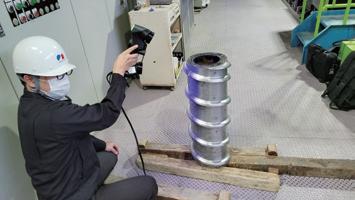

3. Rehabilitation of ecosystem networks and contribution to society
This year, new initiatives included the Company’s participation in the Zero Marine Trash Festival in Kami-cho, a waterfront environmental conservation activity through which we are helping raise awareness of the problems caused by marine plastics.
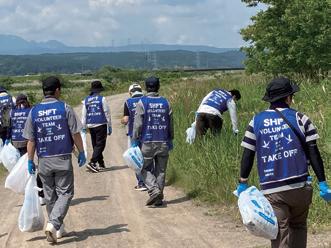


The Kanto Factory manufactures high-performance Dyne Concrete exterior wall panels. This process uses a great deal of energy. We are implementing a variety of measures to save energy in the manufacturing process, such as using exhaust heat from steam boiler drains and changing the heat source for drying furnaces from steam to burners. Furthermore, in the manufacture of steel frame members, panel components and processed wood parts, we are advancing such measures as replacing existing equipment with high-efficiency models, including updating cubicles and installing amorphous transformers, as well as switching to localized air blowers to reduce air compressor power consumption.
In 2022, we rebuilt the factory’s office, creating a net zero energy building (ZEB) of the type that Sekisui House is promoting using the expertise cultivated in the housing business. Aiming to ensure peace of mind for everyone working there and create a comfortable space to be in, the building’s basic specifications include disaster resilience, efficient ventilation systems (in light of the COVID-19 pandemic) and thermal insulation. In addition, we adopted a free address system, did away with land lines and designed the layout to facilitate interaction between departments to make the office environment more pleasant. Rebuilt as a Green First office, the new building also uses less energy.
1. Initiatives to reduce CO2 emissions from production (production at factories plus shipping and transportation)
We are advancing our efforts to reduce CO2 emissions mainly in the areas of energy-saving equipment and controls. We installed inverter compressors, LED interior lighting and other energy-saving equipment. We also adopted energy-saving controls for heating and cooling in electrodeposition coating processes to reduce electricity use. On the steel frame member welding line, we used AI to establish an optimized production method. This greatly improved productivity and reduced the line’s electricity use.
To minimize CO2 emissions during shipping and
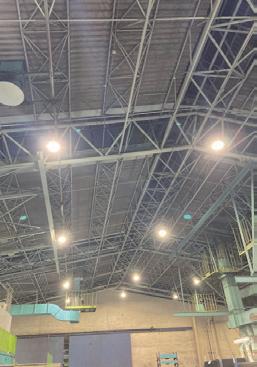
transportation, we are working to improve our truck loading methods to reduce the number of trucks required. For example, we made adjustments to packing at the production stage based on the way that materials are loaded onto trucks, eliminating the need for a loading trestle and thus expanding the effective truck bed space. Through such efforts, we are successfully improving loading efficiency.

2. Resource recycling initiatives
Waste reduction activities are focused mainly on improving yields and reducing sludge. In the Ironwork Group, chemical sludge can form during electrodeposition coating processes. To minimize this, we now utilize temperature controls that allow us to turn off circulation pumps in order to curb the formation of chemical sludge. The Dyne Wall Panel Group is making improvements to vibrators to increase the uniformity of concrete placing, working to increase yields and reduce waste. In FY2023, we installed new crushing equipment to turn concrete waste generated in the factory into raw materials, increasing the Company’s concrete waste recycling rate.
3. Rehabilitation of ecosystem networks and contribution to society Since 2022, we have been implementing such initiatives as donating Bellmark charity points to the local social welfare council and participating in cleanup activities near Koga Station organized by local soccer club FC Koga, an NPO. To support Burano and Mirai no Kodomo Network, both of which are organizations that receive funds through the Sekisui House Matching Program, we continued to support field trip events for children and donated school swimming supplies and food products.


Location: 1100 Naka, Kakegawa, Shizuoka
Establishment: August 1980
The Shizuoka Factory manufactures Bellburn earthenware exterior wall panels exclusively for SHAWOOD homes. This process uses a great deal of energy, but to save energy, the factory changed fuels from liquid propane gas (LPG) to liquid natural gas (LNG) in 2011. We have installed an LNG storage tank within the factory to provide a stable supply of fuel. LNG is evaporated in an air heat vaporizer, which draws on natural energy provided in the form of heat by the ambient atmosphere. We are also implementing ongoing initiatives to save energy by improving LNG consumption efficiency, including directing exhaust heat from firing furnaces to warming and drying facilities. Furthermore, we have been proactively transitioning to electric forklifts ahead of the other factories, and approximately 90% of forklifts are now electrified.
As the only one of the Group’s five domestic factories located in a waterstressed area, the Shizuoka Factory is actively working to reduce water use. To this end, we store rainwater and use it to clean the dehydrators in the factory’s wastewater treatment facilities.
In terms of resource recycling, we have installed equipment to recycle defective Bellburn panels. We use AI in quality inspections, and dispose of panels that do not meet our strict quality standards. Such tiles are crushed and recycled as filler in sound-absorbent flooring, thereby making effective use of materials and reducing waste.
1. Initiatives to reduce CO2 emissions from production (production at factories plus shipping and transportation)
We are switching to LED lighting, shifting to high-efficiency equipment and transitioning to electric forklifts. In terms of shipping and transportation, we are



working to reduce CO2 emissions by changing production to reduce transport distance and improving loading efficiency to reduce the number of trucks used.
2. Resource recycling initiatives
To minimize factory waste, we are working to improve the yield of wooden pillars and coatings and reduce the mass of sludge from internal processes through dehydration. Initiatives started in December 2020 to recycle rejected Bellburn ceramic exterior wall panels for use in filler for sound-absorbent flooring are producing significant results.
3. Rehabilitation of ecosystem networks and contribution to society
The Shizuoka Factory focused on maintaining and improving the greening of the site based on a greening plan. On May 26, 2022, a ceremony to grant a subsidy to certified NPO Tokinosu Forest Club under the Sekisui House Matching Program was held at the Shizuoka Factory. The factory has been involved with Tokinosu Forest Club since 2010 through annual tree planting volunteer activities, and the subsidies granted through the Matching Program help make the work even more rewarding. In March 2023, the Company signed a four-party agreement with Shizuoka
Prefecture, Kakegawa City and Tokinosu Forest Club to form the Shizuoka Future Forest Supporters. The Company then kicked off the Sekisui House Forest Creation event in July 2023, and we will continue these activities in the future.

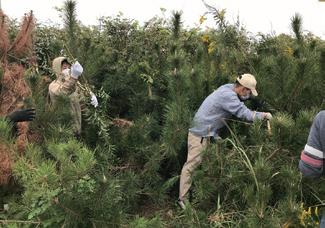

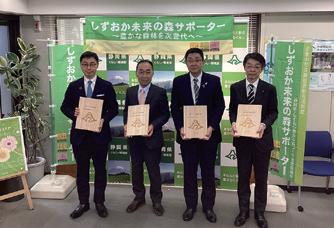

Location: 786-36 Ishitani, Yokodani, Kato, Hyogo
Establishment: July 1985
Total factory area: 59,970 m²
Factory floor area: 20,651 m²
Max. production: 380 houses/month
Main products: Dyne Concrete exterior wall panels
The Hyogo Factory manufactures high-performance Dyne Concrete exterior wall panels. The production of concrete uses a large amount of steam. We have installed automatic steam valves in the pipes that supply steam to each process. These enable steam supply to be shut off to processes not in use, saving energy. In 2020, we replaced one of the boilers that supplies steam with a cuttingedge high-efficiency model. Through system control that prioritizes the use of the new boiler, we have promoted further energy saving. In addition, we have applied a thermal barrier coating to the roof of the office building, reducing summer air conditioning power consumption. Responding to calls for energy saving in light of power shortages, we have installed three 35 kW in-house stations to power the factory in the event of electrical grid instability.
We are also working to reduce concrete waste in concrete manufacturing. We are implementing a variety of initiatives to this end, including installing automatic scrapers to prevent material from sticking to the sides of concrete hoppers and switching to butterfly valves on the intake ports of pumps for pouring liquid concrete into molds to prevent liquid concrete spatter. By collecting dust from Dyne Concrete panel processing to recycle as raw material, we are further reducing concrete waste. We have also installed equipment to automatically inspect panel thickness during concrete placement, improving the precision of product thickness and thereby helping reduce raw material use.
1. Initiatives to reduce CO2 emissions from production (production at factories plus shipping and transportation)
Since FY2022, we have been reducing CO 2 emissions from factory production by switching to LEDs for focal lighting in production processes, adjusting the pressure of compressors that provide power to production lines and changing

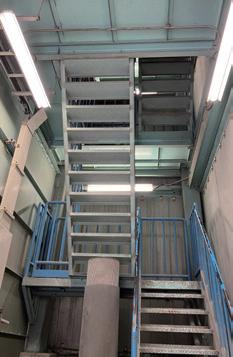
the boiler control program. We are also working to curb CO2 emissions in transportation by increasing the operating rates of 25-tonne and 21-tonne trailers, thereby reducing the number of 10-tonne trucks in use.
2. Resource recycling initiatives
In addition to recycling dust collected from manufacturing and processing as a raw material in-house, we have been using new crushing equipment, installed in FY2023, to turn concrete waste generated in the factory into raw materials, increasing the internal recycling rate of concrete waste.



3. Rehabilitation of ecosystem networks and contribution to society
We clean up the area surrounding the factory every month. In addition, we participate in cleaning up the Tojo area of Kato City to beautify the neighborhood. In local social contribution activities, we participate in food and blood donation drives sponsored by the Kato City Social Welfare Council. We also hold a charity drive for Children’s Day and take part in campaigns to support the recovery of disaster-affected areas. In addition, employees volunteered by participating in the Lao Picture Book Project by pasting Lao translations into Japanese picture books, creating and donating Lao versions of The Gigantic Turnip and The Mitten.



Location: 5000 Suzenji, Yamaguchi
Establishment: August 1973 Total factory area: 228,667 m²
Factory floor area: 88,148 m²
Max. production: 450 houses/month
Main products: Steel frame members, panel components, processed wood parts
The Yamaguchi Factory manufactures steel frame members and panel components and processes lumber. We have been implementing innovative measures to save energy, such as using IoT technology to control compressor operations and improve efficiency since FY2019. Specifically, a remote control system developed in-house predicts compressed air usage based on the operational status of manufacturing processes to provide an optimized energy supply by controlling electric valves and multiple compressors. Other energy-saving measures include replacing existing equipment with high-efficiency models, improving productivity and efforts to use energy efficiently.
We have internally developed and launched a smart manufacturing system using IoT, big data and AI for the line that manufactures beams for the Flexible ß System, Sekisui House’s construction method for 3- and 4-story steel-frame housing. In this system, AI trained on automatically collected past manufacturing data (big data) makes judgments based on manufacturing conditions.
Using this technology, we have automated adjustments to production volumes and employee allocation, which previously relied on the expertise of managers.
As a result, AI-powered improvements to efficiency in manufacturing line operations and power-saving operations have increased material yield, reduced working hours and cut electricity use.
1. Initiatives to reduce CO2 emissions from production (production at factories plus shipping and transportation)
To use energy more efficiently, we are replacing equipment with high-efficiency models and working to improve productivity on an ongoing basis. In FY2022, we replaced the chiller used to cool electrodeposition coating materials for iron components with a model that can both cool and warm. This has enabled efficient temperature control of these materials, cutting CO2 emissions by 12 tonnes annually. In addition, we are transitioning to LED ceiling lamps.
We also replaced office air conditioners

and the cafeteria noodle cooker, improved the power control of factory nightlights and implemented the intermittent operation of conveyors, fans and pumps, as we continue to implement these and other energy-saving initiatives.
2. Resource recycling initiatives
We are working to reduce paint, wood and steel raw material loss and promoting waste reduction programs. On the beam processing line for SHAWOOD wooden-frame housing, we have reduced waste by optimizing product combinations according to the length of the raw materials. We are also optimizing the amount of activated charcoal used to treat factory effluent to reduce the volume of sludge disposed of as waste. In FY2020, we introduced drying equipment that uses sawdust generated onsite as fuel to reduce the moisture content of sludge as part of our efforts to reduce both waste and CO2 emissions.
3. Rehabilitation of ecosystem networks and contribution to society Since FY2022, we have continued contributing to ecosystem preservation through a variety of activities in cooperation with the NPO Yacho Yamaguchi, which manages the Kirarahama Nature Observation Park (located in Yamaguchi City), where we took part in tree planting, volunteered to implement controlled burns of park reed grass, and helped jointly maintain a scenic road. Since FY2021, we have been providing food products to Food Bank Yamaguchi, a nonprofit organization that works to reduce food waste. We also registered as a food loss reduction partner with the Yamaguchi Prefecture Food Loss Promotion Council and will continue to collect and donate food from employees’ households that would otherwise have been thrown out.
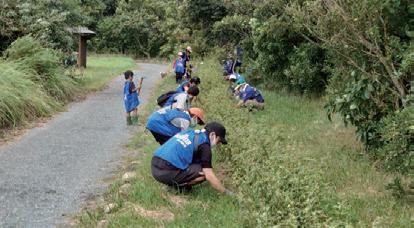
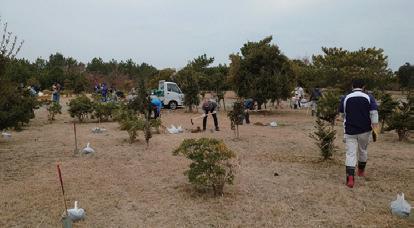
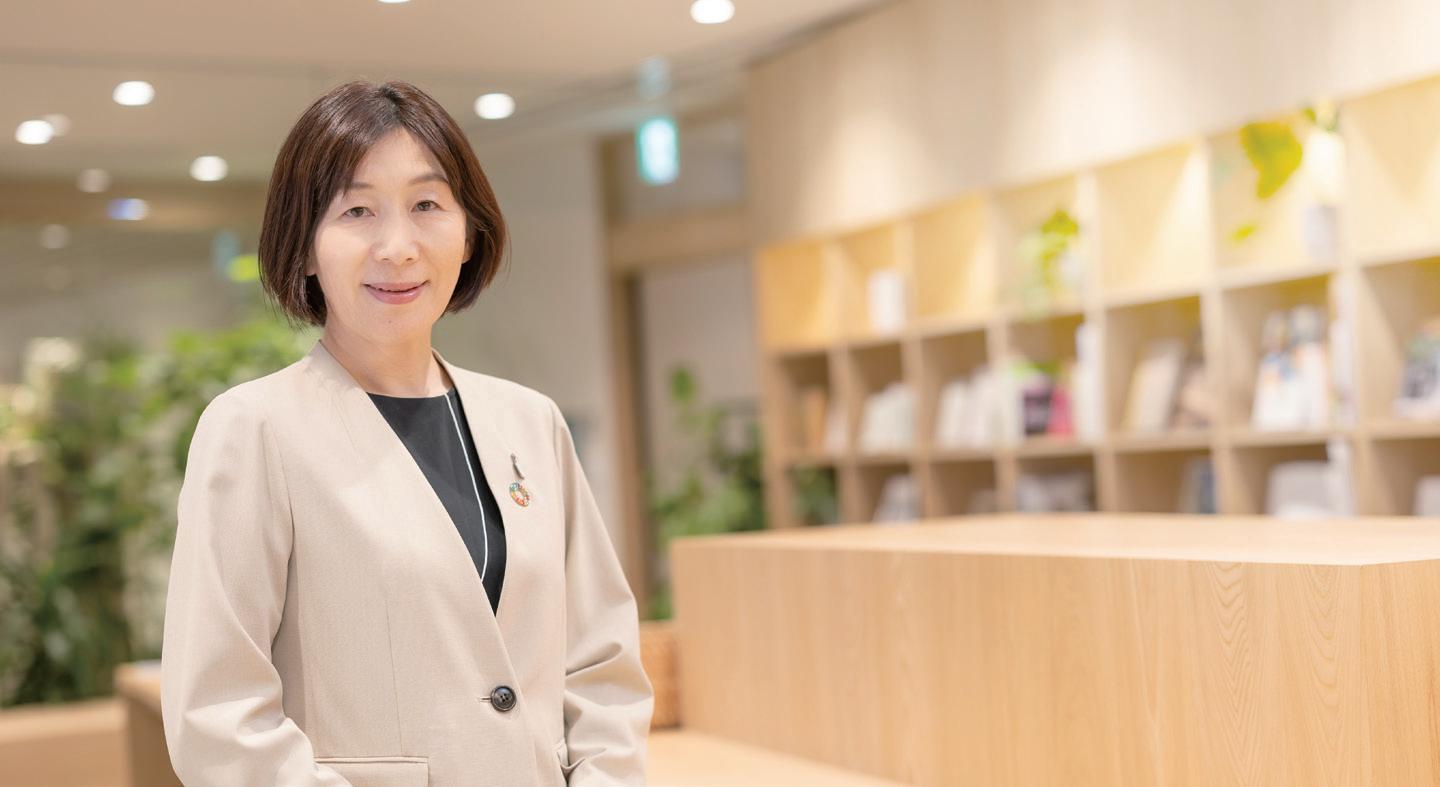
The Sekisui House Group is committed to its Global Vision, “Make Home the Happiest Place in the World.” For employees, “home” can also refer to their workplace or the company they work for. To ensure that this “home” is a place of happiness, it is imperative to establish an environment where psychological safety allows individuals to thrive as themselves, where relationships are built on trust, and where mechanisms are in place to foster personal growth and career fulfillment. Therefore, we believe that the Company’s crucial mission is to support each employee in living a fulfilled and happy life.
Our Group places great importance on the practice of innovation and communication, which is intrinsically linked with Diversity and Inclusion (D&I). This is because when people with different values and experiences—
The happiness of employees, customers and society paves the way for a brighter future
Miwa Yamada Chairperson of the Social Improvement Subcommittee Executive Officer Head of Diversity and Inclusion Promotion Department
regardless of gender, age, nationality, or disabilities—come together and share opinions, it energizes communication and spurs the generation of new ideas and solutions. Based on this belief, we prioritize dialogue among employees, creating an environment where everyone feels confident to voice their opinions. We are committed to sincerely acknowledging each individual’s input and fostering a corporate culture that respects and values uniqueness. Additionally, we are dedicated to creating environments that embrace employee needs and feedback, and developing programs that empower employees to pursue their passions and goals. This approach aims to enhance human capital value through employee autonomy and aligned efforts.
We strive to build an organization where employees can discover their
potential, grow alongside their colleagues, and experience greater fulfillment. We will continue to nurture autonomy and diversity, creating a workplace where these qualities can thrive.
Embracing the meaning of our business according to one of the tenets of our Corporate Philosophy of “creating enriching homes and environments,” the Sekisui House Group is committed to passing on beautiful homes and community landscapes to future generations. We recognize our responsibility to leave a richer global environment and a happier society for those that follow.
With this in mind, we actively work alongside our customers to address global issues such as global warming and ecosystem conservation. Additionally, we engage in urban development that respects local culture and climate, rediscovering regional charm to invigorate local economies and create jobs. Our businesses contribute to these endeavors. Furthermore, we offer children opportunities to create happiness and are committed to supporting their safe and healthy growth. Through co-creation with local communities, we aim to foster the advancement of society as a whole.
Building a better future requires reevaluating societal structures and pursuing fair and inclusive initiatives. We are committed to promoting diversity and inclusion, eliminating bias and discrimination in hiring and promotion processes, and fostering a culture that respects diversity and inclusiveness. We ensure all employees have equal opportunities for recognition and advancement. Regarding human rights, we are dedicated to respecting the rights of all stakeholders potentially affected by our business activities, including those within our supply chain. We identify and address business-related challenges and strive to earn and maintain trust by offering products and services that respect human rights.
These efforts are essential steps toward achieving a sustainable society, and we are committed to working hand-in-hand with our stakeholders to tackle these challenges. Our Group is committed to promoting initiatives that enhance societal engagement, embracing the challenge to contribute to the planet and society, and creating enduring social value for the future.
Key measures are being undertaken to enhance social value from both the perspectives of improving human capital value and improving social value. We set four themes aimed at improving human capital value: 1 Supporting self-directed career development, 2 Promoting DE&I, 3 Promoting diverse workstyles, and 4 Building a foundation for well-being. Based on these themes, we are reforming systems, building corporate culture and promoting relevant initiatives while working to support employee autonomy. Moreover, we nurture leaders capable of promoting and implementing our Corporate Philosophy and strategies, as we recruit and optimally allocate employees in line with strategies. Human capital value increases as a result of such employee autonomy and alignment of efforts.
P.94 Human Capital
To improve social value, we will implement measures under the four themes of: 1 “Kids First,” 2 “Green First,” 3 Respect for human rights, and 4 Regional revitalization businesses. By doing so, we will seriously work to address social issues through our business activities.
In FY2023, we established three meetings to enhance our social value promotion structure as well as to understand the progress of initiatives: Improving Human Capital Value Meeting, Kids First Meeting, and the Human Rights and Due Diligence Meeting. Each meeting is led by the employees responsible for promoting the relevant initiatives, and information is regularly shared on the progress of said initiatives based on the three-year roadmap and strategies of the Sixth MidTerm Management Plan. Attendees identify and discuss issues during these meetings as well as initiatives that should be pursued. The shared information and important discussion points are reported to the Social Improvement Subcommittee and further discussions take place among representatives from relevant departments. The content of these discussions as well as improvement plans are then reported to the ESG Promotion Committee, where lively discussions are held between management and external experts with specialized knowledge. All initiatives are then reviewed and refined as necessary.
Board of Directors
Discussions are held across four departments on policies and measures regarding employee autonomy and alignment of efforts as well as metrics for tracking the progress on such initiatives.
Discussions are held and progress is shared across eight departments to promote initiatives for children through both business and other corporate activities, with a focus on emotional and sensory development. Governance Subcommittee
Human Rights and Due Diligence Meeting
Discussions are held across eight departments to identify important human rights issues and promote human rights due diligence.
The Sekisui House Group positions the happiness of customers, society, and employees as a critical issue in the Social (S) sphere of ESG management. Therefore, the Group strives to improve human capital value and social value through business activities.
The ESG Promotion Committee, an advisory body to the Board of Directors, discusses policies and measures aimed at improving social value. The outcomes are presented at Management Meetings or Board of Directors meetings, where Company-wide measures are implemented and managed. The ESG Promotion Committee includes two external members with special expertise who actively participate in discussions, exchanging opinions. Through these discussions, the Committee establishes initiatives and policies aimed at improving employee autonomy and alignment of efforts as well as addressing social issues through business and other corporate activities.
Relevant departments within the Company are responsible for formulating strategies, implementing policies, and managing the progress of each measure. The Social Improvement Subcommittee, operating under the ESG Promotion Committee, monitors the goals and KPIs for each measure. Additionally, we strive to increase the effectiveness of our activities by promoting internal awareness of our initiatives and strengthening cooperation with internal and external stakeholders as well as regional communities.
With the overarching aim of improving human capital and social value, the Social Improvement Subcommittee discusses and manages the progress of initiatives to respond flexibly and effectively to the needs of and issues faced by various stakeholders, including employees and their families, customers, the supply chain, and regional communities.
Diverse perspectives and experiences are incorporated through the participation of members from different departments, enabling more comprehensive decision-making. This participation also facilitates the sharing of information and opinions, supporting the creation of organization-wide unity and cooperation. Moreover, by periodically evaluating the progress of goal achievement and making necessary adjustments and improvements to strategies, we are strengthening initiatives aimed at organization-wide social improvement.
The accelerated aging of society and low birthrate, the appropriate implementation of disaster prevention and mitigation measures, regional depopulation, and relative poverty among children are all pressing issues. Particularly since the COVID-19 pandemic, the issues facing specific regions, as well as the needs of their inhabitants, have diversified. These changes necessitate community development tailored to individual cultures and climates.
To address social issues such as longer lifespans across society and regional revitalization through our business, we are advancing community development by enhancing existing infrastructure services such as medical care, nursing care and welfare, and integrating them with real estate. The Group leverages its comprehensive proposal capabilities by integrating ESG considerations with its technologies, lifestyle design, and services. Through this strength, and in collaboration with homeowners and organizations ranging from NPOs to governments and public welfare organizations, we aim to create and maintain strong relationships between residents and property operators, fostering a society where people can be happy in their communities throughout their lives.
With a focus on children and the environment, we are actively working to create a society and environment where future generations can continue living happy lives. Additionally, we are developing initiatives aimed at solving issues faced by local communities by leveraging the specialized knowledge and expertise of our employees.
The Group’s strategy to enhance social value is aimed at contributing to a sustainable society and creating social value. The four pillars at the heart of this strategy are: “Kids First,” “Green First,” respect for human rights, and regional revitalization businesses. Through these pillars, we aim to address social issues and have a positive effect on local communities, the environment, and people’s lives, thereby increasing societal happiness. Moreover, implementing each strategy involves cooperation with relevant parties, effective resource allocation, and the evaluation of sustainable outcomes.
Through close cooperation with regional communities and specialized departments, we conduct risk management to address regional issues, achieving sustainable business activities.
Understanding regional issues and building relationships of trust
To accurately understand the needs and issues facing regional communities, it is crucial to build trust with local stakeholders. This approach enables the appropriate adjustment of business and activity plans while forming strong partnerships with regional communities.
Confirming the compatibility of property operators
When establishing a presence in a region, it is essential to confirm the compatibility of local property operators. By conducting operations that align with regional cultures and needs, we enhance the sustainability of our business activities.
Building relationships with property owners and the regional community
To drive business activities in a region, it is crucial to build strong relationships with property owners and the surrounding community. Through regular communication and deepening mutual understanding, we aim to promote seamless business activities and address challenges effectively.
Collaborating with specialized departments and external networks
Collaboration with internal specialized departments and external experts is essential to provide support and beneficial information to regional communities. By leveraging insights and advice tailored to the characteristics and issues of each region, we promote business activities that contribute to solving regional challenges.
We have set KPIs for initiatives related to improving social value. We disclose details of these initiatives and the status of their progress.
P.59 Indicators and Progress
Expenditure on social contribution activities
Total expenditure on social contribution activities of the Group, both domestically and overseas, amounted to ¥542 million in FY2023.
Initiatives at the head office in Osaka (Shin-Satoyama Garden)
On the north side of Shin Umeda City, where the head office of Sekisui House is located, we built a landscaped area known as Shin-Satoyama, covering about 8,000 m². Since 2007, we have utilized this area to support the education of children in the community. We offer elementary school children the opportunity to experience growing rice and kindergarten age children the opportunity to experience planting and digging up sweet potatoes.

In Japan, the situation concerning children’s well-being is escalating in severity, with reports indicating that the mental well-being of Japanese children ranks notably low among developed countries. Additionally, disparities in the quality of experiences and education children receive due to their parents’ income and education levels are leading to intergenerational cycles of poverty. With one in seven children living in relative poverty, the healthy growth of these youth is jeopardized while their basic needs, such as education and nutrition, often go unmet. Stress and anxieties arising from difficulties in living environments or economic situations also impact the mental health and happiness of children. Social losses resulting from neglecting poverty are causing problems for society as a whole.
We consider housing to be an important form of social asset. For this reason, our mission is to provide high-quality housing that can be lived in for generations, and we recognize our role in creating happiness for those who live in our homes. Consequently, we believe it is our duty to engage in activities that contribute to the happiness of future generations of children.
Recognizing the profound impact of these social issues on children, we have embraced the “Kids First: Nurturing Sensitivity” approach, focusing on the emotional and sensory development of children. We believe that children who grow up with rich sensitivity and happiness will become creative and imaginative adults, driving innovation in future Japanese society. With this vision, we are focusing our efforts on three key initiatives: supporting the emotional and sensory development of children, providing children with opportunities to learn about housing, and offering the Sekisui House Matching Program (a corporate program to match employee donations).
Issues involving children are incredibly complex and cannot be resolved by a single company alone. However, we believe these issues must be addressed within this generation. Therefore, we are reexamining our fundamental mission to best solve these pressing social issues.
We attribute the low levels of happiness among children in Japan partly to an education system that does not adequately prioritize helping children discover their own happiness and individuality. We have always provided programs related to the environment and housing for children, recognizing them as the leaders of the next generation. However, we must also provide experiences and opportunities that enable children to determine how to best live for themselves -a question that only they can answer. Therefore, we plan to create programs that offer children the opportunities to find their own happiness. We will continue to advance these initiatives across the entire Group, aiming, through our business activities and in collaboration with a broad range of stakeholders, to create a society and environment where children can continue to live happily.
Nurturing emotional and sensory development in children
Supporting the emotional and sensory development of children
Providing children with opportunities to learn about housing
Sekisui House Matching Program
Based on its many years of expertise in housing research and development, Sekisui House is proposing its Kids Design Kodomo idokoro houses. With a focus on children‘s safety, peace of mind and self-reliance, smart universal design creates a suitable place for children that fosters their vitality. This proposal emphasizes a style of child-rearing in which children try to nurture themselves. There are four key aspects of child rearing: emotional and sensory development, physical, intellectual and social. It is during childhood that these abilities see the most remarkable development, as children acquire essential life skills they can use throughout their lives. Several theories in developmental psychology suggest that contemporary children in Japan undergo six developmental stages. Each developmental stage highlights the importance of the four abilities. Our concept for Kids Design, a house that nurtures a child’s vitality, is based on this child-rearing perspective. Through this, we seek to foster the four abilities at developmentally appropriate times.
Emotional and sensory development includes one’s senses and the accompanying traits such as curiosity, empathy, and self-expression. This development is acquired through experiences from a very young age, with the most crucial development stage occurring from infancy to early childhood. This development continues during other life stages as well, serving as the developmental foundation for the other three abilities.
Our approach to supporting the emotional and sensory development of children focuses on creating homes and communities from children’s perspectives. Our goal is to create environments that nurture children’s emotional and sensory, physical, intellectual, and social development. To achieve this, we are strengthening our initiatives that foster these qualities and expanding our “Kids Design” projects to offer enriching living spaces and communities for children.
Sekisui House, in its efforts to evaluate and communicate its support for children’s emotional and sensory development, has been submitting entries to the Kids Design Awards for 17 consecutive years, winning the very first one and 116 in total. This makes us the company with the highest number of such awards in the housing and construction industry.
The Kids Design Award is an award system established in 2007 by the Kids Design Association, a non-profit organization, that aims to select outstanding works that address social issues related to children and child-rearing through products, services, spaces, activities and research that meet the objectives of ensuring children can live safely and with peace of mind, nurturing children with abundant sensitivity and creativity, and creating a society that supports the comfortable raising of children.
At the 17th Kids Design Awards in 2023, a total of nine entries received Kids Design Awards: six in the category of designs to support comfortable raising of children, two in the category of designs to develop the creativity and create the future of children, and one in the category of designs to contribute to the safety and security of children. In addition, three of the entries received the Excellence Award, Minister of State for Policies Related to Children Award; the Incentive Award, Chairman’s Award, Kids Design Association; and Special Award, BEYOND COVID-19.

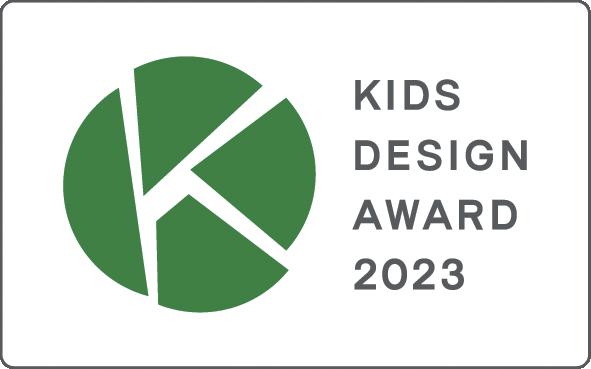
We are also collaborating with universities to support the emotional and sensory development of children. Research on children’s online learning at home, which began in 2021 and concluded in 2023, is a joint research project conducted with Professor Naho Sugita from Osaka City University’s Graduate School of Economics. Online learning can facilitate encounters and experiences that are difficult to achieve in real life, expand the child’s world, and lead to emotional and sensory development by broadening the range of experiences. In this joint research project, web interviews, questionnaires and other surveys were conducted on parents whose children are taking part in online learning. From there, key points were extracted for proposing online learning spaces for children, such as audio and the level of supervision between children taking part in online learning and their families. We are planning an online learning space for children based on this research’s results, which we will also verify through experiments.
Starting in 2024, we will embark on a comprehensive collaboration with Kyoto University to expand and create knowledge on housing designs that effectively nurture children’s emotional and sensory development. This partnership will enhance our initiatives to support children’s development by grounding our efforts in robust academic evidence.

Online learning that expands children’s worlds
The number of students is expected to increase due to factors including a growing number of dual-income households. We are also focusing our efforts in this area as a new way of creating learning spaces for children.
Since 2008, the Company has been providing opportunities for children to learn about housing in a fun way, utilizing the knowledge and expertise we have accumulated through our experience in housebuilding and community development. We offer on-site classes taught by our employees and hands-on classes using our facilities. In cooperation with the national government, local governments, educational institutions, and other organizations, we offer programs that allow children to think independently through hands-on experiences based on familiar subjects such as housing and nature.
From FY2008 to FY2023, approximately 25,000 children have participated in our employee-run classes and approximately 54,000 children have participated in hands-on programs and facility tours held at our plants, display homes, and Resource Recycling Centers. In addition, we offer environmental education programs on the themes of global warming prevention and ecosystem conservation, which we advocate as an “Eco-First Company,” as well as environmental education programs utilizing our biodiversity garden, ShinSatoyama, which is adjacent to our head office building, and the Sekisui House Eco-First Park on the grounds of our Kanto Factory. We also offer classes planned in collaboration with school teachers and vocational lectures to provide children with opportunities to think about the joys and roles of work.
Sekisui House’s educational support activities (Japanese only)
In 2019, Sekisui House was the only company in the housing and construction industry to participate in the “Programming Education Promotion Month in Future Studies,” an educational initiative conducted in collaboration with the Ministry of Education, Culture, Sports, Science and Technology; the Ministry of Internal Affairs and Communications; and the Ministry of Economy, Trade and Industry. Since then, at our five Tomorrow’s Life Museum, experience-based housing facilities nationwide and other facilities, we have accepted visits from 700 children from elementary schools across the country. In classes on housing titled “Everyone’s House! Houses of the Future!,” elementary school children are given the chance to take ideas from our facilities to design and build their own house of the future using architectural simulation software on computers.
We provide opportunities for children to experience and nurture their interest in housing by utilizing our model houses located throughout Japan. Children explore and discover from their own perspectives the ingenuity incorporated into the model houses, and experience aspects of housebuilding that they are rarely exposed to. Since its launch in 2021, approximately 600 children have participated in the program, which is divided into two types: field trips to a model house to see the actual product and remote explorations of model houses using tablets while at school.

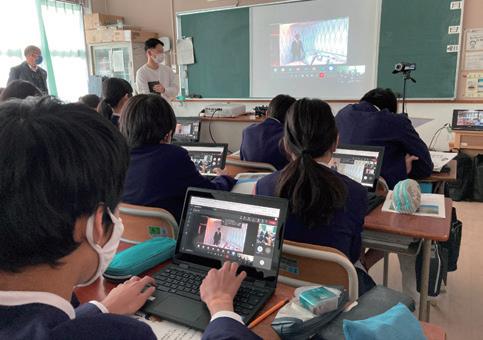
An employee, acting as a green specialist by the name of “Dr. Forest,” conducts classes on biodiversity using schoolyards and other natural areas. The objective of the program is for children to enjoy learning about the relationship between greenery and living creatures while completing missions, and to take action to protect the nature around them. We also respond to requests for teacher training based on this program (dispatching instructors to workshops organized by boards of education, subject research groups, etc.).
This is a program in which children can get hands-on experience as they learn about energy conservation in their daily lives together with our employees, who act as instructors working on behalf of “Captain Earth.” With the theme of comparing the insulation performance of houses and understanding the performance of energy-saving devices, the program provides an opportunity for children to learn about the relationship between climate change and their daily lives, and to promote their understanding of eco-friendly lifestyles and voluntary actions.
As a Gold Partner, we have been supporting the Minecraft Cup National Competition since FY2021 to encourage children’s digital craftsmanship. The Minecraft Cup is a contest that utilizes Minecraft Education (an educational version of Minecraft), which is used in teaching settings around the world to foster a programming-oriented mindset in children. The theme of the 5th edition of the national competition held in 2023 was “A Sustainable Society Where Everyone Can Live Healthy and Securely - A Town Where People Can Continue to Live on Clean Energy.” Thirty-seven finalists were selected from 500 entries from 13 regions across Japan to advance to the final round of judging.
Since FY2006, we have been engaging in the Sekisui House Matching Program, a joint donation program between employees and the Company. We established the “Children’s Fund” and “Environmental Fund” in a matching gift format, where the company contributes an amount equal to the employee’s donation. These funds are aimed at creating a society and environment where children can continue to live happily, providing grants to non-profit organizations. Since the program’s launch in FY2006, we have granted approximately ¥490 million to a total of 646 non-profit organizations. As of FY2023, 7,944 Group employees have enrolled in the program.
Since FY2021, we have been conducting presentation ceremonies at our offices and branches nationwide for grant recipients of the Sekisui House Matching Program to provide training on issues and activities in local communities, leading to improvements in our business activities and services. Furthermore, the connections made at these ceremonies have led to increased employee participation in volunteer activities and fostered collaboration in business activities such as renovating buildings for the grantee organizations and partnering on new initiatives.
In FY2023, we launched a new program to provide grants for projects that combine ideas for social contribution and social innovation conceived by employees with the activities of non-profit organizations.
More than 600 ideas were proposed by employees, with some examples including the effective use of vacant houses and scrap wood, creating spaces for children to stay and have experiences, and environmental conservation initiatives. From October 2023 to the end of January 2024, projects were planned with non-profit organizations, and after a two-month internal review process, we awarded ¥53.02 million in grants to 56 projects (FY2024 grants). Through cocreation with local communities, we will achieve further solutions to social issues.
Innovation and Communication
Fostering a new art culture with the Koji Kinutani Tenku Art Museum
Sekisui House operates the Koji Kinutani Tenku Art Museum to promote culture and the arts in society. The museum is located in the Umeda Sky Building, home to our head office, in Tower West (27F). The museum is dedicated to the works of renowned fresco painter and Order of Culture recipient Koji Kinutani. On display are many of Kinutani’s colorful, energetic frescos, along with sculptures and interactive content, such as the world’s first 3D visual system that allows viewers to seemingly enter the world of the painting, and a virtual reality presentation in which the artist himself introduces the museum and his atelier. Since its opening in December 2016, the museum has welcomed a total of over 400,000 visitors and is used as a venue for extracurricular classes at local schools. The Fresco-painting workshop² for parents and children is held monthly, and the Art and Friends² interactive learning program for elementary and junior high school students is held in spring and autumn. In FY2023, we cooperated with the 12th Make Smile Project, inviting approximately 160 children from child welfare facilities and orphanages in the Kansai region and guiding them around the museum. Since 2021, the Kids’ Drawing Contest has also been held annually for elementary and junior high school students to experience the joy and fun of creation, with 2,698 entries in its third year of FY2024. This one-of-a-kind, cutting-edge museum will continue to foster culture and art around the world.

The Company has established the Sekisui House Group Human Rights Policy (hereafter referred to as the “Human Rights Policy”), with the Board of Directors overseeing compliance with and initiatives related to the policy. The Management Meetings, ESG Promotion Committee and Risk Management Committee all exist under the Board of Directors and function organically in creating a Group-wide promotion structure for respecting human rights. The ESG Promotion Committee takes charge with regards to this structure creation. Guided by the ESG Promotion Committee, the Social Improvement Subcommittee determines key issues and policies related to human rights within the Sekisui House Group. Initiatives related to human rights are also regularly reported to the Risk Management Committee. Comprised of directors of the Board and executive officers, the Risk Management Committee discusses topics related to human rights, mainly strategic initiatives related to the labor and health of Group employees, harassment and work-related accidents, all from the perspective of risk management.
To strengthen our corporate culture, which strictly prevents human rights infringements, discrimination, harassment and compliance violations, we have established the Human Rights and Compliance Promotion Committee, chaired by the President and Executive Officer. The secretariat is managed by the Human Rights and Compliance Promotion Office1 within the Legal Department. Every year, the National Human Rights and Compliance Promotion Meeting is held, attended by representatives of promotion committees established in our departments, offices and Group companies. At the meeting, guidelines for human rights measures, Group-wide priority issues, training policies and training plans are shared. Each promotion committee is responsible for advancing the initiatives decided at the National Human Rights and Compliance Promotion Meeting.
1 In 2006, we established the Human Relations Office as a dedicated department for overseeing human rights under the responsibility of the managing officer responsible for legal affairs. This office was then renamed the Human Rights and Compliance Promotion Office on August 1, 2023.
In April 2020, we formulated and announced the Sekisui House Group Human Rights Policy. It was formulated with the advice of outside experts and approved by the Board of Directors of the Company.
The Human Rights Policy respects international norms, such as the International Bill of Human Rights, the ILO (International Labour Organization) Declaration on Fundamental Principles and Rights at Work, and Guiding Principles on Business and Human Rights, and supports the Ten Principles of the United Nations Global Compact.
In order to fulfill our social responsibilities, we have stated that we will respect the human rights of all stakeholders who may be affected in our business activities including our supply chain.
This Human Rights Policy, based on the Group’s Corporate Philosophy and Code of Conduct, supplements and clarifies respect of human rights, one of the principles stated in the Corporate Code of Conduct.
All Sekisui House Group officers and employees (including temporary, parttime and fixed-term employees) must comply with this policy, and we promote awareness of the policy through training and other measures. We also publish the policy on our website, and we expect all stakeholders inside and outside the Group to understand and support the Group’s policies and initiatives for respecting human rights. Specifically, we use a web platform to disclose information to suppliers and encourage compliance.
In addition, to disclose information as stated in the Human Rights Policy, we publish a human rights report.
As stated in the Human Rights Policy, the Sekisui House Group does not tolerate any form of discrimination. The Sekisui House Group Corporate Ethics Guidelines defines the standards of corporate ethics that the Company and its officers and employees must comply with in pursuing the corporate activities of each Group company. We have therefore established the following policy on the respect for human rights and prohibition of discrimination.
Consistently strive to maintain a healthy workplace environment, respect the human rights of each person and do not act in any way that could lead to discrimination. Do not discriminate in hiring and treatment of employees. Furthermore, ensure that other persons are prevented from discriminatory behavior.
(1) Do not engage in any form of unreasonable discrimination based on birth, nationality, race, ethnicity, beliefs, religion, gender, sexual orientation, gender identity, age, disabilities, preference, educational background, family and others.
(2) Do not engage in acts which violate human rights through violence, derision, slander, libel, forced labor through threats, bullying, or spread of rumors.
As stipulated in the Sekisui House Group Human Rights Policy, the Sekisui House Group does not tolerate any form of forced or compulsory labor or child labor. We do not tolerate any involvement in human trafficking nor any involvement with companies or production regions where such involvement has been identified through transactions.
We observe the legal minimum working ages of the countries where we operate and verify the ages of applicants when hiring. Our CSR Procurement Guidelines, which are applied primarily to our main suppliers, prohibit discrimination based on nationality or race, inhumane treatment, forced or compulsory labor and child labor, and require the appropriate management of employee health and safety.
Policy on children’s rights
The Sekisui House Group Human Rights Policy expressly and strictly prohibits any form of child labor. We support the Children’s Rights and Business Principles published by UNICEF in 2012. In addition to working to prevent and eliminate child labor, we implement initiatives to ensure respect for children’s rights based on an awareness that corporate activities may impact children in diverse ways.
P.182 “Kids First”
Dialogue with employees on freedom of association and respect for collective bargaining rights
As stated in the Human Rights Policy, all Group companies respect freedom of association and the right to collective bargaining. We shall comply with laborrelated laws and labor-management agreements, and work to build constructive relationships through sincere dialogue and negotiations with 100% of employees, including workers with shorter working hours, or their selected representatives.
Response policy for non-compliance with labor standards
All allegations related to labor standards within the Group are dealt with by the relevant departments. When an allegation regarding working hours is made, we investigate the worksite where the allegation occurred and take measures, such as providing guidance on improving work efficiency. There was one corrective recommendation regarding labor standards in FY2023.
The Social Improvement Subcommittee holds the Human Rights Due Diligence Meeting (secretariat: Human Rights and Compliance Promotion Office, Legal Department). This meeting is attended by multiple related divisions, taking charge of the Group’s approach to various human rights issues and sharing information collaboratively to ensure the promotion of human rights. Additionally, relevant departments, offices and Group companies are responsible for conducting human rights due diligence. They do so by implementing policies and raising awareness based on information collected from dialogue with stakeholders.
The Group identifies important human rights issues through the creation and review of the map of human rights risks. The following steps are taken at the Human Rights Due Diligence Meeting.
➀ Understanding stakeholders that the Group has an effect on
➁ Identifying human rights risks
➂ Evaluating human rights risks (scoring)
We annually review and verify important human rights issues for the Group through this same process. These are the important issues we have identified in red on the following map. We are monitoring the condition of these issues through continuous human rights due diligence, with the Human Rights Due Diligence Meeting at the center of this process.
Map of Human Rights Risks Related to Group Businesses
Employment of non-Japanese workers at construction sites
Human rights issues associated with timber procurement
Labor issues in the supply chain
Overwork and stress of employees
Employment and retention of people with disabilities
Fair hiring
As part of our efforts to ensure respect for human rights in our overseas activities, we carry out self-assessment questionnaires (SAQs) when a situation is ambiguous or when the Group expands through mergers and acquisitions. In October 2022, we implemented these questionnaires at eight overseas Group companies and four overseas offices.
We will continue to take opportunities to hold discussions on ensuring respect for human rights within the Group. We will start by responding to matters that require improvement through actions that are both highly necessary and feasible as we understand and analyze the potential negative effects stakeholders may face.
• October 2022
Implementing
SAQs
Construction site health and safety
Workplace harassment
Leakage of personal information
Human rights violations on the Internet
Advertising expressions
Safe, secure products and services
Discrimination against rental housing residents
Strength of connection with the Group
Topics
selected from discussions
• Implemented at eight Group companies overseas and four overseas locations
• Spreading the Human Rights Policy
• Establishing remediation consultation
• Establishing our stance on forced or compulsory labor and child labor
• Understanding the actual status of occupational health and safety management of construction workers
• Spread common knowledge of the Human Rights Policy to overseas regions and locations where it is not yet well known
Specific initiatives
• Create local translations of the Human Rights Policy as needed
• Offer the Sekisui House Group Human Rights Policy to major partners in the U.S. multifamily business and establish dialogue based on surveys to ensure respect for human rights
The Group values a broad array of perspectives including the opinions of stakeholders and related parties, as well as direct dialogue should human rights issues arise.
The Group has established the Sexual and Power Harassment Hotline and ensures that all Group employees are aware of it. The hotline provides a wide range of consultations regarding all kinds of human rights issues. We promptly respond to these consultations, conducting investigations and taking corrective, remedial and recurrence prevention measures as necessary. The verification results of these consultations are reflected in our Human Relations Training for all employees.
Diligence Concerning Workplace Harassment
Recurrence prevention
Analysis of the cause and background of the incident, disclosure of disciplinary measures
Report made by the Risk Management Committee, awareness raised via the General A airs senior manager meeting
Counselor training
Persons in charge participate annually, Consultation training attendance
Construction site work environments are hazardous and missteps can readily lead to life-threatening accidents. Accordingly, occupational health and safety is the highest priority of the Group. We have various measures in place to ensure that construction workers can work in a safe environment. For example, we are spreading awareness of disaster prevention through posters featuring messages in worker’s native languages and quick-to-grasp visual cues like pictograms.
P.198 Occupational Health and Safety
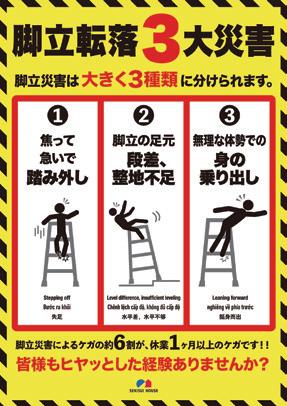
The Company has established the CSR Procurement Guidelines as part of procurement efforts in our supply chain and has relayed these guidelines to its main suppliers. In doing this, we also communicate the Sekisui House Group Human Rights Policy to suppliers since the CSR Procurement Guidelines emphasize respect for human and labor rights. These same guidelines apply when receiving signed agreements from our suppliers. To promote respect for human rights in the supply chain, we must increase the scope of engagement from our suppliers to their suppliers and beyond. Therefore, since FY2022, we have been working to promote understanding and awareness of our human rights policy through annual activity policy briefing sessions attended by about 150 of our main suppliers. We conduct CSR evaluations for suppliers based on the Global Compact Network Japan (GCNJ)’s self-assessment questionnaire (SAQ). We incorporate these results as part of our supplier assessment. In order to conduct fair and impartial transactions, we disclose the evaluation results to our suppliers. We monitor suppliers who are identified as requiring attention by the assessment results through onsite interviews to confirm their current status.
Human relations training
Mandatory for all Group employees, including temporary and part-time employees
Corrective measures
Disciplinary measures administered by the Disciplinary Advisory Board, implementation of personnel measures, warnings and guidance
Risk assessment
Discussions with relevant departments, discussions with human rights organizations, examination of priority issues, inclusion in Human Relations Training
Sexual and Power Harassment Hotline consultations
Anonymous consultations also accepted Dedicated sta respond to needs
Human Rights and Compliance Promotion Committee
Decisions on prevention and mitigation policies
Training conducted by external experts
Response to consultations
Neutral and fair investigation, understanding of the facts, careful listening and advice
We use gatherings such as the annual activity policy briefing session, held by the Company’s Procurement Division, to sponsor lectures from outside instructors to help elucidate ESG issues, allow suppliers who have implemented progressive efforts to demonstrate their case studies, share practical knowledge, and increase worldwide awareness of ESG issues.
February 2022 Speech at the Annual Activity Policy Briefing Session
(150 participating companies)
Theme: Business and Human Rights in the Supply Chain
February 2023 Case Studies at the Annual Activity Policy Briefing Session (157 participating companies)
Theme: Efforts Regarding Human Rights in the Supply Chain
October 2023 Speech at the Supply Chain ESG Promotion Tournament (279 participating companies)
Theme: Tips for Putting Human Rights Due Diligence Guidelines into Practice
Important Issue 4: Employment of foreign workers at construction sites
Construction sites employ construction technicians of all nationalities and genders, but the Group places particular emphasis on improving the work environment for foreign workers (including technical trainees) with different backgrounds in terms of culture, language, etc. We particularly focus on supporting technical trainees in both their education and livelihood.
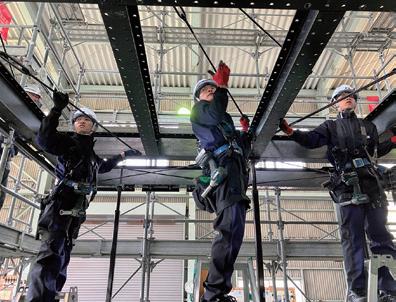
We conduct annual surveys in both Vietnamese and Japanese regarding the working environment of three main groups of foreign workers at Group companies and their partner building constructors, and received responses from 272 people in 2023, a rate of more than 80%. For example, for the question “How many more years do you want to work in Japan?” 83% of responses indicated that they would like to continue working after their training period of three years is complete. Additionally, for the question “Are you satisfied with this company?” 85% of responses were affirmative. From this, we believe that the working environment is satisfactory overall. The survey also included questions such as “What tasks are difficult at work?” and “What difficulties do you face living in Japan?” with the aim of assessing issues related to day-to-day work experience, lifestyle, Japanese language and culture and hopes for the future. Moving forward, we plan to use the results of surveys and interviews to continually create more opportunities for dialogue with technical trainees, prevent issues in the workplace and daily life before they occur, and improve the working environment further.
The Group has put in place several reporting systems, including the Sekisui House Group Compliance Support System and the Sexual and Power Harassment Hotline managed by the Human Rights and Compliance Promotion Office. By appropriately operating these systems, we are working to enhance our consultation desk network. In particular, the Sexual and Power Harassment Hotline provides consultation on all human rights issues, including various types of harassment. In addition, we assign one male and one female employee each to serve as consultation personnel (770 people total, as of February 2024). The Human Rights and Compliance Promotion Office holds annual training for consultation personnel to improve their skills and strengthen cooperation. All employees are made aware that consultation personnel are stationed at all business sites through the Company intranet, compliance training, human relations training, posters and other means. We strictly protect confidentiality and ensure that the users of these services will suffer no disadvantage due to their consultations and reports.
Every case received by the Sexual and Power Harassment Hotline was addressed. After receiving the report and understanding the intentions of the consultee, we determine whether the issue is something the organization should attend to. If so, we work to thoroughly confirm the facts and then ensure corrective action is taken. In addition, we may also offer the consultee further advice and support that is tailored to the situation. Of the total number of cases received, most of the non-harassment consultations are related to management and human relationships in the workplace.
At our overseas Group companies, we have established consultations systems for each country and operating company. We also take inquiries from affected parties outside of the company about human rights on our public website.
Established when the Sekisui House Group Human Rights Policy was formulated in April 2020, we accept both internal and external inquiries related to human rights via our public website. In FY2023, we received noise complaints from tenants in our rental housing, complaints regarding noise and physical appearance of building locations, and inquiries regarding tenant screening. We have looked into and responded as needed to all inquiries received, except three cases that were impossible to investigate because there were no leads, and we did not identify any serious human rights violations inflicted by our business.

To raise awareness of human rights issues and foster a work environment in which employees can work comfortably, human relations training is held for all Group employees1 every year. This training is designed to improve employees’ awareness around human rights and provides an opportunity for them to think about human rights as their own issues in their everyday work. Work leaders at each business site serve as facilitators. The organizational implementation rate for FY2023 was 100%.
1 Participation is voluntary for temporary, part-time and fixed-term employees, but training manuals are distributed to employees. In addition, some Group companies, including those overseas, conduct their own equivalent training.
Target Training time Number of participants Training topics
Training for promotion leaders Managers 2 hours/ year 6,864
Training for all employees All employees (including managers) 3 hours/ year 24,260
• Business and human rights: finding meaningful and dignified work
• Effective communication for improving the workplace environment
• A society where those with and without disabilities can live together
• Harassment and its connection to external stakeholders
Training for all employees
In addition, the Human Rights and Compliance Promotion Office conducts internal training by rank and specialty as necessary to prevent violations of human rights, including all forms of harassment.
Each year, we solicit human rights slogans from all Group employees and their families for Human Rights Week, from December 4th to 10th. In 2023, we held our 40th slogan contest, and a total of 26,671 entries were submitted, from which we selected the most exemplary work and five excellent works. We are displaying posters containing these six works to various organizations and Group companies.
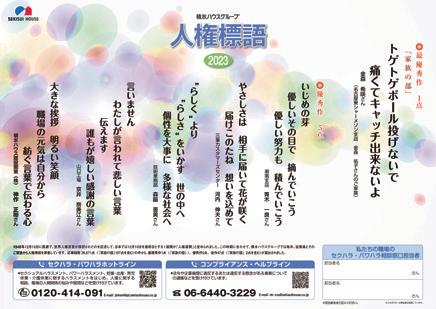
Continued dialogue with customers contributes to the provision of high-quality housing. Even after housing is provided, we accept opinions and evaluations regarding our overall service through regular inspections and questionnaires. Sekisui House Real Estate Group and its member stores aim to be LGBTQ+ friendly when finding tenants for rental housing properties. Specifically, we are revising the gender section on tenant application documents, digital application forms and lease agreements, and providing training to employees of the Sekisui House Real Estate Group and its member stores help eliminate the particular stresses LGBTQ+ individuals face when looking for and moving into homes.
Following our support and signing of the Ten Principles in the four fields of human rights, labor, environment and anti-corruption stated in the United Nations Global Compact in 2018, we joined the subcommittees (Human Rights Due Diligence and human rights education) of the Global Compact Network Japan (GCNJ), a local network based in Japan.
We also collaborate with related organizations that work on various human rights issues, including the Buraku (marginalized communities) issue, and continuously collect information to utilize for in-house education and training.
Related organizations working on human rights issues
• The Buraku Liberation and Human Rights Research Institute
• The Corporate Federation for Dowa and Human Rights Issue, Osaka
• Association for Fair Employment and Human Rights Education
• Osaka City Corporate Human Rights Promotion Council
• NPO Multi-Ethnic ’Human Rights’ Education Center for Pro-existence
• Normalization Society
• Cuore C Cube Co., Ltd. • NPO Nijiiro Diversity
Housing technicians, or “crafters,” are one of the job types involved in building houses for the Group’s Sekisui House Construction. In striving to construct buildings that keep our customers safe by utilizing various skills and techniques, we work directly with customers to ensure their wishes and needs are met, even down to the smallest detail of the construction project. To do this, strong communication and excellent problem-solving are required.
Sekisui House Construction is making efforts to strengthen the hiring and training of these crafters, with a focus on prospective high school graduates. Sekisui House Construction companies welcomed 134 new employees in April 2024, which is 3.4 times higher than the previous fiscal year, significantly exceeds the originally planned 95. We plan to continue at this level and have 133 new employees join us in April 2025. Starting salaries have been increased by up to 10% and the remuneration of chief crafters (foreman-class workers) has been improved, allowing workers in their thirties to earn around ¥9 million, an increase of 180% from the previous average annual income.
In addition to changing the name of housing technicians to crafters, we have also developed a new personnel system that incorporates the assessment of multi-skilled personnel and their training through a new evaluation system and a skills matrix. This system also allows crafters to change their job type to that of construction managers who are in charge of process and quality management. We have created new uniforms that are both fashionable and functional. We are also working to improve our workstyle, increasing annual leave from 120 to 125 days, ensuring each employee has two full days off per week, and maintaining a paternity leave usage rate of 100%.
Through these new measures, we are establishing a work environment that ensures greater work ease and satisfaction for crafters, enhances the attractiveness of home-building artisans, and contributes to the creation of high-quality housing stock.
The Trip Base Michi-no-Eki Stations Project, a regional revitalization project developed with Marriott International, promotes travel that encourages the exploration of lesser-known destinations to discover their unique charms through a system of roadside rest stations known as “Michi-no-Eki.” The project has been gradually rolled out since October 2020. In the first stage of the project, 15 roadside hotels were opened in six prefectures as of March 2022, providing a total of 1,152 rooms. During the second stage, 1,184 rooms at 14 locations in eight prefectures were opened as of November 2023, expanding to a total of 2,336 rooms at 29 facilities in 14 prefectures.
This project operates Fairfield by Marriott roadside hotels specializing in overnight stays. With the aim of promoting the use of local stores and other facilities, the project is deepening collaborations with local communities and alliance partners. Our cooperation with the KURADASHI Challenge, which aims to reduce food loss by supporting the harvesting of agricultural products, was expanded from Kyotamba Town, Kyoto Prefecture and now also encompasses Susami Town, Wakayama Prefecture and Mihama Town, Mie Prefecture. We are also working on regional revitalization in Mino City, Gifu Prefecture, by solving local issues through efforts such as collaborating on a study-awayfrom-home program for nursery school children that links the regional community to families raising children. We will continue to contribute to regional revitalization by promoting tourism, with the aim of expanding the number of rooms to roughly 3,000 nationwide.
Leveraging our decades of expertise in housing construction, we are implementing urban redevelopment that goes beyond mere scrap-and-build. Through the urban redevelopment of rental and for-sale condominiums, offices, hotels, commercial facilities, and complexes incorporating these property types, we aim to create buildings accommodating to all and that will be passed on to future generations, thereby creating value for society as a whole with focus on people, communities and the future.
When planning urban redevelopment projects, we always consider the impact of our operations on the environment and community, referencing relevant laws, regulations, and internal rules.
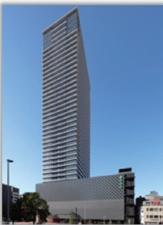

Conceived as a project to rebuild and redevelop the Misonoza kabuki theater, the tower incorporates a theater with new functionality as well as high-rise housing and shopping with the aim of invigorating the surrounding community and creating a lively townscape.
Directly facing Midosuji Street, Hommachi Garden City Terrace arose as an office building reconstruction project in March 2023. Designed based on the living office concept, it allows workers to feel connected to nature and the changing seasons. Workers can experience gingko tree-lined Midosuji Street, which will become even more pedestrian-friendly in the future, through an atrium that extends from below ground to above ground, and green balconies that unify the building with the city.
Sekisui House is engaged in business centered on the residential domain that goes beyond just housing. Protecting the lives and assets of residents and tenant employees from increasingly severe natural disasters is a significant social issue and part of Sekisui House’s mission. We therefore develop properties with attention to not only environmental and social issues, but also local communities.
Japan actively promotes PPP and PFI initiatives to achieve efficient, effective and high-quality public services by utilizing private funding and creative ingenuity in the maintenance and management of public facilities and similar establishments. PPP is a general term for initiatives conducted through the collaboration of the public and private sectors. PFI, on the other hand, falls under PPP as a representative method of using private sector funding and expertise in the maintenance and management of public facilities.
Through active participation in PPP and PFI initiatives, the Sekisui House Group aims to resolve social and regional issues. Specifically, the Sekisui House Group leverages its unique knowledge and expertise to propose various solutions mainly related to public facilities, public rental housing, town development, medical care, nursing care, childcare and parks. We have also been selected as a partner in the Ministry of Land, Infrastructure, Transport and Tourism’s PPP Agreement and will help to promote and increase awareness of PPP and PFI.
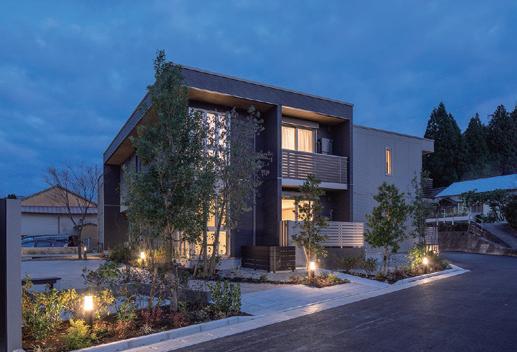
An initiative, known as the platinum business, is being undertaken by the Sekisui House Group. This construction business provides service-equipped housing for senior citizens, group homes, medical facilities such as clinics, facilities for persons with disabilities, and childcare facilities, among others.
From children to adults, the elderly, and persons with disabilities, we are responding to the desire to “live here forever” by creating places that meet all the needs of the diverse life stages of each person and the region itself.
Through comprehensive planning, technical and construction capabilities, we have developed buildings that feel like home and are easy to use, safe and comfortable; not only for visitors, residents and patients, but also for doctors and other staff. By leveraging the Company’s unique universal design and environmentally-friendly technologies, we are creating a design that is comfortable for people from the perspectives of both residents and workers.
In advancing business that contributes to coexistence with local communities, it is important to understand local issues, maintain relationships of trust with business owners, and ensure compatibility with the property operator. In recent years, regional issues have become more complex, with simultaneous needs to promote the influx of younger people while increasing the number of maternity hospitals.
Based on its nationwide business presence, the Sekisui House Group leverages its relationship with property owners as well as experts, specialized departments, and networks from various fields to collaborate with external experts and others. In doing this, we work toward creating an organizational structure capable of solving regional and social issues.

Promoting Permanent Residency Housing Project, a PFI initiative in Yamato Town, Kumamoto Prefecture
In Yamato Town, there is a sense of impending crisis regarding the increasing loss of young people. As a result, the town has put out a public appeal for a PFI project to promote permanent residency through a system that provides rental housing above the regional standard. The Company proposed the project Yamatokainaka Living, a concept named after the combination of the Japanese words for mountain, “yama,” city, “tokai,” and countryside, “inaka.” This concept, aimed at allowing young people to live as if they were in a city despite actually being in the mountains, was adopted by Yamato Town. From the perspective of local production for local consumption, our proposal included study and reading spaces where residents can converse with each other, areas where children can play at any time regardless of the weather, and the creation of an atrium common space with pillars and benches made from locally procured wood, serving as a symbol of the entire space. By designing a space where residents can interact with each other and be around nature, we have created housing where families raising children can live worry-free.
The building has successfully promoted permanent eco-friendly living by adopting ZEH-specifications, fitting for a SDGs Future City like Yamato Town. Outside of the building, we have built the Welcome Common Park, which has become both a place for viewing regional festivals and a space fostering interactions between residents and locals. We have received comments from residents as “I couldn’t help but worry when leaving my child alone at home at our previous residence, but now, since security is so tight, I feel much more reassured” and “since every resident here has children, there’s a mutual understanding and support even when children get a bit noisy.”

Famile Maternity Clinic Arida, a PPP project
Famile Maternity Clinic Arida opened in April 2024, with the aim of being a childbirth facility rooted in the community, allowing mothers to give birth and raise children worry-free in their own town. Alongside a rapidly declining population, the collapse of regional healthcare due to insufficient medical services and physicians is a social problem shared across Japan. This project was made possible precisely because it was a PPP initiative, utilizing public and private cooperation. Famile Maternity Clinic Arida was constructed by converting a former nursery school owned by Arida City in Wakayama Prefecture into an outpatient clinic, through reduction of floor space and overall renovation. A new in-patient delivery clinic was also built on the adjacent site. The clinic aims to provide mothers with a joyful childbirth experience that makes them say “I’m so glad I gave birth here.”
Utilizing the private proposal system of Arida City, this project was submitted and selected as a private proposal by a consortium of three companies: Sekisui House, Ltd., Medical Corporation Mother Key, and Konoike Building Technology Co., Ltd. The quality of dialogue between Arida City and members of this consortium was enhanced through logical proposals based on data analysis. Thorough dialogue made it possible to simultaneously realize cooperation between the public and private sector and broader regional cooperation through collaboration between the Arida regional healthcare municipalities.
This is a leading public-private initiative that has successfully offered seamless child birthing services in the Arida healthcare region through the strong desire of those involved to solve regional issues, supported by the understanding and execution capabilities of the regional municipalities.
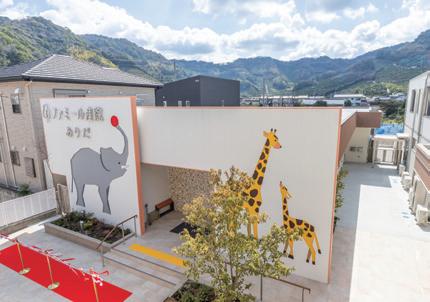
Obayashi Maternity Clinic: Making motherhood a more fulfilling time
Obayashi Maternity Clinic was planned under the integration of its management philosophy of making mothers, babies, staff, the community, and all those involved smile with the concept of establishing a maternity and gynecology department, where new lives are born, that connects the community with society. In response to the “Coexist with COVID-19,” a government policy that aims to balance reducing the spread of the virus with continuing economic activity, we have designed areas where mothers can communicate without feeling isolated, such as café-like open waiting rooms with outdoor terraces that are lushly green and not crowded. To make hospital visits, childbirth, and child-rearing loving and happy experiences, we have designed open areas that make it easy to connect with each other. These spaces include hospital rooms where families can stay together, beauty treatment rooms for mind and body, family dining rooms with virus prevention methods in place, and multipurpose rooms that can be used for activities like baby massages and maternity yoga classes. To alleviate the anxieties of expecting and nursing mothers and make them feel happy, we believe it is necessary to exchange and share up-to-date medical information in addition to providing medical care. As a result, we have created a photo spot to encourage these mothers to share photos online so that even friends and relatives who are far away can share in their joy. We have received positive feedback and support from locals expressing great joy that, amidst decreasing access to obstetrics, a local maternity clinic where they can give birth has been opened. The Obayashi Maternity Clinic received the Kids Design Award in 2023.


Fuji Toranomon Children’s Center under one roof Children are a mirror that reflects society. What can we leave behind for the children who will shape the future? The Social Medical Corporation Seikokai considered how to address various frequent issues such as child abuse, bullying, truancy, pediatrician shortages, and child development disorders. In doing so, they realized that they wanted to create a paradise for children, where each child, no matter how small, can have their own charming dreams. Thus, Fuji Toranomon Children’s Center was established in Gotemba City, Shizuoka Prefecture.
This is the nation’s first private initiative that acts as a one-stop shop offering child development support, afterschool services and clubs, and outpatient medical care for children. The management company, which has been providing regional medical care for 37 years, responds to the important needs of the region such as addressing problems of guardians related to child-rearing through collaboration with consultation support and local education institutions. This children’s center is becoming a place where children with and without disabilities can come together and play, putting their mental and physical development into practice naturally.
The facility, with over 6,000 annual visitors, remained open during the COVID-19 pandemic, welcoming the community with open arms. By 2023, after five years of operation, the activities of the children’s center have permeated the entire community, transforming the entire town into a supportive place for children. We submitted this initiative to the Kids Design Awards with the hope it would spread nationwide, and it received the Minister of State for Policies Related to Children Award.

The Dai-no-mori Project: Creating a center of interaction to pass on local resources to the future
The Dai-no-mori Project in Sendai City, is a project to create a symbiotic community that preserves memories of daily life from times gone by, along with a forested property, wells passed down through generations, fruit-bearing trees, and a zelkova tree over 300 years old, recognized as a valuable local resource.
The Company proposed a place open to the community where a group home for people with disabilities, pottery workshop, café, gallery, and restaurant all coexist together. Based on the lessons learned from the Great East Japan Earthquake, we felt that it was important to build face-to-face, multi-generational relationships. Therefore, we interviewed 90-year-old residents about their childhood memories, exchanged opinions with residents, and developed a plan to create a place where people can spend time and grow attached to and involved with the area.
The warehouse gallery (constructed by Mitsu Woodworking Studio), and the interiors of the café, restaurant and other spaces were built using leftover Itakura, storehouses made from thick wooden planks. Business operators, their families, local volunteers and children all came together and experienced lending a hand in the construction process. The project’s development process received high praise as a potential model for children’s participation in community development and was awarded the Kids Design Association President’s Award in FY2021. The area will continue to grow as a sustainable gathering spot, with residents delighted that it has become a park-like place where they can spend time.

Created on a 27-hectare redevelopment project on a former factory site in Toyohashi City, Aichi Prefecture, Miramachi was developed with the aim of solving local issues and realizing a compact city. The complex focuses on three future values based on the concept of creating a town connected to the future. These three values are: child-friendliness, disaster resilience, and enjoying life. The first value of child-friendliness is a town-wide endeavor focusing on supporting the future of children through child support centers, parks where families can make lasting memories, and the installation of crime-prevention cameras. The second value of disaster resilience prevents flooding from worsening typhoons and heavy rains by elevating the entire town and setting up parks that also serve as reservoirs. The last value of enjoying life leverages the Company’s expertise to create a community using both advanced technologies and lifestyle design. Driven by the belief that fostering a community is imperative for creating a pleasant living environment, we have established a management association aimed at resident-led town management. Through these efforts, we are creating a place where both residents of the town and visitors can interact more deeply.
Moreover, this project was the first in Japan to use smart electric meter communication technology to read electric, gas, and water meters. Making usage visible helps improve convenience for residents and promotes environmental conservation.
The Company works to ensure the quality of its products and services to provide customers with housing where they can live safely with peace of mind and enjoy good health and comfort over their entire lives. For cases where serious quality problems occur due to unexpected human errors or other factors during our long support period, we have established a Quality Management Committee under the Risk Management Committee, which itself acts as an advisory body to the Board of Directors. This committee deliberates over risk identification and response measures through the specialized perspective of its members. Under the Quality Management Committee, we have also established study groups covering the five areas of products, design, production, construction and customer satisfaction. Meetings are held once every two months with representatives from each Group company to effectively manage quality-related risks and to implement preventive measures when necessary.
Quality management of products designed, developed and produced by the Company is an important initiative tied to offering safe products to our customers. Thus, we have established specific quality standards for the products we develop. Through the accumulated knowledge gained from our corporate activities and research, we design products based on a wide range of quality standards. After thorough verification, we develop safe, high-efficiency and high-quality products and components. At all domestic and overseas Company factories, where production and manufacturing take place, we have established a quality management system in line with ISO 9001 standards while also conducting production and manufacturing in strict adherence to the Company’s own quality standards. In the construction phase, on-site supervisors from Sekisui House, construction managers from all Sekisui House Construction companies and partner building constructors, as well as crafters all work together to continuously improve and maintain construction quality. In doing this, we have established a quality inspection framework based on the individual responsibilities of each group above.
Product safety risk assessment in the design and development phase
We have established design reviews in which relevant departments involved at each stage of the process—from planning and concept to basic design— discuss design details using a special format ensuring that there are no oversights relating to verification items. With specific regard to safety, we use prototypes to confirm the validity of designs. We also manage requests from relevant departments such as those regarding improvements related to product specifications and information on past issues through a dedicated database which is leveraged in creating new designs and improving existing ones.
Product quality management initiatives in the production and manufacturing phase
To ensure sufficient design quality at the Company’s production factories, we manage the four M’s related to production (man, machine, means, material), and produce and manufacture products accordingly. We also continuously observe manufacturing conditions through monitoring devices, conduct daily checks and quality inspections performed by inspectors from the Manufacturing Division, and have the Quality Control Division periodically confirm the efficiency of key structural elements such as welding, adhesion and paint coating. We then make the progress and results of the above accessible to all factories. In these inspections, we are promoting automation and DX technologies, ensuring inspectors have sufficient qualifications, automating pass/fail determinations, preventing omissions, and utilizing inspection records. Moreover, periodic mutual audits between factories are put in place to protect against discrepancies and ensure quality is maintained at a high level.
In 1998 , our entire Production & Procurement Division, including all domestic consolidated Group factories,1 was the first in the industry to acquire certification under the ISO 9001 international quality management system standard, and we continue to maintain this certification.
1 The Tohoku Factory, Kanto Factory, Shizuoka Factory, Hyogo Factory and Yamaguchi Factory
Product maintenance and improvement initiatives in the construction phase Sekisui House onsite supervisors undergo inspector certification training, and construction managers of Sekisui House Construction companies undergo construction manager inspection training in order to learn inspection skills used in quality control in the course of ordinary work. We implement periodic renewal tests to maintain inspection skills. The Sekisui House Construction companies also regularly hold training for construction managers in an effort to enhance their inspection skills. In addition, chief inspectors monitor worksite construction quality, management systems and inspection capabilities while providing training and support for the inspections carried out by onsite supervisors and construction managers. In this way, we seek to consistently provide high-quality buildings to customers all across the country.
Based on the experiences of Company designers nationwide and customer satisfaction surveys, we conduct Planning Standard System (PSS) training, our unique training aimed at further improving housing-related design standards. Additionally, practical construction training is implemented based on years of experience and level. Lastly, training is regularly held for all technical employees aimed at increasing awareness regarding laws and regulations, as well as deepening understanding of compliance with certification and accreditation systems.
Emergency response procedures to ensure product safety
When a product-related crisis occurs, we respond appropriately in line with our Crisis Response Manual, which serves as a guideline in such circumstances. We aim to minimize crisis-related damage done to the Company’s social credibility and trust, while limiting losses to corporate management and business operations. We respond to crises in relation to their perceived impact and in the event of a major crisis, a crisis countermeasures headquarters is assembled to collect information, determine appropriate responses, decide on whether to issue public announcements, and promptly enact a first response.
Even after handing over a house to a customer, Sekisui House continues working to further improve customer satisfaction based on an approach of always being there for customers and continuing to look after their homes for a lifetime. Thus, we have established the CS Promoting Department as a division dedicated to enhancing customer satisfaction. The department manages the Customer Service Centers, which provide support and service for homeowners, and comprehensively plans, develops and executes quality control measures. The CS Promoting Department also serves as the contact point for customer inquiries and complaints, which are then handled by either its internal Customer Service Center Supervisory Office or Customer Support Office. Furthermore, the department monitors and provides support related to customer service at Group companies.
We work to protect the value of buildings through such efforts as establishing relationships with new customers after a change in occupants so that quality housing can continue to be used over the longer term.
Sekisui House’s customer support framework centers on roughly 80 Customer Service Centers (based in 29 offices) nationwide. After buildings are delivered, these centers provide customer support, such as regular inspections
and maintenance, in coordination with the rest of the Group, including Sekisui House Remodeling and the Sekisui House Real Estate companies.
However, since customer inquiries had not always been consistent due to varying responses of the individual staff members providing service, we opened the Customer Service Center Owner Desk in August 2020, establishing a system to accept customer inquiries 24 hours a day, 365 days a year. Through this, we were able to centralize customer inquiries, convert the details of responses into data, and create a system to manage this data Company-wide. Moreover, to strengthen our responsiveness, we also started operating a system for handling inquiries that utilizes a chatbot and other automated communication tools.
To supply customers with homes where they can live safely with peace of mind and enjoy good health and comfort over their entire lives, the Company constantly strives to improve quality, and has set up a system for preventing flaws and ensuring that they do not recur. In order to improve and enhance the quality of our housing, we place great importance on customer satisfaction surveys and feedback from customers received at our Customer Service Centers and consultation desks. We investigate and analyze services and products based on homeowner feedback and share the results with the relevant departments. In addition, based on such feedback obtained from defect and related data, we confirm whether improvements are being made and strive to further improve customer satisfaction.
Management responsibility for the safety of products offered
If there are defects in the Company’s products after delivery, we use our Customer Service Centers as points of contact and collaborate Group-wide to implement preventive measures to stop recurrence. Furthermore, after discussing preventive measures, properties involved, the implementation period and other related topics with the appropriate departments at the head office, the CS Promoting Department informs relevant departments and manages subsequent progress.
Accident investigation and preventive measures for products offered
In the event of a fire or similar accident affecting a Company-provided building, reports from Customer Service Centers nationwide are sent to the CS Promoting Department. In the case of a fire, we confirm whether it was caused by a Company product or during construction, and ultimately determine the cause after verification done by a fire department. We investigate whether the accident was caused by a Company product or during construction for accidents resulting in personal injury as well. If both parties are at fault, we implement preventive measures to stop recurrence. If the incident is deemed to reach the crisis threshold, we immediately report it to the Risk Management Committee.
Sekisui House conducts customer satisfaction surveys in which homeowners rate its housing products and services. We ask customers of detached houses to complete a survey on the homebuilding process. A survey upon move-in allows customers to rate their satisfaction level with each phase of the process, from preliminary discussions to the handing over of the house, and with the staff they worked with at each step. A survey one year after moving in lets customers rate the success of the design proposal and their satisfaction in terms of ease of use, after-sales service and other factors. Owners of our rental housing are asked to fill out a survey two years after closing with questions covering overall satisfaction, the workmanship of the building, the customer’s willingness to recommend Sekisui House, satisfaction with various parts of the building and satisfaction with the power generation system. These surveys are regularly aggregated and analyzed, feedback is given to relevant departments, and the results are utilized for improvements in daily operations, enhancing service structures, and in the development stages of new components and products. Thus, these surveys are beneficial for improving the safety and comfort of our customers.
Respondents who Answered Customer Satisfaction Surveys with “Very Satisfied,” “Satisfied” or “Fairly Satisfied” (FY)
For the boundary of the data, click here (content from page 177 will open in a new window).
Survey overview:
Custom detached houses, ready-built detached houses and condominiums for sale: Survey one year after moving in
Rental housing: Survey two years after closing Implementation method: since FY2023, we have been conducting online-exclusive surveys for customers living in custom detached houses. For all other customers, surveys are conducted either online or on paper.
Choice of seven levels: Very satisfied, satisfied, fairly satisfied, neutral, slightly dissatisfied, dissatisfied and very dissatisfied
Certified as long-life quality housing
The average lifespan of houses in Japan is said to be about 30 years, making houses that last longer the key to effectively utilizing resources and improving asset value. Society is facing calls to transition from a consumption-based model of building and demolition to a supplied housing model of building high-quality structures, properly maintaining them, and using them with care over the long term.
Under the Act for the Promotion of Long-Life Quality Housing that went into effect in June 2009, the Japanese government established the Long-Life Quality Housing Certification Program, which aims to build up a stock of high-quality, long-lasting housing. Houses that are built according to set standards for structure and facilities are certified as “Long-Life Quality Housing” and are eligible for various tax benefits. To realize our goal of creating high-quality housing stock, the Company actively works to acquire “Long-Life Quality Housing” certifications.
Since the start of the program, our certification rate has remained high.
As a specific initiative regarding our detached houses, we also operate IeLog, a regularly updated database of historical data about each residence, ranging from such basic building information as homeowner information to the design plans, inspection results and repair records.
Sekisui House also offers an initial 30-year warranty program (for contracts signed on or after April 1, 2018) that covers the structural framing and any parts used to prevent rainwater leakage. This program provides 20 years of warranty on top of the 10-year defect liability period required under the Housing Quality Assurance Act. In addition, all other parts are under warranty for varying periods of time. Even after the initial warranty period has expired, homeowners can take advantage of the unique Company-managed U-trus System to extend warranties in 10-year intervals any time they pay for inspections or repairs not covered by active warranties.
resale. To be more specific, a house’s basic structure (“skeleton”) and its interior furnishings and fixtures (“infill”) are appraised separately by years of depreciation, and the value of the building and the land are indicated separately in this proprietary circulation system. Each house supplied by member companies must fulfill three requirements to qualify: has a database of residential data; has been on a 50-year-plus maintenance program; and has seismic resistance that exceeds recent standards.
We are working to firmly establish the SumStock brand as a circulation system for high-quality existing housing, promote the spread of such housing, and create a society rich in housing stock. Thus, through SumStock, the industry is working to increase quality housing stock and invigorate the resale market.
Ensuring that high-quality housing be passed on to the next generation as a social asset is an important initiative contributing to the formation of a sustainable society that effectively utilizes supplied housing. Sekisui House’s Customer Service Centers are promoting SumStock in collaboration with the Sekisui House Remodeling, Sekisui House Real Estate companies and other Group companies. SumStock is a circulation system for high-quality existing housing stock. It is run by the Provision of Quality Housing Stock Association, a general incorporated association founded in 2008 that comprises 10 major housing manufacturers including Sekisui House, and is chaired by Yosuke Horiuchi, Sekisui House’s current Representative Director of the Board, Vice Chairman and Executive Officer. Under this integrated circulation system for existing homes, members carry out all steps from value appraisal and certification through to
Since the 1980s, based on the lifelong housing concept, we have consistently pursued safety that takes into consideration the changing physical characteristics of people over time as well as the construction of houses that are convenient for everyone over their entire lifetime, including the elderly and those with disabilities.
In 2002, we were ahead of the curve in establishing the proprietary Sekisui House Universal Design (SH-UD) standard, based on the concepts of safety, peace of mind and ease of use. Furthermore, since 2010 we have been pursuing smart universal design, a conception of universal design that extends to comfort. We apply internal rules when planning and designing all buildings, including outdoor landscaping. Moreover, in addition to these initiatives, we have established guidelines regarding access to train stations, bus stops, public and commercial facilities, and other essentials for the design and development of all real estate, including lots for sale and condominiums. By applying these guidelines, we ensure that our housing design incorporates barrier-free and other such considerations. These smart universal design efforts have been well received by the public and won Good Design Awards and numerous Kids Design Awards. In the area of safety, in particular, we apply internal rules for safety enhancement from the research and development of housing components onward. This process has received Child Safety through Design (CSD) Certification from the NPO Kids Design Association.
To review customer service as well as facilities and equipment for the elderly, persons with disabilities, those rearing children and other customers requiring special considerations, we set up a working group consisting of ten employees with disabilities in October 2022. We conducted discussions and reviews based on this experience and insights gained from the research and development process as well as interactions with various customers. The Sekisui House Universal Design Service Handbook, response guidelines for onsite customer service, and the Company Facility Design UD Guidelines, design standards for customer-facing facilities and workplaces (including display homes), were both completed in July 2023.
Since August of the same year, we have been working on raising awareness among all Group employees. Accordingly, to foster such a mindset amongst all employees, we made the main theme of our annual Human Relations Training “a society where people with and without disabilities can live together.” A total of 13,582 employees participated in our e-learning course for customer service personnel with 3,627 of them doing so voluntarily, and posttraining survey results showed a high level of interest. In addition to training for senior management and similar programs, the Detached Housing Business Department conducted customer service training at all facilities, including at display homes. The status of each facility’s universal design responses is published on our website. To improve the accessibility of our website, we have also established the Web Accessibility Policy and have incorporated subtitles (closed captioning) in our TV commercials.
Through these initiatives, we are creating a structure befitting for a leading company in ESG management.
Sekisui House has established the Health and Safety Management Regulations based on occupational health and safety laws and regulations and its Rules of Employment. These regulations set out the Company’s fundamental tenets of health and safety management and are designed to help create a pleasant work environment and ensure health and safety at workplaces.
To prevent occupational accidents, we provide relevant instruction for employees. The Health and Safety Management Regulations lay out a health and safety management structure headed by the President (Yoshihiro Nakai, Representative Director of the Board, President, Executive Officer and CEO). For employees, the director of the Board responsible for the Division of Administration and Human Resources (Satoshi Tanaka, Representative Director of the Board, Executive Vice President and Executive Officer) is assigned to oversee the system, and the Human Resources and General Affairs Department administers system operations.
A health and safety committee meets monthly at each workplace, working to increase occupational health and safety awareness and improve related initiatives at workplaces. The committee members are diverse in terms of grade, qualifications, age and gender. Matters discussed by committees are shared with employees through email and notices. Furthermore, every year, each division and worksite selects a non-managerial employee as a worker representative to engage in dialogue with management.
For partner building constructors and construction workers that Sekisui House engages as a specified principal employer, the officer in charge of the Division of Technology and Production (Masaru Noma, Senior Managing Officer) is assigned to oversee the system, and the Construction Strategy Department administers system operations. We formulate Company-wide annual health and safety plans for partner building constructors and construction workers and draw up occupational accident prevention measures as needed. To improve the level of operational safety, we provide partner building constructors and construction workers with guidance and support regarding their health, safety and employment management training.
If an occupational accident involving an employee occurs, the workplace where it took place promptly contacts the Human Resources and General Affairs Department, and shares the data Company-wide through the Health and Safety Committee or by other means. The Health and Safety Committee, a committee mandated by the Industrial Safety and Health Act and other laws, thoroughly analyzes the causes of occupational and commuting accidents and shares its findings, thereby raising awareness of health and safety, preventing unsafe behavior, and discouraging long working hours that lead to accidents and illnesses.
Since we make considerable use of Company vehicles for work-related activities, the risk of traffic accidents is high so safe driving management and education are imperative. The Company has established the Safe Operation of Work Vehicle Management Standards, which put in place a vehicle management supervisor at each workplace as well as a manager at the head office responsible for comprehensive supervision. Through this, we are implementing thorough vehicle operation management, safe driving instruction and education at each workplace. We also conduct annual traffic safety training for all employees.
In concert with the National Traffic Safety Campaign organized by the Cabinet Office, we implement annual traffic safety promotion activities for all employees. At worksites, employees watch videos of traffic accidents and safe driving instructional videos as well as hold group discussions to learn about diverse hazard prediction approaches and techniques, providing an opportunity to think about actions individuals can take to promote safety. We are also implementing an initiative in which employees sign pledges to prevent drunk driving. Through such initiatives, we are encouraging all employees to obey traffic rules and strive to drive safely in order to reduce the number of accidents they are involved in.
One of our overseas bases, Sekisui House Australia, has acquired certification under ISO 45001, an international occupational health and safety management standard, for its offices and factory (the Ingleburn Manufacturing and Quality
Control Centre). The company undergoes annual external audits to maintain this certification. This is our only ISO 45001 certified production facility (out of five domestic factories and one overseas), giving us a certification rate of 16.7%.
Occupational health and safety management system for construction departments
In our construction departments, in addition to the Occupational Health and Safety Management System recommended by the Ministry of Health, Labour and Welfare, we have incorporated the Sekisui House Zero Hazard System, which we developed ourselves to take into account the characteristics of construction sites. Using these systems together, we implement health and safety management activities. In order to reduce occupational accidents, it is important not only to take steps to prevent legal action and the recurrence of past accidents, but also to identify and evaluate sources of risk through risk assessment, as well as formulate and execute annual plans for implementation items. By building and improving our management tools while respecting and passing on the knowledge we have accumulated over many years, we are working to raise the overall standard, and intend to maximize the benefits of efforts to ensure health and safety at construction sites.
We are systematizing safety management to improve the efficiency of analyzing trends in accidents and incidents throughout the Company. In addition, we have digitized the reporting of accidents to enable prompt reporting, information sharing and more efficient information management. This enables us to digitize information and analyze accident trends more accurately and thoroughly.
In addition, in order to make the safety management system more efficient and reliable, we have developed and operate a Safety Promotion App that runs on smart devices. This app makes it possible to quickly confirm and report on findings and corrections issued to partner building constructors and construction workers, and keeps records of findings during safety patrols of construction sites. Through such initiatives, we are working to reduce occupational accidents at construction sites. If an occupational injury or accident occurs at a construction site, the site informs the Construction Strategy Department, which shares the information with the entire Company.
Zero system core (foundation)
Basic cycle
1. Identify source of risk, specify implementation items
2. Formulate annual health and safety plan
3. Announce health and safety policies
4. Implement and operate annual health and safety plan
Review annual plan in preparation for formulation of next year’s plan
Steps for effectively implementing basic cycle (left)
5. Daily inspections and improvements
6. Incorporate worker feedback
7. Health and safety management structure
8. Evaluate partner building constructor health and safety activities
9. Document in writing and keep records
• Further intensify our focus on countermeasures against serious accidents (accidents that could potentially be fatal), such as falls.
• Work to eliminate tripping and stumbling accidents by securing safe walkways and using the Safety Promotion App to promote worksite tidiness.
• Thoroughly implement Company-wide standard health and safety policies and safe construction standards to prevent recurrences of events that could lead to injury, such as falling objects and contact with heavy machinery.
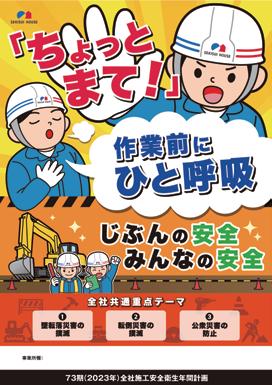
10. Response in the event of an emergency or accident
11. Evaluate system
12. Revise system
After reflecting on occupational accidents that occurred at construction sites the previous fiscal year, we set the priority themes for FY2023 as “elimination of falling accidents,” “elimination of tripping and stumbling accidents” and “prevention of accidents that affect the public” and created a Company-wide annual plan. We will continue to thoroughly practice basic safety activities and establish effective measures to realize safe and secure construction sites.
Occupational health and safety activities at construction sites
We made efforts based on our priority themes for FY2023: “elimination of falling accidents,” “elimination of tripping and stumbling accidents,” and “prevention of accidents that affect the public.”
Since falling accidents can lead to serious injury or death, we strengthened training and instruction of construction site personnel. We created and started distributing educational videos on eliminating stepladder accidents as a form of instructional material. Going forward, we will increase the variety of these educational videos and make them available for construction workers to view at any time.
Elimination of tripping and stumbling accidents
We continued efforts to thoroughly ensure worksite tidiness, in particular, check items during site patrols. For example, we advanced and strengthened the securing of safe walkways and the designation of tidiness. We also created educational videos on eliminating tripping and stumbling accidents as well as strengthening training and instruction of construction site personnel.
of accidents that affect the public
We designated “elimination of third-party personal injury,” “elimination of selfinflicted accidents,” “prevention of objects falling,” and “prevention of accidents involving heavy machinery” as priority themes and took thorough measures to prevent recurrences of past accidents. Although the number of overall accidents has decreased, it is not yet zero, making this an ongoing challenge for 2024.
The elimination of falling accidents is one of the important disaster prevention themes of the Group’s construction sites, and the appropriate use of full harness safety belts is an important preventive measure.
Due to amendments to the law, on January 2, 2022, we completed our transition to the use of equipment compliant with new standards for fall prevention devices (safety belts), which are worn when working at high places. To fully understand the current situation, we implemented surveys to determine how many of the individuals engaged in such work had equipment that met the new standards and how many had completed special training for work with full harness safety belts. Since FY2022, we have implemented training held by the head office for newly appointed staff and others needing to be qualified (there were 537 participants in FY2023). We conducted Safety Manager Initial Training for relevant employees at business sites, Customer Service Centers and Sekisui House Construction companies, with 20 participants in FY2023. To support this training, we helped create an environment where employees can easily obtain required certifications through measures such as online lectures and hands-on training in small groups. We will continue to provide situation-relevant assistance and support for training aimed at construction site health and safety education.
Checking safety risks at construction sites
Sekisui House’s business operations entail the use of heavy machinery and work performed in high places, and as such there is a significant possibility of a fatal accident occurring. We therefore carry out site inspections at each business site for all new projects for which we receive orders. In addition to planning construction in accordance with manuals and checking risks related to the safety of construction workers, in accordance with Japanese laws, we consider the impact on local residents from the planning stage.
Onsite safety patrols (including contractor sites)
To prevent accidents, Sekisui House conducts regular safety patrols at worksites. These patrols check that construction is being carried out in accordance with our safety standards and are performed not only by Sekisui House’s onsite managers, but also by contractors. By involving construction contractors, we aim to go beyond merely issuing one-sided corrections and directions to foster a more substantive understanding of our health and safety standards.
Health and safety management initiatives
As a form of internal occupational health and safety audits, Sekisui House conducts special safety audits of individual worksites. When deemed necessary by the head of the Construction Strategy Department, these audits are conducted at worksites where the number of accidents has reached a level requiring attention or where accidents or infractions defined as significant by the Company have occurred.
While we did not conduct any special safety audits in FY2023, the Construction Health and Safety Committee conducted safety audits at headquarters Company-wide to raise awareness of health and safety management at different business locations. We conducted one audit at each headquarters for a total of 17, confirmed that the annual construction health and safety plan is being implemented, and gave corrective instruction when deviations were identified.
Lost Time Injury Frequency Rate (LTIFR)/ Frequency
Contractors
For the boundary of the data, click here (content from page 177 will open in a new window).
Occupational health and safety initiatives at Konoike Construction Group company Konoike Construction has maintained certification under the Construction Occupational Health and Safety Management System (COHSMS) since FY2014 at all its offices as an initiative for occupational health and safety. Striving to eliminate accidents, Konoike Construction conducts regular internal audits of construction sites, safety patrols, as well as education on health and safety for its workers and the management and workers of partner companies.
Calculation standards:
Lost time injury frequency rate: Number of fatalities and injuries per million working hours due to lost worktime injuries
Frequency rate of occupational illness: Number of occupational illnesses per million working hours
Targets:
Employees, excludes part-time workers.
Construction department contractors, includes sole proprietors and employers.
Boundary:
Employees of Sekisui House Real Estate Group and employees of its 11 Group companies, and employees of Sekisui House Trust, Ltd. and Sha Maison SAST Insurance Ltd. (excluding part-time workers)
Total working hours:
Calculated based on actual working hours of employees and contractors (in the Production and Procurement Division).
Calculated as eight hours per person per day for construction department contractors of Sekisui House and Sekisui House noie.
Calculated as nine hours per person per day for construction department contractors of Konoike Construction.
Indicators marked with ✓ have been assured by KPMG AZSA Sustainability Co., Ltd.
Industry Average Rates of Occupational Accidents
The number of Sekisui House employee fatalities over the past three years was zero. The number of contractor fatalities due to occupational accidents in Sekisui House construction departments over the past three years was one in FY2021, one in FY2022 (due to heat stroke), and one in FY2023.
Occupational accidents at construction sites and responses
• The number of occupational accidents in FY2023 resulting in one or more days of lost worktime at construction sites was 97, a decrease to 96% of that in the previous fiscal year.
• The number of falling accidents (including those not resulting in lost worktime), which can lead to serious injury and were a FY2023 priority theme, increased to 111% of that in the previous fiscal year.
• Falling accidents, tripping and stumbling accidents, and accidents involving lacerations or punctures accounted for 70% of all accidents, with the first two categories typically resulting in prolonged time off from work. Thus, we will continue to prioritize the elimination of falling, tripping and stumbling accidents. We will implement measures that directly address construction site frontline dangers such as through distribution of videos of common accidents such as falling from ladders, slipping, tripping or losing one’s footing as well as putting up posters.
• After surveying and analyzing occupational accidents, we found that, by job type, accidents were common among carpenters and erectors. As such, to raise awareness among front-line workers, we coordinated with newly appointed safety representatives at each headquarters to implement training for job types with high accident rates.
• Although the number of incidents of heat stroke (including those not resulting in lost worktime) rose to 112% of that in the previous fiscal year, all of these incidents resulted in three days or less of lost worktime.
• There were also reports of accidents involving third parties, such as pedestrians tripping over equipment set up outside of construction sites as well as vehicles moving when unmanned. We will therefore reinforce preventive measures by thoroughly investigating the causes of such accidents ensuring rigorous risk management at the planning stage, and confirming the implementation of measures to prevent recurrence.
• To raise awareness of health and safety management at different business locations, we selected one business site for each headquarters and conducted safety audits. In FY2023, we performed 17 of these audits.
• In FY2023, there was one fatal accident. Occupational Accidents at
For the boundary of the data, click here (content from page 177 will open in a new window).
1 Total numbers of accidents resulting in one or more days of lost worktime.
2 Contractors of Sekisui House (including sole proprietors and employers)
Occupational Accidents at Construction Sites by Type (including those not resulting in lost worktime, excluding heat stroke)
As such, our partner building constructors are irreplaceable, and we hold them in high regard, fostering relationships of trust and mutual interest to work together over the long term in the spirit of a “community with a common destiny.” To realize customer satisfaction, the Sekisui House Association cooperates with each Sekisui House office to pursue initiatives aimed at implementing safety measures, improving construction quality, providing solutions for customers and neighbors, achieving zero emissions, keeping construction sites tidy, developing human resources and improving working conditions. Moreover, the association serves as a venue for information exchange that allows individual construction sites and partner building constructors to share issues they face and study possible solutions. The association also offers training and study opportunities to improve work processes and construction quality. The Sekisui House Association is a tremendous driver of action in times of natural disaster, such as when an earthquake or flood strikes, from the initial response to restoration and reconstruction.
We will continue working with the association to strive for customer satisfaction and raise the value of the Sekisui House brand, aiming for coexistence and co-prosperity as “a community with a common destiny.”
Collaboration with Sekisui House Association
The greatest strength of the Group is the Sekisui House Association, which consists of Group companies involved in construction and partner building constructors. As of February 1, 2024, the association includes eight Sekisui House Construction companies that are part of Sekisui House Construction Holdings, Ltd. (an intermediate holding company for the Sekisui House Construction Group) and approximately 7,000 partner building constructors throughout Japan (including the partner building contractors of Sekisui House Construction companies, which are members of the Sekiwa Association).
From its very start, Sekisui House has pursued “design-build” construction.
Thorough occupational health and safety
P.199 Occupational health and safety activities at construction sites
Enhancing benefits
Collaboration with the Sekisui House Association
We also run various benefit programs to support partner building constructors and construction technicians who work on our construction sites across Japan. The Sekisui House subsidy system is designed to support improvement in workforce management at partner building constructors and to expand benefits for construction workers. The system granted subsidies amounting to approximately ¥1.4 billion in FY2023.
The Sekisui House Cooperation Association was established in 1982 to improve employment practices and benefits among partner building constructors. It assists in the running of various systems at Sekisui House, including our construction site safety assurance system and funded pension system.
construction quality
Sekisui House Chief Technician certification
The Sekisui House Chief Technician certification, established in 1983, is a selfcertification system run by the Sekisui House Cooperation Association. In April 1985, this certification became the first of its kind in the construction and housing industry to obtain ministerial authorization as being in line with national certifications. Sekisui House supports the administration of certification examination. The examination is held once a year, and in FY2023, 110 people passed. Certified individuals now number 6,574, and the certification is helping onsite work leaders to maintain and improve construction quality.
The purpose of the certification is to evaluate the skills of technicians fairly and accurately, and to maintain and improve quality. To be eligible to take the certification exam, one must have three years or more experience doing the relevant type of technical work onsite for Sekisui House and complete a short

course. The three types are: foundation work, framing/exterior work and interior finishing.
Newly revised from FY2024, this system rewards carpenters as well as skilled framing and exterior workers based on fair evaluations of their production and skills according to their own technician level rating (from 1 to 4). This system aims to increase the production and skill level of technicians while improving the quality of construction site work, promoting safety management and enhancing customer service. In framing and exterior work, rewards will be determined at the team level to increase team productivity and ensure quality and safety.
Target individuals are crafters engaged in framing, exterior and interior carpentry work at new house construction sites. They must also be registered in our construction workers database.
The requirements for partner building constructors are that they have a basic construction contract with Sekisui House and have completed the signing of a memorandum regarding the Sekisui House subsidy system. Accordingly secondary partner building constructors and beyond must sign a written agreement regarding the Sekisui House subsidy system with the partner building constructor that exercises direct supervision over them.
Each evaluation takes into account construction capabilities at the start of the fiscal year, attendance records and other information in the construction workers database. Level 4 determinations are made by confirming onsite working attitude and construction quality, with eligible individuals (or teams) receiving monetary rewards.
We also have the Sekisui House Remodeling Meister System, established in 2008 by Sekisui House Remodeling, which certifies and registers superior technicians working for partner building constructors who do remodeling work for Sekisui House Remodeling. In addition to volume of work and technical skills, the certification system extends to areas including homeowner satisfaction, attitude and consideration for others on the construction site, attention to safety, management capabilities, and ability to foster young talent.
With the total number of construction workers on the decline, we are working to ensure ongoing, reliable construction capacity by strengthening our technologies while also taking steps to make the most of our existing construction capabilities. We have launched two working groups to improve productivity— one to focus on solutions employing physical resources and the other to focus on solutions involving systems and people. Through these efforts, we seek to reduce person-hours and the burdens of construction work. We have organized a Technical Directors’ Council, Construction Committee and Worksite Productivity Improvement Working Group, consisting of deputy heads and deputy branch heads representing locations around the country, as well as staff from the head office and factories.
These groups have successfully promoted initiatives to improve productivity, such as developing the SHAWOOD large-scale fixed sash combined construction method.
We also have in place the “My Idea” construction improvement proposal system, through which construction workers across the country can make suggestions based on the creative ideas or items they are using onsite. We select submissions that can help improve productivity and work to spread them among construction workers, mainly through the Chief Constructors of each area.

Educational training centers and training schools
Sekisui House has established educational training centers and training schools where we conduct training that allows technicians from our Group to learn techniques and acquire skills. These facilities also teach proper conduct to facilitate interaction as professionals and prepare trainees for the working environment. Our educational facilities are unique in that they do not merely provide the opportunity to acquire technical skills and knowledge necessary for construction with Sekisui House, but also the opportunity to study our Corporate Philosophy, which is indispensable for achieving customer satisfaction.
In FY2023, three trainees completed the foundation construction course, 33 finished the framing/exterior course, and 56 completed the interior finishing course, for a total of 92 newly minted technicians. These technicians are now working as construction technicians and construction managers around Japan. After the training courses end, we hold a variety of training offerings at each educational facility, working continuously to improve technical knowledge and skills.

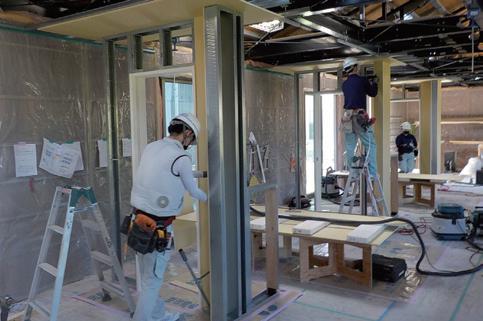
We became the first housing manufacturer to establish a technical training center in Vietnam for housing construction with the November 2019 opening of our facility in Hanoi, Vietnam. The center strengthens our system for taking on technical trainees from Vietnam.
We have a service agreement with the JIC Kyodo Kumiai Support Association to help local organizations prepare recruits. These technical trainees are able to study practical Japanese while remaining in familiar surroundings in
their home country for at least six months so that they can smoothly start their lives in Japan. Moreover, we provide an environment where trainees can work with peace of mind by providing extensive support such as conducting handson training at domestic training facilities before actual work begins.
In January 2020, the six trainees who went through the foundation course in Hanoi came to Japan. However, the spread of COVID-19 prevented us from conducting subsequent education or training as planned. In 2021, we began online support for recruitment interviews, technical training lectures Japanese language study and other activities. We also hired more local staff and established a system that enables us to conduct training at any time in preparation for resuming the entry of technical trainees into Japan.
In April 2022, most border restrictions related to COVID-19 were lifted, and we resumed education and training as originally planned.
Since February 2024, through hands-on training conducted at domestic facilities, we have created an enriched environment to provide these recruits with the same training a Japanese employee would receive. We will also work to strengthen practical Japanese learning done prior to arriving in Japan.
• FY2023 results: 95 new arrivals




We are committed to socially and environmentally responsible CSR procurement with the aim of contributing to a sustainable society, including the supply chain, based on a purchasing policy that combines providing the best quality, robust delivery, and reasonable prices while also incorporating ESG considerations. Specifically, the ESG Promotion Committee has designated social and environmental issues in the supply chain as priority issues, of which human rights, labor and other issues are discussed at a human rights due diligence meeting under the Social Improvement Subcommittee, and issues such as decarbonization and timber procurement are discussed and promoted by the Environmental Subcommittee. Supply chain management is being addressed on the basis of mutual cooperation by all related departments under the supervision of the officer in charge of the Division of Technology and Production. The department in charge of procurement is working to improve suppliers’ understanding and awareness of key ESG issues and business continuity planning (BCP), such as quality and supply, by holding annual activity policy briefing sessions and various study sessions.
Procurement staff can refer to the guidelines and other regulations at any time. In addition, related departments use seminars and working groups to keep efforts up to date with the latest laws and social issues.
Upon signing the United Nations Global Compact in 2018, we joined the supply chain subcommittee of the Global Compact Network Japan (GCNJ). We established the CSR Procurement Guidelines for our suppliers, which are compliant with the GCNJ’s self-assessment questionnaire (SAQ).
Since then, we have asked suppliers to submit a signed agreement to confirm their understanding and compliance with the purpose and content of the guidelines, as well as cooperation with periodic checks or audits regarding their efforts, and we explain the significance and importance of CSR procurement to our suppliers at our annual action policy briefings held each February. In addition, at the end of each year, we conduct a CSR evaluation using a self-assessment check sheet based on the GCNJ’s SAQ, in order to confirm
compliance with the guidelines. By implementing the PDCA cycle for CSR procurement with these initiatives, we are raising awareness of social responsibility among our suppliers and deepening CSR procurement.
Even when commissioning new suppliers, we perform evaluations based on internal regulations to confirm the company’s suitability in terms of ESG and other factors. In addition, we require a signed agreement confirming their understanding of the purpose and content of the CSR Procurement Guidelines before any transactions are conducted.
We hold an annual action policy briefing for our suppliers to ensure the best quality, robust delivery and reasonable price while promoting ESG in procurement. The purpose of the briefing is to deepen the understanding of suppliers regarding our procurement activities, and approximately 150 major suppliers participate. In addition to explaining specific procurement initiatives, we share examples of improvements that suppliers have made and honor outstanding suppliers. We also provide feedback on CSR evaluations and hold lectures by external lecturers to raise awareness of ESG issues.
We are strengthening policy-based actions and our partner relationships to promote a common understanding of priority issues with key suppliers, align the directions of activities, and promote major reforms and improvements. In FY2023, we carried out activities in these areas with 10 companies.
Supply chain policy on social issues
We recognize “human rights and labor” as one of the most important social issues in our supply chain. The Sekisui House Group Human Rights Policy applies to all officers and employees of the Sekisui House Group. We also expect our business partners, including partner building constructors and suppliers, to understand and support this policy. The Sekisui House Group Human Rights Policy is available on the online information-sharing platform we maintain with our suppliers and we promote compliance with the policy.
The CSR Procurement Guidelines prohibit discrimination based on nationality or race, inhumane treatment, forced or compulsory labor, and child labor. They also require appropriate management of employee health and safety. We obtain signed agreements from our suppliers indicating that they understand the purpose and content of the guidelines.
Sekisui House Group Human Rights Policy
In order to promote respect for human rights in the supply chain, it is essential to expand the circle of engagement from our suppliers to their suppliers. To this end, in February 2022, we held a study session with external lecturers at which approximately 150 suppliers participated with the aim of raising awareness and acquiring basic knowledge. Furthermore, in September that same year, in response to the establishment of the Guidelines on Respecting Human Rights in Responsible Supply Chains by the Japanese government, we surveyed 360 of our suppliers about their efforts to establish human rights policies, publish these, and promote awareness throughout their supply chains in order to understand current conditions.
Based on the survey’s results, in February 2023, we held a study session with 157 suppliers and Sekisui House procurement staff where participants shared information about leading initiatives and deepened their understanding of the Japanese government’s guidelines. Furthermore, in October of the same year, we held a study session with external lecturers on practical points of the guidelines, at which 279 suppliers and Sekisui House procurement staff participated and improved their practical knowledge. We will continue to make efforts to respect human rights in the supply chain and hold study sessions as training
opportunities concerning environmental and social issues for Sekisui House procurement staff.
The CSR evaluation is conducted using a self-assessment checklist based on GCNJ’s version of SAQ. Suppliers are asked to self-evaluate their own initiatives in nine areas, including corporate governance, human rights, and labor, from five perspectives ➀awareness of laws, ②policies, ➂systems and responsibilities, ④confirmation of results of initiatives, and ⑤corrective actions. The results are then scored and evaluated.
In the event that risks are found in the results of the CSR evaluations of existing suppliers in areas such as the environment or human rights, we conduct monitoring to understand actual conditions by visiting the individual suppliers in question and providing advice on the evaluation criteria and achievement levels. In this way, we practice due diligence. In the event that a significant risk is discovered, the Company will take appropriate action in consulting with relevant departments and stipulating measures such as reduction of transactions depending on the supplier evaluation score.
As of the end of 2023, we conducted CSR evaluations of 163 suppliers and determined that four suppliers should be monitored in terms of human rights, three in terms of labor, and one in terms of the supply chain (with overlap). We are monitoring each company to promote improvement. In serious cases, we work with the department concerned to determine the proper response and stipulate measures to be taken, which might include cutting back on transactions, depending on the score in the supplier assessment.
As a construction company, we consume a large volume of lumber and recognize the need for especially strict lumber procurement. For this reason, we implement an annual wood procurement risk survey of about 60 major wood building material suppliers.
Furthermore, when necessary, we conduct onsite inspections in Japan and overseas, including visits to logging areas at the most upstream portion of the supply chain. In FY2023, we surveyed 63 companies, as well as conducted additional field checks of logging areas and timber suppliers in Vietnam. P.134 Wood procurement risk survey
Since FY2021, we have been requesting suppliers to report violations of laws and regulations in addition to answering each question in the CSR evaluation. This complements the results of the CSR evaluation and allows us to identify highrisk suppliers who may be in violation of compliance and take prompt action. In FY2023, there were 10 reported cases, all of which were appropriately resolved in accordance with guidance from governmental authorities with no compliance violations being identified. Additionally, no high-risk suppliers were identified.
Promoting business continuity planning (BCP)
We have long worked with our suppliers to establish an initial response communication system for use in the event of natural disasters and conduct associated drills. In recent years, however, previously unfathomable procurement risks have become more frequent, including not only natural disasters and industrial fires, but also risks including global semiconductor and raw material shortages, supply-demand imbalances caused by expanding infectious diseases and rapidly recovering demand, geopolitical risks, and cyberattacks. To address a broad range of these risks, we held the Supply Chain Resilience Promotion Conference online with approximately 160 suppliers participating in September 2021 and approximately 260 participating in September 2022. In order to strengthen the supply chain, it is necessary to expand the circle of engagement from our primary suppliers to secondary and tertiary suppliers. At the conference, we explained our activities to strengthen BCP and shared specific examples of our suppliers to raise awareness. We aim to build a more robust supply chain based on the three pillars of delivery, specifications and information. Furthermore, in FY2023, we have analyzed and illustrated the risks and impacts to strengthen specific measures. In addition to raising the awareness of those in charge of procurement operations, we are promoting activities with clearly defined targets.
To ensure fair and impartial transactions, we conduct supplier assessments for our suppliers in order to evaluate such factors as quality, delivery and cost (QDC) as well as technical capabilities. CSR evaluation is one of the supplier assessment criteria. We disclose the assessment results to the concerned suppliers so that they can use them to improve and strengthen the structures within their respective companies. In carrying out these assessments, the focus is on process management to encourage reforms, rather than uniform evaluations of the results of such efforts.

The FY2023 supplier assessments covered 110 companies representing 74.2% of total procurement spending. Going forward, we plan to implement highly transparent supplier assessments and continue to support the strengthening of suppliers’ frameworks while maintaining fair and impartial transactions.
1 Percentage of suppliers covered by assessments to all suppliers (by purchased value; trading companies are not included in these assessments)
In November 2022, Sekisui House joined the Declaration of Partnership Building system set up by the Japanese Cabinet Office. Under this system, the representatives of companies that contract out work make a Declaration of Partnership Building in which they commit to coordinating and promoting coexistence and co-prosperity with business partners and value-creating contractors in the supply chain to build new partnerships. Nearly 48,000 companies have made declarations. Each company posts the following information regarding this declaration on a dedicated portal site.
1. Coexistence and co-prosperity throughout the supply chain and new partnerships that transcend scale and business affiliation
2. Compliance with preferred business practices between contractors and subcontractors (a “promotion standard” based on the Act on the Promotion of Subcontracting Small and Medium-sized Enterprises)

The Sekisui House Group views the enhancement of corporate governance as a key management issue to sustainably advance our business and secure the trust of all shareholders.
We designated 2018 as the first year of governance reforms, steadily enacting specific measures such as introducing mandatory retirement at age 70 for representative directors, establishing Management Meetings, defining the responsibilities of directors of the Board in terms of departmental supervision, and reforming of the renumeration system for officers and the executive officer system. These reforms allowed us to improve the sustainability of our operations and strengthen the effectiveness of our governance.
Integrity—sincerity and high moral values—is central to our governance reforms. Built upon our Corporate Philosophy, this concept resonates with
Naoki Kawamura Chairperson of the Environmental Subcommittee Executive Officer and Head of Legal Department
our philosophy of Love of Humanity, and with our stance of truth and trust. Whether it be the selection of prospective directors of the Board or in sales, production and construction operations, we place greatest importance on integrity in all corporate activities. Our commitment to becoming a leading company in ESG management remains steadfast.
Having begun in FY2023, our Sixth Mid-Term Management Plan aims to promote further improvements to governance in terms of both senior management and business management in order to facilitate the active innovation and communication that is the driving power behind the Sekisui House Group.
Regarding our business management, our Board of Directors has reached a stage where increased diversity enhances effectiveness, allowing us to further strengthen our governance. Outside directors and female
directors account for 50% and 30%, respectively, of its membership. With an outside director as its chair, the Board of Directors works to increase its effectiveness and, to this end, proactively utilizes periodic and objective evaluations undertaken by third-party agencies. With regard to business execution, the Board of Directors will advance the delegation of its authority to Management Meetings and other bodies. In these ways, we will invigorate discussions of medium- to long-term strategies based on the global vision while increasing the sophistication of our corporate governance via the strengthening of the Board of Directors’ supervisory functions over business execution. To reinforce the effectiveness of the human resource pipeline for future senior management personnel, we have established a Succession Plan Council, a cross-departmental organization aimed at sharing information across all divisions regarding successors as well as discussing how to nurture candidates. Regarding information disclosure, we revised our structure for preparing the annual Securities Report by bringing in the expertise of external agencies while enhancing the content of non-financial information disclosed in this publication. Regarding our business management, we train and optimally allocate governance specialists while developing and strengthening internal audit functions for all domestic and overseas Group companies. In these and other ways, we endeavor to strengthen our corporate functions and enhance the effectiveness of our Group-wide governance network. On the domestic side, we founded Sekisui House Construction Holdings in February 2024, increasing governance functions by defining responsibilities and delegating authority from the Sekisui House head office. In April 2024, M.D.C. Holdings, Inc. became a wholly owned subsidiary, helping us further promote the establishment of group governance in the United States. To foster human rights and compliance practices in all Company workplaces globally, we have expanded departments that specialize in these topics and enhanced our whistleblowing and counseling hotline systems. Additionally, we hold integrity and management training for new chief managers and general managers in order to establish a vibrant environment with a high degree of psychological safety, thereby fostering a corporate culture based on mutual trust achieved via robust communications.
Commitment to Governance
Moving forward from the development of a corporate governance framework to the new stage of realizing its functional effectiveness
— The Board of Directors, now equipped with greater diversity than before, exercises its functions to the fullest. —
■ Facilitating lively Board room discussions in accordance with our global vision
• Enhancing the Board of Directors’ functions via the third-party evaluation of its effectiveness
• Delegating authority from the Board of Directors to Management Meetings and other bodies
■ Strengthening the effectiveness of our senior management candidate pipeline
• Strengthening our pipeline by upgrading the selection process for executive officers and operations officers
• The Personnel Affairs and Remuneration Committee monitors the effectiveness of the management pipeline
Rolling out Group governance systems on a global basis
— Removing boundaries between domestic and overseas Group entities, with the aim of creating a network based on mutual trust. —
■ Establishing Group governance in the U.S.
• Ensuring that our U.S. operations are supervised by clearly defined regional headquarters functions on an ongoing basis
• Allocating human resources to local subsidiaries based on their functions
■ Promoting the development of a governance network
• Stepping up the development of governance specialists and optimally allocating them to Group companies at home and abroad
• Strengthening corporate functions in place at domestic and overseas Group companies
■ Enhancing our internal audit structure for global auditing
• Developing internal audit functions aligned with the size of Group companies at home and abroad as well as risks specific to each
Increasing the sophistication of stakeholder engagement
— Exercising spontaneous judgment for consistent information disclosure. —
■ Further upgrading our mode of information disclosure
• Enhancing the content of information being disclosed about the current status of the linkage between tackling material issues and strengthening corporate governance
• Securing consistency in information disclosure and reinforcing its effectiveness as messaging
Fostering a corporate culture based on mutual trust achieved via robust communications
— Aiming for the creation of a workplace that ensures psychological safety for employees and empowers them to work vibrantly. —
■ Developing an environment aimed at raising compliance awareness among employees
• Promoting training for all employees while encouraging the active use of whistleblowing and counseling hotline systems
■ Strengthening our capabilities for autonomous organizational management
• Securing a greater number of leaders equipped with robust integrity
― Strengthening the effectiveness of our senior management candidate pipeline
A More Sophisticated Executive Officer Selection Process
We implemented the Succession Plan Council to visualize successors for employed executive officers and operating officers, sharing succession information among division officers (operating officers and higher) and general managers to enhance the management candidate pipeline.
― Enhancing the content of non-financial information publicized through legal disclosures
Establishing a Disclosure System
To respond to enhanced reporting requirements for sustainability information following revisions to the Cabinet Office Ordinance on Disclosure of Corporate Affairs, we organized a cross-departmental task force from relevant departments to create the Securities Report. By coordinating this obligatory information disclosure with documents such as the Value Report (Integrated Report), our voluntary disclosure medium, we were able to guarantee consistency and improve our messaging.
― Strengthening Group governance
Founding Sekisui House Construction Holdings, Ltd.
To enhance and expand our construction capabilities, which constitute an integral part of the Group’s core competencies, we decided to move the Sekisui House Construction Group to an intermediate holding company system. In February 2024, we conducted an absorption-type split between the Company and this intermediate holding company Sekisui House Construction Holdings, Ltd. We also plan to expand the business range handled by this company. To this end, we aim to fully leverage the locally-rooted customer bases possessed by each Sekisui House Construction company as we strive to ensure safe and high-quality construction work. In order to realize our growth strategies and strengthen governance, we will also enact flexible revisions to systems, including that of personnel, while clarifying the responsibilities and authority delegated to this intermediate holding company. In this way, we will enhance our built-to-order business.
To facilitate the global implementation of Sekisui House’s policy on human rights and compliance, we have renamed our Legal Department’s Human Relations Office as the Human Rights and Compliance Promotion Office to clarify its function as a specialized organization while increasing its staff. This organization now centrally manages systems including the Sekisui House Group Compliance Helpline, our whistleblowing system, as well as the Sekisui House Global Helpline and the Sexual and Power Harassment Hotline, which receives consultations on sexual and power harassment and human rights related issues.
In accordance with Sekisui House Group’s Corporate Philosophy, we position corporate governance as a key management challenge and a foundation for sustainably enhancing corporate value and creating shared value for stakeholders. The Sekisui House Group has improved the effectiveness of its corporate governance to increase corporate value and has put in place a system that enables speedy management marked by integrity. We disclose to stakeholders our Basic Policy1 on Corporate Governance, which establishes the fundamental concept and framework of the Company’s corporate governance. The Sekisui House Group positioned 2018 as the first year of governance reforms. We have steadily implemented each initiative to build a resilient management base for long-term sustained growth in corporate value. We will continue to widely disclose the concept and framework regarding our corporate governance to all stakeholders while continuously striving for improvements.
1 Details regarding the Basic Policy on Corporate Governance are available on our website.
2018 First year of corporate governance reforms
Increased the number of outside directors of the Board from two to three and the number of outside Audit and Supervisory Board members from three to four
1. Introduction of a mandatory retirement age of 70 for representative directors of the Board
2. Appointment of women as outside officers
3. Increasing transparency and enlivening meetings of the Board of Directors
4. Establishment of Management Meetings
5. Clarification of departments under the control of directors of the Board
6. Evaluation of the effectiveness of the Board of Directors
7. Ensuring the independence and strengthening the check-andbalance functions of the heads of general affairs of sales administration headquarters and branches
8. Increasing the integrity of branch heads
9. Introduction of a restricted stock remuneration system (2019)
10. Abolition of the bonus system for outside directors of the Board (2019)
2020 Revised the basis for proportional allocation of remuneration and determined appropriate remuneration levels
Increased the number of outside directors of the Board from three to four Established the ESG Promotion Committee (reorganization of the CSR Committee)
2021 Reform of the executive officer system
Outside director of the Board appointed as Chairperson of the Board of Directors
Disclosed individual remuneration of internal directors of the Board
2022 Increased the number of outside directors of the Board from four to five
• In accordance with the organizational design stipulated in the Companies Act, we have adopted an Audit and Supervisory Board system, in which the Audit and Supervisory Board and its members possess significant independence. In addition, to create a management system that speeds up management decisions and responds properly to rapidly changing economic and market conditions, we have established an executive officer system.
• In April 2021, we created four distinct tiers as part of reforms to the executive officer system: entrusted executive officers concurrently serving as directors of the Board (President, Vice Chairman, Vice President, Senior Managing Officer), entrusted executive officers who are director of the Board candidates (Senior Managing Officer, Managing Officer), employed executive officers who maintain their status of employee and therefore can be flexibly appointed, and operating officers who are candidates for the preceding position. We are strengthening the development of management personnel at each division and building a sustainable leadership pipeline through the clarification of roles, personnel requirements, and selection and dismissal processes.
• Also since April 2021, we have expanded the functions of the Management Meetings beyond deliberations on important agenda items to be brought up to the Board of Directors. Entrusted executive officers (managing officer and higher) share information and make decisions regarding individual business execution. Furthermore, outside directors of the Board and Audit and Supervisory Board members are welcome to attend as observers.
• The Board of Directors, including outside directors of the Board, comes equipped with a skill matrix of diverse knowledge, experience and ability to create business strategies, management policies and plans, and remains responsible for medium-to-long-term execution of important business. We adopt the above structure aiming to secure moderate separation between management supervision functions and business executive functions by delegating short-term and segment specific business execution functions to Management Meetings and other like conferences.
The Board of Directors consists of ten directors of the Board (seven men and three women) including five outside directors of the Board and meets once per month in principle. To improve corporate value over the medium-to-long term, the Board of Directors shall be responsible mainly for establishing management policies, strategies and plans, and making decisions on the execution of important operations, as well as for supervising and evaluating the execution of duties by directors of the Board and executive officers and for establishing systems, such as internal control and risk management, to ensure the soundness of management.
In addition, to promote the constructive exchange of opinions, we decided not to combine the positions of Chairperson of the Board of Directors and the convener. Therefore, from May 2021, an outside director of the Board, Toshifumi Kitazawa, has been appointed and currently serves as the Chairperson of the Board of Directors, while Representative Director of the Board, President, Executive Officer (Yoshihiro Nakai) currently serves as the convener.
The Board of Directors shall have the number of members that is considered appropriate for substantive deliberations, and independent outside directors of the Board shall be selected so that the ratio of independent outside directors on the Board of Directors is one-third or more. Moreover, we formulate a skill matrix based on business strategies and management plans to help ensure the Board of Directors shall have a well-balanced composition of members with full awareness of the skills required for the Board of Directors. Members shall include experts in finance, accounting, laws, compliance and other relevant areas, with consideration for knowledge, experiences, and ability; the number of years in office; and gender, ensuring both suitable diversity and proper headcount.
We have also established the Office of Directors of the Board as an organization for assisting outside directors of the Board in their duties, and assigned several employees to it, including full-time staff.
Number of agenda items and main contents for FY2023
84 Resolutions: Board of Directors effectiveness evaluations for the 72nd fiscal year as well as external disclosure and financial results, income plan for the 73rd fiscal year, disclosures regarding the Sixth Mid-Term Management Plan, partial revisions of rules for officer remuneration, partial revision of fundamental policies of the development of the internal control system, establishment of the Human Rights and Compliance
Promotion Office, partial revision regarding inclusion criteria for agenda items to be addressed by the Board of Directors (higher threshold for monetary amounts involved), organizational restructuring of Sekisui House Construction Group, etc.
68 Reports: Personnel Affairs and Remuneration Committee status of activities, Risk Management Committee status of activities, audit policies and plans, implementation of dialogue with institutional shareholders, implementation status of internal audits, initiatives aimed at improving the content of information disclosed via the Securities Report, verification of cross-shareholdings, status of initiatives regarding the Group’s capital cost management, summaries of Management Meetings, etc.
The Audit and Supervisory Board has five members (four men and one women), of whom three are outside members. It formulates audit plans and based on those plans it conducts hearings regarding risks and other issues pertaining to the assigned duties of directors, executive officers, key office heads, the directors of subsidiaries and others.
In addition, Audit and Supervisory Board members exchange opinions and work closely with the Internal Audit Division, hold regular meetings with the accounting auditor and engage in mutual cooperation to ensure that all audit activities are carried out efficiently and effectively.
Furthermore, we established the Office of Audit and Supervisory Board members as a dedicated organization to which several employees including full-time staff are assigned to assist in Audit and Supervisory Board operations. If said employees are concurrently assigned other duties, they must not be influenced by guidance or commands from the other division to which they are concurrently assigned and, with regard to human resource matters pertaining to these employees, the opinions of Audit and Supervisory Board members must be considered to ensure the independence of such employees with regard to Audit and Supervisory Board operations.
As a consultative body to the Board of Directors, the Personnel Affairs and Remuneration Committee provides opinions to the Board of Directors to ensure fairness and transparency with regard to the personnel affairs and remuneration of the directors and executive officers. In addition, the committee, based on delegation from the Board of Directors, determines the amount of remuneration for individual directors and entrusted executive officers.
The committee is chaired by an independent outside director and the majority of
its membership consists of independent outside directors. Currently, the committee members are comprised of two representative directors and three independent outside directors, with independent outside director (Yukiko Yoshimaru) serving as the chairperson.
Chairperson: Yukiko Yoshimaru (Outside Director of the Board) Committee members: Toshifumi Kitazawa (Outside Director of the Board), Keiko Takegawa (Outside Director of the Board), Yoshihiro Nakai (Representative Director of the Board, President, Executive Officer and CEO), Satoshi Tanaka (Representative Director of the Board, Executive Vice President, Executive Officer)
Main subjects discussed in FY2023
(related to nomination)
• Outside directors’ meeting aimed at evaluating the performance of the CEO
• Selection of candidates for directors of the Board and entrusted executive officers
• Establishment of requirements for the next CEO
• Framework for nurturing CEO successors
• Inauguration of the CEO Succession Plan Council
• Partial revisions of skill matrices
(related to remuneration)
• Revision of rules for officer remuneration
• Comparative verifications of the remuneration amount, with the amount of remuneration paid at external companies used as benchmarks
• Evaluation of officer performance for the 72nd fiscal year and the determination of bonuses to be paid to individual recipients
• Inclusion of 73rd fiscal year performance-related bonuses and Performance Share Units (PSU) into deductible items for tax purposes
• Reference number of share units to be applied to PSU
• Determination of performance evaluation indicators (ESG-related items) for performance share units and target values for such indicators
Status of external advisors’ involvement in the determination of remuneration Remuneration advisors from Willis Towers Watson (WTW) were in attendance when comparative verifications of the remuneration amount were conducted using external benchmarks.
Management Meetings
This body was established to promote the active exchange of opinions among entrusted executive officers for the purposes of holding prior deliberations on important matters to be submitted to the Board of Directors, making decisions on the execution of certain operation matters based on management policies and strategies, and sharing information on business execution policies and issues.
The committee also welcomes the attendance of outside directors of the Board and Audit and Supervisory Board members who act as observers. Additionally, depending on the matter at hand, the attendance of employed executive officers and operating officers is requested for an active exchange of opinions.
Composition
Chairperson: Yoshihiro Nakai (Representative Director of the Board, President, Executive Officer and CEO)
Entrusted executive officers: Yoshihiro Nakai, Yosuke Horiuchi, Satoshi Tanaka, Toru Ishii, Hiroshi Shinozaki, Haruhiko Toyoda, Keizo Yoshimoto, Masaru Noma, Kohei Hirota, Osamu Minagawa, Kohei Joki, Takehisa Yanagi, Shinji Aoki, Yoshinori Kimura, Yasushi Omura, Takahiro Kondo, Toru Tsuji, Hiroaki Yoshida, Norio Adachi, Toru Fujita, Koya Matsumura
Note: Outside directors of the Board and Audit and Supervisory Board members may attend as observers
ESG Promotion Committee
As a consultative body to the Board of Directors, the committee usually consists of at least two or more external committee members who bring specialist insight, internal directors of the Board, executive officers and others responsible for business execution. The committee thus enhances the effectiveness of ESG efforts through means such as exchanging opinions on the progress of ESG management initiatives and issues.
Composition
Chairperson: Yosuke Horiuchi (Representative Director of the Board, Vice Chairman, Executive Officer)
Outside members: Katsuhiko Kokubu (Dean and Professor, Graduate School of Business Administration, Kobe University), Hidemi Tomita (Representative Director, Institute for Sustainability Management)
Internal members: Yosuke Horiuchi, Hiroaki Oda, Haruhiko Toyoda, Toshiya Chikada, Yuki Isaka, Miwa Yamada, Naoki Kawamura, Hideaki Yasunobu, Hiroyuki Kawabata
Note: Directors of the Board, Audit and Supervisory Board members, executive officers and higher-ranking officers may attend as observers
As a consultative body to the Board of Directors, this committee strives to develop an appropriate risk management structure and secure the effectiveness of its operations. To this end, the Risk Management Committee gains an understanding of the risk management status of the entire Group and provides opinions to the Board of Directors as necessary. The committee’s risk assessment process includes risk mapping on the two axes of the frequency of risk materialization and the magnitude of impact on the Group. By doing so, the committee identifies important risk items in such areas as “quality management,” “information security,” “compliance,” “human rights,” “crisis response,” “the environment” and “labor laws and labor management.” Every month, the committee holds meetings to monitor and verify these risk items.
Also, the Quality Management Committee and the Information Security Committee are placed under the Risk Management Committee to engage in discussions employing specialist viewpoints and periodically report their conclusions to the latter.
Chairperson: Satoshi Tanaka (Representative Director of the Board, Executive
Vice President, Executive Officer)
Vice Chairperson: Keizo Yoshimoto
Members: Satoshi Tanaka, Keizo Yoshimoto, Masaru Noma, Kohei Hirota, Osamu Minagawa, Toru Fujita, Takahiro Kishi, Naoki Kawamura, Hiroyuki Kitamura, Hitoshi Makiguchi
Based on the Companies Act and the Regulation for Enforcement of the Companies Act, the Company developed and manages an internal control system, with basic polices deliberated by the Board of Directors. The Auditing Department, a specialized internal audit division, conducts onsite audits to confirm whether internal controls and internal management are being conducted appropriately and properly based on laws and regulations and internal rules to ensure effective management, and when necessary suggests corrective actions. Results of these audits are reported to directors of the Board and Audit and Supervisory Board members as well as related departments, in addition to regular reports at meetings of the Board of Directors. Moreover, the Auditing Department and the accounting auditor cooperate to execute effective internal audits.
We dispatch directors of the Board and others to conduct internal control of Group companies, including those overseas, and receive reports on their management status and important work execution. In addition, the Company’s internal audit division periodically audits Group companies and has strengthened the audit system for overseas Group companies by setting up an International Auditing Office within the Auditing Department.
Our policy for deciding on the appointment and reappointment of the accounting auditor is to have the Audit and Supervisory Board set the selection criteria and comprehensively evaluate items including the quality control system, independence, expertise, audit plan, audit system and estimated audit remuneration of the accounting auditor.
Strengthening the effectiveness of Sekisui House’s Board of Directors while striving to enhance corporate value over the medium-to-long-term

Amidst an operating environment that’s changing at a dizzying rate, businesses are called upon to further strengthen corporate governance while accurately understanding various challenges and risks confronting them in order to create and promote strategies that respond to changes properly and flexibly.
The Company’s Board of Directors is made up of five internal directors of the Board and five outside directors of the Board (three of whom are women). It has been four years since I, an outside director of the Board, humbly accepted the position of Chairperson of the Board. In this role, I make efforts to enable each director to fully leverage their diverse experience and skillset when holding candid discussions aimed at helping the Sekisui House Group realize sustainable growth. The Company also works to ensure moderate separation of supervision and execution. To this end, the Board of Directors takes the lead in further enhancing the Group’s overall supervisory functions through strengthened governance while empowering executives to promote growth-focused initiatives without overlooking opportunities to enhance the business and achieve healthy growth. This is why the Board of
Directors strives to operate with a high level of neutrality and transparency.
It is imperative that outside directors of the Board and outside Audit and Supervisory Board members all have an accurate understanding of business activities undertaken by the Sekisui House Group because Board room discussions aimed at addressing a variety of management issues need to be realistic, constructive and based on actual conditions. To this end, outside directors of the Board, with the support of the Office of Directors, meet individually with internal directors of the Board, visit construction and production sites, exchange opinions and ideas with local management of overseas businesses in the course of touring their work sites, and participate actively in various seminars and internal events.
FY2023 achievements due to outside directors of the Board’s engagement
• Australia site visit and exchange of ideas with representatives of a local subsidiary
• Participation in seminar for directors of the Board and Audit and Supervisory Board members featuring institutional investor guest lecturers
• Participation as lecturers in next generation leader management training program Keiei-juku as well as training at Sekisui House Women’s College aimed at nurturing female candidates for managerial positions
• Attendance at SHIP and WAZA as observers final selection for Sekisui House Innovation and Performance (SHIP) Awards Program and attendance at the Sekisui House Carpentry Championship Tournament WAZA as observers, etc.
Furthermore, the Company provides an open environment in which outside officers can observe important internal meetings including Management Meetings. Through observing these meetings, they are able to understand important issues to be discussed by the Board of Directors and can learn firsthand about the state of the Company and its employees. These experiences spur on the Board of Directors to engage in realistic and constructive discussions and are therefore useful in strengthening its effectiveness.
The Group’s global vision is to make home the happiest place in the world. To achieve this goal, we are promoting business aimed at providing homes worldwide where customers can live happily and with peace of mind through the utilization of housing technologies developed over many years. As the Chairperson of the Board of Directors, I will exert every effort to improve the functioning of the Board of Directors to achieve this goal in every part of the world.
For the Board of Directors to function properly, it must operate in a way that is highly effective and qualitatively well-balanced. Therefore, objective assessments from third-party agencies are useful in determining whether it is operating appropriately. Since 2018, the Company has conducted effectiveness evaluations of the Board of Directors’ overall operations, including the development status of systems for supporting directors of the Board as well as Audit and Supervisory Board members. This third-party evaluation confirms the strength of our Board of Directors, challenges it is currently confronting, and the status of improvement in connection with issues identified in the course of the evaluation undertaken in the preceding fiscal year, while providing reports on the future direction for the Board’s operation and other matters. The Board of Directors also receives detailed reports on assessment results and discusses specific initiatives aimed at improving effectiveness all in order to strengthen corporate governance.
Initiatives aimed at making improvements and further strengthening supervisory and decision-making functions are conducted by the Board of Directors in response to issues identified through the third-party effectiveness evaluations. Especially in recent years, our Group companies have become responsible for a growing scope of business activities as the Company’s business domain has expanded both domestically and overseas. This has increased the importance of strengthening Group governance. It is also increasingly necessary for the Board of Directors to hold in-depth discussions regarding various business and financial strategies, with a focus on improving capital efficiency.
We have already received FY2023 third-party evaluations regarding the operations of the Board of Directors and the results are as follows. Based on these results, in FY2024, we will strive to increase the Board of Director’s effectiveness and enable it to deepen discussions on Group-wide domestic and overseas strategies. In doing this, we will realize more sophisticated and stronger Group governance so that the entire Group can achieve healthy and sustainable growth as well as enhancement of corporate value.
• Questionnaires for all directors of the Board as well as all Audit and Supervisory Board members (prepared, distributed and collected by the third-party evaluation agency)
• Interviews conducted by the third-party evaluation agency targeting all directors of the Board as well as all Audit and Supervisory Board members (around one hour per individual)
• Reviews of materials used in Board of Directors meetings and minutes of meetings
• Overall evaluation of the Board of Directors
• Composition of the Board of Directors
• Preparatory measures undertaken prior to meetings
• Operations of the Board of Directors
• Quality of discussions
• Effectiveness of the Personnel Affairs and Remuneration Committee
Summary of the results of the third-party evaluation of the Board of Directors’ effectiveness for FY2023
1. Conclusions
The evaluation concluded that the Board of Directors’ overall operations were highly effective. In addition, it was confirmed that general progress was made concerning initiatives to address issues identified in the course of the previous fiscal year’s evaluation of the Board of Directors’ effectiveness.
1 Discussion of strategy from a Group-wide perspective
Compared to the previous fiscal year, more specific and thorough deliberations were conducted, and significant progress aimed at expanding Group-wide discussions was confirmed.
• To strengthen CFO functions, discussions were conducted regarding the ideal candidate, outside hires were made, and preparations have begun for a framework that will contribute to having discussions regarding more sophisticated financial strategies. Furthermore, opportunities for Group-wide financial strategy discussions have increased through expanded overseas investment projects.
• The Personnel Affairs and Remuneration Committee discussed candidate options and engaged in constructive discussions where candid views and opinions were exchanged.
Improvement now under way
Moving forward, financial strategy discussions are expected to include areas of equity. Moving forward, discussions regarding DX, IT and information security are expected to expand and be more focused on investment effectiveness.
Several specific actions regarding issues pointed out last fiscal year were observed and progress confirmed.
2 Supervision over the execution of risk management and Group governance
• Created a series of processes, such as creating risk maps for each company within the Group and sharing said maps with the Risk Management Committee as well as the quantitative and qualitative analyses of the risk levels of each company. These processes were established as part of a Group-level framework. We have also created a supervision system aimed at making sure new measures reach everyone in the Group and are properly implemented.
• To strengthen Group governance, we have established a system that supports in-depth discussions of matters such as officer remuneration targets and conducts progress reports as needed.
In the future, more in-depth initiatives are expected regarding strengthening the skills of governance specialists capable of supporting the Group governance system, particularly at overseas subsidiaries and their subsidiaries. Improvement now under way
• Through the strengthening of three-way auditing coordination, we have increased the frequency of reporting by internal audit divisions from once a year to twice a year. Moving forward, through such a reporting system, we expect that matters reported to the Board of Directors will be thoroughly discussed and examined Group-wide.
• Supervision over business execution
• Significance of each agenda item and the level of meaningfulness of relevant discussions
The results of questionnaires and interviews were evaluated and examined by a third-party agency and summarized into a report. Based on this report, the Board of Directors held discussions at its February 2024 meeting after receiving explanations from said agency.
2. Strengths supporting the effectiveness of the Board of Directors
Based on results of evaluation by the third-party agency, the Board of Directors confirmed that its effectiveness has been supported by the strengths outlined below in 1 to 3.
• The strong problem-solving determination to take feedback seriously and find solutions without leaving anything out.
2 Commitment of independent outside directors of the Board
3 Commitment of the Board of Directors secretariat
• Outside directors of the Board have fulfilled the time commitment by proactively engaging in both formal and informal events, aimed at making new discoveries.
• The secretariat ensures thorough and swift preparations and responses, fostering a mutual relationship of trust with the Board of Directors.
• The executive in charge shows leadership that enables the above actions.
As listed below, the Board of Directors identified issues to be addressed in FY2024 based on the findings and proposals of the third-party agency. The Board also confirmed that it will consider the following initiatives going forward.
• Along with the enhancement of personnel responsible for governance and growth strategies at domestic and overseas Group companies, global business strategy discussions are also expected to increase.
• Strengthening Group and global governance
1 Further enhancement of strategic discussions
• Financial strategies are being addressed but serious discussions are yet to come.
• The Management Meetings have been utilized more effectively than last year, with everyone clearly understanding the purpose of each meeting (Management Meetings and Board of Directors meetings) and conducting discussions accordingly.
• The revisions of criteria and thresholds for delegation of authority (ex: monetary approval amount) and revision regarding inclusion criteria for agenda items to be addressed by the Board of Directors are conducted in a timely manner. Supervisory and execution functions have become even more visible and clearly separated when compared with last year.
3 Advance the “moderate separation of supervision and execution” The division of roles between the Board of Directors and the Management Meetings has become more clear since last fiscal year, with noticeable “advancement” confirmed.
It is expected that revisions regarding inclusion criteria for agenda items to be addressed by the Board of Directors will be implemented as needed.
now under way
2 Further strengthening of secretariat functions
• Self-assessments find that discussions regarding DX, IT and information security are less than robust.
• Although discrepancies in the appearance and format of documents between different departments are acceptable, there are concerns regarding discrepancies in executive summaries and matters requiring approval.
• It would be beneficial for the secretariat to provide more proactive feedback to departments submitting proposals to improve document quality.
• Financial strategy discussions regarding both debt and equity (including investment effectiveness monitoring)
• Expansion of discussions regarding DX, IT and information security
• Standardization of some document formats and the formulation of guidelines for document preparation, etc.
• Increased feedback from the secretariat to each department
Strengthening the effectiveness of Sekisui House’s Audit and Supervisory Board while striving to improve corporate value over the medium-to-long-term

Ryuichi Tsuruta
Outside Standing Audit and Supervisory Board Member (Chairperson of the Audit and Supervisory Board)
Previously, Mr. Tsuruta served as manager of the IR Office of the Panasonic Corporation and Representative Director of its U.K. subsidiary, as well as chief manager of the Office of Audit & Supervisory Board and a Corporate Advisor. Subsequently, after serving as an outside Audit and Supervisory Board member for publicly listed companies, he was appointed as an outside Audit and Supervisory Board member of the Company in April 2018 and then as standing Audit and Supervisory Board member (external) and Audit and Supervisory Board Chairperson in April 2022. Concurrently working as a Representative of CG Consulting and as a Special Instructor of The Graduate School of Project Design.
Amidst the daily changes in the business environment and growing uncertainty around international affairs, including the situations in Ukraine and the Middle East, the Company has seen an increase in the proportion of its overseas businesses, focused mainly in the United States and Australia. Even in an era that strives for “Internationalization at Home ,” the Company has things that they must change and things that they must not. As a result, we recognize the importance of practicing fueki ryukou a principle of honoring both continuity and change. Sekisui House Group conducts business based on its Corporate Philosophy of love of humanity. As such, the practice of integrity is imperative to the Company and is a value that cannot be changed. Based on these principles, we have created a relationship of trust with all stakeholders by providing happiness to customers and society through housebuilding. To achieve the realization of happiness in the era of the 100-year lifespan, a company must be operated soundly and efficiently to remain long-lasting. To that end, Audit and Supervisory Board members will fulfill their responsibilities to establish governance systems that enable the sound and sustainable development of each Group company tasked with handling an even broader and more diverse range of business operations.
As Audit and Supervisory Board members, we work together with the Board
of Directors to perform a supervisory role for the Company and, as a legally independent organization being entrusted by shareholders, we audit the execution of duties by directors of the Board. Additionally, we ensure that the Company makes transparent and fair decisions by fulfilling our responsibility of establishing good corporate governance. We also strive to create an environment that enables the Board of Directors and other such entities to make prompt and resolute decisions. To that end, we spontaneously and proactively express our opinions at Board of Directors meetings and other like meetings.
Specifically, this includes attending Board of Director’s meetings and other such important meetings, listening to reports from directors of the Board and others at Audit and Supervisory Board meetings, conducting site visits of all Sekisui House departments and Group companies domestically and overseas, fostering communication with persons in charge and making recommendations for improvement. In particular, outside Audit and Supervisory Board members participate in site visits to overseas subsidiaries, which now have growing importance, and thereby spot issues they are confronting in a timely and accurate manner, with the aim of strengthening governance.
In addition, we also support the soundness and longevity of corporate management through effective auditing conducted in close cooperation with the accounting auditor and the internal audit division. In order to properly fulfill our role as Audit and Supervisory Board members, it is imperative to closely share information with the accounting auditor and these departments, which together serve as our third line of defense. The Audit and Supervisory Board is taking the initiative to strengthen three-way auditing coordination among the internal audit division, accounting auditor and the Audit and Supervisory Board members, under shared recognition of the increased need to closely share information among these three entities.
The Company’s Audit and Supervisory Board consists of five members with unique and diverse backgrounds: two are internal (one of whom is female) and three are outside. Particularly, the three outside Audit and Supervisory Board members are chosen for their respective knowledge in legal affairs, finance and accounting, and corporate management. We have also established guidelines in agreement with executives to prevent the activities of the Audit and Supervisory Board becoming formulaic and ineffectual. These guidelines state that Audit and Supervisory members may only serve two terms of eight years and must meet age limits at the time of appointment.
I, as Chairperson of the Audit and Supervisory Board, a representative of an independent organization responsible for corporate governance, will focus on preventive audits amidst our rapidly expanding business overseas. Additionally, I will work to monitor and verify the maintenance and operation of internal control systems as it brings me happiness to know I’m contributing to the sound and sustainable growth of the Sekisui House Group. The Audit and Supervisory
Board considers the interests of various stakeholders and strives to engage in straightforward and serious discussions. As the Audit and Supervisory Board, we are all committed to conducting effective audits to realize Sekisui House’s global vision of making home the happiest place in the world, and by extension, to enhancing the corporate value of the Sekisui House Group.
The Audit and Supervisory Board has implemented various improvement measures as well as Company-wide governance reforms since 2018. We have been especially focused on the steady improvement of the Audit and Supervisory Board’s activities by correcting information disparities between internal and outside Audit and Supervisory members which tend to be asymmetrical, reforming the three-way auditing system, and conducting discussions that are in line with social norms and perspectives. Along with these endeavors, we have expanded the scope of audits. That being said, reforms up to now have been solely based on views of Audit and Supervisory Board members and have not involved third-party comparisons with other companies. Therefore, the Audit and Supervisory Board, holding itself to strict standards, began conducting third-party evaluations in FY2023 to assess the effectiveness of its operations as well as each member’s audit activities, with the goal of improving audit quality and updating its mode of operations. Using the following methods and through a highly objective third-party evaluation, we are able to confirm the strengths of the Audit and Supervisory Board and issues it is now confronting, as well as identify measures it should implement to achieve improvements and the direction it should move in. We will implement specific measures to further strengthen the effectiveness of the Audit and Supervisory Board.
In FY2023, we took on various initiatives to strengthen internal control systems. Some of these initiatives are as follows: confirming the maintenance and operation status of internal control systems and information security of each Sekisui House Group company (including overseas), strengthening three-way auditing coordination, and implementing joint audits by the Audit and Supervisory Board and the accounting auditor, targeting overseas subsidiaries. The results of the FY2023 evaluation of the Audit and Supervisory Board’s effectiveness regarding these initiatives are stated below.
Evaluation methods
• Questionnaire for all Audit and Supervisory Board members (prepared, distributed and collected by a third-party evaluation agency)
• Interview of all Audit and Supervisory Board members, general manager of the Auditing Department and the accounting auditor, conducted by a third-party agency (around one hour per individual)
• Review of Audit and Supervisory Board meeting materials, minutes, etc.
of the results
1. Conclusions
• Audit policies and plans
• Recommendations to senior management and auditing of business execution
• Internal audit system
• Subsidiary audit system
• Fraud detection system
• Accounting auditor system
• Three-way auditing coordination
• Creation and auditing of the operations of the internal control system
• Management, etc. of the Audit and Supervisory Board
Based on the analysis of results from the third-party questionnaire and interview as well as recommendations made, it was confirmed that the Audit and Supervisory Board’s operations were highly effective, as were audit activities undertaken by each member. Additionally, the evaluation suggested that general progress was made concerning initiatives to address important issues identified last fiscal year as well as on existing auditing operations.
1 Confirmation of the status of operation and maintenance of the Group’s internal control system Progress was confirmed regarding individual and specific initiatives.
• Audit and Supervisory Board members attended Risk Management Committee, Personnel Affairs and Remuneration Committee and similar meetings, and discussed the meeting contents at the Audit and Supervisory Board meetings.
• In addition to confirming the maintenance status of the Group-wide internal reporting system, monthly operational status confirmations have also been conducted since August.
• Confirmation of the appointment process for subsidiary audit and supervisory board members and enhancement of the Group Audit and Supervisory Board Collaborative Meeting, attended by members of the Company’s Audit and Supervisory Board and their peers from subsidiaries.
2 Strengthening of three-way auditing coordination Through initiatives such as the regularly held Three-Way Auditing Collaboration Meeting attended by Audit and Supervisory Board members, the internal audit division, and the accounting auditor, the frequency of three-way cooperation and the encouragement to make improvements has increased through better communication.
• Three-Way Auditing Collaboration Meeting held four times.
• The Audit and Supervisory Board received monthly internal audit reports and regular internal audit reports from main subsidiaries.
• The Audit and Supervisory Board members and the accounting auditor conducted joint audits of U.S. subsidiaries.
Moving forward, It is expected that the information shared during the Three-Way Auditing Collaboration Meeting will be effectively used for further improvements in each audit activity.
3 Confirmation of the status of operation and maintenance of the information security system Progress was confirmed regarding individual and specific initiatives.
• Standing Audit and Supervisory Board members attended Information Security Committee meetings and promptly reported back to the Audit and Supervisory Board.
• Regular interviews conducted with the Chairperson of the Information Security Committee and the Information Security Department.
• Confirmed the status of operation and maintenance of IT security systems of all Group business bases both domestic and overseas during site audits.
Moving forward, information security, including in the supply chain, is expected to be further strengthened, and the operation and maintenance system further enhanced.
The results were evaluated, reviewed, summarized in a report and explained by a third-party agency. The findings were deliberated over and resolved at the Audit and Supervisory Board meeting in February 2024 and were then presented to the Board of Directors in March.
2. Strengths supporting the effectiveness of the Audit and Supervisory Board
Based on the evaluation by a third-party agency, the Audit and Supervisory Board confirmed that its effectiveness has been supported by the strengths outlined below.
1 Exchange of opinions and ideas with senior management
2 Mutual information sharing among members of the Audit and Supervisory Board and swift responses
3 Commitment of the Board of Directors secretariat
•
• An
•
•
• At the regularly held Three-Way Auditing Collaboration Meeting, the Audit and Supervisory Board, internal audit departments and accounting auditor engage in proactive information disclosure with each other. Through the implementation of these candid discussions, they are able to respond more swiftly to issues.
• The Audit and Supervisory Board members show leadership that enables the above actions.
As listed below, the Audit and Supervisory Board identified issues to be addressed in FY2024 based on the findings and proposal of a third-party agency. The Board also confirms that it will consider the following initiatives going forward.
strengthened in accordance with the business scale and risks identified by domestic and overseas Group companies, it is crucial to enhance the status confirmations by the Audit and Supervisory Board members in order to further improve the maintenance and operation of each company’s auditing system and the internal control system.
• In particular, to keep up with the speed of overseas business expansion, we are in the process of creating and strengthening governance systems and internal auditing systems. It is important for the internal audit department to enhance its auditing through means such as risk analysis and visualization, and equally important for the Audit and Supervisory Board members to support this enhancement and strengthening.
• In collaboration with the internal audit department and other departments, members of the Audit and Supervisory Board confirm the status of strengthening Group-wide auditing systems while also assessing the robustness of each subsidiary’s audit functions.
• In collaboration with the internal audit department and other departments, the Audit and Supervisory Board works to analyze audit-related risks and supports risk visualization efforts, with the aim of strengthening internal auditing systems at overseas subsidiaries in a manner that aligns with circumstances surrounding each.
2 Strengthening cooperation with outside directors of the Board
• While there is collaboration between the Audit and Supervisory Board and outside directors of the Board, this collaboration has been focused on dealing with agenda items submitted to the Board of Directors. Therefore, it is crucial to discuss issues from a broader perspective encompassing the entire Group.
• Audit and Supervisory Board members exchange opinions with outside directors of the Board on broad themes not limited to agenda items discussed by the Board of Directors in order to work more closely with them, with the aim of speeding up and enhancing the sharing of information related to issues the Company is now confronting.
A more transparent evaluation and selection process of the CEO as well as strengthening the efficacy of the management human resources pipeline
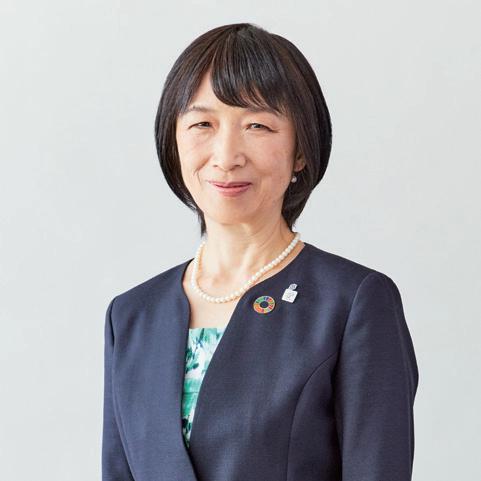
Yukiko Yoshimaru
Outside Director of the Board
Personnel Affairs and Remuneration Committee
Has held positions including Head of New York Office of Oki Electric Industry Co., Ltd., chief manager of Diversity Development Office of Nissan Motor Co., Ltd., and executive officer of Nifco Inc. She was appointed the Company in April 2018 as an outside director of the Board, and was appointed Chairperson of the Personnel Affairs and Remuneration Committee of the Company in May 2020.
I was appointed to be an outside director of the Board in 2018, which coincided with the first year of governance reforms launched by the Company to further deepen the high trust we receive from our stakeholders and thereby accelerate sustainable growth. Because of my strong commitment to corporate governance, in 2020 I was appointed to be the Chairperson of the Personnel Affairs and Remuneration Committee, which one could say is the core of all governance reforms. This committee serves as a consultative body to the Board of Directors, with outside directors of the Board making up the majority of its lean membership. Thus, we conduct dense discussions with fairness and objectivity, making reports not only to the Board of Directors but also fulfilling accountability to investors and shareholders, customers, employees, and all other stakeholders in order to guarantee transparency in the management of personnel affairs and remuneration of our officers.
To heighten the transparency of CEO evaluations and selection process, we hold an annual CEO Evaluation Meeting to assess our current CEO. This is attended by the three outside directors of the Board who serve as members of the Personnel Affairs and Remuneration Committee and the CEO, where we evaluate the latter’s performance during the target financial year along the lines of the key points of the CEO evaluation that we share publicly with stakeholders. Opinions regarding the CEO’s understanding of current issues, his self-evaluation, management vision and other items are also shared and subsequently reported to the Board along with next term’s appointment plan for directors. The key points of CEO evaluation are being reviewed annually to determine whether they need to be updated.
Qualification requirements
Embodies our Corporate Philosophy and possesses a broad perspective
Conceives solutions to problems confronting society
Innovates to create new markets
Whether they extensively promote specific measures based on our Corporate Philosophy to achieve our global vision
Whether they accurately understand social issues and clearly envision how to resolve them as they develop business models
Whether they properly delegate authority to foster a creative corporate culture that can respond to new markets
Competence requirements
Cooperates with various stakeholders
Develops organizations that enhance the Group’s comprehensive power
Whether they are constantly continuing to build and strengthen relationships with customers, employees, suppliers, investors and other stakeholders
Whether they, as the leader of the entire Group, are at the forefront of evolution and development of organizational systems, including those supporting global operations
Motivation and health
Stability of mid-term management
Whether they pay attention to their health, and are motivated to complete their duties as the head of management
To improve the efficiency of the management human resources pipeline as stipulated in the Sixth Mid-Term Management Plan, we conducted five rounds of discussions in FY2023 at the Personnel Affairs and Remuneration Committee. Through these discussions, we introduced the human resource requirements for the next CEO and the education framework for CEO successors to the Board of Directors and codified them. Their contents show the objectiveness and transparency of the selection process for the next CEO, as, in the words of the CEO himself in a statement made to all our employees, “I want as many leaders as possible to understand that educating human resources to inherit your responsibilities is the duty of a leader.” The Personnel Affairs and Remuneration Committee continuously holds discussions on the human resource requirements for the next CEO and what the ideal CEO for our current management environment would be, making revisions when necessary.
Additionally, as a part of the education framework for CEO successors, the Personnel Affairs and Remuneration Committee established the CEO Succession Plan Council, which is a separate council specializing in CEO succession that creates a list of CEO successor candidates and monitors educational conditions involving difficult assignments, personnel rotation and others.
Qualification requirements
• Capable of carrying out the Sekisui House Group’s social duties and, to this end, personifying our corporate philosophy
• Possesses unshakeable, firm integrity
Conceptualization
Understands new issues caused by social change, conceives of future plans to realize happiness through housing, and develops business models accordingly
Competence requirements
Innovativeness
Elicits diverse ideas in conversations, uses a flexible way of thinking to take appropriate opportunities to promote rapid innovation
Cooperation Accepts a variety of people, can create strong and trusting relationships with various stakeholders
Organizational development ability Fosters a highly autonomous global organizational culture, increases the value of the Sekisui House Group’s human resources
Mindset
• Has a strong determination to lead the entire Sekisui House Group based on their personal responsibility
• Is dedicated and continuously passionate towards realizing our global vision
The Company shall select prospective directors from among individuals with high integrity (individuals who are sincere, earnest and highly ethical), high management capabilities, a nature suited to practicing the Group’s corporate philosophy, interest in the Group’s business, deep insight, and a keen sense of contribution to creating corporate value and improving business performance.
The stance on the selection of prospective directors of the Board shall be discussed at the Personnel Affairs and Remuneration Committee, a consultative body to the Board of Directors chaired by an independent outside director of the Board and comprising a majority of independent outside directors of the Board, and determined by the Board of Directors based on the recommendations of the committee.
Proposals on specific prospective directors of the Board shall be discussed at the Personnel Affairs and Remuneration Committee and determined by the Board of Directors based on the recommendations of the committee.
The selection of prospective internal directors of the Board shall be performed with consideration for the specified qualification requirements (i.e., individuals embodying the corporate philosophy and possessing broad perspective) and competence requirements (i.e., having the ability to conceive solutions to external problems, innovativeness for creating new markets, the ability to cooperate with various stakeholders, and the ability to develop organizations that enhance the Group’s comprehensive power), and shall be discussed at the Personnel Affairs and Remuneration Committee based on requirements for human resources and a performance evaluation.
Division of Built-to-Order Business
Division of Development Business
Business Strategy Division
Division of Finance and ESG
Division of Administration and Human Resources
Division of Technology and Production
Affiliated Companies
1 Indicates female members
Personnel Affairs and Remuneration Committee supervises the selection and dismissal process.
Ensuring moderate separation of supervision and execution, supervise the divisions for which they are responsible to achieve the goals of the Mid-Term Management Plan while taking responsibility for those divisions’ execution of operations.
As director of the Board candidates, responsible for key areas of their divisions and for those areas’ execution of operations to achieve the goals of the Mid-Term Management Plan.
Yoshihiro Nakai (Representative Director of the Board)
Hiroshi Shinozaki (Senior Managing Officer)
Toru Ishii (Senior Managing Officer)
(As of May 1, 2024)
Human Resource Promotion Council (largely composed of internal directors) deliberates on selection and dismissal, personnel allocation and training.
As entrusted executive officer candidates, responsible for business units and for those business units’ execution of operations to achieve the Mid-Term Management Plan.
As employed executive officer candidates, responsible for business units and for those business units’ execution of operations to achieve the goals of the Mid-Term Management Plan.
Shinji Aoki (Managing Officer)
Yoshinori Kimura (Managing Officer)
Takahiro Kondo (Managing Officer)
Takehisa Yanagi (Managing Officer)
Toru Tsuji (Managing Officer)
Kohei Hirota (Managing Officer)
Hiroaki Yoshida (Managing Officer)
Norio Adachi (Managing Officer)
Yosuke Horiuchi
(Representative Director of the Board, Vice Chairman, Executive Officer)
Satoshi Tanaka (Representative Director of the Board, Executive Vice President, Executive Officer)
Haruhiko Toyoda (Senior Managing Officer)
Toru Fujita (Managing Officer)
Keizo Yoshimoto (Senior Managing Officer) Osamu Minagawa (Managing Officer)
Masaru Noma (Senior Managing Officer)
Kohei Joki (Managing Officer) Koya Matsumura (Managing Officer)
Yuji Yoshiyasu / Takumi Nukanobu / Yoshitaka Iwata / Ken Miyakoshi
Kenichi Kanazawa / Tetsuya Takabatake / Kaoru Sasaki / Yuichi Ihara / Yasuyuki Tsukada / Motohiro Kikkawa / Kazuhiro Imaru / Junji Takeuchi / Tomoaki Minobe / Hiroshi Asada / Motomichi Shozu / Hidekazu Haramoto
Hiroaki Takahama / Naoki Tamori Kenichi Kumemoto / Kazuhito Miyajima
Yoshiyuki Kamiya / Naoya Matsui / Yoichi Komatsu Yuta Nakano / Kayo Kitada / Tsuguya Yakura
Atsushi Yoshida / Masahiro Kikuchi / Toshiya Chikada / Miwa Yamada1
Hirokazu Kishimoto / Hiroyuki Kawabata / Yuki Isaka
Takahiro Kishi / Hideaki Yasunobu / Naoki Kawamura Hiroyuki Kitamura
Hidehiko Nakayama / Hideaki Kono / Kenji Okazawa
Yasuyo Sawabe / Naoko Yano / Masayoshi Ota / Atsushi Nakata / Masashi Kotani / Hideo Saito / Yoshiyuki Ueno
Yasushi Omura (Managing Officer) Kenji Konishi / Kazunori Ito Ichiro Otaka / Takanobu Haruki / Eiichi Matsushita
Name Male Female Number of years in office as director of the Board (at the close of the
Yoshihiro Nakai 8
Yosuke Horiuchi 8
Satoshi Tanaka 4
Toru Ishii 4
Hiroshi Shinozaki 1
Yukiko Yoshimaru1 6
Toshifumi Kitazawa 4
Yoshimi Nakajima 3
Keiko Takegawa 3
Shinichi Abe1 2
The Company has established the Office of Directors of the Board as an organization for assisting outside directors of the Board in their duties, and assigned several employees to it. The office enhances the provision of information to outside directors, including advance explanations of the agenda of Board of Directors meetings, business inspection tours and monthly issuance of the Sekisui House Report and other materials that provide an overview of Company and industry trends. The office’s other initiatives include creating opportunities for outside directors to communicate with the representative directors and Audit and Supervisory Board members. Outside officers have acknowledged that these initiatives contribute to lively discussions at Board of Directors meetings. The Company will enhance its efforts to further deploy the functions of its outside directors.
Overseas business International knowledge
Financial strategy and accounting
Technology and environment Innovation
Improvement of social value
Human resource development Diversity
Governance
Risk management Compliance
We are a leading company in the housing industry and have constructed a cumulative total of more than 2.6 million dwellings. In order to formulate sustainable growth strategies in a drastically changing business environment, we need directors with management experience and a proven track record in housing, construction and urban redevelopment. Additionally, to realize one of the tenets of our global vision—to promote proposals for happiness through the integration of technologies, lifestyle design and services—the Company needs directors of the Board with experience in different industries, especially management experience and a proven track record in the field of consumer services for health, connectedness and learning as well as knowledge and experience that contribute to the transformation of business models through the use of digital technology.
In order to formulate growth strategies and provide management supervision for our overseas business, which is a growth segment, we need directors of the Board with extensive knowledge of and experience in overseas business management, living, culture and business environments.
In order to formulate financial strategies that will not only ensure accurate financial reporting, but also build a strong financial foundation, promote growth investments including M&A to sustainably enhance corporate value, and strengthen shareholder returns, we need directors of the Board with solid knowledge and experience in finance and accounting.
In order to realize the supply of high-quality housing that combines safety, peace of mind and comfort with advanced technology, and to further advance and develop our advanced environmental technology and solid construction capabilities, the Company needs directors of the Board who have a track record of diverse innovation along with the knowledge and experience to enable proactive efforts to address global environmental issues from a corporate management perspective.
In order to provide homes that make our customers feel more content and address various social challenges through its business activities, the Company needs to develop human resource strategies that enable each employee to maximize their potential, and the Company needs directors of the Board with solid knowledge and experience in the field of human resources development, including the promotion of diversity, equity and inclusion.
Establishing an appropriate governance system is fundamental for sustainably enhancing corporate value. In order to improve the effectiveness of management supervision by the Board of Directors, we need directors of the Board with solid knowledge and experience in corporate governance, risk management and compliance.
We regularly provide training for directors of the Board and Audit and Supervisory Board members to deepen knowledge of compliance and other issues that are necessary or useful for management, inviting experts from various fields to give lectures. In addition, we schedule sufficient time to provide explanation to newly appointed outside directors of the Board and outside Audit and Supervisory Board members to ensure that they understand the Sekisui House Group’s businesses, management strategy, business strategy and financial status.
Selection of entrusted executive officers: Implementation of Senior Management Assessment (Senior Management Assessment)
• Newly appointed candidates undergo performance evaluation, multi-rater evaluation, as well as Senior Management Assessment conducted by an external organization.
• A variety of information from sources including extended interviews and multiple psychological tests is used to comprehensively evaluate current and future potential.
• The Personnel Affairs and Remuneration Committee deliberates on appointments based on the external organization’s report on assessment results.
• Assessment results are shared with candidates and used in formulating future training plans.
Selection of employed executive officers: Conducting Succession Plan Council Meetings and Human Resource Promotion Council Meetings (Succession Plan Council Meetings)
• We implemented meetings to visualize successors for employed executive officers and operating officers, and to share succession information among division officers (operating officers and higher) and general managers.
• We enhance the management candidate pipeline with discussions about sharing successor information and training plans.
Human Resource Promotion Council
• Entrusted executive officers (managing officer and higher) recommend candidates for employed executive officer and operating officer.
• Internal directors of the Board and officers participate in Human Resource Promotion Council meetings, where each director of the Board discusses the selection of candidates, upon which the President and Executive Officer determines the appointment plan and submits it to the Board of Directors for approval.
(1) To be fair to shareholders, investors, customers, employees and all other stakeholders in accordance with our philosophy of love of humanity, a high degree of governance shall be applied in deciding remuneration to ensure objectivity, transparency and full accountability.
(2) In order to become a leading company in ESG management, we shall focus on social significance and make a clear commitment to consistently executing innovative growth strategies, and our remuneration system shall provide sound incentives for consistently increasing corporate value over the long term.
(3) We shall emphasize the link between remuneration and the development and evaluation of the senior management team, motivate the next generation of managers to grow, and increase the organizational vitality of the Sekisui House Group over the long term.
To improve the objectivity and independent nature of the remuneration determination process, the Board of Directors, by its resolution, delegates the authority to determine the amount of remuneration for individual directors of the Board to the Personnel Affairs and Remuneration Committee.
The
and
and
The amount to be paid shall be calculated by multiplying consolidated ordinary profit, which is a key management indicator, by a predetermined bonus coefficient for the position of each director (including the CEO and excluding outside directors of the Board). The bonuses shall not be paid if profit attributable to owners of parent is less than ¥120 billion.
ROE (a key financial indicator for the medium term) and a non-financial ESG management indicator are used as performance indicators. The Reference Number of Share Units corresponding to predetermined standards for each director of the Board (including the CEO and excluding outside directors) position shall be granted. The number of units to be granted shall depend on the degree of achievement of ROE and ESG management indicators during the evaluation period spanning three consecutive fiscal years. At the end of the evaluation period, the number of units to be granted shall be determined within the range of 0% to 150%. Half of the units granted shall be issued as shares and half in cash for tax payment.
ROE and ESG management indicators shall have an 80:20 weighting in the evaluation, and ESG management indicators will be rigorously reviewed by the Personnel Affairs and Remuneration Committee to enhance the objectivity and transparency of the process of goal setting and evaluation.
Shares of Sekisui House, Ltd. common stock (with transfer restrictions) shall be granted corresponding to the predetermined basic amount set by position for each director (including the CEO and excluding outside directors). The transfer restrictions shall be lifted in the event that a director of the Board or executive officer stops serving in his or her position. 1
Officer Remuneration (Including the CEO and Excluding Outside Directors of the Board)
Using objective remuneration market survey data from an external specialist organization, we select a group of companies to serve as a benchmark for remuneration and set the amount of remuneration at an appropriate level commensurate with the size of operations and financial results of the Sekisui House Group. Overview of Remuneration Systems and Incentive Systems
Remuneration for directors of the Board (including the CEO and excluding outside directors of the Board) consists of basic remuneration (fixed amount) and incentive remuneration (variable amount). The latter consists of three components: Performance-related bonuses (linked with short term operating results).
Performance Share Units (PSU: linked with medium- term operating results) and restricted stock remuneration (linked with long-term operating results). The proportion of performance-related bonuses within overall remuneration has been reduced, while the proportion of share-based remuneration has been increased with the aim of providing sound incentives to pursue longterm, sustainable improvement of corporate value, in addition to single-year operating results targets. The specific ratio for each director of the Board is set in line with their position-based roles and responsibilities. Based on this policy,
the ratio of basic remuneration, performance-related bonuses and share-based remuneration for representative directors of the Board is set at about 1:1:1 (provided that the Company achieves base performance).
Remuneration, etc., to be paid to outside directors of the Board consists of basic remuneration (fixed amount) along with various allowances. The latter are determined based on job responsibilities borne by each recipient as Chairperson or other membership at the Board of Directors and the Personnel Affairs and Remuneration Committee in light of their supervisory roles over the Company’s management that require an objective and independent standpoint. The level of basic remuneration and various allowances is being set in reference to data acquired by external specialist organizations via objective market surveys of similar remuneration.
Remuneration, etc., to be paid to Audit and Supervisory Board members consists solely of basic remuneration (fixed amount) in light of their supervisory roles over the Company’s management that require an objective and independent standpoint. The level of basic remuneration is set based on job
responsibilities borne by each recipient in reference to data acquired by external specialist organizations via objective market surveys of similar remuneration.
The fundamental policy on the remuneration system for the Company’s Audit and Supervisory Board members, the content of the remuneration system and the amounts received by individual recipients are determined by the Audit and Supervisory Board within the maximum limit approved at the General Meeting of Shareholders.
For the Company to become a leader in ESG management, we believe that in addition to setting a portion of the PSUs that reflect appraisals by ESG management indicators, it is important to guarantee that director remuneration remains consistently aligned with shareholder value over the long term. To do this, we established shareholding guidelines, and directors of the Board who supervise business execution are, during their term in office as a part of Sekisui House, obliged to maintain ownership of Company shares equivalent to baseline monetary values (based on current share prices). In order to strengthen ownership of such shares among directors of the Board, after reaching the minimum baseline, we will require continuous ownership of Company shares over the monetary baseline.
The baseline monetary value is twice annual basic remuneration for representative directors of the Board and equal to annual basic remuneration for other eligible directors (excluding outside directors of the Board).
In order to control excessive risk-taking by directors of the Board who supervise business execution and to ensure sound management, we established malus and clawback provisions in the rules for officer remuneration. These provisions enable the Company to acquire shares or PSU allotted to such directors in the form of share-based remuneration free of charge, confiscate such remuneration or demand the return of it in full or in part (or the amount of money commensurate with share-based remuneration paid) if the recipient was found to be involved in such serious events as illicit conduct and legal violations, in the course of, or in connection with, the execution of his/her duties or other actions.
The invocation of these provisions requires a resolution of the Board of Directors following deliberations by the Personnel Affairs and Remuneration Committee.
Officer remuneration for FY2023
Total Remuneration for Parent Company Officers by Category, Type of Remuneration, and Number of Eligible Officers
Officer Category Total Remuneration, etc. (Millions of yen)
of the Board (Excluding Outside
Remuneration by Type (Millions of yen) Number of Eligible Officers
Note: The above-listed amount of basic remuneration, performance share units and restricted stock remuneration includes remuneration paid to three directors of the Board who stepped aside from their office as of the close of the 70th Ordinary General Meeting of Shareholders held on April 27, 2021, one director of the Board who stepped aside from his office as of the close of the 71st Ordinary General Meeting of Shareholders held on April 26, 2022, and one director of the Board who stepped aside from his office as of the close of the 72nd Ordinary General Meeting of Shareholders held on April 25, 2023.
Target Value and Results Basis for Performance-Related Stock Remuneration (PSU2) Paid for FY2021 through FY2023
Note: The ESG management indicator used in the determination of the amount of PSU consists of targets determined for the following items; E (Environment): (1) Ratio of detached house ZEH; (2) Number of Sha Maison ZEH units; S (Social): (3) Number of female managers; (4) Take-up rate for eligible male employee childcare leave; (5) Monthly average working hours; G (Governance): (6)Enhancing response to the Corporate Governance Code; (7)Clarifying authority and responsibilities of the parent company and subsidiaries and strengthening the development
Total Consolidated Remuneration for
The Company has designated administrative departments responsible for the segment-based management and supervision of business activities undertaken by Group companies. In addition, specialized departments at the head office of Sekisui House provide functional assistance and management leadership for particularly specialized operations. In these ways, the Company develops and operates a two-tier administrative system.
Administrative departments require reporting from each subsidiary regarding the status of business execution on a periodic or ad-hoc basis while acting in collaboration with the Company’s head office departments in such endeavors as the development of operational standards. Furthermore, the head office
departments provide subsidiaries with guidance and supervision over their operations in line with missions assigned to each. For some subsidiaries, the Company dispatches personnel to serve as directors of their boards or members of their Audit and Supervisory Boards to exercise supervision over or conduct audits of business execution.
Sekisui House Construction Holdings Co., Ltd., a holding company for Sekisui House Construction companies, initiated operations in February 2024. In addition to delegating authority from the head office of Sekisui House to this intermediate holding company, we have created specialized departments within the latter and allocated human resources to promote the strengthening of corporate governance.
Main objectives of the intermediate holding company system:
1. Promote planned expansion of business range of the Sekisui House Construction Group
2. Leverage locally-rooted customer bases possessed by each Sekisui House Construction Group company while ensuring safe and high-quality construction work
3. Enact flexible revisions to personnel systems
4. Expand our built-to-order business through the realization of growth strategies and improved governance
Promoting networking for governance
Currently, we are promoting the optimal allocation of human resources charged with corporate governance based on the close assessment of their status at main business subsidiaries (all Sekisui House Real Estate Group companies, all Sekisui House Construction Group companies, Sekisui House Remodeling, Sekisui House noie and Konoike Construction) as well as issues they are now confronting. Also, we periodically hold global governance meetings and area governance meetings to provide a place for discussions among Sekisui House Group members, including those overseas, to strengthen corporate governance.
Risk maps are being developed at main business subsidiaries (all Sekisui House Real Estate Group companies, all Sekisui House Construction Group companies, Sekisui House Remodeling, Sekisui House noie and Konoike Construction), with the Risk Management Committee receiving reporting based on these risk maps from each company and engaging in periodic discussion regarding risk recognition.
Basic stance on cross-shareholdings
1. The Company shall not enter into cross-shareholdings with business partners unless it judges that it will be helpful to medium- and long-term increases in the corporate value through the stable maintenance and strengthening of relationships with them. In addition, the Company shall comprehensively verify the economic rationality of transactions with parties that own cross-shareholdings to determine if it will continue these transactions.
2. The Company shall analyze the appropriateness of cross-shareholdings at a meeting of the Board of Directors based on the minimum holdings required from a perspective of increasing capital and asset efficiency each year. At the meeting of the Board of Directors, members shall comprehensively analyze the medium- and long-term economic rationality of each individual stock based on holding objectives and risk and return. As a result, the Company shall sell any stock which is no longer meaningful to continue holding after considering the market environment. Even for stocks considered appropriate to hold, the Company may sell all or some shares after considering its capital policies and the market environment.
3. An overview of the analysis at the meeting of the Board of Directors regarding cross-shareholding shall be disclosed as appropriate in the reports related to corporate governance.
4. When companies holding the Company stock as cross-shareholdings express an intention to sell such shares, the Company shall not prevent the sale in any way by, for example, insinuating a reduction in their business relationship.
5. Criteria for exercising voting rights
The Company exercises its voting rights after comprehensive determinations for or against each agenda item based on reasonable criteria. In doing this, we consider both the management policies of the companies in which we have cross-shareholdings as well as how best to increase medium-and longterm corporate value of these companies and Sekisui House.
For proposals deemed to require careful consideration after a thorough review of their contents (acquisition defense strategies, corporate reorganization plans, etc.), we conduct discussions with relevant departments as well as dialogues with the issuing company to determine whether to accept or reject said proposals. Additionally, we reject proposals that we believe will damage shareholder value.
At the meeting of the Board of Directors held in October 2023, the Company analyzed all listed stocks it holds as cross-shareholding (for 16 different companies, excluding Sekisui House Reit, Inc. and companies to which the equity method of accounting is applied) in terms of overall significance of owning them based on the status of shareholding, risk and return (stock price divergence, dividend yields, ROE, credit rating, etc.) and importance of transactions. Furthermore, from the perspective of increasing capital efficiency, the Company has adopted a policy to reduce cross-shareholdings in phases. Based on this policy, the Company has set a target of reducing the ratio of cross-shareholdings to consolidated net assets to 3% or less during the period of the Sixth Mid-Term Management Plan (by January 31, 2026).
1
Stocks sold during FY2023: Of the 16 companies examined, the Company sold all shares of two companies and a portion of shares of five companies.
Ratio of cross-shareholdings to consolidated net assets for FY2023: The ratio on January 31, 2024 was 4.3%.
With the aim of maintaining compliance across the Group, administrative departments are in place and tasked with the consolidated management of each business division. Moreover, specialized departments responsible for various regulatory areas act in collaboration with administrative departments in their respective field of specialty in order to promote cross-sectional compliance management encompassing the entire Group. The status of compliance management is reported to and verified by the Risk Management Committee, which is established as a consultative body to the Board of Directors, as part of efforts toward ongoing improvement.
The Sekisui House Group established Sekisui House Group Corporate Ethics Guidelines, which provide specific guidance regarding compliance with laws, regulations, the Articles of Incorporation and other corporate ethics principles. We strive to ensure that these guidelines are upheld and practiced by all officers and employees across the Group.
Sekisui House Group Corporate Ethics Guidelines
We implement Compliance Training targeting all Group employees in order to foster a robust compliance awareness among the entire workforce of the Group.
The Sekisui House Group maintains an internal reporting system (the Sekisui House Group Compliance Helpline), which accepts reports and requests for consultation from its officers and employees, as well as those at partner building constructors in ongoing transactional relationships with the Group. This system is equipped with in-house contact desks (operated by the Human Rights and Compliance Promotion Office in the Legal Department) along with external contacts operated by a law office. In addition, the Sekisui House Global Helpline is also in place, operating through the same entities as above and serving as the contact point for officers and employees at overseas Group companies. The Company’s Board of Directors is periodically briefed on the status of its internal reporting system to exercise appropriate supervision over it.
The Company has established the Auditing Department as an organization tasked with conducting internal audits, including of Group companies, to help optimize their operations. Employees equipped with robust knowledge and skills are assigned to this department as dedicated staff charged with internal auditing. In this way, we strive to develop a global auditing structure encompassing Group companies domestically and overseas.
Sekisui House’s Auditing Department consists of 55 employees (as of January 31, 2024; including 10 employees at the International Auditing Office) and is engaged in audits of the Company itself as well as domestic Group companies without internal auditing departments and overseas Group companies.
Internal auditing departments are also in place at Sekisui House Real Estate
Holdings, Ltd., Sekisui House Remodeling, Ltd. and Konoike Construction Co., Ltd. These departments conduct internal audits even as they share the status of audits with and otherwise act in collaboration with the Auditing Department of Sekisui House, Ltd.
In addition, Sekisui House, Ltd. is dispatching staff from the Auditing Department to the United States in line with its aim of “Enhancing our internal auditing structure for global auditing,” as part of ESG strategies under the Sixth Mid-Term Management Plan.
As of January 31, 2024, a total of 114 employees are assigned to internal auditing departments at the Group.
The Company’s Auditing Department conducts internal audits, once every two years in principle, in accordance with Internal Audit Guidelines and annual audit plans, targeting the Company’s sales offices and other bases as well as domestic Group companies. Moreover, the department audits overseas Group companies every year in principle.
In October 2003, the Group formulated the Sekisui House Corporate Ethics Guidelines and put them into effect as the standards to be followed by the Company, its officers and employees. The content of these guidelines is revised as necessary in line with changes in the business environment. We distribute pamphlets containing the Corporate Philosophy and Corporate Ethics Guidelines to all Group employees as part of thoroughgoing efforts to spread awareness, and we have executives and employees submit a Pledge of Compliance with the Corporate Ethics Guidelines every year. From the viewpoint of anti-corruption, we have also stipulated a provision regarding entertainment and gifts in these guidelines with respect to customers, suppliers, public officials and other individuals. Based on that provision, we have established Anti-Corruption Guidelines and are disseminating information on them within the Company.
Sekisui House Group Corporate Ethics Guidelines
Until FY2021, we provided all Group employees with annual legal training addressing laws, regulations, legal risks and other subjects determined as part of ongoing efforts to foster compliance awareness. In FY2022, we changed the name of this training to Compliance Training, and began implementing programs centered on small-group discussions aimed at addressing case studies of compliance violations, including the violation of corporate ethics. Through this training, we provide employees with opportunities to spontaneously think about compliance and develop robust awareness regarding relevant issues. In this way, we are fostering broader compliance awareness that extends beyond laws and regulations.
In order to promote compliance at business bases, we also provide their senior managers with risk management training to develop their compliance awareness as leaders. In FY2023, this training was focused on such subjects as the strengthening of worksite information security and the prevention of alcohol-related incidents, and consisted mainly of discussions among participants to enable them to educate one another on these topics. Even after training, participants are engaged in ongoing discussions with their peers while operating in their respective worksites in order to ensure that each remains immensely conscious of their leading role in terms of promoting compliance throughout the entirety of the worksites under their supervision. In FY2023, we expanded the scope of this training to include senior managers at Group companies to strengthen our overall Group-wide structure for promoting compliance.
Every year, we conduct the Governance Awareness Survey targeting all Group employees. These anonymous surveys are conducted by distributing questionnaires regarding employee awareness of corporate ethics, the Corporate Code of Conduct, conditions of workplace environments, compliance and other matters that we aim to periodically verify. As part of these efforts, the Board of Directors evaluates survey results by focusing on better ingraining our Corporate Philosophy, the Corporate Code of Conduct and other principles. Meanwhile, each business unit assesses the current status of our workplaces based on survey results while creating opportunities for the exchange of
opinions among them. In these ways, we foster a workplace culture supportive of unfettered communications.
Promoting active use of internal reporting systems and consultation services
In accordance with the Whistleblower Protection Act, we have in place an internal reporting system through which the Human Rights and Compliance Promotion Office in the Legal Department accepts requests for consultation or reports regarding any conduct that violates or may violate laws or corporate ethics. This system is dubbed the Sekisui House Group Compliance Helpline and is available to all Group employees. We have also commissioned a law office to serve as an external point of contact for the same purpose. Moreover, the Human Rights and Compliance Promotion Office operates the Sexual and Power Harassment Hotline to accept requests for consultation regarding human rights-related issues, including various forms of harassment. Similarly, this hotline is available to all Group employees.
In addition, the Sekisui House Group Compliance Helpline accepts requests for consultation from officers and employees at partner building constructors and suppliers in ongoing transactional relationships with the Group. This helpline handles reporting on cases that violate or possibly violate laws or corporate ethics in connection with transactional relationships with the Group.
Furthermore, the Sekisui House Global Helpline was established in June 2020 for employees at overseas subsidiaries operating in English-speaking regions, with the Human Rights and Compliance Promotion Office in the Legal Department and an external law office serving as the contact point. (For employees at our subsidiaries in China, we established a separate contact point capable of accommodating inquiries in Chinese.)
Prior to the June 2022 enforcement of the revised Whistleblower Protection Act, we established internal regulations regarding the whistleblowing system in May 2022 to secure compliance with said act. Since then, we have operated this system in accordance with these rules, which we will update in June 2024. These rules stipulate that the system must accept anonymous requests for consultation or reporting while mandating the protection of whistleblowers by, for example, prohibiting detrimental treatment on the grounds of whistleblowing, banning any attempts to specify their identities and outlining secrecy obligations to be borne by those handling the system.
Although it is desirable that any issue that arises is first addressed by the workplace involved, we also believe that ensuring that our whistleblowing system is known by all employees and available to them without any barriers is essential. Accordingly, we continuously strive to spread awareness of this system through annual Compliance Training and other various training in which all employees participate.
1
system handles a
range of issues, including bribery.
This includes all cases that violate or could potentially violate laws, regulations, or corporate ethics for businesses and business activities for Group officers and employees, as well as business partners that the Group has an ongoing relationship with.
Consultation pertaining to sexual harassment, power harassment and other forms of harassment and human rights issues, including those associated with pregnancy, childbirth, childcare leave and nursing care leave, with the hotline available to Group officers and employees, as well as business partners that the Group has an ongoing relationship with.
Cases involving officers and employees at overseas subsidiaries, including those pertaining to sexual harassment, bullying or human rights violations as well as actual or alleged violations of
and
and corporate ethics in relation to their businesses and business activities.
The Sekisui House Group is committed to complying with tax laws and upholding fairness in its tax affairs in every country in which it operates. We disclose matters related to transparency in tax affairs in the following article. Tax transparency
The breakdown of taxes paid by the Sekisui House Group (FY2023) by country is as follows.
In the domestic contracting business, measures to prevent compliance violations include a legal and regulatory check system to verify mistakes and omissions of procedures for design, according to the Building Standard Law, and we have structured a double check system for business bases and the head office to prevent the occurrence of mistakes for type approval. In addition, to ensure the effective assignment of full-time supervising technicians under the Construction Business Act, specialized departments are checking their assignment status and are continuing to secure qualified personnel and improve their skills. Also, each specialized department is engaged in information gathering and analysis to stay up-to-date with latest trends in legal regulations both domestic and overseas and, if necessary, relays its insight to relevant departments within the Group in order to support appropriate responses to such trends.
Marketing and advertising policy
The Group obtains permits and licenses based on laws and regulations, such as the Real Estate Brokerage Act, the Construction Business Act, the Act on Architects and Building Engineers, and the Housing Quality Assurance Act. At the same time, we conduct business activities based on administrative regulations, as well as laws and other regulations related to construction, labor, the environment and other matters involved in executing business. Our overseas operations are similarly subject to laws and regulations enforced in each country. Violation of laws and regulations related to construction in particular could incur significant expenses for remediation or administrative sanctions, such as suspension of business that could affect the Group’s business performance.
As stipulated in the Sekisui House Group Corporate Code of Conduct, we provide appropriate and accurate information on products and services to consumers and customers. We comply with the laws and regulations associated with our operations, including Japan’s Construction Business Act and the Real Estate Brokerage Act, while striving to ensure the appropriateness of sales and advertising activities. To that end, we develop in-house rules, manuals and other documents in addition to providing training to employees involved in real estate advertisement. Moreover, internal auditing departments conduct periodic audits of these activities, while the head office departments in charge of supervising sales offices carry out periodic inspections of their operations. In addition, we develop and maintain a structure for regularly checking the content of our corporate websites.
Relationship of trust with consumers and customers
5. Provide consumers and customers with appropriate and accurate information regarding our products and services, engage in sincere communications with them, and secure their satisfaction and trust.
We conduct periodic audits to confirm whether our internal control and internal management systems are operating appropriately and effectively to maintain compliance with relevant laws and regulations, such as the Construction Business Act and the Real Estate Brokerage Act, and in-house rules. Specifically, domestic sales offices and Group companies are audited every other year by internal auditing departments while overseas Group companies are audited each year. These audits are aimed at monitoring and assessing the content of customer contracts and the status of advertising activities. When necessary, the internal auditing departments issue recommendations for improvement.
In addition, internal auditing departments carry out monthly compliance inspections targeting important matters related to laws and regulations as well as financial statements based on data gleaned from in-house systems.
Audit results are reported in the form of audit reports to update directors of the Board, Audit and Supervisory Board members and relevant departments in a timely manner. Moreover, the Board of Directors and the Audit and Supervisory Board receive reports on audit results on a semi-annual and annual basis, respectively.
Matters considered to bear particular importance or require urgent response are swiftly relayed to relevant departments to support the early formulation of improvement measures and the cross-divisional sharing of knowledge of these matters in order to prevent recurrence.
In addition, based on internal auditing standards, each sales office independently conducts periodic inspections of its operations (on a semi-annual basis or more frequently), while the head office departments in charge of supervising sales offices carry out similar inspections on an annual basis.
To follow the amendments to the Personal Information Protection Law enacted on April 1, 2022, we have revised the Rules for Handling Personal Information. We have also designated the executive officer in charge of legal affairs as the person in charge of handling personal information, and are working to manage personal information with effective systems. Our Privacy Policy and Information Security Policy are disclosed on our website.
We handle customers’ personal information at Sekisui House Group worksites, such as housing exhibitions and land sales offices. In accordance with the Personal Information Protection Law and the Rules for Handling Personal Information, we have implemented ongoing e-learning and educational training for employees. We are striving to instill robust knowledge of personal information protection among employees by, for example, educating them about in-house guidelines regarding compliance with the Personal Information Protection Law. In addition, we have set up a specialized Customer Information Service Office within the CS Promoting Department, and have established a system that supports compliance with the Personal Information Protection Law for the entire Group.
Among various options, customers may request disclosure, correction, suspension of use or deletion of their own personal data by lodging a Contact for Inquiries About Customer Information application with the Customer Information Service Office. In the event of the loss or theft of customers’ personal information, in addition to informing customers about the issue immediately, we shall post necessary notices on our website concerning what information was lost or stolen, as well as notices regarding our subsequent handling of the situation. At the same time, we shall make every attempt to recover this information. Additionally, in view of the fact that personal information protection laws are being put in place in various countries around the world, we are making efforts to protect personal information in our international businesses as well, by developing systems, providing training and other means in accordance with the businesses we operate in each country to comply with local laws and regulations.
Sekisui House strives to maintain a sound and healthy corporate presence. To this end, we believe that we must eliminate any inappropriate relationships with government officials or politicians and promote appropriate business activities. To ensure fair business practices, improper relationships with government officials and politicians are expressly forbidden in the Sekisui House Group Corporate Code of Conduct and Sekisui House Group Corporate Ethics Guidelines.
Furthermore, we have established the Policy on the Prevention of Bribery and Other Corrupt Conduct as well as other internal anti-corruption guidelines. These guidelines concretely define conduct that is generally prohibited in order to prevent improper relationships or transactions involving government officials and our officers (directors of the Board, Audit & Supervisory Board members, executive officers and operations officers) or employees (including contract employees and part-time employees).
A single improper action can become a major problem; in light of this danger, when in doubt, we recommend that employees consult with their supervisors, managers responsible for general affairs, or the Head Office Legal Department before taking action and always maintain appropriate records.
Prior to conducting periodic (once every two years) audits targeting domestic operations, internal auditing departments confirm the results of Governance Awareness Surveys undertaken at targeted business units to inform their auditing activities.
In the course of periodic (annual) audits targeting overseas Group companies, these departments focus on auditing activities like those listed below in order to monitor and assess the status of compliance with corporate ethics and the prevention of corruption.
• Confirming the availability of local language-versions of the Corporate Philosophy, Sekisui House Group Corporate Code of Conduct and Sekisui House Group Corporate Ethics Guidelines as well as methods being used to ensure that these principles are understood by employees
• Confirming important legal risks each company is now confronting (e.g., those associated with bribery, human resource and labor management, environmental protection) and the development status of in-house rules and manuals in accordance with applicable laws and regulations
• Confirming methods being used to educate employees about the prevention of corruption and the content of periodic reports being prepared to this end
Fair business practices
2. We will engage in fair and free competition, appropriate transactions, and sustainable and responsible procurement. We will maintain sound relationships with political and governmental entities.
House Group Corporate Ethics Guidelines (excerpts)
2−4 Restrictions on Donations and Political Contributions
(1) Upon donating to various organizations, etc., recognize the roles of companies in society, proactively judge the need for donations, comply with related laws and regulations, and follow proper methods.
(2) Upon making political donations, comply with related laws and regulations including the Public Offices Election Act and the Political Funds Control Act, carefully avoid any and all action that can be misunderstood as colluding with politicians or public officials by bribery and payoffs, and strive to create healthy and transparent relationship with all parties.
(3) Receive prior authorization according to internal rules upon making various donations and contributions.
(1) Do not entertain nor present gifts to public officials or any equivalent individuals.
(2) Upon entertaining or presenting gifts to business partners, operate within the range of generally and socially acceptable common sense.
(3) In principle, do not accept entertainment nor gifts from customers or business partners.
and Corruption Policy (excerpts)
3. Adherence to Laws and Regulations
The Group will strictly comply with all laws, regulations, and guidelines of government agencies regarding the matters set forth in the Policy. In the case that some countries have stricter regulations than the Policy, or content not defined in the Policy, we will comply with the regulations of the relevant countries in addition to the Policy.
4. Prohibition of Bribery, Etc.
The Group prohibits bribery and facilitation payments in any form to public officials or their equivalents (collectively, “Public Officials, etc.”), whether in or outside of Japan.
7. Political Contributions
The Group will make political contributions only after obtaining prior approval in accordance with the prescribed internal procedures and in compliance with applicable laws and regulations.
and Corruption Policy
4.
In FY2023, there were no serious violations of laws, regulations or voluntary norms related to bribery or corruption within the Group.
Legal compliance status
Penalties for non-compliance with the anti-corruption policy
In FY2023, no disciplinary action or dismissal took place against any employee for non-compliance with the anti-corruption policy. To the best of our knowledge, no cost was incurred on payments for penalties, surcharges or settlements related to corruption.
Infractions and penalties related to the environment
There were no major infractions or penalties of environmental laws or regulations in FY2023. There were no accidental spills or other incidents impacting the environment surrounding our factories. Although we are aware of the need of allowances to secure our preparedness for a major environmental accident or other incident arising from our operations, we recorded no allowances for ESG-related issues, including environmental issues, in said fiscal year.
Infractions and penalties related to products and services, health and safety
In FY2023, there were no legal or regulatory infractions or penalties paid as a result of violations of laws or regulations related to the provision and use of our products and services. There were also no infractions of health and safety related regulations or voluntary standards. If an important incident related to our products or services is revealed, we will conduct investigations, confirm its occurrence and then swiftly disclose the factual details, as well as our policies in response.
Infractions and penalties related to customer privacy
In FY2023, there were no substantiated petitions for redress related to customer privacy infringements or customer data loss.
Legal action related to monopolistic practices
In FY2023, the Group faced no legal action, substantial fines or punitive measures in connection with anticompetition, antitrust or monopolistic practices, or violations of relevant laws and regulations.
The Group strives to keep itself accurately updated regarding important risks that may arise in the course of its business activities while developing a structure to ensure that, if such risks materialize, appropriate measures are taken in order to mitigate their impact on the Group’s businesses.
For example, strategic risks as well as financial and market risks are discussed by the Board of Directors and at Management Meetings, as well as by other bodies tasked with deliberating management policies, management strategies and important business execution.
With regard to operational risks and hazard risks, the Risk Management Committee (chaired by an Executive Vice President who is also Representative Director of the Board) is in place, acting as a consultative body to the Board of Directors to monitor the status of risk management.
The Risk Management Committee mainly consists of members appointed via a
resolution by the Board of Directors and meets once a month, in principle. To address material risk items it has identified, the Risk Management Committee monitors risk management status at organizations responsible for such risk items, including specialized departments at the head office and various meeting bodies. Through these endeavors, the committee summarizes and verifies the development status of the Company’s risk management structure, with reference to findings from the monitoring mentioned above, while giving necessary advice. Also, the committee reports on its deliberations to the Board of Directors semi-annually. Members of the committee include representatives from the Internal Audit Division to coordinate its activities with the content of periodic audits.
Moreover, in line with our recognition of the importance of quality control and information security, we established the Quality Management Committee and the Information Security Committee within the Risk Management Committee. These committees take a professional, intra-divisional approach to reviewing risks as well as countermeasures, and report their response policies and deliberations to the Risk Management Committee three times each year.
Strategic risks and financial and market risks identified by departments responsible for such risks at Sekisui House Group companies are deliberated on by the Board of Directors and at Management Meetings, as well as by other bodies in conjunction with agenda items related to the Company’s overall business strategies, including its Mid-Term Management Plan, as well as discussions regarding individual projects. These bodies conduct risk evaluation and formulate countermeasures while exercising monitoring aimed at detecting an incident that could materially impact the Company’s business operations.
The Risk Management Committee identifies risk issues, especially those associated with operational risks and hazard risks, by drawing on findings from monitoring conducted in the preceding fiscal year over Group business bases in Japan and domestic and overseas subsidiaries as well as from interviews with each head office department. The Risk Management Committee then evaluates these risk issues to determine the probability of their occurrence and degree of their impact on the Group and selects material risks based on these evaluations. The departments and meeting bodies responsible for each important risk theme formulate a basic risk management plan at the beginning of each fiscal year, report on progress to the Risk
Management Committee, and make improvements based on the opinions and advice offered by the committee, in this way using a PDCA cycle for risk management.
With regard to risk management for Group companies, we have clarified administrative departments charged with overall business management for each Group member as well as specialized departments charged with taking a cross-sectional approach to risk management in each field of specialty. Under this structure, we promote matrix-based risk management. To obtain risk information from sources across the Group, we also strive to develop a governance network that will, in turn, help strengthen check-and balance functions provided by individuals responsible for general affairs at each domestic and overseas Group company and invigorate information sharing involving specialized departments at the head office. As for key business subsidiaries, we require them to acquire the approval of the Company or a resolution of the Board of Directors when they make decisions on the execution of businesses that involve a certain degree of importance. Furthermore, these key Group companies prepare risk maps similar to those prepared by the Company, with the aim of evaluating important risks. In order to understand risk recognition at these companies, the content of their risk maps is shared by and discussed at the Risk Management Committee.
If an incident that could impact overall operations of the Company occurs, the head office administrative department reports to the Risk Management Committee in accordance with the Crisis Response Manual. As soon as such reports are delivered, the Risk Management Committee determines the crisis level of said incident based on standards set forth in the manual. When the incident is considered to entail a degree of seriousness that exceeds the crisis level threshold defined by the manual, the Crisis Countermeasure Headquarters will, upon judgment by the chairperson of the Risk Management Committee, be launched. The headquarters will act as a dedicated team responsible for preventing any additional fallout from the incident and developing a structure aimed at formulating specific countermeasures in order to ensure early resolution. In addition, crisis response drills are periodically conducted to verify the manual and improve its content.
risks/Financial and market risks
Risk scenario
The Sekisui House Group is engaged in business activities centered on the provision of housing at home and abroad. Accordingly, the Group’s business performance is highly susceptible to changes in personal consumption, interest rates, land prices, housing-related government policies and tax systems as well as rent prices that may fluctuate due to the aforementioned factors, along with regional economic trends. Going forward, if the business environment evolves upon these changes, the Group’s operating results could be materially affected.
Countermeasures
To counter the risks described above, the Group pursues the flexible implementation of various measures aimed at adapting to changes in the market environment. To that end, meeting bodies led by heads of business and administration headquarters help ensure that all relevant individuals are on the same page about the status of progress in measures undertaken to counter market trends as well as issues identified in the course of frontline operations, while formulating fresh measures aligned with the evolving situation based on conclusions from their discussions. In addition, measures considered to bear particular importance are also discussed robustly at the
Management Meetings.
We also maintain ongoing informational coordination between each overseas business base and the Company’s head office to update the latter about the market environment in countries in which we pursue business expansion. Based on input afforded by this coordination, specialized departments engage in market analysis and strategic planning.
Risk scenario
Based on its strategies for domestic and overseas operations, the Group is expanding the scale of its business by, for example, acquiring corporations and businesses and reorganizing its corporate structure. However, if these measures fail to yield expected outcomes in the course of or following the execution of organizational integration procedures, or if profit arising from these measures falls short of the estimate due to unpredictable changes in the business environment, the Group’s operating results and financial position could be materially affected.
Countermeasures
When considering acquisition, reorganization and other similar measures, specialized departments conduct preliminary due diligence and stock price evaluation in collaboration with external experts in order to appropriately assess such matters as the corporate value of the potential acquiree and the feasibility of its business plans. To inform judgment on an acquisition, the potential deal is then discussed at Management Meetings and by the Board of Directors, as well as by other meeting bodies. Then, after an acquisition is completed, each specialized department promotes post-merger-integration (PMI) to ensure that the acquired business is smoothly integrated into the Group while maximizing synergies. After the objective of the PMI is fulfilled, administrative departments take the lead in pursuing synergies as part of efforts to realize sustainable improvement in corporate value for the entire Group.
Risk scenario
The Sekisui House Group holds real estate for sale, non-current assets, investment securities and other business assets in Japan and overseas. The Group may record impairment losses or valuation losses in connection with these assets due to plunges in their market value or other reasons. Fluctuations in foreign exchange rates could
also affect the value of these assets. The Group’s operating results and financial position could therefore be impacted by changes in asset value.
Countermeasures
To counter the risks described above, the Group has made it a rule to ensure that any investment project with monetary value exceeding a certain threshold must undergo preliminary screening by Sekisui House’s head office. Moreover, each such project is sufficiently discussed at Management Meetings before being authorized. In these ways, we take a prudent approach to making investment decisions. With regard to real estate, we endeavor to stably manage it by acquiring excellent properties and enhancing the asset turnover ratio. As for cross-shareholdings, we maintain a basic policy of restricting the volume of such shareholdings to a bare minimum level from the perspective of improving capital and asset efficiency. The appropriateness of such shareholdings is annually verified by the Board of Directors. At the same time, we strive for the phased reduction of cross-shareholdings under quantitative targets. To mitigate the impact of foreign exchange fluctuations, we utilize forward exchange contracts and other hedging procedures as necessary. In addition, we conduct periodic assessments of the risk of impairment or valuation losses associated with our asset holdings and ensure that the occurrence of such losses is properly accounted for as necessary.
The Sekisui House Group procures funds through borrowings from financial institutions, the issuance of bonds and other measures. Fundraising costs may possibly increase upon the occurrence of such events as major fluctuations in market interest rates, turmoil in financial markets or the radical downgrading of the Company’s ratings by rating agencies. This could, in turn, impact the Group’s operating results and financial position.
Countermeasures
To address these risks, we focus on practicing financial discipline and maintaining our ratings at an appropriate level, with the aim of reducing fundraising costs. We also endeavor to mitigate interest rate fluctuation risks via the diversification of fundraising vehicles and the dispersion of their maturities.
Retirement benefit obligations
Risk scenario
Retirement benefit obligations and expenses associated with Sekisui House Group employees are calculated based on such actuarial assumptions as the discount rate and expected return on pension assets. If these assumptions are revised, or if actual conditions differ widely from such assumptions, the Group’s operating results and financial position could be materially affected.
Countermeasures
The Group periodically verifies and reviews its estimates on retirement benefit obligations based on the past track record. Taking heed of advice from external consultants, the Group engages in pension asset management via dispersed investment encompassing multiple asset classes with differing risk-return characteristics and employing diverse asset management styles. Moreover, the effectiveness of this dispersed investment is evaluated via the periodic risk-return analysis targeting the Group’s pension assets as a whole. Having announced the adoption of the Stewardship Code in the area of corporate pension fund management, the Group is stepping up its monitoring of asset managers. In addition, the Asset Management Committee, which serves as a consultative body specialized in this area, holds periodic discussions regarding the market environment, asset management status and other topics.
Operational risks, hazard risks
Laws and regulations
Risk scenario
In Japan, the Group obtains permits and licenses based on such laws and regulations as the Real Estate Brokerage Act, the Construction Business Act, the Act on Architects and Building Engineers, and the Housing Quality Assurance Act. At the same time, we conduct business activities based on administrative regulations, as well as laws and other regulations related to construction, labor, the environment and other matters involved in executing business. Our overseas operations are similarly subject to laws and regulations enforced in each country. Violation of laws and regulations related to construction in particular could incur significant expenses for remediation or administrative sanctions, such as suspension of business that could affect the Group’s business performance.
In the domestic contracting business, measures to prevent compliance violations include a legal and regulatory check system to verify mistakes and omissions of procedures for design, according to the Building Standard Law, and we have structured a double check system for business bases and the head office to prevent the occurrence of mistakes for type approval. In addition, to ensure the effective assignment of full-time supervising technicians under the Construction Business Act, specialized departments are checking their assignment status and are continuing to secure qualified personnel and improve their skills. Also, each specialized department is engaged in information gathering and analysis to stay up-to-date with the latest trends in legal regulations at home and abroad and, if necessary, relays its insight to relevant departments within the Group in order to support appropriate response to such trends.
Risk scenario
The Group takes all possible measures to ensure the quality of design, production and construction. It also implements a long-term warranty system and regular inspection service for our detached houses and multi-unit buildings, which are our core products. If serious quality problems occur due to unexpected human errors or other factors during our long support period, considerable costs could be incurred or the reputation of the Group could be severely degraded, which may affect the business performance of the Group.
Countermeasure
The Quality Management Committee within the Risk Management Committee promotes unified quality management as an organization that brings together five study groups for products, design, production, construction, and customer satisfaction. In particular, the Quality Management Committee helps prevent construction quality defects through improvements to the quality control priorities that are based on the annual construction quality management plan formulated at the beginning of each fiscal year. This committee also deliberates the verification of product safety, inspection of production sites, compliance with quality-related legal regulations and the enhancement of customer services while delivering periodic reports on the status of its discussions to the Risk Management Committee.
Risk scenario
Infection by computer viruses and advanced cyberattacks could allow personal information and confidential information to leak or be tampered with, or cause system shutdowns. This could possibly result in the filing of claims for damage from customers or other stakeholders, the loss of market confidence in the Company or other negative consequences that would, in turn, affect the Group’s business performance. Countermeasures
To counter the risks described above, the Information Security Committee within the Risk Management Committee discusses and implements information security and information management measures based on the Group’s fundamental Information Security Policy, as well as internal regulations regarding the management of confidential information. Simultaneously, we strengthen our systems for controlling internal and external access to safeguard ourselves from computer viruses and other modes of cyberattacks and to prevent the leakage or tampering of confidential information. We also endeavor to raise IT literacy among employees by implementing drills on targeted email attacks and otherwise providing them with training in addition to conducting information security audits. Moreover, the CSIRT¹ is in place within the Information Security Systems Office of the IT Design Department to serve as a dedicated team to counter security incidents. To raise our incident response capabilities and ensure full preparedness for emergency, we also implement drills in which each department participates on the assumption that a security incident occurred. In addition, we undergo periodic security assessments undertaken by external organizations as part of efforts to further strengthen our security governance systems. We also manage customer information based on our Privacy Policy, with each organizational unit assigning a manager responsible for handling personal information, implementing safety measures, and establishing a system to thoroughly inform all employees. At the same time, through periodic online courses, we teach employees how to handle personal information, and we raise awareness of the roles and responsibilities of each employee regarding the protection of personal information. 1 CSIRT: Computer Security Incident Response Team
Also, the Information Security Promotion Subcommittee is placed within the Information Security Committee to enhance security awareness among employees at each business base and Group company. This subcommittee consists of representatives from all Group business bases and strives to raise each employee’s security awareness, starting from those in senior management positions, and thoroughly implement security measures.
Sekisui House, Ltd. Information Security Policy (Japanese only)
Accident in the course of construction work
Risk scenario
At construction sites, accidents could occur due to flaws in operational environment, procedures and methods. If such accidents involve fatalities or other serious consequences, the Company may be held liable for resulting damages and thus lose society’s trust, in addition to being affected by the suspension of construction work or the prolongation of the construction period.
Countermeasures
To prevent the occurrence of occupational accidents, each organizational unit holds construction work health and safety committee meetings to implement periodic inspections of accident prevention measures, conduct safety patrols, examine actual cases of accidents, formulate fresh measures aimed at preventing recurrences and promote other activities. A particular emphasis at construction sites is creating a safe and secure work environment based on the annual Company-wide construction health and safety plan formulated at the beginning of each fiscal year. Under the direction of the Construction Headquarters at the head office, we also endeavor to reduce high-frequency accidents with serious consequences through such countermeasures as the development of the operational environment and the strengthening of a structure designed to ensure and confirm compliance with operational methods.
Risk scenario
Long working hours for employees can lead to non-compliance with various labor-related laws, the violation of the “three-six agreement” and other agreements between the Company and the labor union, as well as the development of health problems, including mental illness, which occasionally lead to extended leaves of absence. In some cases, this could also result in labor disputes.
Countermeasures
To curb total working hours, each department has set its target for monthly average total working hours per employee, while each business base strives to improve workstyles. In addition, we promote Group-wide initiatives aimed at enabling the planned utilization of annual paid leave as part of efforts to create a workplace environment supportive of autonomous workstyles. Moreover, we have made it a rule to confirm the status of work at the head office, factories and offices every month. In addition, the Human Resources and General Affairs Department promotes effective labor management by implementing monitoring and labor management training as necessary.
Risk scenario
If the Group’s suppliers sustain damage from a major natural disaster or social disorder (war, terrorism, infectious disease pandemic, geopolitical risk, etc.), the Group may be forced to suspend construction underway and delay the contracted construction period as these phenomena could make it difficult for them to maintain the supply of materials. The Group could be confronted by similar consequences when the procurement of raw materials is outpaced by growth in the volume of orders.
Countermeasures
To counter these risks, the Sekisui House Group promotes preparatory measures described below, assuming such scenarios as a major disaster and the resulting disruption of supply from a certain supplier.
1. Supply chain: We strive to secure multiple lineups of components, utilize multiple suppliers and establish multiple production bases while strengthening our domestic supply bases.
2. Specifications: We promote a shift to materials that are readily available. For example, we incorporate components made using general-purpose materials. We also endeavor to revise product specifications to ease material procurement.
3. Information: We develop a supplier database to secure a structure supporting swift response to emergencies.
Furthermore, we have created a risk map based on analyses of risks associated with raw material procurement and their magnitude in order to strengthen specific risk countermeasures, with the aim of clarifying targets of risk management activities. This map also helps employees to raise their risk awareness. In addition, we ask our suppliers to strengthen their own supply chains. This, in turn, makes our entire supply chain more resilient, with a growing number of suppliers striving to secure their preparedness against emergencies.
Risk scenario
Delays in the initial response due to unclear response plans during large scale natural disasters, infectious disease pandemics or other emergencies could impair business continuity at our locations. This could, in turn, affect the Group’s business performance. Countermeasures
We maintain preparedness by establishing a Sekisui House Group Basic Policy Concerning Business Continuity Planning. This policy informs the development of our procedures and systems designed to ensure proper response to emergencies impacting business continuity. In this way, we strive to ensure that our core operations remain ongoing in the face of emergency or can be restored at the earliest possible date even when suspended.
The Group has also formulated the Sekisui House Group Basic Policy Concerning Disaster Countermeasures. A disaster manual has also been released to every organizational unit, and we are prepared to ensure business continuity at all business sites in the event of a disaster. In the event that a large-scale disaster hit the head office and made it hard to maintain its ongoing functions, we will continue important business operations through offices that can serve as substitute bases: the Tokyo office (Akasaka, Minato-ku) and the Comprehensive Housing R&D Institute (Kizugawa, Kyoto). This structure is established based on our disaster response manual stipulating the launch of the head office Disaster Countermeasure Headquarters and other measures.
We do business overseas, which puts the employees of overseas subsidiaries and employees on international business trips at risk from natural disasters, terrorist attacks and riots. We have created response manuals based on country-specific factors with a system for prompt information sharing. We have also contracted with a specialized overseas crisis response support company to have a support system in place for our local employees in the event of an emergency.
49
Overview of expected role



Yoshihiro Nakai
Representative Director of the Board President, Executive Officer, CEO
In the Corporate Management Planning Division, Mr. Nakai exercised his outstanding conceptual ability and consistently played a central role in formulating and implementing Sekisui House Group’s management strategies and plans. In particular, since assuming the post of President, he has focused on demonstrating the comprehensive capabilities of the Group, with the Corporate Philosophy as a compass, while strengthening the corporate governance system and promoting ESG management aggressively. In the Fifth Mid-Term Management Plan, he strived to develop human resources with integrity and autonomy under the slogan of innovation and communication, and focused on aligning the efforts of the whole Group. As a result, the Group’s performance exceeded the plan.
Under his strong leadership, he also promoted the Sixth Mid-Term Management Plan while steadily pushing ahead with transformation to a global company capable of providing integrated technologies, lifestyle design and services based on the residential domain in line with the global vision, “Make home the happiest place in the world.” With the aim of achieving sustainable growth and increasing the corporate value of the Sekisui House Group, the Company has reelected him as a Director of the Board.
Representative Director of the Board
Vice Chairman, Executive Officer
In charge of Division of Finance and ESG
Satoshi Tanaka
Representative Director of the Board Executive Vice President, Executive Officer In
charge of Division of Administration and Human Resources
In the business field based on “Sha Maison” rental housing, Mr. Horiuchi has contributed to the development of the three- and four-story rental housing market by leading the area marketing strategy that is dedicated to responding to the local tenant market. He has also promoted the expansion of the customer base through means such as strengthening the corporate real estate (CRE) and public real estate (PRE) businesses with a focus on corporate customers. He is in charge of the Finance and ESG Division and is working to enhance the Sekisui House Group’s social value through collaboration with diverse stakeholders as the Chairperson of the ESG Promotion Committee, which includes outside committee members. He also has received a high evaluation from outside the company for proactive disclosure of information including ESG-related information. In addition, since assuming the post of Representative Director of the Board in 2021, he has served in a key position at the industry group and contributed to realizing a more comfortable housing life.
With the objectives of achieving sustainable business growth and improvement in the corporate value of the Sekisui House Group, as well as accumulating a leading track record in ESG management, strengthening the financial base and enhancing information disclosure, the Company has reelected him as a Director of the Board.
Mr. Tanaka has held key positions in a major general trading company. He has domestic and international management experience, and knowledge and experience in the energy and consumer service sectors. He served as the Representative Director of the Board, Vice President & Executive Officer of a trading company from 2017 to 2019, and has experience as the officer responsible for corporate staff divisions in positions including CAO, CIO and CPO.
He assumed the position of Outside Director of the Board of the Company in 2020.
Since assuming the position of Representative Director of the Board, Executive Vice President & Executive Officer in 2021, he has been promoting human resource strategies such as supporting employees’ self-directed career development and diversifying the Company’s portfolio of core human resources via the recruitment of mid-career hires as the supervisor of the Administration and Personnel Division, while making various efforts to strengthen the effectiveness of the risk management system as the Chairperson of the Risk Management Committee.
To achieve sustainable growth and increase the corporate value of the Sekisui House Group based on his extensive knowledge as a manager in practicing human capital management informed by a global perspective and strengthening the effectiveness of corporate governance and risk management system, the Company has reelected him as a Director of the Board.


Toru Ishii
Director of the Board
Senior Managing Officer
In charge of Division of Development Business and Head of International Business Headquarters
Since joining the Company, Mr. Ishii has experienced sales planning work in the urban development business and engaged in developing new markets such as the hotel development business and the office development business. Since 2012, he has been in charge of the development business, focusing on human resources development and demonstrating the comprehensive capabilities of the Sekisui House Group. In the international business in particular, he has focused on achieving a balance between investment and return, while realizing M&A mainly in the U.S., which greatly contributed to the achievement of the Fifth Mid-Term Management Plan. He has been steadily promoting enhancement of the business foundation in new markets and development of the organizational structure.
To achieve sustainable growth and increase the corporate value of the Sekisui House Group based on the creativity and bravery that he exercised as a pioneer in new markets, especially in spearheading “proactive growth overseas,” enhancing the diversity of our overseas subsidiaries and further strengthening the governance system through the integration process, the Company has reelected him as a Director of the Board.
Director of the Board
Senior Managing Officer
Supervisor of Building Sales Administration and Head of TKC Project
Mr. Shinozaki held key positions in such business fields as “Sha Maison” rental housing and, as a Managing Officer in charge of Building Sales Administration since 2021, he has been promoting the area marketing strategy aimed at increasing orders of threeand four-story rental houses, as well as the improvement of sales of “Sha Maison ZEH” zero-energy rental housing. In addition, as a Director of the Board of Sekisui House Real Estate Holdings, Ltd., he has been strongly leading the growth of this business field by utilizing his leadership and strategic thinking ability such as building a stronger collaborative relationship between the Company and Sekisui House Real Estate Group.
To achieve sustainable growth and increase the corporate value of the Sekisui House Group, especially in pursuing further business expansion in the building business field based on the pursuit of stable growth via integrated business management involving the Company and Sekisui House Real Estate Group as well as the strengthening of the effectiveness of corporate governance and the risk management system, the Company has newly elected him as a Director of the Board.
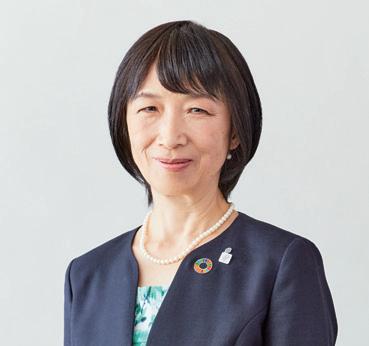


Yukiko Yoshimaru
Outside Director of the Board
Toshifumi Kitazawa
Outside
Director of the Board
Outside
Director of the Board
Ms. Yoshimaru has a wide range of global experience including management experience as a director of domestic and overseas companies and M&A experience at a U.S. subsidiary of a major Japanese company. In particular, she has greatly contributed to constructive discussions and strengthening of the effectiveness of the Board of Directors meetings by providing her opinions based on a wealth of knowledge and experience in human resources management, diversity and corporate governance. In addition, since becoming the Chairperson of the Personnel Affairs and Remuneration Committee in May 2020, she has been taking leadership in clarifying the process of selecting and dismissing Directors of the Board, facilitating succession planning, and strengthening remuneration governance. She has taken the lead in the revision of officer remuneration related to the Sixth MidTerm Management Plan.
Currently, she is engaged in dialogue with executives of overseas Group companies to assess the status of the international business. To achieve sustainable growth and increase the corporate value of the Sekisui House Group, especially in the formulation of growth strategies from the perspectives of global business and diversity promotion, and in strengthening the management supervision function in areas including personnel affairs and remuneration, the Company has reelected her as an Outside Director of the Board.
Having held key positions at a major insurance company, Mr. Kitazawa has extensive knowledge and experience in areas including global business, M&A, risk management and compliance, as well as abundant achievements and experience as a manager. Since becoming Chairman of the Board of Directors in May 2021, he has been leading constructive discussions to strengthen the effectiveness of the Board of Directors meetings by steering proceedings flexibly to further activate deliberations on medium- and long-term management issues. He has also been contributing to the enhancement of deliberations as a member of the Personnel Affairs and Remuneration Committee of the Company.
Currently, he is engaged in dialogue with executives of overseas Group companies to assess the status of the international business. To achieve sustainable growth and increase the corporate value of the Sekisui House Group, especially in the formulation of growth strategies from the perspective of global business, and in strengthening the management supervision function in areas including M&A and other financial strategies, risk management and compliance, the Company has reelected him as an Outside Director of the Board.
Having held key positions in domestic and overseas companies, Ms. Nakajima has extensive experience in financial strategy, M&A, and other areas by serving as the head of Asian and Japanese subsidiaries of global financial institutions. She has embodied diversity in corporate management in an environment where diversity in senior management is considered to be natural.
Since April 2021, she has been serving as Outside Director of the Board of the Company and has greatly contributed to constructive discussions and strengthening of the effectiveness of the Board of Directors meetings by actively expressing frank opinions that promote appropriate risk-taking and management reform.
Currently, she is engaged in dialogue with executives of overseas Group companies to assess the status of the international business. To achieve sustainable growth and increase the corporate value of the Sekisui House Group, especially in the formulation of growth strategies from the perspectives of global business and diversity promotion, and in strengthening the management supervision function in areas including M&A and other financial strategies, the Company has reelected her as an Outside Director of the Board.


Outside Director of the Board
Having held key positions in the Cabinet Office, Ms. Takegawa worked hard to realize policies related to gender equality, and has extensive knowledge and experience in the fields of diversity and compliance. During her tenure at the Ministry of Land, Infrastructure, Transport and Tourism, she worked tirelessly across ministries and agencies to develop safe and secure infrastructure for the elderly and disabled.
Since April 2021, she has been serving as Outside Director of the Board of the Company and has greatly contributed to constructive discussions and strengthening of the effectiveness of the Board of Directors meetings by providing useful advice from the perspective of an ordinary citizen and actively expressing frank opinions related to matters including environmental issues, diversity and human capital. She has also been contributing to enhancing deliberations as a member of the Personnel Affairs and Remuneration Committee of the Company since May 2021.
Currently, she is engaged in dialogue with executives of overseas Group companies to assess the status of the international business. To achieve sustainable growth and increase the corporate value of the Sekisui House Group, especially in the formulation of growth strategies from the perspective of promoting diversity across the entire Group, including in its international business, and in strengthening the management supervision function in areas including quality control, compliance, and personnel affairs and remuneration, the Company has reelected her as an Outside Director of the Board.
Having worked for an overseas consulting firm and software vendors, Mr. Abe was involved in the launch of Google’s cloud business. At that business, he supervised its Asia-Pacific operations. As such, he has extensive experience in the global business environment in the IT and digital fields. In particular, when Google launched cloud services business for Japanese companies, he gained the deep trust of many client companies and promoted digital innovation together. Currently, he serves as Representative Director of the Board, President and CEO of a venture company providing teleradiology (remote medical image diagnosis) services, a firm that he has had contact with since its foundation.
Since April 2022, he has been serving as Outside Director of the Board of the Company and has greatly contributed to constructive discussions and strengthening of the effectiveness of the Board of Directors meetings by actively expressing frank opinions from the perspective of global operations and digitally-driven business model transformation and disseminating information to promote innovation.
Currently, he is engaged in dialogue with executives of overseas Group companies to assess the status of the international business. To achieve sustainable growth and increase the corporate value of the Sekisui House Group, especially in the formulation of alliances and growth strategies in new service business fields across the entire Group, including its international business, and in strengthening the management supervision function, including supervision of the area of human resources development, the Company has reelected him as an Outside Director of the Board.



Midori Ito
Standing Audit and Supervisory Board Member
Overview of expected role
Ms. Ito began her career at the Company working as staff at display houses. After serving in this position for around a decade, she was tasked with housing sales, becoming a positive role model for younger colleagues as a pioneering female salesperson. In 2006, she was transferred to the head office where, as a leader of the Diversity Development Team, she began exercising her outstanding capabilities to act based on her accurate understanding of the reality of front-line sales activities and thereby taking the lead in the promotion of numerous measures. After becoming an executive officer at the Company in 2018, she strove to encourage male employees to take childcare leave as part of her vigorous initiatives to facilitate widespread employee awareness of diversity and inclusion (D&I). In April 2021, she was appointed as an Audit and Supervisory Board member to leverage her extensive business experience amassed in front-line sales as well as knowledge and experience cultivated in the course of formulating D&I measures in order to strengthen the audit structure of the Company.
Standing Audit and Supervisory Board Member
Standing Audit and Supervisory Board Member
Outside Audit and Supervisory Board Member
For around 35 years since joining the Company, Mr. Ogino has served in such front-line sales positions as housing salesperson, sales office manager, sales administration headquarters staff and branch manager. After being transferred to the Auditing Department in 2017, he was appointed as deputy general manager in 2020 and became an operating officer in charge of and the general manager of this department in 2021. He thus worked to strengthen internal auditing departments while cultivating networks among governance-related human resources. In April 2022, he was appointed as an Audit and Supervisory Board member to leverage his outstanding integrity and robust track record in managing front-line sales activities as well as information gathering capabilities cultivated in the course of engagement in internal auditing in order to strengthen the audit structure of the Company.

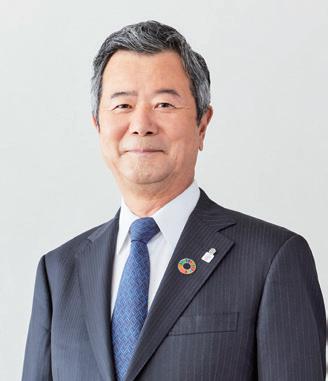
Outside Audit and Supervisory Board Member
In 2018, Mr. Tsuruta was appointed as an outside Audit and Supervisory Board member of the Company to leverage his track record in a diverse range of operations, including finance, accounting, information disclosure, auditing and overseas business at a major electric appliance manufacturer engaged in global businesses, along with his experience as an audit and supervisory board member at other companies, in order to strengthen the audit structure of the Company. After assuming the office of Audit and Supervisory Board member, he has greatly contributed to the strengthening of supervisory functions afforded by the Board of Directors and the transparency of its operations by providing unfettered opinions regarding ideals for the Company’s corporate governance structure. Based on his sophisticated expertise and unique perspectives backed by robust business experience, he has offered timely and well-informed opinions and thus played a role in strengthening the Company’s management supervisory functions and developing an even better corporate governance structure. In April 2022, he was reappointed (second term) as an outside Audit and Supervisory Board member and appointed as a standing member and the chairperson of the Audit and Supervisory Board. Overview
In 2017, Mr. Kobayashi was appointed as an outside Audit and Supervisory Board member to leverage his specialist expertise and extensive experience amassed in the judiciary while serving as a prosecutor and lawyer in order to strengthen the audit structure of the Company. After assuming his current position at the Company, he has greatly helped the Board of Directors upgrade the transparency and fairness of its operations by providing insightful opinions regarding the direction the Company should take to promote governance reforms. Based on his sophisticated expertise and high moral bearing, he is contributing to the strengthening of the Company’s management supervisory functions and the development of a stronger corporate governance structure. In April 2021, he was reappointed (second term) as an outside Audit and Supervisory Board member.
In 2020, Mr. Wada was appointed as an outside Audit and Supervisory Board member to leverage his specialist expertise in finance and accounting as a certified public accountant (CPA) as well as his knowledge and experience as an outside audit and supervisory board member at other companies in order to strengthen the audit structure of the Company. After assuming his current position at the Company, he has greatly helped the Board of Directors strengthen its supervisory functions and secure the transparency of its operations by accurately spotting issues associated with the governance structure of the Group. He is contributing to the strengthening of the Company’s management supervisory functions and the development of an even better corporate governance structure by offering timely and insightful opinions backed by his sophisticated expertise and extensive track record as a CPA. In April 2024, he was reappointed (second term) as an outside Audit and Supervisory Board member.
We are actively participating in international initiatives to contribute to the resolution of social issues on a global scale. In Japan, the Sekisui House Group has a large role and responsibility in improving housing and living conditions. We therefore participate in the initiatives of many industry groups.
Name Logo Activities
United Nations Global Compact (UNGC)

RE100 Initiative

TCFD Consortium
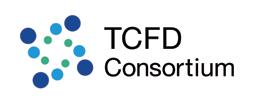
SBT Initiative

Japan Climate Initiative (JCI)
Japan Climate Leaders’ Partnership (JCLP)
Global Alliance for Buildings and Construction (GlobalABC)
Japan Business Initiative for Biodiversity (JBIB)
TNFD Forum and TNFD Early Adopter





An initiative advocated by the United Nations that requires companies to comply with and implement 10 principles in the areas of "human rights," “labour,” “environment” and “anti-corruption.” We joined in September 2018 and participate in a subcommittee of the Global Compact Network Japan (GCNJ).
An international initiative of major companies around the world pledging to use 100% renewable energy in their business operations. We joined in October 2017, becoming the second Japanese company to do so.
The Task Force on Climate-related Financial Disclosures (TCFD) is a framework for disclosing financial information on corporate climate change initiatives and impacts. The TCFD Consortium was organized by companies supporting the TCFD. We joined in July 2018, with an endorsement of the TCFD.
An initiative requiring companies to adopt evidence-based CO2 emissions reduction targets. In May 2023, our targets were certified as being consistent with the 1.5˚C target under the Paris Agreement.
A network of non-governmental organizations encompassing enterprises, local governments and other organizations working actively on climate change countermeasures. We have participated in the network since its establishment in July 2018.
A group of corporations aiming to achieve a carbon-free society committed to sustainability. We formally joined as a full member in August 2016. We participate in such projects as “EV Project” and “Thermal Project.”
An organization of numerous companies, local governments, organizations, NGOs and others aiming for zero emissions, high efficiency and resilience in the fields of architecture and construction. We have participated since May 2016.
An initiative of highly motivated companies committed to biodiversity conservation and sustainability. We have participated in this initiative since its beginning in April 2008.
An initiative that shares the vision and mission of the Taskforce on Nature-related Financial Disclosures (TNFD) and provides technical support aimed at sharing information and building frameworks. We have participated since February 2022. We are registered as a TNFD Early Adopter, which we disclosed in January 2024.
Association with Government-Led Initiatives
Name Committees
Ministry of Land, Infrastructure, Transport and Tourism
The Panel on Infrastructure Development: Building Subcommittee, Building Environment Subcommittee, Building Energy Efficiency Standards Subcommittee
Association with Industry Group-Led Initiatives
* Indicates a member of the Company serves as chair, representative director or president
Group name Committees and others
Japan Business Federation Standing Executive Committee, Executive Committee, Urban Housing Policy Committee, Diversity and Inclusion Promotion Committee
Kansai Economic Federation Labor Policy Committee, D&I Expert Committee
The Osaka Chamber of Commerce and Industry Construction and Building Materials Subcommittee
Japan Federation of Housing Organizations
Japan Prefabricated Construction Suppliers and Manufacturers Association*
House Construction Promotion Foundation*
The Provision of Quality Housing Stock Association*
Senior Housing Association
NPO Kids Design Association
Eco-First Promotion Association
ESG Disclosure Study Group
Board of Directors, Steering Committee, Policy Committee, Housing Taxation and Finance Committee, Housing Performance Improvement Committee*, Building Regulations Rationalization Committee, Environment Committee, Housing Stock Committee, Construction CS and Safety Committee, International Exchange Committee, Mature Society Housing Committee*, Advertising Committee and others
Board of Directors*, Planning and Steering Committee*, Financial Taxation System Study Group*, Public Relations Committee, Board of Education, Education Implementation Committee, Defect Warranty Insurance Promotion Committee, Housing Subcommittee, and others
Board of Directors*, Board of Councillors, Business Steering Committee
Board of Directors* Executive Committee, Planning and General Affairs Committee, Public Relations Website Committee, Technical Committee, Evaluation and Education Committee
Board of Directors, Planning and Steering Committee, Housing and Lifestyle Subcommittee
Board of Directors, Steering Committee, Research & Development Subcommittee, Standardization Review Subcommittee, Awards Subcommittee, and others
Executive Committee, Steering Committee, Information Exchange Conference
General member
Sekisui House, Ltd. has received assurance from KPMG AZSA Sustainability Co., Ltd. to enhance the reliability of information regarding the energy consumption; waste discharges and green- house gas emissions; water withdrawal in factory production; COD, phosphorus and nitrogen discharges volumes; and social information (Lost Time Injury Frequency Rate / Frequency Rate of Occupational Illness) disclosed in the “VALUE REPORT 2024”.

To the Representative Director of the Board, President, Executive Officer, CEO of Sekisui House, Ltd.
We were engaged by Sekisui House, Ltd. (the “Company”) to undertake a limited assurance engagement of the environmental and social performance indicators marked with ✓ (the “Indicators”) for the period from February 1, 2023 to January 31, 2024 included in its VALUE REPORT 2024 published in English (the “Report”) for the fiscal year ended January 31, 2024.
The Company’s Responsibility
The Company is responsible for the preparation of the Indicators in accordance with its own reporting criteria (the “Company’s reporting criteria”), as described in the Report.
Our Responsibility
Our responsibility is to express a limited assurance conclusion on the Indicators based on the procedures we have performed. We conducted our engagement in accordance with the ’International Standard on Assurance Engagements (ISAE) 3000, Assurance Engagements other than Audits or Reviews of Historical Financial Information’ and the ’ISAE 3410, Assurance Engagements on Greenhouse Gas Statements’ issued by the International Auditing and Assurance Standards Board. The limited assurance engagement consisted of making inquiries, primarily of persons responsible for the preparation of information presented in the Report, and applying analytical and other procedures, and the procedures performed vary in nature from, and are less in extent than for, a reasonable assurance engagement. The level of assurance provided is thus not as high as that provided by a reasonable assurance engagement. Our assurance procedures included:
• Interviewing the Company’s responsible personnel to obtain an understanding of its policy for preparing the Report and reviewing the Company’s reporting criteria.
• Inquiring about the design of the systems and methods used to collect and process the Indicators.
• Performing analytical procedures on the Indicators.
• Examining, on a test basis, evidence supporting the generation, aggregation and reporting of the Indicators in conformity with the Company’s reporting criteria, and recalculating the Indicators.
• Visiting one domestic factory and one construction site managed by a domestic Company’s subsidiary selected on the basis of a risk analysis.
• Evaluating the overall presentation of the Indicators.
Based on the procedures performed, as described above, nothing has come to our attention that causes us to believe that the Indicators in the Report are not prepared, in all material respects, in accordance with the Company’s reporting criteria as described in the Report.
We have complied with the Code of Ethics for Professional Accountants issued by the International Ethics Standards Board for Accountants, which includes independence and other requirements founded on fundamental principles of integrity, objectivity, professional competence and due care, confidentiality and professional behavior. In accordance with International Standard on Quality Management 1, we design, implement and operate a system of quality management including policies or procedures regarding compliance with ethical requirements, professional standards and applicable legal and regulatory requirements.
/s/ Keisuke Inoue
Keisuke Inoue, Director
KPMG AZSA Sustainability Co., Ltd. Osaka, Japan
September 11, 2024
Consolidated Financial Statements
Consolidated Statement of Cash Flows
11-Year Highlights (Consolidated)
11-Year Highlights (Consolidated)
New Housing Starts in Japan (Units)
Number of Houses Built by Sekisui House in Japan (Units)
Trends in Sekisui House Real Estate Block Leasing Operation
1 Calendar year basis
2 In FY2023, built-to-order houses were recategorized from built-for-sale houses to custom detached houses.
3 Figures for FY2016 onward are for the entire Group.
4 Presentation changed to monthly data from month-end data as of FY2018
(As of January 31, 2024)



Joshinetsu Sales Administration Headquarters
Yamaguchi Factory (TLM Yamaguchi)

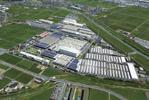


Corporate Name Sekisui House, Ltd.
Head Office Umeda Sky Building Tower East, 1-1-88, Oyodonaka, Kita-ku, Osaka, 531-0076, Japan
Date of Establishment August 1, 1960
Number of Employees 29,932 (consolidated basis) 16,627* (non-consolidated basis)
Share Capital ¥202,854.49 million
* Includes employees seconded to subsidiaries.
Production Bases Five locations in Japan (in Miyagi, Ibaraki, Shizuoka, Hyogo and Yamaguchi prefectures) and one location in Australia
Research Institutes Comprehensive Housing R&D Institute and Human Life R&D Institute
Sales Offices Sales Offices: 108
Customer Service Centers: 29
Display House Locations: 286
SEKISUI HOUSE AUSTRALIA HOLDINGS PTY LIMITED
Ingleburn Manufacturing
Affiliated Companies Consolidated Subsidiaries
342 companies (49 in Japan, 293 overseas)
Sekisui House Real Estate Holdings, Ltd.
-Sekisui House Real Estate Group: 6 companies
Sekisui House Remodeling, Ltd.
Sekisui House Construction Holdings, Ltd.
-Sekisui House Construction Group: 8 companies
Sekisui House noie Limited
Sekisui House Asset Management, Ltd.
Konoike Construction Co., Ltd. Other
Note: Sekisui House Innovation and Communication, Ltd. was established February 1, 2024
SEKISUI
SEKISUI HOUSE US HOLDINGS, LLC
NORTH AMERICA SEKISUI HOUSE, LLC
SH RESIDENTIAL HOLDINGS, LLC
WOODSIDE HOMES COMPANY, LLC
HOLT GROUP HOLDINGS, LLC
CHESMAR HOLDINGS, LLC
Equity-method Affiliates 37 companies (12 in Japan, 25 overseas)
Note: Includes some

Awarded a “Triple A” by the CDP for leadership across the fields of climate change, forests and water security (February 2024)
Release (Japanese only)
Received Rainbow Certification for the second consecutive year under the PRIDE Index 2023 and presented with the PRIDE Index 2023 Gold Award for the sixth consecutive year (November 2023)
(Japanese
Received Environmentally Sustainable Company Category, Bronze Award Fifth ESG Finance Awards Japan (February 2024) News Release (Japanese only)
Received 2023 Minister of the Environment’s Award for Climate Action Advanced Introduction and Proactive Practice Division/Mitigation Category (November 2023)
News Release (Japanese only)
Recognizes Sekisui House Owner Denki’s initiatives aimed at solving post-FIT problems by achieving RE100.
Selected for the Best Workplace category of D&I Award 2023 for the third consecutive year (December 2023)
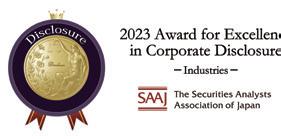
Received First Place in the Construction, Housing and Real Estate Category of the 2023 Award for Excellence in Corporate Disclosure for the third consecutive year (October 2023)
News Release (Japanese only)

First Platinum Kurumin Certification (February 2024)
Certified Health and Productivity Management Outstanding Organization 2024, Large Enterprise Category (White 500) for the fifth consecutive year (March 2024)
Voted “Most Honored Company” in the Institutional Investor 2024 All-Japan Executive Team ranking (May 2024)

Received the highest rating of AAA from MSCI ESG Ratings (December 2023)

Selected as a constituent of the FTSE4Good Index Series (June 2023)
In addition, since Japan’s Government Pension Investment Fund (GPIF) adopted six ESG indices, Sekisui House has been included in each of them. GPIF holds one of the world’s largest pools of pension assets.
indices selected by GPIF


FTSE Blossom Japan Index

Selected for the Dow Jones Sustainability World Index (December 2023)

Selected as one of the top 5% companies in the S&P Global Sustainability Yearbook 2024 (February 2024)
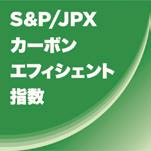


Head office:
Umeda Sky Building Tower East, 1-1-88, Oyodonaka, Kita-ku, Osaka 531-0076, Japan
Contact:
ESG Management Promotion Headquarters (Head office)
Tel: +81-6-6440-3440
Email: esg@sekisuihouse.co.jp
ESG Management Promotion Headquarters
Investor Relations Department
Akasaka Garden City, 4-15-1, Akasaka, Minato-ku, Tokyo
107-0052, Japan
Tel: +81-3-5575-1730
Email: investor.relations@sekisuihouse.co.jp
Global website:
https://www.sekisuihouse.co.jp/english/
Sustainability / ESG management: https://www.sekisuihouse.co.jp/english/company/sustainable/
Investor relations:
https://www.sekisuihouse.co.jp/english/company/financial/